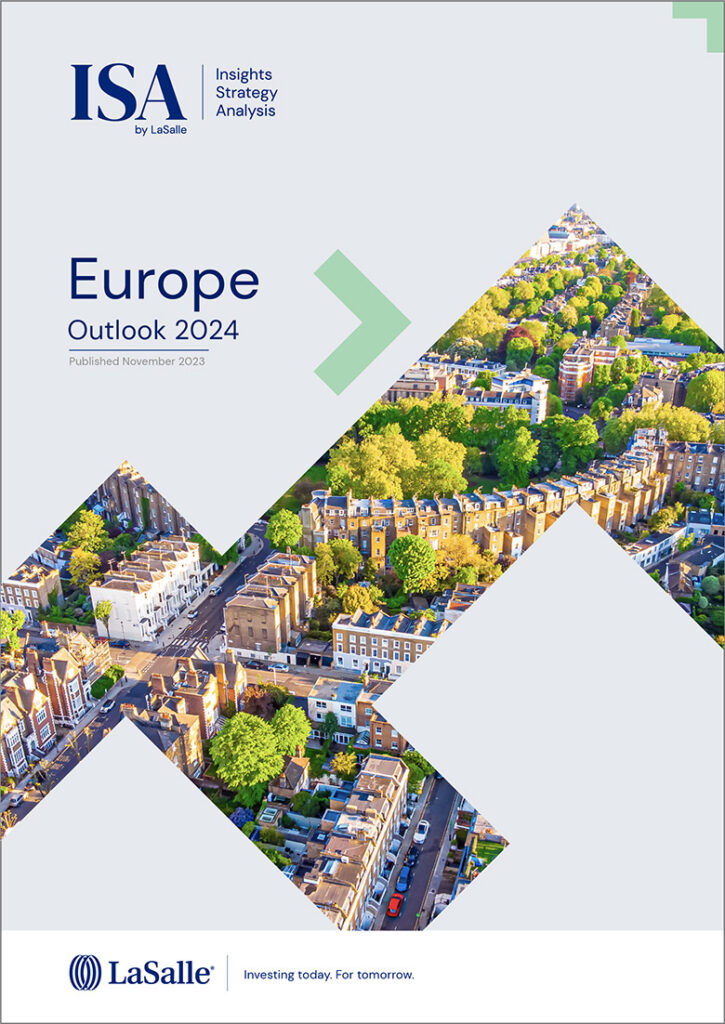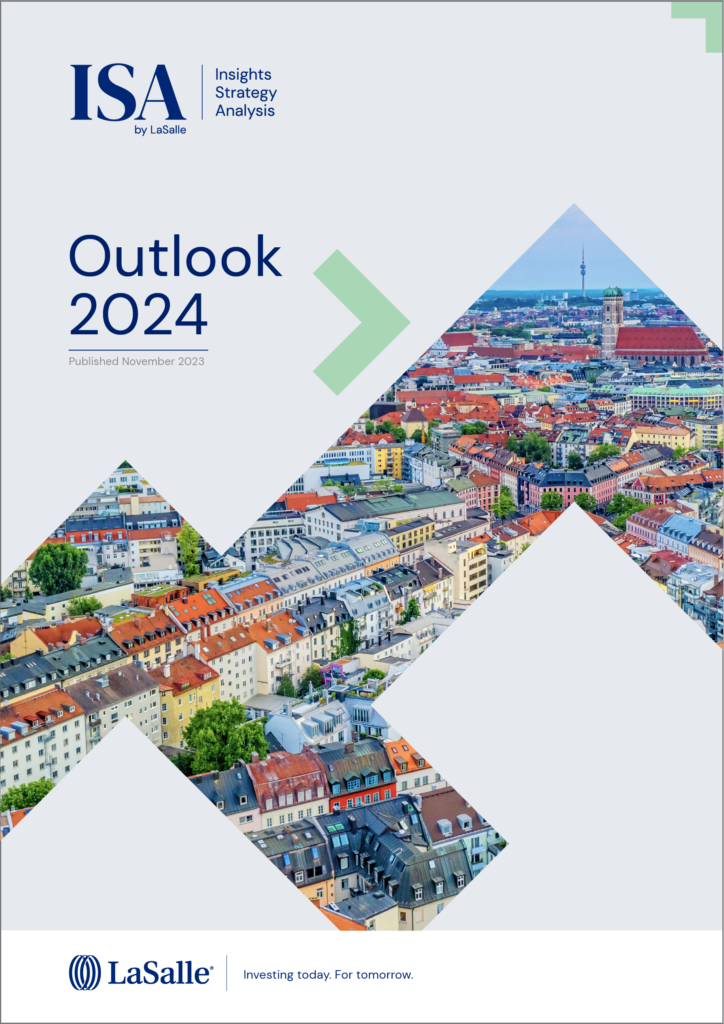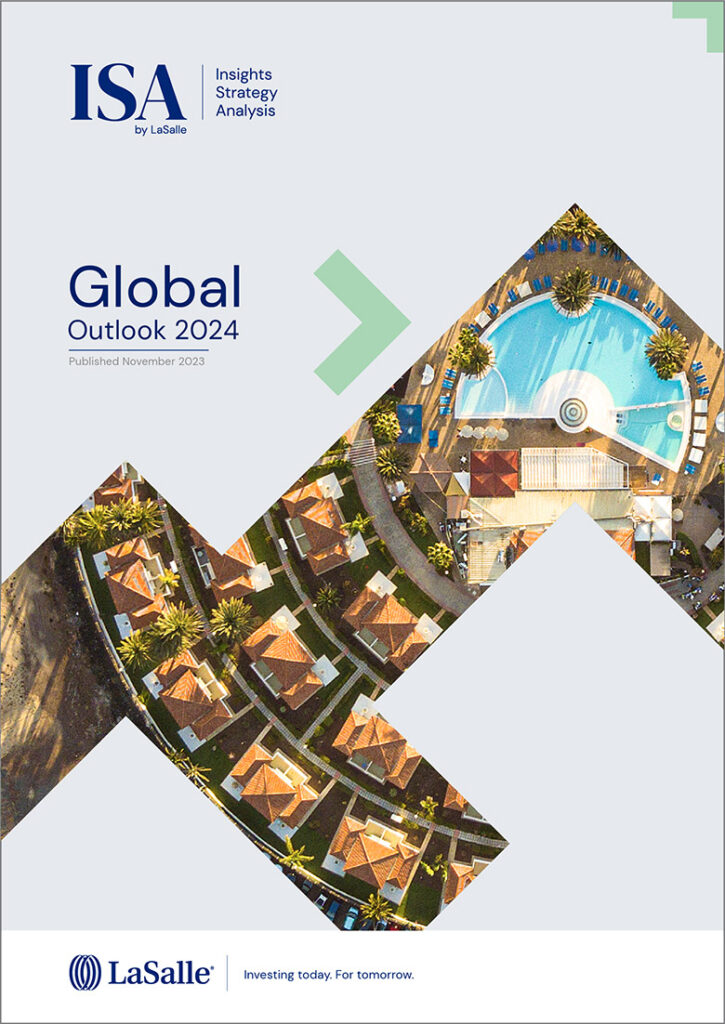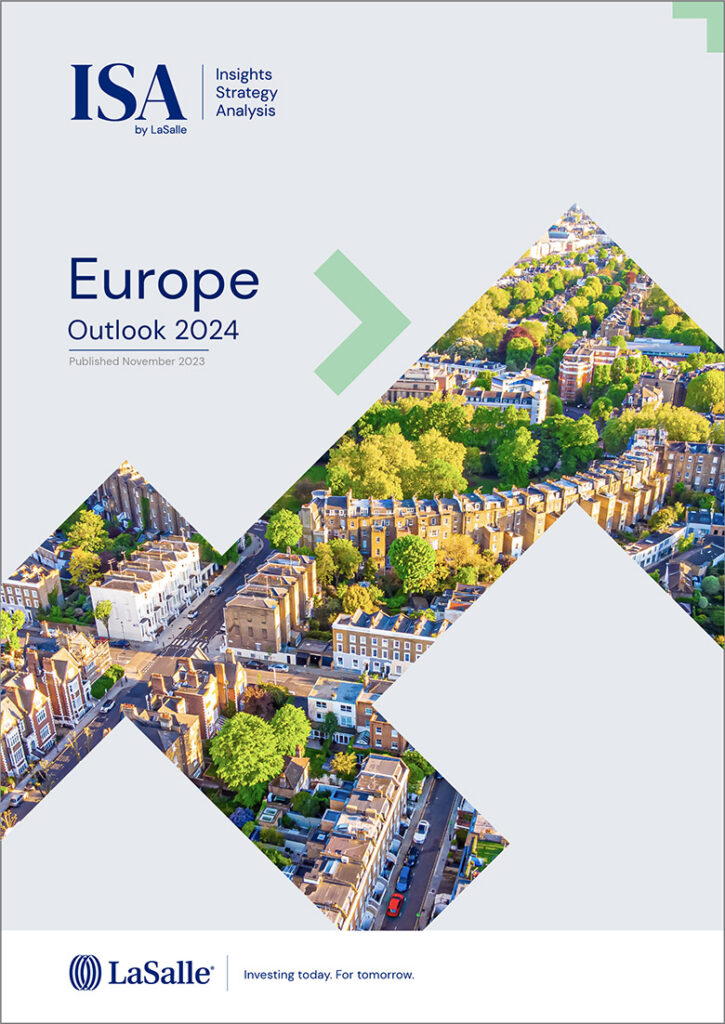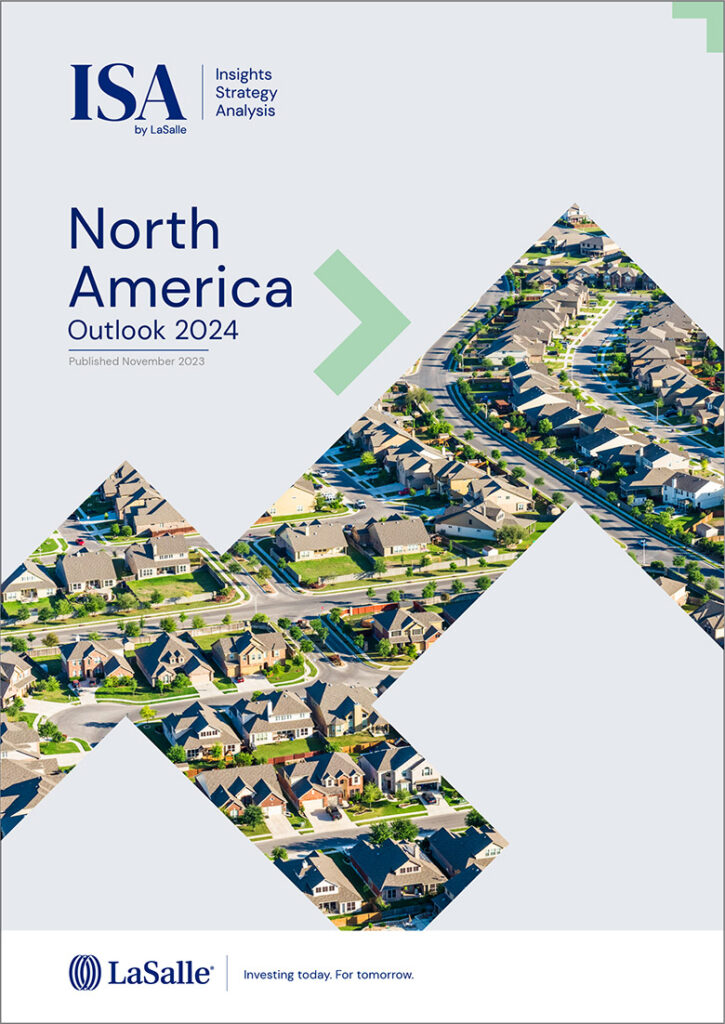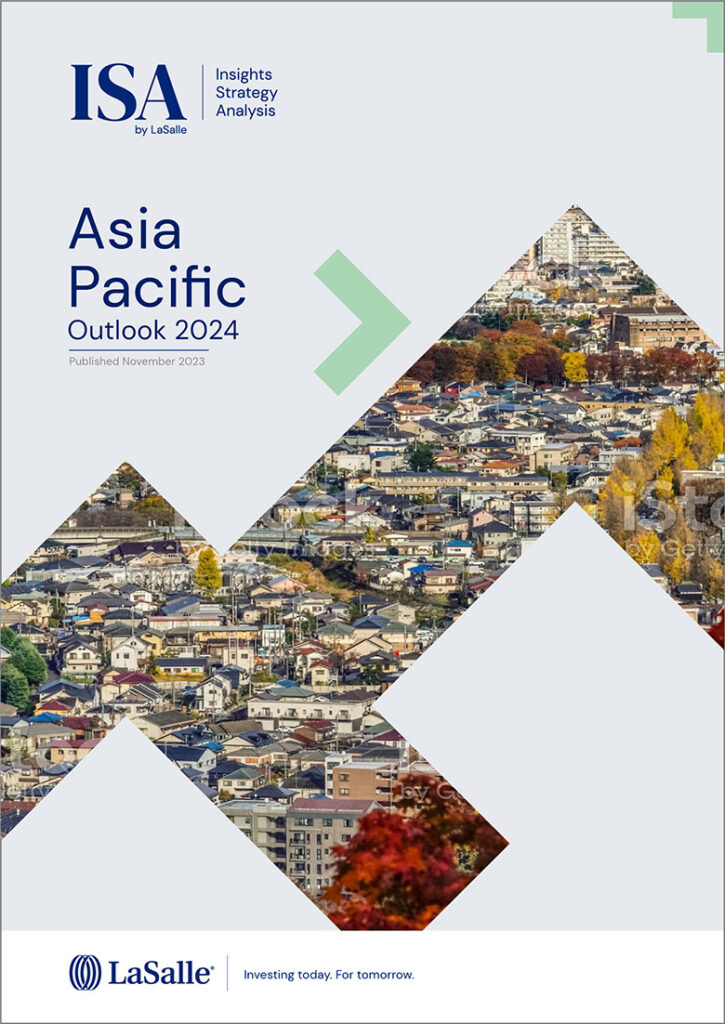
A reader waking up from a quarter-long slumber on April 1, 2025 would be forgiven for confusing the headlines for an April Fools’ Day prank. They would scan the news and see stories about:
• large tariffs alternately announced, rescinded, delayed and reintroduced at a breakneck pace (see LaSalle Macro Quarterly, or LMQ, p. 4);
• US equities in correction territory as ex-US markets, including even China’s, outperform (LMQ p. 25);
• increasing calls that the risk of a US recession is rising (LMQ p. 20); and
• substantial upward revisions in forecasts of long-term European GDP growth (LMQ p. 21).
Each of these is at least partly (and in some cases completely) contrary to expectations from the beginning of this year. But the quick reversal in the economic narrative is no April 1st joke. The post-election consensus of a supercharged US economy pulling ahead of the rest of the world has clearly been challenged, if not upended.
In this period of elevated policy uncertainty, real estate investors should focus on what they can and should do amidst all the noise. At the risk of stating the obvious, we think it helps to take a step back and break down the analysis into three basic steps of incorporating news flow into investment strategy — the what, the so what, and action steps. But as we will discuss, the first two are characterized by so much uncertainty that it is also helpful to start from the end and work backwards, asking: What can investors do to improve their chances of successfully navigating this environment regardless of what happens?
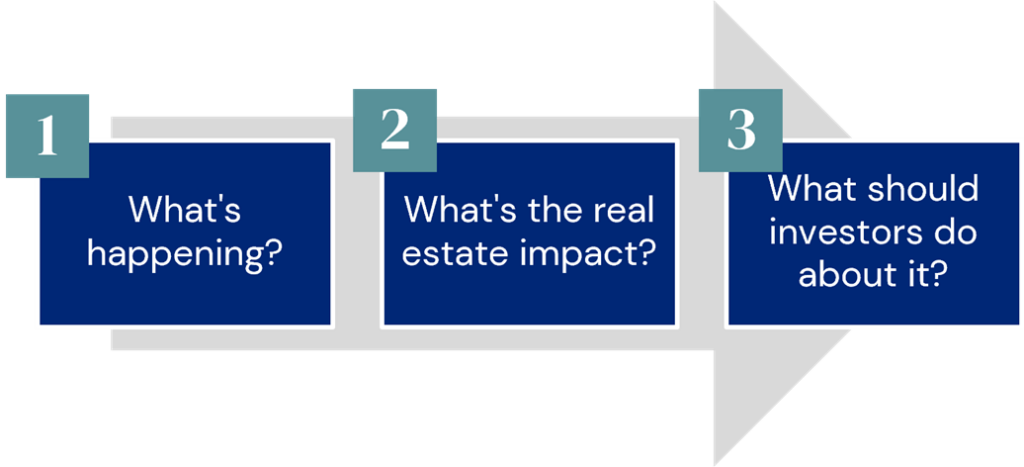
1. What’s happening?
Normally, the “what” of political developments and other events is the easy part. But since the US presidential inauguration, the Trump administration has made policy announcements — especially regarding trade and federal employment — at a rapid pace. Some of these seem to have taken even insiders by surprise. Widespread post-election expectations that actual policy would be more measured than campaign-trail rhetoric have proven incorrect.1 Reversals and postponements have also been a regular occurrence.
Adding to the news flow are announcements by other countries. These include the tit-for-tat of retaliatory tariff measures. But there have also been substantial structural shifts, most notably the German coalition agreement to spend more on infrastructure and defense. This news is arguably linked to a realization by European leaders that, given less collaboration with the US, Europe will have to forge its own path to generate economic growth and provide for its security.2 Aside from the break that this represents from the post-World War II order, this change is significant because it is a key driver of higher economic growth expectations for Europe.
The result of all this is a “layering” of announcements that is difficult to digest at once (see our attempt at a timeline at LMQ p. 4). It is even more of a challenge to roll-forward the news into reasonable predictions for subsequent weeks, let alone months. As a result, measures of economic policy uncertainty have risen to levels close to historic highs (LMQ p. 5). Indeed, the implications of the many recent developments on the growth and inflation outlook include first-order effects such as the direct impacts of lower government spending on GDP and higher prices on tariffed goods (LMQ p. 7), but also the second-order effects of broadly elevated uncertainty.
Uncertainty is the enemy of investment decision-making. This applies both to financial investment as well as spending by businesses in plant, property, equipment and digital tools. Empirical research has shown a clear negative relationship between uncertainty and investment.3 If businesses are unsure (as they are today) about the rules of the road — for example, around the basic terms of trade governing imports and exports — they may be hesitant to commit capital to long-horizon projects. At the same time, expectations of lower taxes and less regulation may push them back toward optimism.
Our analysis of recent events comes with a dose of humility. While LaSalle dedicates significant resources to tracking and analyzing the constant flow of indicators and news — as highlighted by the LaSalle Macro Quarterly (LMQ) — we do not purport to have a unique competitive advantage doing so. We would expect that our readers follow a range of news outlets, forecasters and other observers in staying abreast of the news flow and making sense of it.
2. What’s the real estate impact?
We do feel, by contrast, that our experience managing property and data from our portfolio puts us in a strong position to assess the likely impacts of policy developments on real estate. Even in the context of elevated overall uncertainty, we can make several observations with relative confidence.
First, we suspect that a key real estate impact of recent policy trends could be higher replacement costs. Tariffs on construction materials, such as steel, are likely to drive up their price. In addition, a lower level of migration into the US may reduce the supply of construction labor there. Increased European spending on infrastructure and defense could also contribute to higher global and regional materials costs. Higher replacement costs would mean that rents would have to rise more to justify new development, ultimately leading to higher net operating income (NOI) growth. This could counterbalance the impact of macro factors such as a potentially slower economy, as well as property type-specific impacts such as softer demand for housing in the context of muted household formation by immigrants. A simpler way to state this is that real estate can act as an inflation hedge.4
Second, we see value in undertaking granular research to identify potential winners and losers from the current policy environment. This approach can help investors identify real estate that is likely less exposed (or may even benefit from) current trends, while flagging potentially more-impacted market segments. Although the exact mix of government policies remains uncertain, the direction of travel is clear enough in some areas to make a few relative calls. For example, a move away from global free trade could weaken real estate demand related to import-export activities, for example in proximity to ports, while bolstering it in emerging near-shoring hubs.
These sorts of analyses can operate both at the national level, for example by identifying more and less trade-exposed countries (e.g., LMQ p. 9), and at the metro-area level, by examining city-level economic exposures (LMQ p. 10 and 11). One specific economic concentration worth mentioning is that of government employment in Washington, DC. Clearly, job cuts by the newly formed Department of Government Efficiency (DOGE)5 are a risk, but there are mitigating factors such as mandated in-person work; we predict a net negative effect for DC real estate demand, but we have not yet seen much impact on the ground or in the data.
Finally, we note that economic softness comes with mixed effects for real estate. As a long-duration, interest rate-sensitive asset class, it is quite possible that a mild or moderate economic slowdown that leads to lower long interest rates could, in fact, be a positive for real estate values in the aggregate. That said, there are likely to be winners and losers, depending on the relative sensitivity of an asset’s performance to interest rates versus sensitivity to economic growth.6
A bigger risk than a slowdown alone is that of stagflation: weak growth at the same time that sticky inflation keeps rates high. However, most economic research suggests that tariffs represent a one-time upward adjustment to the price level, rather than a driver of a sustained, self-reinforcing cycle of higher inflation;7 as such, central bankers may be more willing to ”look through” the impact of tariffs. So far, a recent softening in 10-year Treasury yields suggests that bond markets agree with that assessment (LMQ p. 26).
3. What should investors do about it?
All this points to avoiding excessive pessimism on the direction of values, while remaining cautious and selective. But being discriminating is not the only thing investors can do. We also advocate for turning the process of incorporating news flow into strategy on its head. Because we know so little about where the dust will settle on many of the policy shifts, let alone the impacts of those shifts, it is also prudent to ”work backwards” from the implementation step. Some of the most prudent actions an investor can take do not depend on the specific geopolitical or policy debate of the week.

A key recommendation in this regard is to build a globally diversified portfolio. That the market narrative has shifted quickly from one of US dominance of global growth, to a more balanced view with Europe gathering pace, reinforces that countries’ trajectories may exhibit lower correlations in a more fractured global economy. Rapid reversals of market narratives can generate significant market volatility, particularly when they are “priced to perfection” as the post-election optimism now appears to have been. Diversification should help to absorb that volatility, while avoiding being “left out” of unexpected positive shifts. A microcosm of this occurred recently in the public REIT market, where post-election euphoria led to what appeared to us a significant underpricing of European listed real estate.
Investors are also likely to benefit from diversification across the capital stack, which is why we recommend a permanent allocation to real estate debt. As we discussed in our ISA Focus report, “Investing in real estate debt,” debt investment provides low-correlation returns that are by definition not sensitive to volatility contained entirely within the first-loss equity position. While the risk of a recession in the next year is debatable but possibly rising, the risk of an eventual recession is always 100% in the long run. A debt allocation can help add stability and predictability to a portfolio’s return regardless of the exact path the economy takes.
LOOKING AHEAD >
• Investors should not get lost in the noise. Our view, expressed in the ISA Outlook 2025, is that we are at the ”dawn of a new real estate cycle.” This call is not dependent on a highly certain or favorable macro context, but rests on observations specific to real estate. These include pricing that has caught up with bond yields, valuations that have caught up with pricing, solid property fundamentals and substantially approved debt availability, among other factors. Neither a booming economy nor falling rates are necessary conditions for a revival in investment activity or the existence of attractive investment opportunities.
• There will likely be both winners and losers among specific real estate strategies. Granular analysis of risks and mitigants should inform revised assessments of relative value. To get these shifts right, investors must continue to ask: What is priced in? Overreactions are possible, which can create opportunities for investors to take advantage of volatility.
• Near-term uncertainty can distract from a longer-term picture that is arguably clearer. Over a horizon of years and decades, trends toward higher trade barriers and a more fragmented world seem likely to continue. Moving from a global economy where countries with a comparative advantage in producing a particular good do so and sell it to other countries, to one in which trade barriers create more siloed supply chains, would likely have complex effects. Classic economic theory suggests that transition could hinder productivity. But it could also spur real estate demand as productive capacity and inventories are un-pooled and duplicated. Correlations between real estate markets could also decrease. Investors should be ready to build portfolios with these dynamics in mind.
Footnotes
1 We made this mistake as well, saying that “legislative obstacles exist to enacting full campaign-trail rhetoric” in our November 11, 2024 ISA Briefing, “The ‘Red Sweep’ and real estate: has the outlook changed?”.
2 Source: Signum Global Advisors, Piper Sandler, Oxford Economics
3 According to analysis by Piper Sandler, there is an inverse correlation of -42% between a sustained upward shift in policy uncertainty (as measured by the US Economic Policy Uncertainty Index) and GDP growth; a doubling of uncertainty over a quarter is consistent with -1.5% real GDP growth over the following year. For academic work on this relationship, see Baker, Bloom and Davis, 2016
4 For more discussion of real estate’s role as an inflation hedge, see LaSalle’s ISA Portfolio View.
5 DOGE is seeking to quickly remodel the US government to be more effective at a lower cost. If successful, the project could contribute to the US economy’s productive capacity by reducing the crowding-out effect of government spending on private sector activity. Inconveniently, the prospects for reducing government spending face many constraints, not least the fact that a very large proportion of US government spending is committed to entitlement programs like Social Security, Medicare and Medicaid, which most politicians have pledged not to touch. Moreover, in the short term, reduced government employment and lower outlays would directly reduce GDP. Sources: Piper Sandler, Signum Global Advisors
6 In LaSalle’s ISA Outlook 2025, we highlighted our Portfolio Balance framework, which describes real estate market segments according to their historical sensitivities to economic growth and interest rates. The framework segments markets and sectors into four categories: growth-led, rate-led, stable, and reactive. We found that while short-leased, economically sensitive sectors like hotels may see values soften in a recession, other sectors may actually see values benefit if interest rates soften enough.
7 Source: Economic Policy Institute, Federal Reserve Bank of Boston, Piper Sandler
Important notice and disclaimer
This publication does not constitute an offer to sell, or the solicitation of an offer to buy, any securities or any interests in any investment products advised by, or the advisory services of, LaSalle Investment Management (together with its global investment advisory affiliates, “LaSalle”). This publication has been prepared without regard to the specific investment objectives, financial situation or particular needs of recipients and under no circumstances is this publication on its own intended to be, or serve as, investment advice. The discussions set forth in this publication are intended for informational purposes only, do not constitute investment advice and are subject to correction, completion and amendment without notice. Further, nothing herein constitutes legal or tax advice. Prior to making any investment, an investor should consult with its own investment, accounting, legal and tax advisers to independently evaluate the risks, consequences and suitability of that investment. LaSalle has taken reasonable care to ensure that the information contained in this publication is accurate and has been obtained from reliable sources. Any opinions, forecasts, projections or other statements that are made in this publication are forward-looking statements. Although LaSalle believes that the expectations reflected in such forward-looking statements are reasonable, they do involve a number of assumptions, risks and uncertainties. Accordingly, LaSalle does not make any express or implied representation or warranty and no responsibility is accepted with respect to the adequacy, accuracy, completeness or reasonableness of the facts, opinions, estimates, forecasts, or other information set out in this publication or any further information, written or oral notice, or other document at any time supplied in connection with this publication. LaSalle does not undertake and is under no obligation to update or keep current the information or content contained in this publication for future events. LaSalle does not accept any liability in negligence or otherwise for any loss or damage suffered by any party resulting from reliance on this publication and nothing contained herein shall be relied upon as a promise or guarantee regarding any future events or performance. By accepting receipt of this publication, the recipient agrees not to distribute, offer or sell this publication or copies of it and agrees not to make use of the publication other than for its own general information purposes.
Copyright © LaSalle Investment Management 2025. All rights reserved. No part of this document may be reproduced by any means, whether graphically, electronically, mechanically or otherwise howsoever, including without limitation photocopying and recording on magnetic tape, or included in any information store and/or retrieval system without prior written permission of LaSalle Investment Management.
Singapore (December 12, 2024) – Asia Pacific macroeconomies and real estate markets are showing signs of potential structural changes and unique cyclical patterns, setting the region apart from global trends.
This is the thrust of the Asia Pacific chapter of ISA Outlook 2025 report just released by LaSalle Investment Management (“LaSalle”). Published every year since 1993, LaSalle’s ISA Outlook is designed to help the real estate industry navigate the year ahead.
This year’s key findings include:
- Investors in Asia Pacific real estate must navigate new investments and existing portfolios in a complex environment with signs of structural change and a distinctly different cycle compared to historical norms. These factors could have a combination of positive and negative implications for investors, some of which may only become apparent years later.
- Adding to the complex macro environment is the US election result, which could lead to heightened economic uncertainty and periodic capital market volatility. China is particularly vulnerable and, to a lesser extent, Hong Kong. Beyond China and Hong Kong, it is difficult to predict clear winners or losers from the U.S. election result for now. We believe that select real estate markets or sectors could benefit from some supply chain rebalancing. In addition, investors may consider focusing on Asia Pacific real estate markets/sectors that are anchored by domestic demand and domestic capital.
- In China, which faces the weakest economic growth and consumer confidence in decades, heightened geopolitical tensions between the US and China, as well as the absence of impactful structural reforms or larger-scale stimulus packages, suggest an extended period of economic weakness. This creates a challenging environment for China’s residential and commercial real estate markets over the next few years.
- Japan remains the most liquid market in the region, with inflationary growth prospects. Should the substantial domestic investor base in Japan continue to anchor the real estate capital market, the potential impact of further interest rate hikes can be limited. Nonetheless, it is essential to allow for flexibility and the potential for unexpected outcomes, when evaluating investment opportunities or setting up business plans for existing portfolios in Japan.
- In other developed economies of the region, the varying and sometimes contrasting cyclical patterns among major real estate sectors within each country set the region apart from global trends.
- Commercial real estate liquidity in Asia Pacific has demonstrated resilience compared to other global regions but is still constrained to varying degrees, except for Japan. The gap between buyer and seller expectations is weighing on liquidity and some investors are adopting a wait-and-see approach. Nonetheless, savvy investors understand that sometimes the best returns come from vintages in the wake of cycle turning points or when signs of structural change emerge.
Where favorable macroeconomic conditions present themselves and as global investment appetite returns, the diversity of Asia Pacific markets and sectors within the region will offer discerning investors a variety of opportunities with a wide range of risk-return profiles.
Five strategic themes are highlighted in the Asia Pacific ISA Outlook 2025:
- Multi-family: At a nascent stage, except Japan
The multi-family sector in Asia Pacific is undergoing structural changes, driven primarily by demographic shifts and government policies, with significant potential for institutionalization. This sector offers a range of investment opportunities in a basket of markets except China, although it would take time to fully unlock value in this nascent sector outside of Japan due to unproven liquidity.
- Office: Navigate cycle changes vs. potential for structural shifts
Office market performance across Asia Pacific varies significantly. It is increasingly important to consider the timing of entry and exit as well as risk mitigation plans. South Korean, Japanese and Singaporean offices offer strategically selected investment opportunities for investors with different risk and return appetites.
- Logistics: Not a clear outperforming sector
The logistics sector shows dispersion in performance across markets, submarkets and sub-sectors. With relatively balanced supply-demand dynamics, Australia, Singapore and select Japanese markets offer investment opportunities, despite reducing return expectations.
- Retail: Distinctive consumption patterns
We expect that well-managed retail assets that have adapted their tenant mixes and market positioning in response to changing consumption habits will outperform, adding to operational intensity. A granular, asset-level approach to investment is crucial, given the performance variations across markets and sub-sectors.
- Hotel: Momentum mostly priced in, except Japan
The Japanese hotel market is set to continue its growth trajectory, driven primarily by domestic demand and, to a lesser extent, inbound tourists. However, the performance is expected to vary across markets and segments, influenced by the operational capability to navigate challenges such as labor shortages and rising labor costs.
Looking ahead, investors in Asia Pacific real estate must navigate a complex environment marked by structural changes and atypical market cycles.
Elysia Tse, Asia Pacific Head of Research and Strategy at LaSalle, commented: “There are many unknowns in the current complex economic climate, compounded by impending changes in Trump 2.0, which will likely lead to periodic episodes of capital market volatility. Investment strategies that favor domestic tenant demand and domestic capital, as well as those that focus on operational intensity, such as deal execution and in-house leasing, are important for value creation and preservation. In the event of significant dislocation or capital market volatility, investors could seek attractive entry points or creative, structured solutions to address capital stack issues for some troubled property owners or developers.”
Brian Klinksiek, Global Head of Research and Strategy at LaSalle, added: “As we enter 2025, we’re seeing the dawn of a new real estate cycle. While challenges remain, particularly in resolving legacy capital stack issues, we’re observing improving capital market conditions and emerging opportunities across a wide range of sectors and geographies. Investors who recognize these shifts early and act with flexibility are likely to benefit from attractive risk-adjusted returns. However, it’s crucial to remain vigilant about risks on the horizon and avoid the expectation of a rapid return to ultra-low interest rates.”
Ends
About LaSalle Investment Management | Investing Today. For Tomorrow.
LaSalle Investment Management is one of the world’s leading real estate investment managers. On a global basis, LaSalle manages US$88.8 billion of assets in private and public real estate equity and debt investments as of Q3 2024. LaSalle’s diverse client base includes public and private pension funds, insurance companies, governments, corporations, endowments and private individuals from across the globe. LaSalle sponsors a complete range of investment vehicles, including separate accounts, open- and closed-end funds, public securities and entity-level investments.
For more information, please visit www.lasalle.com, and LinkedIn.
NOTE: This information discussed above is based on the market analysis and expectations of LaSalle and should not be relied upon by the reader as research or investment advice regarding LaSalle funds or any issuer or security in particular. The information presented herein is for illustrative and educational purposes and is not a recommendation, offer or solicitation to buy or sell any securities or to adopt any investment strategy in any jurisdiction where prohibited by law or where contrary to local law or regulation. Any such offer to invest, if made, will only be made to certain qualified investors by means of a private placement memorandum or applicable offering document and in accordance with applicable laws and regulations. Past performance is not indicative of future results, nor should any statements herein be construed as a prediction or guarantee of future results.
Company news



No results found
Chicago (December 4, 2024) – US and Canadian real estate is on the verge of a new cycle in 2025, with interest rates down from peak levels and economic growth concerns fading, but also new risks on the horizon, according to the North America chapter of the ISA Outlook 2025 report published by global real estate investment manager LaSalle Investment Management (“LaSalle”).
The landscape for US and Canadian real estate has shifted since last year’s ISA Outlook 2024, which saw lower transaction volumes due to higher interest rates and challenging macroeconomic conditions. LaSalle sees considerable differences between this upcoming cycle and prior ones across both countries. Specifically, interest rates are expected to remain higher, which will lead to a more moderate pace of value recovery. And while the pace of capital flows to real estate is expected to pick-up in 2025, conditions across real estate sectors and markets will remain uneven.
These differences suggest that investing into the coming real estate cycle will not be a simple story of a “rising tide lifts all boats”; selectivity at the sector, market and sub-market level is likely to add value. LaSalle’s ISA Outlook 2025 follows several main themes that will influence real estate decision-making within the US and Canada, as well as sector by sector analysis of different property types:
- Economic Outlook – Falling Rates but Risks on the Horizon: While the summer and fall of 2024 saw growing optimism among real estate investors, uncertainty around long-term interest rates rose in the fourth quarter of 2024. Long bond rates have moved higher, even as the Fed started cutting interest rates and Canada’s central bank has become more aggressive in lowering its policy rate. The recent volatility is a reminder that the goldilocks environment has not returned. Pandemic-era reverberations continue as we adjust to a new normal that includes at least the fear of higher inflation.
- Capital Markets – Best Market Entry Points Tend to be Early Cycle: Historically, the best entry points for investors tend to come early in the cycle, and the ISA Outlook predicts that 2025 will be the best year for entry into appraisal-based funds, and second best to 2024 for entry at market pricing. However, the research cautions that unless interest rates fall back to the low levels of the post-GFC period, pricing will not likely enable returns similar to those seen in the early years of previous cycles. Despite expectations for a strong vintage year, the ISA forecasts that transaction volume will grow slowly throughout 2025, as many sellers will delay sales expecting better values and fundamentals for 2026.
- Balancing a Portfolio – Real Estate Debt: LaSalle’s ISA Outlook 2025 notes that investors need to weigh the potential upside from allocating to equity vs. the downside protection in a debt position. While today this analysis tends to favor equity, there are still strong reasons for investors to allocate to debt. First, interest rates remain high relative to historic levels, which is a benefit to investors seeking high absolute current cash returns from debt investment. Second, there are structural tailwinds to private real estate debt investment as banks dial back direct mortgage activity in favor of providing cross-collateralized ‘back leverage’ to debt portfolios. Finally, debt is a good source of portfolio diversification as volatility remains elevated.
- Distress – The Capital Stack Hangover: LaSalle’s North America chapter of the ISA Outlook indicates that some market segments and assets will remain stressed under any realistic outlook for economic growth and interest rates. Challenged capital stacks will not be cured by lower rates, and the “pretend and extend” approach to distressed assets will eventually require resolution. Distress in the US office sector is rising fast, with US residential and retail seeing some limited distress. In Canada, the number of distressed commercial properties in 2024 is expected to double from 2023 levels, though on a dollar volume basis this is a small fraction of US levels.
Global and North American Property Sector Outlooks
The North America chapter of the ISA forms part of LaSalle’s Global ISA Outlook 2025, which analyzes real estate trends across geographies and sectors, and similarly finds the new cycle extends to global real estate markets.
- Apartments –In 2025, US apartments will still be dealing with the hangover from a supply boom that followed spiking rents, low cap rates and soaring values in 2021 and 2022. While there are significant market level differences, the ISA 2025’s national view is the hangover will not clear until 2026, while 2025 will be another year to muddle through. In Canada, apartment fundamentals remain strong due to migration-related demand drivers.
- Industrial – Industrial performance in 2025 is likely to be favorable in both countries, largely because the supply hangover is already ending, leaving fundamentals better positioned. Secular tailwinds are expected to continue, with e-commerce remaining a demand driver and policies boosting domestic manufacturing a growing benefit.
- Retail – Globally, the retail outlook continues to improve after an extended period as the least-favored sector. Across the US and Canada, retail construction is expected to remain very low, making existing supply more attractive, especially for the best centers in growing markets and sub-markets. Rent growth remains moderate as tenants’ ability to bear higher rents is constrained, but entry yields in some retail sub-segments are expected to provide an attractive investment opportunity.
- Office – Office continues to generate headlines and remains the most discussed sector. Remote working is expected to continue to negatively impact office demand in both countries, but economic growth will eventually outweigh that negative factor. Across North America, the investability of the office sector is increasing and the focus continues to be on quality.
Richard Kleinman, LaSalle’s Americas Head of Research and Strategy, said: “We are on the cusp of a new real estate cycle both globally and in the Americas specifically. That said, navigating the current environment will require selectivity at the sector, market, and submarket levels. The ISA Outlook 2025 research we’ve released today looks in depth at what is driving trends in North American real estate, and lays out our strategy for the year ahead.”
Chris Langstaff, Head of Research and Strategy for Canada at LaSalle, commented: “Our outlook for Canadian real estate next year resembles many of our global projections, with some important distinctions. Optimism is a bit more contained as economic performance has lagged and there’s been uncertainty around trade policies, but favourable demographics, healthy fundamentals in most sectors and forecasts for improved GDP and job growth in 2025 and 2026 will continue to drive opportunities across markets, including in specialty sectors.”
Brian Klinksiek, Global Head of Research and Strategy at LaSalle, added: “Global real estate sentiment is gradually improving following a long period of negativity and signs are pointing to the beginning of a new real estate cycle. History has shown that investing early in a cycle tends to lead to relatively strong performance. There are still risks on the horizon, however, and investors are advised to focus on diversified strategies that are flexible and broad enough to adapt to a complex and evolving relative value landscape. A comprehensive look at value across a wide range of sectors and markets will be required to build a well-positioned real estate portfolio.”
Ends
About LaSalle Investment Management | Investing Today. For Tomorrow.
LaSalle Investment Management is one of the world’s leading real estate investment managers. On a global basis, LaSalle manages US$88.2 billion of assets in private and public real estate equity and debt investments as of Q3 2024. LaSalle’s diverse client base includes public and private pension funds, insurance companies, governments, corporations, endowments and private individuals from across the globe. LaSalle sponsors a complete range of investment vehicles, including separate accounts, open- and closed-end funds, public securities and entity-level investments.
For more information, please visit www.lasalle.com, and LinkedIn.
NOTE: This information discussed above is based on the market analysis and expectations of LaSalle and should not be relied upon by the reader as research or investment advice regarding LaSalle funds or any issuer or security in particular. The information presented herein is for illustrative and educational purposes and is not a recommendation, offer or solicitation to buy or sell any securities or to adopt any investment strategy in any jurisdiction where prohibited by law or where contrary to local law or regulation. Any such offer to invest, if made, will only be made to certain qualified investors by means of a private placement memorandum or applicable offering document and in accordance with applicable laws and regulations. Past performance is not indicative of future results, nor should any statements herein be construed as a prediction or guarantee of future results.
Company news



No results found
London (November 27, 2024) –Europe’s real estate cycle has reached a new dawn, following a deep capital market correction over recent years, according to the European chapter of the ISA Outlook 2025 report published by global real estate investment manager LaSalle Investment Management (“LaSalle”).
Last year’s ISA Outlook described the beginning of adjustment to the new reality of higher interest rates and challenging macroeconomic conditions. As we approach a new year, the latest ISA Outlook describes how market evidence is crossing thresholds that point to a new cycle. For example, data tracked by LaSalle’s asset managers show, from January 2024 to date, rents for new commercial leases across LaSalle’s European portfolio grew 2.7% relative to expiring passing rent, representing a return to an above-inflation pace.
LaSalle estimates that expected go-forward returns for the overall European property market are at their highest level in a decade. As capital slowly returns to the market and yield spreads exceed long-term averages, the real estate outlook has diverged from the region’s weak pace of economic growth due to a combination of supply barriers and asset quality polarisation.
This year’s report identifies strategic themes for investment in European real estate, which earn the region’s real estate assets an important place in investors’ property portfolios.
Beyond beds and sheds
A laser focus on “beds and sheds” has become a market consensus portfolio theme for many real estate investors, yet it is now becoming too simplistic to capture the more complex dynamics of the market.
Today’s ISA Outlook 2025 report uses fair value analysis to zero in on the best opportunities across a range of real estate capital and debt strategies and asset classes. These span all property types – not for the sake of diversification – but because we believe there are specific compelling opportunities that span across property types.
The European chapter of ISA Outlook 2025’s five strategic themes:
- Don’t forget a (real estate debt) umbrella: Real estate debt strategies can guard against inclement market conditions. New performance data for European debt funds shows the benefits of preparedness. Debt investors are also taking advantage of the choice between fixed-rate and floating-rate lending positions, and the diversification benefits of investing in both.
- Follow the hexagons for logistics: In our Paths of Distribution Score, we have mapped Europe into 158,455 hexagons – scoring each on their centrality, from an occupier perspective, for distributing goods to the most consumers at the lowest cost – and we favour logistics strategies that focus on the top-scoring hexagons within the highest ranked markets in our fair value analysis (in France, the Netherland and Germany).
- Retail back on the menu: European retail has been through a deep reset, and select retail formats now look too attractive to ignore. Outlet centres in the UK and Northern Europe offer strong alignment between tenants and operators, while Spanish and French retail parks and convenience shopping centres in the Netherlands can also deliver high income returns.
- Master adapters – how Europe’s office markets are different: Europe is leading the office market’s adaptation to hybrid work, as their largely mixed-use, mid-rise character, creates distinctive opportunities. A rebalanced office sector is not a distant next buyer prospect for many of Europe’s markets – it’s happening now. This is evident in return-to-office figures as well as property fundamentals. London City office market vacancy has now declined for five consecutive quarters, driving prime rent growth.
- A residential and living smörgåsbord: European residential (or living) is not really a single property type, it is a large collection of sub-sectors with widely varying cash flow profiles, pricing, regulation and target occupiers. There continue to be opportunities, but sector selection is paramount, with PBSA standing out in Spain and Germany.
Global uncertainty but clear opportunities
The European ISA Outlook forms part of LaSalle’s Global ISA Outlook, which finds that the new dawn extends across real estate around the world.
Greater clarity on the direction of interest rates around the world should help drive healing of the capital markets in 2025, with hesitant sellers gaining confidence as pricing starts to come in closer to their expectations.
There have, of course, been significant political developments in the US in recent weeks. The Global ISA Outlook reflects on how the “Red Sweep” may affect the real estate investment outlook and the shape of the dawning cycle, with signals pointing towards marginally higher growth, inflation and rates, but no great change in the overall outlook. LaSalle expects that the US economy remains on track for a soft landing. Equally, the European ISA Outlook considers the potential impact of the US Election in Europe, recognising that a stronger dollar could result in a possible boost in student demand for housing and tourist demand for hotel rooms.
The Global ISA Outlook also identifies areas of concern, with China a significant ‘soft spot’ due to a combination of generationally low growth and liquidity alongside weak property fundamentals. The Chinese government has made significant interventions to shore up the economy, and in recent weeks further stimulus has been implemented to guard against the potential onset of US tariffs on Chinese goods. These factors mean that China is something of a unique case in the ISA Outlook, with less applicability of global trends. Similarly, the Japanese market is experiencing a different cycle to the rest of the world. Japan is in the process of exiting a long period of deflationary risk and rock-bottom rates, so unlike other countries, monetary policy in Japan has a modest tightening bias.
Dan Mahoney, Head of European Research and Strategy at LaSalle, said: “We are seeing a new cycle dawning for Europe’s real estate markets. Today’s Europe ISA Outlook delves into why we believe we are entering a new cycle, evidence of data thresholds crossed, and our strategy for the years ahead. These go beyond simple ‘beds and sheds’ – which is too simplistic to capture the complexity of European real estate today.”
Brian Klinksiek, Global Head of Research and Strategy at LaSalle, added: “Global real estate sentiment is gradually improving following a long period of negativity and signs are pointing to the beginning of a new real estate cycle. History has shown that investing early in a cycle tends to lead to relatively strong performance. There are, however, still risks on the horizon, and investors are advised to focus on diversified strategies that are flexible and broad enough to adapt to a complex and evolving relative value landscape. A comprehensive look at value across a wide range of sectors and markets will be required to build a well-positioned real estate portfolio.”
Ends
About LaSalle Investment Management | Investing Today. For Tomorrow.
LaSalle Investment Management is one of the world’s leading real estate investment managers. On a global basis, LaSalle manages US$88.2 billion of assets in private and public real estate equity and debt investments as of Q3 2024. LaSalle’s diverse client base includes public and private pension funds, insurance companies, governments, corporations, endowments and private individuals from across the globe. LaSalle sponsors a complete range of investment vehicles, including separate accounts, open- and closed-end funds, public securities and entity-level investments.
For more information, please visit www.lasalle.com, and LinkedIn.
NOTE: This information discussed above is based on the market analysis and expectations of LaSalle and should not be relied upon by the reader as research or investment advice regarding LaSalle funds or any issuer or security in particular. The information presented herein is for illustrative and educational purposes and is not a recommendation, offer or solicitation to buy or sell any securities or to adopt any investment strategy in any jurisdiction where prohibited by law or where contrary to local law or regulation. Any such offer to invest, if made, will only be made to certain qualified investors by means of a private placement memorandum or applicable offering document and in accordance with applicable laws and regulations. Past performance is not indicative of future results, nor should any statements herein be construed as a prediction or guarantee of future results.
Company news



No results found
Almost three years after interest rates began to spike leading into the Great Tightening Cycle, the first light of a new real estate cycle is clearly visible on the horizon. As with the start of every new day, however, opportunities and challenges lie ahead. LaSalle’s Research and Strategy team will examine both throughout the course of November and December, as we publish four separate chapters, one covering our global outlook, and three deep-dives covering the outlook for Europe, North America and Asia Pacific. Each chapter can be found alongside an accompanying video conversations with lead authors on the links below.
Chapters
In the Global chapter of ISA Outlook 2025, we look at how to make the most of this new dawn and the opportunities it may present, but with a watchful eye on ways the new day could go off track. We examine these through four broad themes in this year’s report: the morning sky, the capital stack hangover, the breakfast menu, and the early bird.
We examine each of these concepts in turn, and ask what each means for real estate and they intersect with one another and other key trends.
Authors

Global Head of Research and Strategy

Managing Director, Global Research and Strategy
No results found
While dawn is universal, across Europe it can appear different from each location and every angle. European real estate is transiting inflection points following a deep capital market correction. The INREV ODCE index shifted in the latest quarter from declines to positive after seven down quarters.
Against this backdrop, we share our Impressions of a Rising Cycle in Europe, with a focus on what makes the region different from others across the globe. We also share our five key strategy themes for investors in European real estate for the year ahead.
Authors

Europe Head of Research and Strategy

Europe Head of Core and Core-plus Research and Strategy

Europe Head of Debt and Value-add Capital Research and Strategy
No results found
The summer and autumn of 2024 saw growing optimism among real estate investors. The belief that the dawn of 2025 would open with sunny skies for the real estate market was driven by falls in interest rates from peak levels, fading economic growth concerns and real estate valuations now more aligned with market transactions.
But with more uncertainty creeping into the picture in late 2024, especially around longer-term interest rates, what we see could be described as a “partly cloudy sunrise.”
Authors

Americas Head of Research and Strategy

Canada Head of Research and Strategy
No results found
The current real estate cycle in Asia Pacific is not a simple repetition of a typical cycle. While Asia Pacific economies have not been immune to supply chain disruptions and elevated inflation, interest rates and construction costs, real estate capital market liquidity in the region (with the exception of China and Hong Kong) has fared much better than in other parts of the world.
In our view, the varying and sometimes contrasting cyclical patterns among major real estate sectors within each country set the region apart from global trends.
Authors

Vice President, Strategist

China Head of Research and Strategy
No results found
Published every year since 1993, LaSalle’s annual ISA Outlook is designed to help our clients and partners navigate the year ahead. It brings together smart perspectives and investment ideas from our teams around the world, based on what we see across our more than 1,200 assets that span geographies, property types and risk profiles.
As always, we welcome your feedback. If you have any questions, comments or would like to learn more,
please get in touch by using our Contact Us page.
On November 19, 2024, LaSalle hosted a client webinar to discuss the outlook for listed real estate. LaSalle Global Solutions Chief Investment Officer Matt Sgrizzi offered a recap of our recent ISA Briefing: A new “golden era” for REITs and real estate? and took questions from clients in attendance.
This publication does not constitute an offer to sell, or the solicitation of an offer to buy, any securities or any interests in any investment products advised by, or the advisory services of, LaSalle Investment Management (together with its global investment advisory affiliates, “LaSalle”). This publication has been prepared without regard to the specific investment objectives, financial situation or particular needs of recipients and under no circumstances is this publication on its own intended to be, or serve as, investment advice. The discussions set forth in this publication are intended for informational purposes only, do not constitute investment advice and are subject to correction, completion and amendment without notice. Further, nothing herein constitutes legal or tax advice. Prior to making any investment, an investor should consult with its own investment, accounting, legal and tax advisers to independently evaluate the risks, consequences and suitability of that investment.
LaSalle has taken reasonable care to ensure that the information contained in this publication is accurate and has been obtained from reliable sources. Any opinions, forecasts, projections or other statements that are made in this publication are forward-looking statements. Although LaSalle believes that the expectations reflected in such forward-looking statements are reasonable, they do involve a number of assumptions, risks and uncertainties. Accordingly, LaSalle does not make any express or implied representation or warranty, and no responsibility is accepted with respect to the adequacy, accuracy, completeness or reasonableness of the facts, opinions, estimates, forecasts, or other information set out in this publication or any further information, written or oral notice, or other document at any time supplied in connection with this publication. LaSalle does not undertake and is under no obligation to update or keep current the information or content contained in this publication for future events. LaSalle does not accept any liability in negligence or otherwise for any loss or damage suffered by any party resulting from reliance on this publication and nothing contained herein shall be relied upon as a promise or guarantee regarding any future events or performance.
By accepting receipt of this publication, the recipient agrees not to distribute, offer or sell this publication or copies of it and agrees not to make use of the publication other than for its own general information purposes.
Copyright © LaSalle Investment Management 2024. All rights reserved. No part of this document may be reproduced by any means, whether graphically, electronically, mechanically or otherwise howsoever, including without limitation photocopying and recording on magnetic tape, or included in any information store and/or retrieval system without prior written permission of LaSalle Investment Management.
Want to read more?
The impacts of US presidential elections on financial markets and especially real estate are often overstated, as we have pointed out previously (see our ISA Briefing, “Elections everywhere, all at once”). An excessive focus on the news cycle can distract from important ongoing trends that are not ‘new news’, such as a broad global trend toward cooling inflation. Headlines also tend to accentuate differences, rather than commonalities, between outcomes. For example, regardless of the election result, trends favored greater nearshoring, and both US political parties are hawkish on China.
That said, last week’s initial reaction to the election result by the media and markets was significant. Looking beyond near-term noise and volatility, we offer our perspective on what it might mean for real estate over medium- and long-term timescales. This is based on our own analysis, the views of third-party providers,[1] and discussions across our research, investment and leadership teams. We recommend investors keep in mind four observations when considering the election result:

Legislative obstacles exist to enacting full campaign-trail rhetoric. The almost certain ‘red sweep’ outcome (Republican control of the White House, Senate and House of Representatives) should make it easier to pass legislation than under the anticipated divided government scenario.[2] The Republican victory has been labelled a ‘mandate’ by the media, but legislatively, it is not a blank check. The Republican majority in the House will be razor-thin and that means that legislation must be agreed by the full spectrum of Republican legislators, which is not uniformly aligned with campaign promises. This will likely exert a moderating force on what the next Trump administration can do, especially around policies that increase the budget deficit. Republicans will also lack a filibuster-proof majority in the Senate and face likely unified resistance from Democrats in that chamber, limiting probable action on many types of legislation.[3]

A shift toward a higher path of growth, inflation and interest rates is possible, but mostly on the margins. Beyond the moderating impacts of the political process, one reason the delta may not be large is that there are likely offsetting impacts. Commentary has focused on Trump policies that potentially boost the prospects for economic growth, including reduced regulation by federal agencies and tax cuts (e.g., fully extending the expiring TCJA[4] and cutting corporate tax rates). But they may exist alongside policies that could be negatives for growth, such as a reduction of net migration to close to zero, which would stifle household formation. Similarly, there are potential Trump policies that may boost inflation, as well as those that could reduce it. Tariffs, fiscal loosening and reduced availability of low-wage immigrant labor would likely be inflationary. But greater domestic US fossil fuel production may be a counterbalancing deflationary force.
Where does all this leave the path of interest rates, which for the first time in two years have been on a clear easing path? The markets’ reaction to the election is instructive. When the scale of Trump’s victory became clear, the 10-year Treasury yield spiked, but it later eased and ended the week lower than it started. Corporate bond yields, our preferred building block for real estate pricing, felt some upward pressure, but also benefitted from narrowing risk spreads.
Meanwhile, the US Federal Reserve and the Bank of England stayed on course, going ahead with policy rate cuts as expected. This suggests there is no likely near-term change of course by monetary policymakers, and the overall bias towards gradually easing interest rates likely remains intact. However, depending on the net impact to growth and inflation, the decline in rates may be a little less steep and they may settle at a slightly higher level than previously expected. However, the change is not enough to prompt a wholesale change in the outlook.

Real estate sectors are likely to see a complex, sometimes offsetting, mix of impacts. For example, the multi-family sector in the US may face a weaker demand outlook if household formation is lower due to sharply reduced immigration. However, it may also experience less new supply if the construction labor force is constrained. There is similar variation in potential impacts for logistics markets. Trade barriers may lead to more regionalized production, which at the margin could lead to established and emerging manufacturing nodes seeing more demand. Meanwhile, import/export-related locations, such as submarkets near ports and airports, may see less demand. There are also potential, if uncertain, impacts that shape the outlook for entire property types. For example, replicating supply chains across borders could represent a net positive for global logistics demand, even if doing so is economically inefficient.[5]

Net impacts to ex-US real estate are also complex. Geopolitical implications, such as those concerning Israel-Gaza and Ukraine, are difficult to predict and do not likely have major implications for the real estate markets where we invest. Regarding trade,tariff proposals are probably best seen as an opening for negotiation.[6] Europe may face minimal new tariffs if its governments agree to spend more on defense, a key ask of President-Elect Trump. But the outcome of any upcoming negotiations is a guessing game at best, and there is a wide spread of views on the probable impact to Europe of US tariffs.[7] Finally, it is worth analyzing potentially differential impacts across global markets. For example, services are not as likely to be subject to tariffs, reducing the impact of trade barriers on services and consumption-oriented economies like the United Kingdom or Spain, versus goods export-heavy Germany.
Variable impacts on specific markets aside, in our view the case for global real estate investment remains intact. In part, this is because the broader trend toward protectionism, potentially accelerated by Trump’s tariff proposals, could lead to decreased return correlations across countries. National markets may begin to align less with global and more with regionalized or country-specific cyclical patterns. This could increase the potential diversification benefits of global real estate investment, the existing case for which we highlighted in our ISA Portfolio View 2024.
LOOKING AHEAD >
Sitting between equities and fixed income, real estate is a hybrid asset class that combines sensitivity to growth with sensitivity to interest rates. Different scenarios for growth and inflation should be considered in the context of varying sensitivities to each across real estate sectors. In the global chapter of our forthcoming ISA Outlook 2025, we will introduce our new Portfolio Balance framework, which does just that.
The net impact of the US election result on specific real estate markets and sectors depends on a complex interaction of multiple incremental factors, some of them offsetting. The regional chapters of the upcoming ISA Outlook 2025 will provide a more detailed discussion of potential sector- and country-specific election impacts across the markets where we invest. Please have a read!
Footnotes
1 These include Oxford Economics, Capital Economics, Piper Sandler, Signum Global Advisors and Green Street Advisors, among others.
2 Going into election day, major models such as those maintained by the New York Times and Nate Silver pegged the presidential candidates’ chances as a ‘coin toss‘ (50%/50%), but with a high degree of probability of a divided control of government (up to 80%). Divided government is typically characterized by policy stability due to difficulties passing new legislation, limiting the degree of likely policy change. It would have likely reduced the expected delta between a Trump and Harris presidency.
3 US senate rules allow for only certain types of legislation, notably certain types of budget bills under the “reconciliation” process, to be passed without a 60-seat supermajority.
4 The Tax Cuts and Jobs Act was a major tax reform bill passed by the Trump administration in 2017, with many of its provisions sunsetting in 2025.
5 Operations theory suggests that splitting one inventory pool into multiple, regionalized pools would increase the aggregate level of inventory required to achieve the ‘optimal’ safety stock that balances the costs of ‘stock outs’ against the cost of carrying inventory. More manufacturing/production space would probably also be required.
6 This statement and others in this paragraph are based on analysis by Signum Global Advisors, the Economist, the Financial Times, Oxford Economics and Capital Economics.
7 Capital Economics expects just a -0.2% Eurozone GDP drag from new tariffs, while many investment banks say tariffs, if enacted, could represent a -1.5% hit to European GDP growth.
This publication does not constitute an offer to sell, or the solicitation of an offer to buy, any securities or any interests in any investment products advised by, or the advisory services of, LaSalle Investment Management (together with its global investment advisory affiliates, “LaSalle”). This publication has been prepared without regard to the specific investment objectives, financial situation or particular needs of recipients and under no circumstances is this publication on its own intended to be, or serve as, investment advice. The discussions set forth in this publication are intended for informational purposes only, do not constitute investment advice and are subject to correction, completion and amendment without notice. Further, nothing herein constitutes legal or tax advice. Prior to making any investment, an investor should consult with its own investment, accounting, legal and tax advisers to independently evaluate the risks, consequences and suitability of that investment.
LaSalle has taken reasonable care to ensure that the information contained in this publication is accurate and has been obtained from reliable sources. Any opinions, forecasts, projections or other statements that are made in this publication are forward-looking statements. Although LaSalle believes that the expectations reflected in such forward-looking statements are reasonable, they do involve a number of assumptions, risks and uncertainties. Accordingly, LaSalle does not make any express or implied representation or warranty, and no responsibility is accepted with respect to the adequacy, accuracy, completeness or reasonableness of the facts, opinions, estimates, forecasts, or other information set out in this publication or any further information, written or oral notice, or other document at any time supplied in connection with this publication. LaSalle does not undertake and is under no obligation to update or keep current the information or content contained in this publication for future events. LaSalle does not accept any liability in negligence or otherwise for any loss or damage suffered by any party resulting from reliance on this publication and nothing contained herein shall be relied upon as a promise or guarantee regarding any future events or performance.
By accepting receipt of this publication, the recipient agrees not to distribute, offer or sell this publication or copies of it and agrees not to make use of the publication other than for its own general information purposes.
Copyright © LaSalle Investment Management 2024. All rights reserved. No part of this document may be reproduced by any means, whether graphically, electronically, mechanically or otherwise howsoever, including without limitation photocopying and recording on magnetic tape, or included in any information store and/or retrieval system without prior written permission of LaSalle Investment Management.
Want to read more?
We regularly receive questions about past property market dislocations and what they might tell us about today, such as: Is office the new retail?, Will the 7+ years it took retail to rebalance be a template for office? and Should we be worried about the wave of supply in US apartments?
In our latest ISA Focus report, Rebalancing past and present, we engage in patten recognition across a range of historical episodes of occupier market challenges. We present a framework for how these imbalances tend to be resolved, and discuss the range of structural and cyclical factors that drive rebalancing. We also present a selection of historical case studies from around the world, highlighting the complex nature of the rebalancing process and how it can occur not only at different speeds, but also with “bumps in the road” for investors.
We conclude the report with a refresh of our ISA Focus: Revisiting the future of office, noting in particular that there will be specific investment opportunities that arise as the current rebalancing cycle plays out.
Important notice and disclaimer
This publication does not constitute an offer to sell, or the solicitation of an offer to buy, any securities or any interests in any investment products advised by, or the advisory services of, LaSalle Investment Management (together with its global investment advisory affiliates, “LaSalle”). This publication has been prepared without regard to the specific investment objectives, financial situation or particular needs of recipients and under no circumstances is this publication on its own intended to be, or serve as, investment advice. The discussions set forth in this publication are intended for informational purposes only, do not constitute investment advice and are subject to correction, completion and amendment without notice. Further, nothing herein constitutes legal or tax advice. Prior to making any investment, an investor should consult with its own investment, accounting, legal and tax advisers to independently evaluate the risks, consequences and suitability of that investment.
LaSalle has taken reasonable care to ensure that the information contained in this publication is accurate and has been obtained from reliable sources. Any opinions, forecasts, projections or other statements that are made in this publication are forward-looking statements. Although LaSalle believes that the expectations reflected in such forward-looking statements are reasonable, they do involve a number of assumptions, risks and uncertainties. Accordingly, LaSalle does not make any express or implied representation or warranty, and no responsibility is accepted with respect to the adequacy, accuracy, completeness or reasonableness of the facts, opinions, estimates, forecasts, or other information set out in this publication or any further information, written or oral notice, or other document at any time supplied in connection with this publication. LaSalle does not undertake and is under no obligation to update or keep current the information or content contained in this publication for future events. LaSalle does not accept any liability in negligence or otherwise for any loss or damage suffered by any party resulting from reliance on this publication and nothing contained herein shall be relied upon as a promise or guarantee regarding any future events or performance.
By accepting receipt of this publication, the recipient agrees not to distribute, offer or sell this publication or copies of it and agrees not to make use of the publication other than for its own general information purposes.
Copyright © LaSalle Investment Management 2024. All rights reserved. No part of this document may be reproduced by any means, whether graphically, electronically, mechanically or otherwise howsoever, including without limitation photocopying and recording on magnetic tape, or included in any information store and/or retrieval system without prior written permission of LaSalle Investment Management.
One of the most important factors we consider when deciding where to invest capital is the transparency of a real estate market. This encompasses the transparency of market fundamentals and investment performance, as well as:
- its legal and regulatory transparency,
- the prevalence of listed vehicles,
- the transparency of transactions processes, and
- the transparency of reporting on sustainability factors.
During times of heightened uncertainty, transparency is more important than ever as a foundation that allows real estate occupiers, investors and lenders to operate and make decisions with confidence.
Our latest ISA Focus report, Transparency and Strategy, explores these factors and their implications for real estate investors. We release this report alongside the Global Real Estate Transparency Index (GRETI) for 2024. GRETI is a joint publication between LaSalle and our parent company, JLL, which is based on a global survey of our extensive network of real estate market experts.
Important notice and disclaimer
This publication does not constitute an offer to sell, or the solicitation of an offer to buy, any securities or any interests in any investment products advised by, or the advisory services of, LaSalle Investment Management (together with its global investment advisory affiliates, “LaSalle”). This publication has been prepared without regard to the specific investment objectives, financial situation or particular needs of recipients and under no circumstances is this publication on its own intended to be, or serve as, investment advice. The discussions set forth in this publication are intended for informational purposes only, do not constitute investment advice and are subject to correction, completion and amendment without notice. Further, nothing herein constitutes legal or tax advice. Prior to making any investment, an investor should consult with its own investment, accounting, legal and tax advisers to independently evaluate the risks, consequences and suitability of that investment.
LaSalle has taken reasonable care to ensure that the information contained in this publication is accurate and has been obtained from reliable sources. Any opinions, forecasts, projections or other statements that are made in this publication are forward-looking statements. Although LaSalle believes that the expectations reflected in such forward-looking statements are reasonable, they do involve a number of assumptions, risks and uncertainties. Accordingly, LaSalle does not make any express or implied representation or warranty, and no responsibility is accepted with respect to the adequacy, accuracy, completeness or reasonableness of the facts, opinions, estimates, forecasts, or other information set out in this publication or any further information, written or oral notice, or other document at any time supplied in connection with this publication. LaSalle does not undertake and is under no obligation to update or keep current the information or content contained in this publication for future events. LaSalle does not accept any liability in negligence or otherwise for any loss or damage suffered by any party resulting from reliance on this publication and nothing contained herein shall be relied upon as a promise or guarantee regarding any future events or performance.
By accepting receipt of this publication, the recipient agrees not to distribute, offer or sell this publication or copies of it and agrees not to make use of the publication other than for its own general information purposes.
Copyright © LaSalle Investment Management 2024. All rights reserved. No part of this document may be reproduced by any means, whether graphically, electronically, mechanically or otherwise howsoever, including without limitation photocopying and recording on magnetic tape, or included in any information store and/or retrieval system without prior written permission of LaSalle Investment Management.

Last year, we released the inaugural edition of LaSalle’s ISA Portfolio View, where we discussed the art and science of portfolio construction and why it matters most when market conditions change suddenly. That was certainly true at the time of last year’s release and remains so today.
In this year’s edition, we cover the five foundational concepts of portfolio management below, and how they should be considered alongside an investor’s objectives and values to devise a strategy for their portfolio.
 Why real estate lays out the case for property exposure in a multi-asset context?
Why real estate lays out the case for property exposure in a multi-asset context?
 Why global considers the benefits of expanding horizons beyond an investor’s domestic market?
Why global considers the benefits of expanding horizons beyond an investor’s domestic market?
 Why be sector smart tries to make sense of the recent changes in relative sector performance with an eye to building resilient portfolios?
Why be sector smart tries to make sense of the recent changes in relative sector performance with an eye to building resilient portfolios?
 Why be quadrant smart addresses the interplay among the “four quadrants” of real estate?
Why be quadrant smart addresses the interplay among the “four quadrants” of real estate?
 Why manage risk explores the importance of—and our approach to—managing investment risk?
Why manage risk explores the importance of—and our approach to—managing investment risk?
For 2024, we have also updated ISA Portfolio View to include the most recent available data, and added new sections on:
- long-term real estate returns relative to stocks and bonds,
- debt returns’ correlation to other assets, and
- the effect of leverage on both risk and returns.
The speed and unpredictability of market changes over the last few years highlights the importance of not only planning ahead by thinking carefully about how to create real estate portfolios that can be expected to be resilient, but also working with an asset-class expert who understands the nuances presented by real estate.
Important Notice and Disclaimer
This publication does not constitute an offer to sell, or the solicitation of an offer to buy, any securities or any interests in any investment products advised by, or the advisory services of, LaSalle Investment Management (together with its global investment advisory affiliates, “LaSalle”). This publication has been prepared without regard to the specific investment objectives, financial situation or particular needs of recipients and under no circumstances is this publication on its own intended to be, or serve as, investment advice. The discussions set forth in this publication are intended for informational purposes only, do not constitute investment advice and are subject to correction, completion and amendment without notice. Further, nothing herein constitutes legal or tax advice. Prior to making any investment, an investor should consult with its own investment, accounting, legal and tax advisers to independently evaluate the risks, consequences and suitability of that investment.
LaSalle has taken reasonable care to ensure that the information contained in this publication is accurate and has been obtained from reliable sources. Any opinions, forecasts, projections or other statements that are made in this publication are forward-looking statements. Although LaSalle believes that the expectations reflected in such forward-looking statements are reasonable, they do involve a number of assumptions, risks and uncertainties. Accordingly, LaSalle does not make any express or implied representation or warranty, and no responsibility is accepted with respect to the adequacy, accuracy, completeness or reasonableness of the facts, opinions, estimates, forecasts, or other information set out in this publication or any further information, written or oral notice, or other document at any time supplied in connection with this publication. LaSalle does not undertake and is under no obligation to update or keep current the information or content contained in this publication for future events. LaSalle does not accept any liability in negligence or otherwise for any loss or damage suffered by any party resulting from reliance on this publication and nothing contained herein shall be relied upon as a promise or guarantee regarding any future events or performance.
By accepting receipt of this publication, the recipient agrees not to distribute, offer or sell this publication or copies of it and agrees not to make use of the publication other than for its own general information purposes.
Copyright © LaSalle Investment Management 2024. All rights reserved. No part of this document may be reproduced by any means, whether graphically, electronically, mechanically or otherwise howsoever, including without limitation photocopying and recording on magnetic tape, or included in any information store and/or retrieval system without prior written permission of LaSalle Investment Management.
Listed real estate investment trusts (REITs) have faced a tough two and a half years, driven by the rapid tightening of financial conditions (see LaSalle Macro Quarterly, or LMQ, pg. 13). Sentiment towards REITs has been weighed down not only by the higher interest rate environment, but also by constrained bank lending, a barrage of negative headlines about commercial real estate and REIT underperformance relative to the broader equity market. But, as the saying goes, it’s often darkest before the dawn.
The modern REIT period has seen three “golden eras” of REIT investing (see chart below).1 These have been characterized by either a dramatic growth in the REIT market or outsized investment returns versus other asset classes, or both. The Savings and Loan (S&L) crisis spurred what is often considered the birth of the modern REIT era in the mid-1990s. During this period, the number of REITs increased by nearly 50%, while the market cap of that group grew nearly seven-fold. Following the Dot-com bubble, a period where REITs had been significantly out of favor, the REIT market endured a multi-year run of strong absolute performance in which it cumulatively outperformed broader equity markets by more than 300%. The period following the Global Financial Crisis (GFC) saw the rise of dynamic new property sectors in the public market, and another period of outperformance in which REITs led broader equities by 50%.
While each golden era was unique, our analysis finds that each period was preceded by challenging circumstances with four common elements (see LMQ pg. 14). These are:
- dislocation of bank lending to real estate;
- broad-based negative sentiment around real estate;
- underperformance versus broader equities which leads to attractive relative valuation and the potential for renewed outperformance; and
- an easing or reset of financial conditions, potentially aided by a central bank easing cycle.
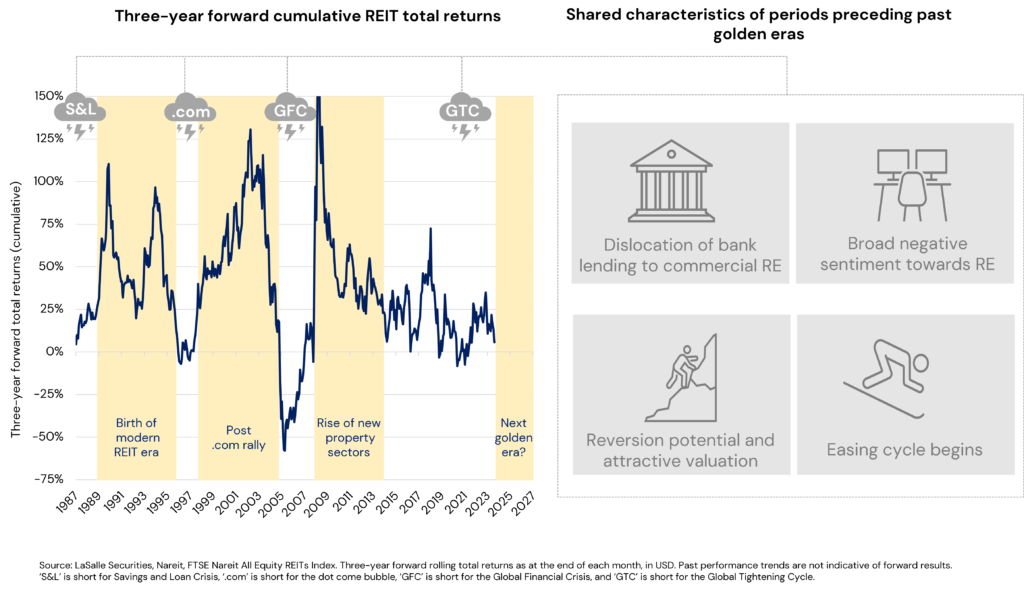
Recent history, marked by a post-pandemic recovery followed swiftly by the Great Tightening Cycle (GTC), presents important similarities to these historical periods of severe market challenges. For instance, real estate bank lending is dislocated. An AI-driven tech frenzy and fears of a generalized “commercial” real estate malaise mean REITs have underperformed compared to equities (see LMQ pg. 22). Meanwhile, signs of an easing or stabilization in financial conditions and a potential global monetary easing cycle are becoming more apparent (see LMQ pgs. 9, 10 and 30).
While history does not repeat itself, it does often rhyme. The presence of those elements in today’s market environment, and the potential for those concerns to flip to opportunities, may foretell the next REIT golden era. We discuss each of these factors in turn.

Challenged real estate lending represents an opportunity for REITs. The past two to three years have been characterized by a significant retrenchment in bank lending to real estate. According to the US Senior Loan Officer Survey (see LMQ pg. 16), the net balance between demand for loans and banks’ willingness to lend points to the widest undersupply of credit in the past ten years, except for during the depths of COVID-19. The shortage is evident in all styles of borrowing, from riskier construction loans to mortgages backed by traditional, defensive apartment assets.
This circumstance presents an opportunity for REITs given their strong financial positions and access to the capital markets. Having learned a painful lesson from the GFC, global REITs went into the GTC with their lowest leverage levels on record (see LMQ pg. 16), and nearly 90% of their debt on fixed rates and an average remaining term of seven years.2 Looking specifically at the US market, the overwhelming majority of REIT borrowing – nearly 80% – is from the unsecured market, at rates that are today almost 100 bps lower than a traditional mortgage. This relative advantage in both access and cost of capital positions REITs to potentially play the role of aggregator and to take market share.

“Commercial” real estate negativity is office-focused, but all real estate is not office. Headlines proclaiming the demise of commercial real estate usually involve a misleading generalization. Professionally managed, income-producing real estate generally should not be conflated with office specifically. It is well known that hybrid work and other factors have harmed office values. Office fundamentals are expected to remain relatively weak,3 with the sector’s growth outlook trailing nearly all other REITs globally. Office landlords will likely need to invest capital aggressively to maintain competitiveness.
These challenging office sector dynamics have unfairly cast a shadow over the broader real estate and REIT universe. In reality, office has over time become a smaller portion of the real estate landscape, especially in the public market; as of the date of this paper, only about 6% of global REITs by market capitalization are office focused (see LMQ pg. 20).4 The public market now offers a diverse sector menu comprising a wide range of dynamic sectors. These include industrial and logistics; forms of rental residential including multi- and single-family rental, manufactured housing and student housing; various formats of healthcare property; and exposure to tech-related real estate in the form of data centers and cell towers. Sectors other than office comprise the overwhelming majority of the public REIT market,5 and many of those sectors have growth outlooks that are forecast to produce earnings growth that is in line with or better than broader equities.6 That growth outlook is underpinned by a combination of secular demand drivers and declining supply levels, the other side of the higher interest rate coin.7
Media coverage naturally tends to focus on the national and trans-national arenas, but local political developments can be especially impactful for real estate investments. Such issues can fly under the radar, especially given many of the most relevant ones are only of interest to a specialist audience. For example, changes in policy around topics like the planning process, property taxes and transfer taxes (a.k.a. stamp duty) can have direct, measurable and immediate impacts on property cash flows and thus values. The distraction of the bright shiny lights of global geopolitics should not be allowed to excessively overshadow the critical local issues that impact real estate.

Underperformance may set the stage for a return to outperformance. The negativity around lending or financing concerns and the “death of office” have weighed on both the absolute and relative performance of REITs. The chart below shows the rolling one-year relative performance differential between REITs and equities; it indicates that REIT underperformance has reached its typical peak historical level before starting to reverse. Periods of underperformance have historically tended to reverse, and this instance is likely no different; indeed, the performance gap is already narrowing.
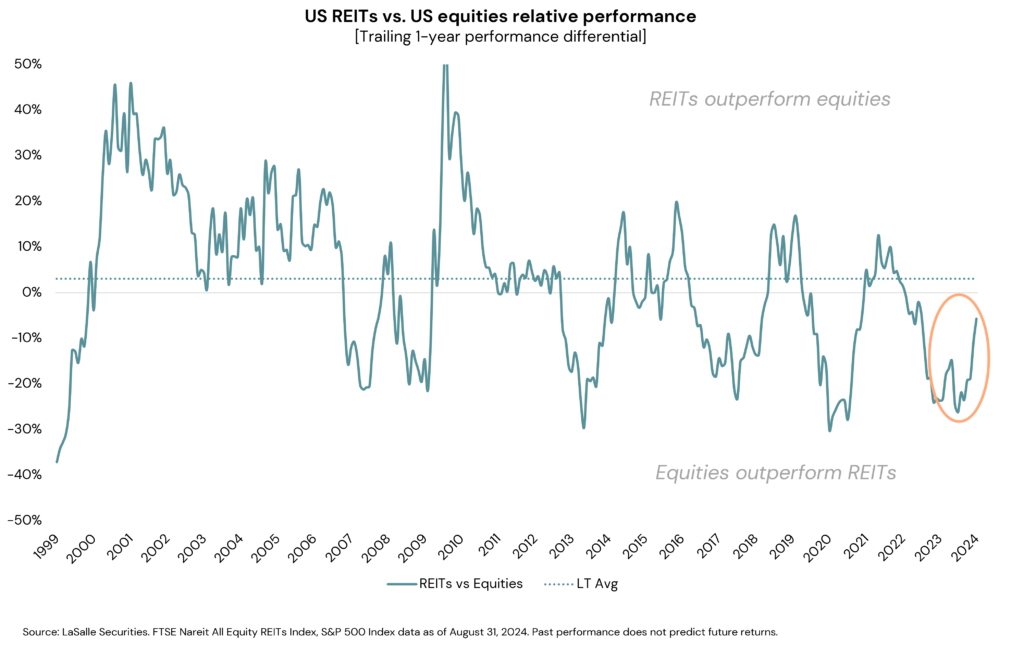

The start of a global monetary easing cycle. Real estate is a capital-intensive business that exhibits significant sensitivity to changes in financial conditions, an observation that holds for both directions of interest rate change. The downside of this dynamic was evident for much of 2022 and 2023, but the upside is likely coming into play. A global monetary easing cycle is now decidedly underway, heralded by the Fed’s 50 bps rate cut on September 18 (see LMQ pg. 31). REITs have generally performed well in periods leading up to and following a central bank easing cycle, as the chart below shows.
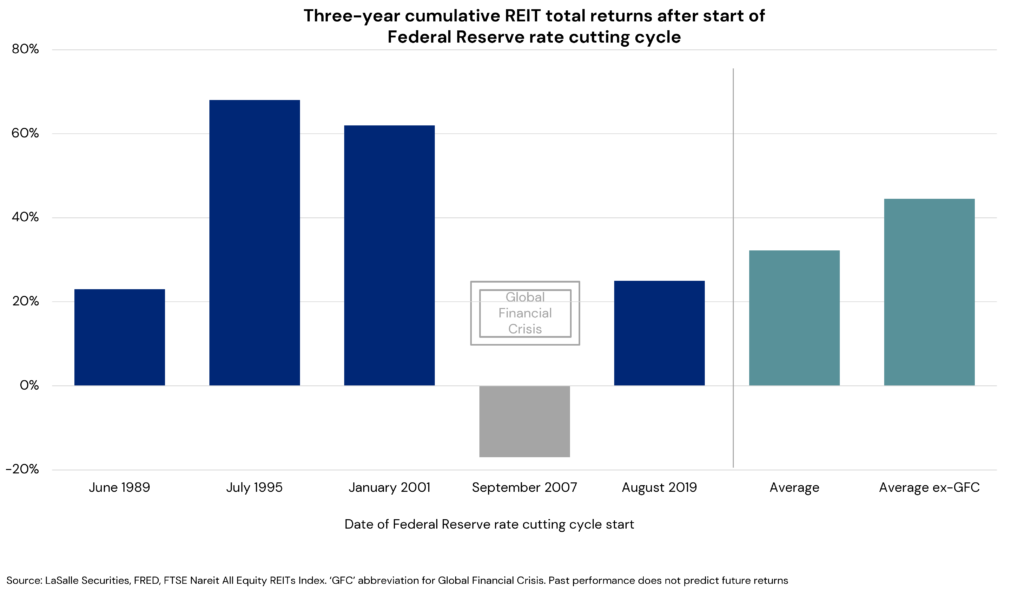
Over the past 25 years, REITs have produced total returns of 8% per annum, with 4-5 percentage points of that return coming from income. LaSalle’s base case underwriting for the next three years is for the REIT market to produce total returns of 9%, slightly above historical averages, with roughly four percentage points of that coming from income. That base case forecast incorporates today’s fundamental outlook and interest rate levels. Should any further easing in financial conditions occur, even only in the amount of 50 bps or 100 bps, those return expectations increase to 13% and 18% per annum, respectively, in line with previous “golden eras.”
LOOKING AHEAD >
- Pattern recognition is a useful approach that can help in predicting regime shifts in market conditions. Our study of historical periods of listed REIT under- and outperformance identifies a clear pattern. Namely, there are four common factors that have driven REIT strength after a period of challenges: dislocated bank finance, weak sentiment, underperformance versus broader equities, and the start of an easing in financial conditions.
- We also identify three historical “golden eras” for REITs — all of which were preceded by periods characterized by those four factors. These periods are those immediately in the wake of the S&L crisis, the Dot-com bust and the GFC.
- The current environment resembles the set up for these historical golden eras, suggesting that the REIT market may be on the cusp of its next golden era of investment, according to our analysis.
- Many of the factors supporting the REIT market’s upbeat prospects are also positives for real estate as a whole. For example, an easing in financial conditions has historically been a driver of strong forward REIT returns, as well as those for private equity real estate.
- That said, some of the dynamics are more specific to listed real estate markets. For example, REITs’ strong balance sheets and the cost of capital advantage of their unsecured borrowing options versus conventional mortgages positions listed players to seize opportunities.
Footnotes
1 This analysis based on LaSalle Securities analysis of historical macroeconomic, capital market and listed market trends. Source for the REIT performance data cited below are the FTSE Nareit indices.
2 Source for debt pricing comments in this paragraph: S&P Global Market Intelligence, Green Street Advisors, company financial releases, company research and market analysis conducted by LaSalle Securities.
3 There is considerable global variation in office performance, and there are certainly exceptions to this generalization, especially in select Asia-Pacific markets and the higher end of the European office quality spectrum. For more discussion of global office trends, see our ISA Outlook 2024 Mid-Year Update.
4 Source: LaSalle Securities. Percent of companies classified as office focused within the global listed universe defined as the constituents of the S&P Developed REIT, FTSE EPRA Nareit Developed and Nareit All Equity Indices. Sector classifications determined by LaSalle Securities.
5 As measured by market capitalization. Source: LaSalle Securities. Global listed universe defined by the constituents of the S&P Developed REIT, FTSE EPRA Nareit Developed and Nareit All Equity Indices. Sector classifications determined by LaSalle Securities.
6 As based on LaSalle Securities proprietary modelling and consensus earnings forecasts for the Bloomberg World Index, a proxy for broader equity markets.
7 Higher interest rates mean development proformas use higher exit yield assumptions and more expensive development finance. When interest rates are high, all else being equal, the rents required to justify development are higher.
8 Based on proprietary internal LaSalle Investment Management modeling of securities returns. There is no guarantee that such forecasted returns, or any other returns referred afterwards, will materialize.
This publication does not constitute an offer to sell, or the solicitation of an offer to buy, any securities or any interests in any investment products advised by, or the advisory services of, LaSalle Investment Management (together with its global investment advisory affiliates, “LaSalle”). This publication has been prepared without regard to the specific investment objectives, financial situation or particular needs of recipients and under no circumstances is this publication on its own intended to be, or serve as, investment advice. The discussions set forth in this publication are intended for informational purposes only, do not constitute investment advice and are subject to correction, completion and amendment without notice. Further, nothing herein constitutes legal or tax advice. Prior to making any investment, an investor should consult with its own investment, accounting, legal and tax advisers to independently evaluate the risks, consequences and suitability of that investment.
LaSalle has taken reasonable care to ensure that the information contained in this publication is accurate and has been obtained from reliable sources. Any opinions, forecasts, projections or other statements that are made in this publication are forward-looking statements. Although LaSalle believes that the expectations reflected in such forward-looking statements are reasonable, they do involve a number of assumptions, risks and uncertainties. Accordingly, LaSalle does not make any express or implied representation or warranty, and no responsibility is accepted with respect to the adequacy, accuracy, completeness or reasonableness of the facts, opinions, estimates, forecasts, or other information set out in this publication or any further information, written or oral notice, or other document at any time supplied in connection with this publication. LaSalle does not undertake and is under no obligation to update or keep current the information or content contained in this publication for future events. LaSalle does not accept any liability in negligence or otherwise for any loss or damage suffered by any party resulting from reliance on this publication and nothing contained herein shall be relied upon as a promise or guarantee regarding any future events or performance.
By accepting receipt of this publication, the recipient agrees not to distribute, offer or sell this publication or copies of it and agrees not to make use of the publication other than for its own general information purposes.
Copyright © LaSalle Investment Management 2024. All rights reserved. No part of this document may be reproduced by any means, whether graphically, electronically, mechanically or otherwise howsoever, including without limitation photocopying and recording on magnetic tape, or included in any information store and/or retrieval system without prior written permission of LaSalle Investment Management.
This article first appeared in PropertyEU’s State of Logistics report
LaSalle’s Petra Blazkova recently joined Property EU’s State of Logistics 2024 conference in Amsterdam to present the firm’s inaugural Paths of Distribution Score research, which gives the ability to compare logistics locations at a micro, market, country and pan-European level.
LaSalle identifies top logistics locations in Europe
Paris and the surrounding Île-de-France region are the top micro-locations for efficient logistics distribution in Europe, according to a new study by LaSalle Investment Management.
The Paths of Distribution study considered over 150,000 micro-locations across the UK and EU, scoring them based on factors like manufacturing output, consumer spending, infrastructure, and labour costs. It also took into account the location of Amazon warehouses and analyzed data from REITs and other real estate databases.
Presenting the results at the Amsterdam logistics event, Petra Blazkova, Europe head of Core and Core-plus Research and Strategy, LaSalle Investment Management, pointed out that the data provides valuable insights for investors seeking the most efficient and attractive logistics locations with the greatest potential for long-term rental growth.
Want to read more?
One of our key conviction sectors for real estate investment over the last few years has been logistics. It has been a particular focus of our research, as we seek to identify investment opportunities in prime locations. But with continued uncertainty around variables such as energy prices and supply chains being disrupted, cost uncertainty is high across the continent for logistics providers.
Location, however, is a key variable which distributors can still control, and so it is more important than ever: optimising your choice of location can help minimise exposure to these other risks and protect your supply chain.
LaSalle’s inaugural “Paths of Distribution Score,” focuses on the geography of the European logistics market. This innovative, granular new research gives us the ability to compare logistics locations at a micro, market, country and pan-European level, with extensive flexibility for understanding, benchmarking and ranking locations – and opportunities to deploy capital – at both micro and macro scale. As investors in the sector, this new insight into the most resilient logistics markets in Europe informs our portfolio composition and asset management.
Want to read the full report?
This article first appeared in the September 2024 edition of PERE
LaSalle’s Isabelle Brennan sat down with peers from other leading alternative credit providers across the US to discuss the state of real estate debt across the United States.
US private lenders eye real estate opportunities as activity ramps up
With banks likely to remain on the sidelines amid regulatory changes, participants in PERE’s US debt roundtable anticipate openings to deploy capital both in refinancing and new acquisitions, Stuart Watson reports.
Over the past 18 months higher interest rates, uncertainty about property values, and questions over secular shifts in demand for some asset classes have combined to suppress activity in US commercial real estate lending markets. Meanwhile both money center and regional banks have scaled back activity in the face of concerns over the health of their balance sheets, and the expected introduction of stricter capital requirements aimed at reducing liquidity risk.
Want to read more?
This article first appeared in the August 2024 edition of IPE Real Assets
With increasing regulations and more investors embedding sustainability goals into their investments, incorporating green targets into the debt component of the capital structure is becoming more common. As a result, the debt market across Europe is becoming a two-tiered market, with more green loans being issued at the same time as overall lending volumes have declined.
In this guest article for IPE Real Assets, Dave White discussed the growing appetite for these loans across Europe, and how both lenders and investors are responding to this changing landscape.
While traditional banks’ appetite for providing commercial real estate loans has declined, other lenders (including investment management firms such as LaSalle) have moved in to fill the funding gap. As a result, we have recently seen increasing interest from institutional investors in real estate debt.
But what is it about real estate debt that makes it a compelling investment? As the second largest of the “four quadrants” of real estate, it has a value in the US and Europe alone of approximately US $4.5 trillion, representing an enormous opportunity. Real estate debt historically has produced competitive risk-adjusted returns in addition to showing low correlation to other assets.
In our latest research, we examine the three-part case for investment, including:
- Real estate debt’s place in institutional portfolios,
- The role of non-bank lending, and
- The debt opportunity today, which takes advantage of a looming debt funding gap and attractive pricing.
Important notice and disclaimer
This publication does not constitute an offer to sell, or the solicitation of an offer to buy, any securities or any interests in any investment products advised by, or the advisory services of, LaSalle Investment Management (together with its global investment advisory affiliates, “LaSalle”). This publication has been prepared without regard to the specific investment objectives, financial situation or particular needs of recipients and under no circumstances is this publication on its own intended to be, or serve as, investment advice. The discussions set forth in this publication are intended for informational purposes only, do not constitute investment advice and are subject to correction, completion and amendment without notice. Further, nothing herein constitutes legal or tax advice. Prior to making any investment, an investor should consult with its own investment, accounting, legal and tax advisers to independently evaluate the risks, consequences and suitability of that investment.
LaSalle has taken reasonable care to ensure that the information contained in this publication is accurate and has been obtained from reliable sources. Any opinions, forecasts, projections or other statements that are made in this publication are forward-looking statements. Although LaSalle believes that the expectations reflected in such forward-looking statements are reasonable, they do involve a number of assumptions, risks and uncertainties. Accordingly, LaSalle does not make any express or implied representation or warranty, and no responsibility is accepted with respect to the adequacy, accuracy, completeness or reasonableness of the facts, opinions, estimates, forecasts, or other information set out in this publication or any further information, written or oral notice, or other document at any time supplied in connection with this publication. LaSalle does not undertake and is under no obligation to update or keep current the information or content contained in this publication for future events. LaSalle does not accept any liability in negligence or otherwise for any loss or damage suffered by any party resulting from reliance on this publication and nothing contained herein shall be relied upon as a promise or guarantee regarding any future events or performance.
By accepting receipt of this publication, the recipient agrees not to distribute, offer or sell this publication or copies of it and agrees not to make use of the publication other than for its own general information purposes.
Copyright © LaSalle Investment Management 2024. All rights reserved. No part of this document may be reproduced by any means, whether graphically, electronically, mechanically or otherwise howsoever, including without limitation photocopying and recording on magnetic tape, or included in any information store and/or retrieval system without prior written permission of LaSalle Investment Management.
LaSalle is one of Europe’s largest and most established investors in real estate debt, offering a variety of loan types across sectors. Learn more about this dynamic asset class, and LaSalle’s capabilities from Dave White, Head of European Debt Strategies here at LaSalle.
Want to read more?
Dave White, Head of Real Estate Debt Strategies, Europe discusses the market in 2024 and where we are seeing opportunities for investors.
Want to read more?
“You take the blue pill—the story ends, you wake up in your bed and believe whatever you want to believe. You take the red pill… all I’m offering is the truth.”
– Morpheus to Neo, The Matrix (1999)
We published the global chapter of the ISA Outlook 2024 on November 14, 2023, just before euphoria about a potential ‘V’-shaped property market turnaround emerged. Interest rates fell quickly as financial markets priced in several US Federal Reserve (Fed) rate cuts in 2024. For a time, it looked as though our prediction that it would take a little longer for markets to digest a renewed spike in rates would not age well.
In this Mid-Year Update, however, we look back to find an outlook with an uncanny resemblance to that of six months ago. This is not because nothing has changed, but because the mood has gone full circle. The landscape remains characterized by interest rate volatility, soft fundamentals in some markets, and gaping quality divides, but also by pockets of considerable strength. Another factor that has not changed is that financial conditions (i.e., interest rates) remain the dominant driver of the market, and that political and geopolitical uncertainties are in focus in many countries (see LaSalle Macro Quarterly, or LMQ, pages 4-6).1
In this report, we discuss five themes we see driving real estate markets for the rest of 2024 and beyond. At our European Investor Summit in May, our colleague Dan Mahoney argued that—like Neo in the Matrix—we should take the red pill and endeavor to see the market as it is, not as we’d like it to be. Taking the red pill requires a realistic view on property values. It reveals as unlikely a return to an environment of ultra-low interest rates or uniformly benign fundamentals in the “winning” sectors.
But it does not mean that there will not be attractive investment opportunities. Unlike the bleak dystopia of The Matrix, there are many reasons for optimism, as well as signs that the coming months will come to be seen as a favorable investment vintage. That said, investing successfully will require a balance of big-picture perspective and granular discernment, and a mix of patience and willingness to take risk.
Interest rates – Still no map to the trail
Over the past year, we likened the interest rate path in most markets to a strenuous mountain trek: the relentless climb (2022), the range-bound altitude of an alpine ridge line (H1 2023), the unexpected upward turn in the trail (Q3 2023), and the mountain meadow of cooling inflation and expected rate cuts (Q1 2024). More recently, there have been upward turns in the interest rates trail whenever there have been signs of sticky inflation in the US and other key countries.

One thing is for sure: No map exists for this trail. While interest rates have big consequences for real estate capital markets, they are extremely difficult to predict. We continue to caution investors against overconfidence in their ability to forecast the path of long-term interest rates.
Mercifully, falling rates are not a necessary condition for a robust recovery in real estate transaction activity. Despite interest rates remaining elevated, property markets are already showing signs of finding their footing, such as renewed US CMBS issuance and resilient deal volumes in many markets and sectors.2 A key reason for this is that wherever interest rates have spiked over the past two and half years, especially Europe and North America,3 real estate prices have by now adjusted downward significantly. The relativities between expected returns for real estate and those for other asset classes now look more appropriate than they have in many months; in other words, more of the market is at or near fair value.4
That said, while lower rates are not necessary for real estate capital market normalization, greater stability in rates than we have been seeing would no doubt help. Interest rate volatility is the enemy of a smoothly functioning private real estate transaction market. Excessive movement in borrowing costs during due diligence periods can lead to dropped deals and re-trades. Moreover, when rates are volatile, the conclusions of fair value models are also volatile, impacting both buyers’ and sellers’ assessments of appropriate pricing. Looking at recent trends in the MOVE index,5,6 interest rate volatility appears to be gradually easing but is still elevated relative to recent history (see LMQ page 13).
Increasing stability in rates is welcome, but for now it is reasonable to expect continued strains in real estate capital markets that create both challenges and opportunities. Such conditions can represent favorable entry points for debt investors (lenders), distressed equity players and core investors seeking entry points below replacement
Macro – Deciphering divergence
Over the past half-year, interest rates have been increasingly influenced by widening divergences between near-term growth, inflation and monetary and fiscal policy outlooks. Most notably, the bond yield gap between the US and other markets, especially the eurozone, has widened. US growth and inflation have surprised on the upside, in the face of softening or stability elsewhere. Markets currently expect only one Fed rate cut in 2024, down from up to four earlier in the year.7 Meanwhile, in early June the Bank of Canada became the first G7 central bank to cut rates since the great tightening cycle began, with the European Central Bank (ECB) following shortly after (see LMQ page 7).
Regional groupings can obscure divergences within them. The key driver of eurozone softness is Germany (see LMQ page 23), owing to its reliance on manufacturing exports and past dependance on Russian energy. Meanwhile, the Spanish economy remains strong due to healthy consumption and tourism. Within North America, Canada’s economy is underperforming the US because the structure of its residential mortgage market makes it more exposed to higher rates.8 These intra-regional variations may have a range of impacts on property markets, for example by shifting the relative short-term prospects for demand and value.
Japan and China represent long-standing divergences that persist.9 In China, a loosening bias remains in effect as inflation hovers at around 0%.10 In Japan, monetary policy is gradually normalizing, but so far without triggering a big increase in interest rates (at least compared to elsewhere). In March, the Bank of Japan (BOJ) abandoned negative interest rates and ended most unorthodox monetary policies, though it has since held policy interest rates at around zero. Japan’s economy becoming more “normal” is generally a positive, but interest rate differentials have pushed the yen to a 34-year low against the US dollar (see LMQ page 14), creating upside risks to inflation.11 But notably, Japan remains the one major global market in which real estate leverage remains broadly accretive to going-in yields.
Aside from reinforcing the potential benefits of diversification, what do these divergences mean for investors? Mechanically, any unexpected relative softening of interest rates should, all else equal, be beneficial for relative value assessments of real estate in that market. But firmer rates in the US have predictably come alongside a stronger US dollar. This points to practical limits to global monetary policy divergences; central bankers are keenly aware that weaker currencies come with inflationary risks. Moreover, it is worth asking how persistent macro divergences will be; current divergences are rooted in timing differences of expected rate cuts, rather than an anticipated permanent disconnect.
Renewed cyclicality — Ride the (supply) wave
For several years, secular themes and structural shocks have dominated the trajectories of global property markets. But there is a clear cyclical pattern reemerging in the form of a pronounced upswing in vacancy across global logistics markets, and in US apartments. The return of cyclicality in those favored sectors is having significant impacts on their near-term prospects.
The softening trend is not new. In the ISA Outlook 2024, we identified hot sectors “coming off the boil.” Part of this was down to normalizing demand levels, but elevated new supply was also a key driver. As expected, the softening we observed has continued to deepen, leading to outright rent declines in certain markets, especially for apartments in US sunbelt metros.
Softening fundamentals are not to be ignored, but we recommend investors to have the conviction to “ride the wave” of excess supply. Wide variation in supply levels at the market and submarket level means that investors with granular market data and the discipline to incorporate it into their market targeting processes should be positioned to select the most attractive markets and submarkets.

Moreover, the forces that create cycles sow the seeds of their own reversal; we expect the current supply wave to moderate soon, as evidenced by sharply falling construction starts (see LMQ page 25). Many of the projects being completed today broke ground when credible exit cap rate assumptions were several hundred basis points lower than today. Higher interest rates upended development economics; far fewer new developments can now be justified on today’s mix of land prices, construction costs and financial conditions.
Finally, investors should be prepared to think about cash flows in both real and nominal terms. When cooling nominal rental growth comes alongside cooling inflation, as it does today, it is possible for that to be consistent with solid real rental growth, depending on the relative magnitude of each.
The next chapters in secular change
Beyond the reassertion of supply cycles in some markets, there is an evolving mix of secular stories that deserve attention. Some of these are so long-standing that they could almost be considered constants. These include structural shortages of housing in most of Europe, Canada and Australia, as well as the widespread changing definition of core real estate in favor of more operational niche sectors and sub-types.12 We continue to be strong advocates for investment in undersupplied living sectors, and for participating in the institutionalization and growth of niche sub-sectors such as single-family rental (SFR) and industrial outdoor storage (IOS).
More dynamic themes that deserve a closer look include the stabilization of retail real estate and divergent office investment prospects:
- Rebalanced retail — In much of the world, the various sub-sectors of retail are on firmer ground than they have been in years. This owes to a nearly decade-long process of rebalancing, supported by normalizing post-pandemic demand trends and the removal, through demolition or irrelevance, of uncompetitive retail inventory. We have found retail assets to be some of the most stable performers in our portfolio in recent quarters. While the consumer mood is bifurcated between healthy higher-end households and lower-income households struggling with inflation’s hit to real spending power, physical retail has proven its enduring role in serving both convenience and experiential shopping. We are constructive on selective investment in several retail sub-types, particularly European outlet centers, top Canadian regional malls, and select open-air centers in the US.
- All-over-the-map office — The office sector is quite literally “all over the map”, with huge variation in outlook depending on geography, ranging from Seoul, South Korea, where office market conditions are currently tighter than nearly any other market/sector combination globally, to the many North American office markets where vacancy rates are well into double digits. We stand by our long-held views13 on the widely varying prospects for global office markets, with Asia-Pacific markets (ex-Australia and China) having the best near-term outlook, US markets having the worst, and Europe in between. One office sector theme that deserves special mention is the increasingly compelling case for investment in super-prime offices in a handful of key European central business districts. We see the conditions for a substantial shortage of top-quality space several markets, which should lead to substantial rent spikes for the best positioned assets.
Other key secular themes driving investment opportunities today include the implications of artificial intelligence (AI) adoption for data center demand, student mobility for student accommodation in Europe and Australia and aging for senior housing.
Don’t wait for the “all clear”
Past experience of real estate cycles suggests that the best investment opportunities tend to arise in periods marked by significant uncertainty, volatility and pessimism, but also when early signs of improvement and stabilization are present—in other words, moments similar to today’s environment. Experience also reinforces that it is nearly impossible to time the market, so it is best to be selectively active throughout the cycle. By the time the “all clear” signal is sounded after a market crisis, it is too late to achieve the best risk-adjusted returns.
That said, “red pill” thinking means we must recognize that the coming capital market rebound is unlikely to be as sharp as it was after the Global Financial Crisis (GFC), given that central banks are unlikely to usher in ultra-loose policy. Seeing the market as it is requires accepting the likelihood that interest rates could remain sticky, and a realistic view of near-term fundamentals as a wave of supply impacts some sectors.
LOOKING AHEAD >
- Strategies for both new and existing investments must take a realistic stance on interest rate uncertainty, with duration exposures aligned to an investor’s goals and risk appetite. Using real estate as a vehicle to place bets on bond markets is as inefficient as it is misguided. We continue to recommend that investors be largely “takers” of bond market signals, and today those are pointing to interest rates remaining high for longer in the US and several other key markets.
- Upended development economics in many markets and sectors means that assets can be bought well below replacement cost, suggesting rents will need to rise and/or land prices will need to fall to justify incremental supply. While buying below replacement cost can be one indicator of a potentially attractive acquisition opportunity, we are cautious about using replacement costs in isolation as an investment decision-making tool. It is essential to adjust for the capital expenditure required to truly equalize the market position of a new asset versus an old one. Often a building is worth less than the cost to build a new building simply because it is old and uncompetitive.
- The anchor of “replacement cost rents” only operates when there is a fundamental need for additional space. In heavily vacant markets, such as US offices, it likely will be years before this mechanism kicks in. Investors acquiring below replacement cost in heavily unbalanced markets must be prepared to wait a long time for that discount to close, and the extended passage of time to monetize a discount is mathematically deleterious to IRRs. A focus on markets working through short-term challenges such as a wave of new supply, but characterized by long-term strength, may generate the best risk-adjusted returns.
- Market bottoms are hard to see in the moment, and only tend to become obvious in retrospect many months down the line; it is hard to see today whether we are fully clear of the lowest point in prices. But we have a least moved from a period of relentless upward movement in rates to volatility around a pivot point. Moreover, challenged capital stacks built before the great tightening still need repair. Both observations point to potentially strong opportunities to invest today across real estate debt and equity.
Footnotes
1 Also see our ISA Briefing, “Elections everywhere, all at once: Geopolitics and risk”, April 2024. In that note, we highlighted the various sources of political uncertainty this year and outlined how we recommend investors consider these risks. At the time of writing, political developments are particularly salient for short-term movements markets in France and the UK, given elections that have been called in those countries.
2 Source: MSCI Real Capital Analytics and Trepp
3 Japan and China are key exceptions that we cover in greater depth under the “deciphering divergence” header.
4 Of course, there is considerable variation embedded in this and any assessment of fair value. As always, the devil is in the detail on the assumptions that go into expected and required returns; at LaSalle, specific fair value inputs and conclusions remain a proprietary output.
5 The Merrill Lynch Option Volatility Estimate (MOVE) is a market-implied measure of volatility in the market for US Treasuries. It calculates options prices to reflect the expectations of market participants on future volatility. Observation made as of June 24, 2024.
6 Source: Bloomberg as of June 26, 2024.
7 For more discussion of the Canada-US divergence and the consequences of mortgage rate resets, see our ISA Briefing, ”The impact of residential mortgage resets”.
8 For more detailed discussion of the unique factors in the Japanese and Chinese macro environment, see our ISA Briefing, “Key economic questions for China and Japan”.
9 Source: Oxford Economics; Gavekal Dragonomics as of June 26, 2024.
10 Economic theory suggest that weak currency may contribute to inflationary forces because it pushes up the cost of imported goods.
11 See our PREA Quarterly article on “The Changing Definition of Core Real Estate” for a discussion of how the characteristics considered desirable in core properties is moving from traditional metrics like lease length, to observed qualities like the stability of cash flows. This shift elevates the appeal of niche sectors sub-sectors versus traditional sectors such as conventional office.
12 See our ISA Focus report “Revisiting the future of office”, published March 2023.
Important notice and disclaimer
This publication does not constitute an offer to sell, or the solicitation of an offer to buy, any securities or any interests in any investment products advised by, or the advisory services of, LaSalle Investment Management (together with its global investment advisory affiliates, “LaSalle”). This publication has been prepared without regard to the specific investment objectives, financial situation or particular needs of recipients and under no circumstances is this publication on its own intended to be, or serve as, investment advice. The discussions set forth in this publication are intended for informational purposes only, do not constitute investment advice and are subject to correction, completion and amendment without notice. Further, nothing herein constitutes legal or tax advice. Prior to making any investment, an investor should consult with its own investment, accounting, legal and tax advisers to independently evaluate the risks, consequences and suitability of that investment.
LaSalle has taken reasonable care to ensure that the information contained in this publication is accurate and has been obtained from reliable sources. Any opinions, forecasts, projections or other statements that are made in this publication are forward-looking statements. Although LaSalle believes that the expectations reflected in such forward-looking statements are reasonable, they do involve a number of assumptions, risks and uncertainties. Accordingly, LaSalle does not make any express or implied representation or warranty, and no responsibility is accepted with respect to the adequacy, accuracy, completeness or reasonableness of the facts, opinions, estimates, forecasts, or other information set out in this publication or any further information, written or oral notice, or other document at any time supplied in connection with this publication. LaSalle does not undertake and is under no obligation to update or keep current the information or content contained in this publication for future events. LaSalle does not accept any liability in negligence or otherwise for any loss or damage suffered by any party resulting from reliance on this publication and nothing contained herein shall be relied upon as a promise or guarantee regarding any future events or performance.
By accepting receipt of this publication, the recipient agrees not to distribute, offer or sell this publication or copies of it and agrees not to make use of the publication other than for its own general information purposes.
Copyright © LaSalle Investment Management 2024. All rights reserved. No part of this document may be reproduced by any means, whether graphically, electronically, mechanically or otherwise howsoever, including without limitation photocopying and recording on magnetic tape, or included in any information store and/or retrieval system without prior written permission of LaSalle Investment Management.
In 2024 to date, European markets have pivoted through inflection points on interest rates, economic growth, and property capital markets – which we graph and unpeel in our latest LaSalle European Market View chartbook.

Cyclical shifts are interacting with geopolitical risks in 2024 – from trade headwinds to energy and migration demographics – to create volatility and to shape changes in Europe’s occupier demand and investor risk appetite, all as the region stands on the cusp of an unexpectedly active summer election season.
We cover the latest real estate market trends in 2024 to date. Particularly notable is how a combination of moderating inflation and resilient fundamentals has led to an improvement in real – after inflation – market rent growth, even as nominal rent change has come off the boil.

Want to read more?
This article first appeared in the June 2024 edition of PERE
LaSalle’s Dan Mahoney sat down with peers from across the industry to discuss the state of the UK real estate market.
UK real estate’s rocky road to recovery
After a period of political and economic turbulence, not to mention real estate market paralysis, participants in PERE’s UK roundtable anticipate calmer waters ahead, writes Stuart Watson
For the participants in this year’s PERE UK roundtable discussion, certainty is a welcome thing, following as it does a prolonged period of political turbulence that saw the UK withdraw from the European Union, combined with both the covid-19 pandemic and the global supply chain and inflation shocks that disrupted the UK real estate investment market.
Want to read more?
This article first appeared in the May 2024 edition of PERE
LaSalle’s Dave White sat down with peers from other leading alternative credit providers across Europe to discuss the state of real estate debt across the continent.
Opportunities are slow to unfold in European real estate debt
A golden era for alternative real estate lenders has so far failed to get underway. But there are signs the machinery is becoming unclogged, writes Judi Seebus
A year ago, alternative real estate lenders in Europe were convinced they were on the cusp of a golden age. During PERE’s European debt roundtable discussion in March 2023, participants spoke of a “huge” opportunity ahead to take advantage of a potential shortfall in refinancing funds for maturing loans amid a potential retrenchment from traditional lending sources. “I have seldom been this excited to be investing in debt,” said one participant.
Want to read more?
This article first appeared in the May 2024 edition of PERE
Kunihiko Okumura, LaSalle’s Japan CEO and Co-Chief Investment Officer for Asia Pacific, speaks with PERE about why Japan continues to be an attractive market.
Looking up: Investors stay positive at the end of an era
The return of steady inflation to Japan will put pressure on asset management skills, but there are opportunities across the board, says LaSalle’s Kunihiko Okumura
In an interview with PERE for its 2024 Japan report, Kunihiko Okumura, LaSalle’s Japan CEO and Co-CIO for Asia Pacific, shared his outlook on the market, including the impact of Japan’s interest rate hike and opportunities across various sectors such as office, multifamily and logistics.
Want to read more?
Roughly 60% of the world’s population lives in countries facing major elections in 2024, markets representing 65% of the institutional investable real estate universe.1 Elections are, of course, the cornerstone of the democratic process, which in turn underpins the appeal of the most transparent, investable markets; that said, elections come with the possibility of policy changes that may impact returns. Today’s geopolitical risks, whether they be this continuing election super-cycle (see LaSalle Macro Quarterly, or LMQ, page 4), or the various ongoing conflicts and trade disruptions, prompt important questions about how to manage investment risks related to these themes.
One of the protagonists in the Oscar-winning film Everything Everywhere All at Once says that being “’right’ is a small box invented by people who are afraid.” LaSalle’s risk management philosophy emphasizes optimizing risk/return trade-offs rather than minimizing risk-taking, while recognizing the limitations of point-estimate predictions and base-case scenarios — that is, attempts at “being right.” Today’s geopolitical events are especially likely to confound any forecaster seeking to be exactly right.
How should an investor manage their assets in the context of “unknowables” about which engaging in guesswork is tempting, but being “right” is elusive? What frameworks do we have to mitigate geopolitical risks? We propose six recommendations to keep in mind for investors taking stock of the many elections, and several conflicts, that may impact markets in 2024.
1. Be mindful of the tendency toward overreaction.
There are many examples of ex ante predictions of elections’ investment implications having been overstated. For instance, leading up to the 2016 US presidential election, there were widespread predictions that the US economy would be significantly negatively impacted by Donald Trump’s anti-immigration and protectionist stance were he elected.2 In the event, equity markets rebounded strongly after a short-lived hit and the US economy proved resilient to the changes in rhetoric and policy that came with a new president.3
Looking ahead to the US elections later this year, almost certainly a rematch between Biden and Trump, coverage of the candidates’ differences should be accompanied by awareness of their similarities. Both candidates seek to prioritize domestic production, which could lead to greater levels of on- or near-shoring of supply chains.4 Moreover, election prediction odds (see LMQ page 6) suggest divided control of the two houses of Congress and the presidency is likely; divided government has typically been associated with relative stability in domestic policy, which is generally positive for markets.5 Both of these factors — at least in isolation — point to the potential for news cycle hype to overstate long-term market impacts of this particular election.
2. Consider an asset’s “geopolitical beta.”
Financial theory tells us that systematic risks are undiversifiable.6 Systematic factors are those with significant, far-reaching implications that affect the price of all assets. But financial theory also entertains that different assets may have different sensitivities to the same set of factors; an asset’s “beta” signifies the responsiveness of its price to a given factor. This is a useful way to think about an investment’s sensitivity to political and geopolitical events. For example, a property in a metro area whose economy is heavily driven by government spending would likely have a high sensitivity to political changes. Another example could be that a property located in the Baltic States, ex-Soviet countries on the border with Russia, is likely to be especially sensitive to developments concerning relations between Russia and the West. Investors should be mindful of assets’ expected sensitivities to geopolitics, whether assessed empirically or, as is more often the case given a lack of data, estimated through intuition.
3. Avoid excessive focus on catastrophic risks.
Systemic risks go beyond systematic factors; they involve severe shocks that have the potential to re-align entire markets in unpredictable ways. An example of such an extreme event is the remote but non-negligible potential that today’s so-called “proxy wars”7 escalate into a broader active conflict between great powers.8 The challenge of incorporating such eventualities into investment decision making is not only estimating appropriate probabilities that such events may occur, but establishing ideal strategic responses should they do so. Catastrophic shocks are exceedingly rare and have the potential to create winners and losers in asset markets that are difficult or impossible to predict.9 It may be more fruitful for investors to focus on more incremental — and more likely — eventualities that have the added benefit of being easier to model.
4. Do not neglect local political risks.
Media coverage naturally tends to focus on the national and trans-national arenas, but local political developments can be especially impactful for real estate investments. Such issues can fly under the radar, especially given many of the most relevant ones are only of interest to a specialist audience. For example, changes in policy around topics like the planning process, property taxes and transfer taxes (a.k.a. stamp duty) can have direct, measurable and immediate impacts on property cash flows and thus values. The distraction of the bright shiny lights of global geopolitics should not be allowed to excessively overshadow the critical local issues that impact real estate.
5. Practice diversification but engage in “pattern recognition.”
To a certain extent, political risks can be managed through diversification. This is especially true when they involve isolated events that impact one country or subnational division such as a specific city, province or state. But often political events are part of a broader arc with potentially far-reaching consequences. A smattering of small seeds can grow from obscurity into a thicket. Nothing illustrates this better than the rise of populism, nationalism and protectionism around the world, themes set to dominate elections this year and beyond. The very notion of “globalized nationalism” may sound like an oxymoron, but it has become a fact.10 While diversification is an essential portfolio construction concept that helps manage many types of risk, including political risk, care must be taken to recognize when what may appear to be “specific” risks are part of a broader pattern that is difficult to “diversify away.”
6. Conduct “what if” exercises around potential impacts.
Geopolitical and political risks are difficult to incorporate into traditional financial analysis. We find that thinking through scenarios can be helpful in identifying investment themes that may emerge from geopolitical trends. These can point to strategies to avoid — as well as potential new ones to pursue. The “Looking Ahead” section of this note expands on some of the key themes we have been tracking.
As geopolitical events are difficult to control and plan for, one may conclude, similarly to that same protagonist in the Everything Everywhere film, that “nothing matters.” But uncertainty is no excuse for ignoring geopolitical risks. We do stop short of directly feeding geopolitical themes into our formal risk management program, where the focus is on the specific risks that can actively be managed for our clients.11 However, it remains important to observe and understand macro conditions from a holistic perspective. The work done in our regional research teams — particularly that focused on capital markets, the signals that foreshadow potential inflection points and the local political themes that impact real estate — is critical to this effort.
Looking ahead
We have argued that political and geopolitical risks are difficult to incorporate into investment processes, but that considering “what ifs” can be useful in uncovering relevant investment themes. Below are three potential real estate implications of the current geopolitical backdrop that we are monitoring today:
- Policy uncertainty widens the corridor of possible market outcomes, and has been empirically shown to translate into greater volatility in financial markets and decreased investment decision-making in the real economy.12 There are likely impacts on both broader investment at the macroeconomic level, as well as real estate transactions activity specifically. We continually monitor key indicators of policy uncertainty (see LMQ page 7).
- Geopolitical factors should be assessed for their potential impact on inflation and monetary policy. To the extent these interrupt cooling inflation trends and thereby slow the rate at which interest rates moderate, there could be an impact on the trajectory of the real estate recovery. For example, continued attacks on the critical Red Sea shipping route (LMQ Page 10) have caused a five-fold increase in the cost of shipping goods from Asia to Europe. Estimates suggest the impact of this is likely small, temporarily adding just 0.3% back to global core inflation in the first half of 2024,13 but it does serve as a reminder of the volatility that geopolitics can trigger.
- On a longer timescale, geopolitical fracturing could lead to increased levels of on- and near-shoring and could thus lead to the duplication of supply chains.14 This is less efficient than a fully globalized world where countries’ exports are specialized according to comparative advantage, and is therefore likely to correspond to higher long-term inflation.15 That said, analysis by LaSalle suggests that the localization of supply chains could be beneficial for real estate demand, particularly in the logistics sector and in politically aligned, lower cost markets adjacent to major ones, such as along the Mexico-US border.
Footnotes
1 LaSalle analysis of data from Time and our proprietary investable universe estimates. See LMQ page 5 for more detail.
2 Sources: “What do financial markets think of the 2016 election?” Brookings Institution paper, Wolfers and Zitzewitz, 2016. The article predicted that “a Trump victory would trigger an 8-10% sell-off”. See also “The Consequences of a Trump Shock,” a Project Syndicate article by Simon Johnson, 2016. He predicted Trump’s election would “likely cause the stock market to crash and plunge the world into recession.”
3 On the news of the 2016 election result, Standard & Poor’s 500-stock index initially fell 5% but ended the day up more than 1%, according to Refinitiv. The US avoided a recession until the emergence of the COVID-19 pandemic, according to Oxford Economics.
4 Source: “Biden vs Trump: Key policy implications of either presidency,” Economist Intelligence Unit, 2023.
5 Sources: “What to Expect From Divided Government.” PIMCO article, Cantrill, 2022. According to the article, “the equity markets historically have tended to do well in years of split government.”
6 Source: The Handbook of Risk Management: Implementing a Post-Crisis Corporate Culture. P. Carrel, 2012. “Systematic or market risk refers to the inherent danger present throughout the entire market that cannot be mitigated by diversifying your portfolio. Broad market risks include recessions, periods of economic weakness, wars, rising or stagnating interest rates, fluctuations in currencies or commodity prices, and other ‘big-picture’ issues like climate change. Systematic risk is embedded in the market’s overall performance and cannot be eliminated simply by diversifying assets.”
7 According to the Oxford Dictionary, “proxy wars are the replacement for states and non-state actors seeking to further their own strategic goals yet at the same time avoid engaging in direct, costly, warfare.” Various observers have argued that the Russia-Ukraine and Israel-Gaza conflicts are proxy wars. For example, see “IKs the ware in Ukraine a proxy conflict?” Kings College London report, Hugues (2022).
8 According to a research brief by RAND: “Great power wars — conflicts that involve two or more of the most powerful states in the international system. These have historically been among the most consequential international events.”
9 Source: “What a third world war would mean for investors,” The Economist, 2023. The article highlights the virtual impossibility of positioning an investment portfolio to outperform through prior world wars, even if the investor had correctly predicted that these conflicts would occur.
10 For further discussion of the global spread of nationalism, see “How cynical leaders are whipping up nationalism to win and abuse power”, The Economist, 2023; “Demonizing nationalist parties has not stemmed their rise in Europe,” The Economist, 2022; “The new nationalism,” The Economist, 2016.
11 We do, however, utilize tools that correlate to geopolitical risk. For example, the JLL Global Real Estate Transparency Index (GRETI) supports our monitoring of evolving investment conditions around the globe. Whilst the model does not explicitly consider political risk, the two are inexplicably linked through the inclusion of a number of governance and regulation data points.
12 Source: “A global economic policy uncertainty index from principal component analysis,” Finance Research Letters, Peng-Fei Dai, 2019.
13 Source: “What are the impacts of the Red Sea shipping crisis,” J.P. Morgan, 2024.
14 Source: “The Great Rewiring: How Global Supply Chains Are Reacting to Today’s Geopolitics,” Center for Strategic & International Studies, 2022.
15 Sources: “The business costs of supply chain disruption,” Economist Intelligence Unit, 2021 and “Why Deglobalization Makes US Inflation Worse,” Project Syndicate, Moyo, 2022.
This publication does not constitute an offer to sell, or the solicitation of an offer to buy, any securities or any interests in any investment products advised by, or the advisory services of, LaSalle Investment Management (together with its global investment advisory affiliates, “LaSalle”). This publication has been prepared without regard to the specific investment objectives, financial situation or particular needs of recipients and under no circumstances is this publication on its own intended to be, or serve as, investment advice. The discussions set forth in this publication are intended for informational purposes only, do not constitute investment advice and are subject to correction, completion and amendment without notice. Further, nothing herein constitutes legal or tax advice. Prior to making any investment, an investor should consult with its own investment, accounting, legal and tax advisers to independently evaluate the risks, consequences and suitability of that investment.
LaSalle has taken reasonable care to ensure that the information contained in this publication is accurate and has been obtained from reliable sources. Any opinions, forecasts, projections or other statements that are made in this publication are forward-looking statements. Although LaSalle believes that the expectations reflected in such forward-looking statements are reasonable, they do involve a number of assumptions, risks and uncertainties. Accordingly, LaSalle does not make any express or implied representation or warranty, and no responsibility is accepted with respect to the adequacy, accuracy, completeness or reasonableness of the facts, opinions, estimates, forecasts, or other information set out in this publication or any further information, written or oral notice, or other document at any time supplied in connection with this publication. LaSalle does not undertake and is under no obligation to update or keep current the information or content contained in this publication for future events. LaSalle does not accept any liability in negligence or otherwise for any loss or damage suffered by any party resulting from reliance on this publication and nothing contained herein shall be relied upon as a promise or guarantee regarding any future events or performance.
By accepting receipt of this publication, the recipient agrees not to distribute, offer or sell this publication or copies of it and agrees not to make use of the publication other than for its own general information purposes.
Copyright © LaSalle Investment Management 2024. All rights reserved. No part of this document may be reproduced by any means, whether graphically, electronically, mechanically or otherwise howsoever, including without limitation photocopying and recording on magnetic tape, or included in any information store and/or retrieval system without prior written permission of LaSalle Investment Management.
Purpose-built student accommodation (PBSA) in Europe ranks as one of our top-conviction sectors for investment in the coming years. No longer deserving of the “niche” label in the United Kingdom, it is already more institutional than any other type of living sectors property in the country and is rapidly maturing in Continental Europe as well. The rise of student accommodation on investors’ buy lists is for good reason. This ISA Briefing will set out why that is so and discuss how the sector stands out in Europe compared with student housing in the rest of the world.
Demand factors
After a brief, pandemic-induced interruption, in-person learning in Europe is back with more students enrolled than at any point in history. Higher education participation rates in the European Union have steadily risen across recent years, reaching an all-time high of 36% for 20-24 year-olds1 in 2021/22, with the same proportion recorded for the UK in 2023.2 A total of 18.5 million students were studying in the EU as of the 2021/22 academic year, with a further 2.9 million in the UK, having grown by 8% and 20%, respectively, over the previous five years.3
Demand for PBSA varies by profile of student. While domestic students are still crucial as a source of demand, particularly in markets where few students commute from home to study, international students are far more likely to reside in PBSA than domestic students (60% more likely to do so in the UK, as an example4). As shown in the chart below, international student mobility has been on a clear growth trend in recent years, with 2021/22 seeing a record number of foreign students in the EU and UK. European students studying outside their home countries elsewhere in Europe is a longstanding feature of the market, facilitated by freedom of movement within the EU, well-established student exchange programs, the rise of English-language courses and Europe’s dense geography.
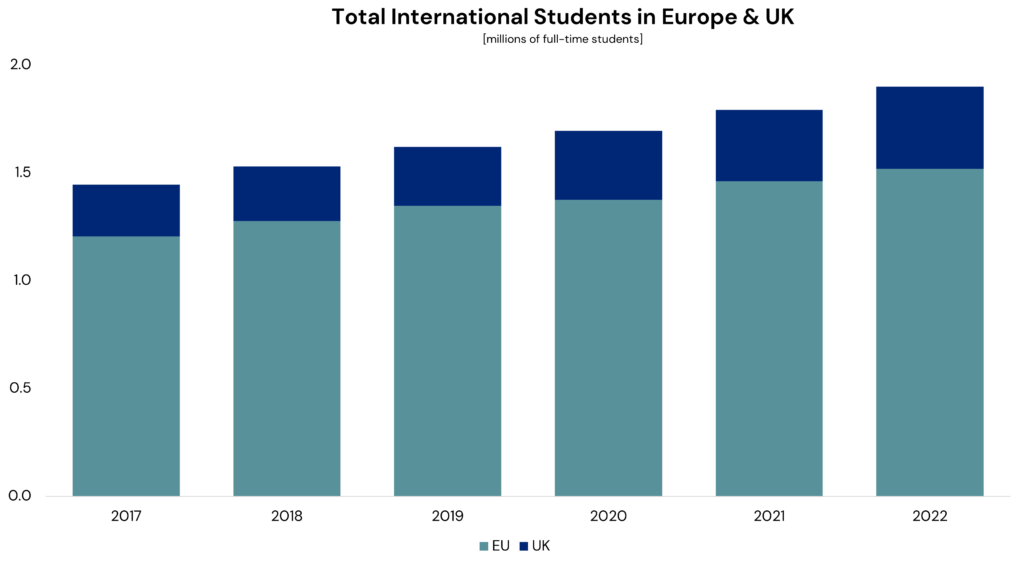
A key driver of growth has been students from outside Europe. Europe has an outsized number of highly ranked universities relative to its size,5 a prevalence of English-language courses (which are increasingly no longer limited to the UK and Ireland) at a comparatively cheaper cost of tuition and living compared to North America.6 These attributes taken together can explain the sharp rise in non-EU students studying in the bloc, whose numbers have grown 31% since 2016.7 In the UK, the growth has been even faster, at 59% over the same period.8
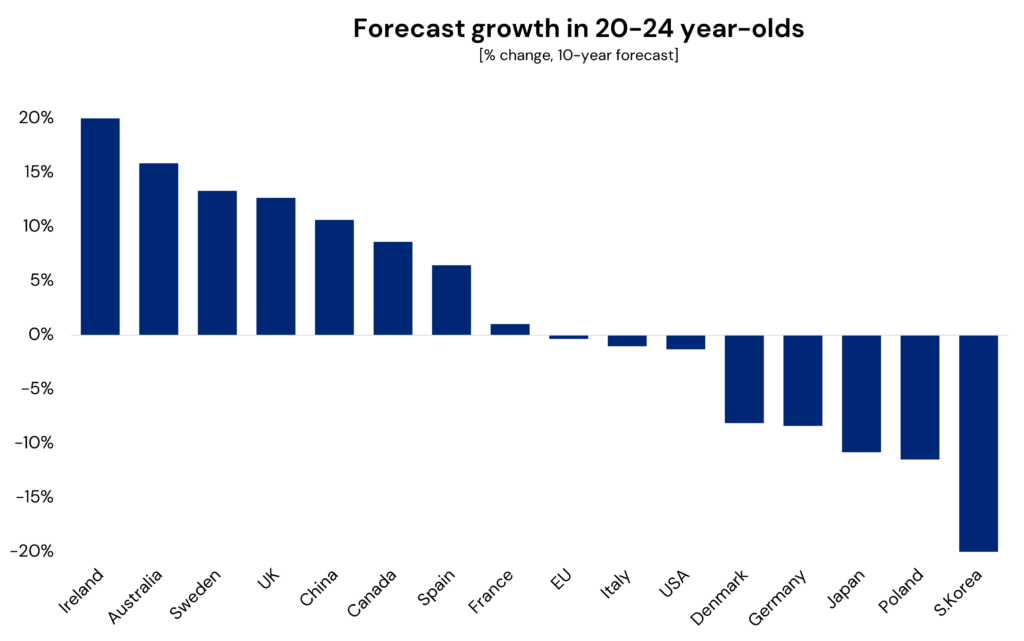
That said, there are demand-side risks to be mindful of. The demographic outlook for Europe is mixed; forecasts for some countries such as the UK, Spain and Sweden show a demographic ‘bump,’ with the number of university-aged people growing ahead of national population levels. However, in other nations, numbers are forecast to be broadly flat (France) or negative (Germany and the Netherlands). This suggests uneven growth in demand for higher education going forward.9
This mixed demographic outlook will mean greater reliance on international student demand, but there are tentative signs that may also be facing some headwinds. A recent policy change in the UK has removed the right to visas for international students’ family members.10 For now, this change represents tinkering around the edges and is unlikely to have a major impact on demand. It does, however, indicate a directional change in policy aimed at restricting overseas student numbers, presumably in a bid to bring down immigration figures. Such policy changes may incrementally dissuade would-be foreign students from studying in the UK, though demand may shift elsewhere, potentially to the benefit of other European countries. Despite such risk factors, the overriding view is one of positivity for higher education demand in Europe and therefore PBSA.
Supply factors
European student housing should be viewed within the wider context of the region’s housing market. Europe is currently facing a long-term, persistent housing shortage. Housing scarcity is not limited to major gateway cities, but is also the reality within mid-sized cities and even smaller university towns. Since 2010, Europe has built homes at a rate only 40% below pre-GFC levels,11 contributing to rising rents, increasing house-price-to-income ratios and worsening access to suitable housing. Demand for rental housing in cities remains robust, supported by long-term trends of immigration, urbanization and declining home ownership rates; as such, the imbalance between supply and demand is now fully entrenched.12
Students are, like all participants in the housing market, at the mercy of housing supply and demand. Shortages have fed through to the student market, with students finding accommodation increasingly unaffordable. Over the past two years, this has led to sharp growth in PBSA rents, with several UK cities reporting year-over-year growth in the high teens for 2023, and other markets experiencing growth well ahead of previous levels.13 The lack of supply is also leading to students being housed increasingly in unsuitable conditions; stories from the UK of students living in hotels or in completely different cities over an hour travel from campus are a clear symptom of insufficient student housing stock.
New investment in the sector should contribute to resolving the imbalance, but it will be a major challenge to fully close the wide gap between supply and demand. While there are nuances between markets, rising construction and development financing costs are making the delivery of new schemes less economical, evidenced by a sharp decline in the number of residential permits issued in several countries over the past year.14 Furthermore, restrictive planning laws and burdensome safety regulations are lengthening the time it takes for projects to be realized.
These factors inform our positive outlook on the rental housing market in Europe, which carries over into PBSA. The imbalance between supply and demand will likely persist and even worsen, driving very low vacancy and supporting strong rental growth for owners of residential and student housing real estate, or those who can deliver new schemes in those sectors.
Regulation haven
Regulations in Europe can act as a handbrake for residential rents, as we set out in our ISA Briefing, Controlling Interest: Keeping tabs on residential regulations. In nearly all continental European rental markets, rents cannot be increased annually at the landlord’s discretion, with rental levels for in-place tenants typically linked to a backward-looking index. During the recent ‘great reflation’ period, this has meant income from many rented residential properties did not keep pace with inflation. But student housing stands out from more traditional rental housing investments as having a cash flow profile far less impacted by the growth-muting tendencies of regulation.
In part, this is because PBSA often faces less regulation or stands outside of regulatory systems altogether. Students’ nature as transient, temporary residents means that their needs are rarely prioritized by local politicians, particularly compared to those of permanent residents. They typically only stay in a city for a few years, do not have dependents and their rental obligations often come with implicit or explicit parental guarantees. This means that PBSA is targeted for rent controls far less often than the wider rental market. Moreover, zoning and classifications for student accommodation are often distinct from standard rental housing, exempting it from regulations that limit absolute rent levels or restrict annual rental increases. Moreover, regulatory requirements on minimum unit sizes or lease lengths usually do not apply.
Even where regulated, PBSA benefits from its relatively short duration of tenancy. Given the vast majority of students study for 3-4 years, there is far greater annual turnover of tenants compared with the wider residential market. Faster turnover allows for landlords to more effectively mark rents to market levels. This means PBSA rents may better keep pace with inflation, even in jurisdictions where regulations do apply to the sector.
Increasingly mature
The increased maturity of student accommodation is another factor in its favor. The UK is clearly ahead of the rest of Europe in this regard, with a deep, liquid investment market, publicly traded REITs and a large number of established specialist operators. The sector’s wide acceptance from both tenants and investors means that we would consider it a ‘Core’ sector on our ‘going mainstream’ framework, as detailed in our ISA Portfolio View. Elsewhere in Europe the sector is considered more niche, but its growing acceptance means we would consider it ‘Near-Core’ on the same framework. Investment figures support the observation of a varying level of maturity for the sector—UK PBSA has made up 66% of investment volumes annual on average since 2014, despite the EU having 6.4 times the number of students.15
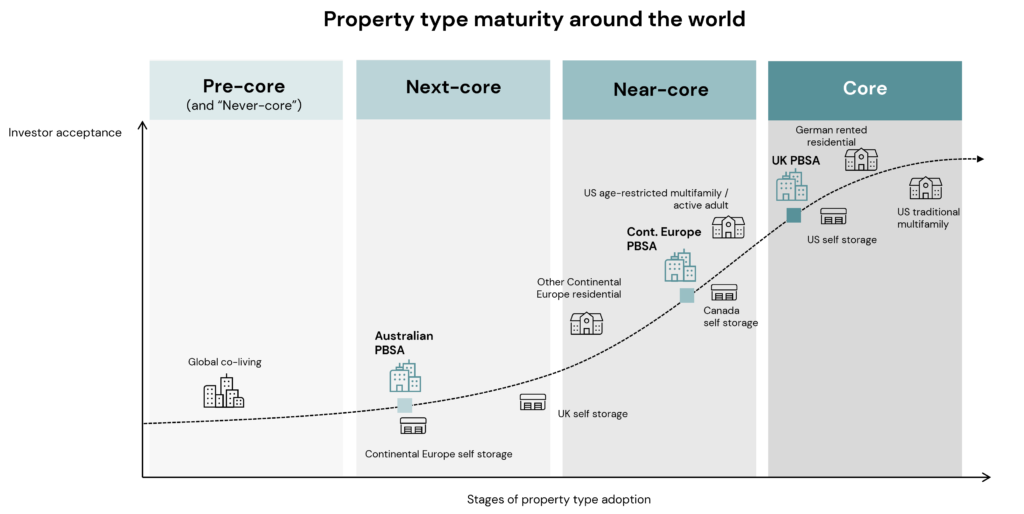
Over time, we expect this to change; the opportunity for investors to take advantage of the structural trends outlined above is likely to drive increased investment in the sector. Countries like as Spain or Italy have PBSA provision rates16 of below 10%, compared to more than 30% in some major UK markets,17 suggesting there is significant scope for delivery of new supply. Cities such as Milan, Madrid and Barcelona all have student populations of over 100,000 and multiple well-ranked institutions, giving them diverse demand bases and making them likely to be key growth markets for the sector in the coming years.
As niche sectors mature, greater liquidity and investor acceptance tends to lead to any yield premium they offer versus traditional sectors narrowing, as investors require less compensation for liquidity and transparency risks; such a pattern has already been observed in UK PBSA. This potential narrowing of yields in European markets is another factor behind our conviction that the sector is likely to offer attractive returns.
Comparisons with other regions
Student accommodation in much of Asia Pacific is still in a nascent stage, with relatively limited PBSA stock, few specialized operators and comparatively little institutional investment. The major exception in the region is Australia, which has characteristics similar to those of the sector in Europe and the UK, but is a number of years behind in its evolution. This suggests a similar path to maturity may lie ahead. Like Europe, Australia benefits from English-language courses at comparatively lower tuition costs than the US, while also offering post-study work visas. As a result, it has an even higher proportion of international students than most major European countries.18 Still, the Australian PBSA sector remains in its infancy as an investable property type. Stock numbers are low even compared to the most immature countries in Europe, with a student-to-bed ratios of 16-to-119 and significantly higher than the UK where it is around 3-to-1.
Traditionally, international students in Australia tap into private rental housing for accommodation. Both the private rental market and the PBSA sector in Australia have experienced tight occupier market fundamentals and experienced double-digit rental growth over the past two years.20 The solid performance has been primarily driven by strong migrant inflows, including international students, as well as high interest rates that encourage Australians to rent rather than buy, and relatively limited existing stock and new supply of all types of housing.
The United States, by contrast, has a more established student housing sector, but our view of the property type there is less favorable as compared to other regions. For a start, the demographics are less favorable given the population of 18-to-24 year-olds in the US is forecast to decline through 203321 and enrollment rates at 4-year institutions have remained roughly flat since 2010.22
An additional point of difference between US and European universities is their locations. Many top-tier US universities are in small cities in which a single school dominates the population and economy. Student housing properties in these markets are dependent on a single source of demand that controls enrollment growth and housing policy. Additionally, barriers to new supply are generally lower compared to major European cities, which allows for more new development to come in and disrupt the market. Taken together, these factors mean rent trends in these markets can be volatile. While there are similar university-centric towns in Europe, our investment focus is on the larger markets, where housing markets are tightest and there is a diverse demand base from multiple universities.
Looking ahead
- Europe’s leading universities should continue to attract demand from students, both domestic and international, positioning student housing for further growth. However, this growth may be uneven given mixed demographic outlooks and the potential for government interference. Investors should focus on the most-supply constrained markets, where there are resilient and varied sources of demand from multiple universities.
- European PBSA can act as a proxy for investment in the housing markets of supply constrained cities that face regulation, while generating cashflows more akin to investments in unregulated markets. We maintain our previously stated view that residential regulations can lead to lower cash flow volatility and thus may even mean better risk-adjusted returns. However, given the persistent housing shortages and continued demand for rental housing of all forms, we forecast rental growth across many European residential markets to be well ahead of inflation. This means in markets where residential landlords are constrained by inflationary indexation, owning PBSA may give investors a better opportunity to capture that market growth than does traditional residential.
- Elsewhere in the world, the investment case for student accommodation is less compelling. The US market, for example, is characterized by a relatively weak demographic profile for student demand. Moreover, in many cases investing in it involves exposure to smaller cities to which investors would not otherwise seek exposure. That said, PBSA markets with similar characteristics to Europe, such as Australia, can offer interesting opportunities for global investors. For investors seeking higher returns, entry into sectors can be especially interesting when they are at the early stages of their emergence.
Footnotes
1 Source: Eurostat
2 Source: Higher Education Statistics Agency (UK)
3 Source: Eurostat, Higher Education Statistics Agency (UK)
4 Source: Savills
5 The number of European universities in the top 2000 spots Center for World University Rankings (CWUR) league tables per capita is the highest of any world region, according to data from CWUR, Oxford Economics, and analysis by LaSalle.
6 Source: Educationdata.org
7 Source: Eurostat
8 Source: HESA
9 Assuming no change in the propensity of people in that age cohort to attend university.
10 UK Government introduced policy on January 1st 2024
11 Source: European Central Bank
12 For deeper analysis of European housing markets and the underlying supply imbalance see LaSalle’s ISA Outlook 2024.
13 Source: JLL
14 LaSalle analysis of data taken from the national statistics agencies of major European countries (Germany, UK, France, Spain, Sweden, Denmark, Finland, Italy, Portugal, Netherlands, Ireland)
15 Source: MSCI Real Capital Analytics
16 Metric defined as number of purpose-built student beds as a share of total enrolled population of students in higher education.
17 Source: JLL
18 Source: UNESCO
19 Source: CBRE
20 Source: SQM Research (for private rental market), as of November 2023; CBRE (for PBSA), as of August 2023
21 Source: Oxford Economics
22 Source: National Center for Education Statistics (US)
Important Notice and Disclaimer
This publication does not constitute an offer to sell, or the solicitation of an offer to buy, any securities or any interests in any investment products advised by, or the advisory services of, LaSalle Investment Management (together with its global investment advisory affiliates, “LaSalle”). This publication has been prepared without regard to the specific investment objectives, financial situation or particular needs of recipients and under no circumstances is this publication on its own intended to be, or serve as, investment advice. The discussions set forth in this publication are intended for informational purposes only, do not constitute investment advice and are subject to correction, completion and amendment without notice. Further, nothing herein constitutes legal or tax advice. Prior to making any investment, an investor should consult with its own investment, accounting, legal and tax advisers to independently evaluate the risks, consequences and suitability of that investment.
LaSalle has taken reasonable care to ensure that the information contained in this publication is accurate and has been obtained from reliable sources. Any opinions, forecasts, projections or other statements that are made in this publication are forward-looking statements. Although LaSalle believes that the expectations reflected in such forward-looking statements are reasonable, they do involve a number of assumptions, risks and uncertainties. Accordingly, LaSalle does not make any express or implied representation or warranty, and no responsibility is accepted with respect to the adequacy, accuracy, completeness or reasonableness of the facts, opinions, estimates, forecasts, or other information set out in this publication or any further information, written or oral notice, or other document at any time supplied in connection with this publication. LaSalle does not undertake and is under no obligation to update or keep current the information or content contained in this publication for future events. LaSalle does not accept any liability in negligence or otherwise for any loss or damage suffered by any party resulting from reliance on this publication and nothing contained herein shall be relied upon as a promise or guarantee regarding any future events or performance.
By accepting receipt of this publication, the recipient agrees not to distribute, offer or sell this publication or copies of it and agrees not to make use of the publication other than for its own general information purposes.
Copyright © LaSalle Investment Management 2024. All rights reserved. No part of this document may be reproduced by any means, whether graphically, electronically, mechanically or otherwise howsoever, including without limitation photocopying and recording on magnetic tape, or included in any information store and/or retrieval system without prior written permission of LaSalle Investment Management.
LaSalle’s Global CEO Mark Gabbay sat down with The Schwab Networks’ Oliver Renick to discuss the state of commercial real estate on the Friday, March 1 edition of Market on Close. He talks about regional banking and commercial real estate and goes over what potential Fed cuts mean for commercial real estate.
This article first appeared in February 2024 edition of the BAI Newsletter
For debt providers, the relative risk adjusted return profile for new real estate credit today is very attractive. Higher interest rates have helped to improve the return profile, and new loan detachment points are generally trending lower, particularly in instances where borrowers are willing to show support for underlying assets and commit additional cash to a transaction.
These attractive fundamentals for lenders were largely in place last year too, however transaction volumes across new acquisitions and refinancings were limited for a variety of reasons. By contrast, in 2024 we expect to see robust demand for debt financing solutions provided by real estate investment funds. This is due to both recent market developments and longer-term structural trends. In the shorter term, borrowers have begun to adapt to a higher cost of financing. This comes as no surprise given the dynamics behind the rapid increase in interest rates that abruptly ended 15 years of historically low rates. With the borrowing market adapting to this new environment, and with interest rates expected to stabilize and start to decline, we have also seen transactions start to move forward at the start of 2024. It is expected that debt will again become a common component of sponsors’ business plans in 2024.
In the longer term, the migration of commercial real estate lending activity away from banks and towards debt funds has been a dominant theme over the past 15 years. The long-running Bayes Business School study of UK CRE lending* found that, in the first half of 2022, debt funds exceeded domestic banks’ new originations for the first time.
Alternative lenders are poised to further expand their market share in the coming years. Bayes Business School estimates demand for real estate finance in Europe at €310 billion per year, and the current stock of outstanding real estate debt at €1.6 trillion. However, as underlying values have declined and loan-to-value ratios (LTVs) are down, traditional lenders may only be willing to advance around €1.3 trillion of the capital necessary to refinance loans maturing through 2027.
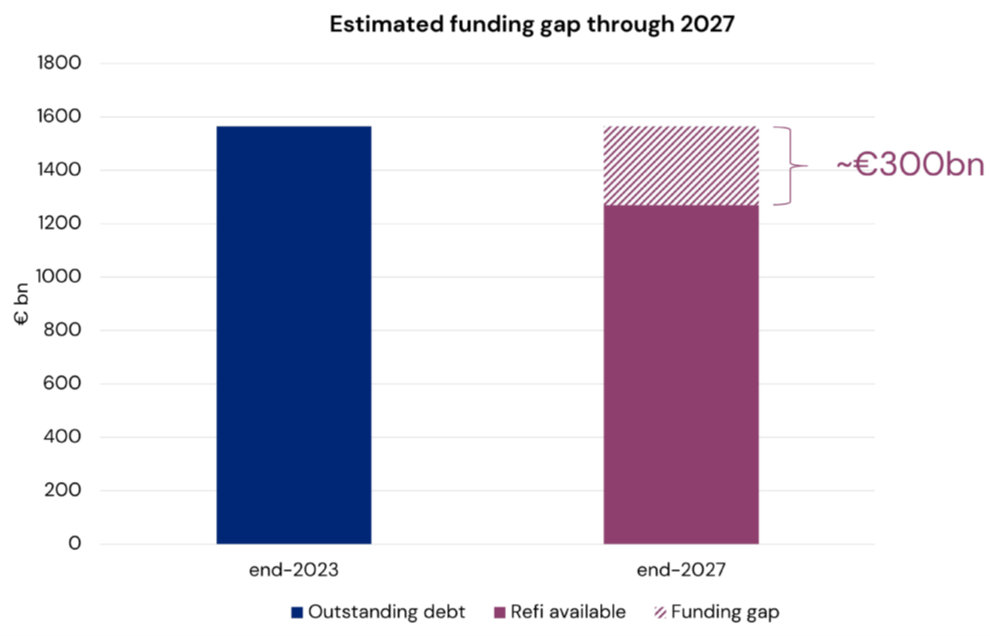
Source: MSCI Real Capital Analytics, Bayes Business School, CBRE, JLL, LaSalle (01/24).
Notes: Past performance is not indicative of future results. There is no guarantee that any trends shown herein will continue or that any forecasts shown herein will materialize as expected. Funding gap estimates based on Bayes Business School assessment of debt outstanding and maturing annually, and LaSalle forecasts of capital value change.
Funds will therefore encounter a significant volume of investment as they play an ever-increasing role in addressing the real estate financing gap, created by banks’ ongoing retrenchment and the considerable quantities of debt falling due for refinancing in the short run.
Despite these attractive dynamics for non-bank real estate lenders, this remains a market with potential for real dispersion in performance between fund managers. Delivering attractive risk-adjusted returns for investors will require several crucial ingredients, including having a well-resourced platform across all facets of the business that is established in the market and leveraging analytical tools to negotiate with borrowers.
The benefits of an established market presence and platform
For alternative lenders to remain competitive, they must be able to offer sponsors a wide range of capital solutions. The flexibility afforded by a variety of debt structures should help borrowers transition to a higher-rate environment, allocate risk to where it is most suitably borne and ensure that good-quality properties continue to have access to liquidity.
In other words, both debt funds and borrowers benefit from differentiated pockets of debt capital, ranging from senior lending, whole loans, levered whole loans and mezzanine, including development and refurbishment financing. Borrower demand for bespoke financing solutions makes this an attractive environment in which to be active and to deploy capital across a diverse range of market opportunities.
As a lender, a natural complement to this diversity of investment strategies is a wider geographic scope. The ability to deploy capital across borders and across currencies further enhances funds’ ability to be selective.
Structuring is also critical, particularly when underwriting risk for assets that traditional lenders are less willing to finance. Appropriately managing risk while offering more structured solutions, utilizing a range of protections such as standard loan covenants or business plan targets are all measures that help align interests between borrowers and lenders.
Scalability also plays a critical role in a lender’s ability to remain competitive in today’s environment. – While refinancing needs can be met by more traditional senior-mezzanine lending structures, an increasingly prevalent structure sees a whole loan provided by an alternative lender. The whole loan provider provides a single counterparty and point of contact for a borrower to work with, while allowing for more certainty as well as enhanced control for the lender. This combination of a flexible investment mandate, cross-border presence and a robust approach to underwriting and deal structuring is fundamental to striking the right balance between supporting borrowers and protecting investors’ capital. These attributes will naturally be found in those established players with a proven track record of transacting and who can offer certainty and speed of execution.
Those same funds will also disproportionately be those with access to a wider asset management platform, also to borrowers’ benefit.
Ultimately, a collaborative real estate debt investment manager will not be extending loans with the express intention of eventually taking over or outright owning the assets. But being part of a large platform with asset management capabilities is not just an important safety net in the event that a restructuring and transfer of ownership does take place. It also helps pre-empt and avoid that situation. Drawing on those asset management capabilities means that lenders can identify red flags in a deal early-on, and in turn work with their borrowers and help provide insight into ways to maximise value.
Leveraging wider analytical tools
As detailed in LaSalle’s ISA Outlook 2024, we also believe that, to lend successfully in a challenging market, debt providers need to maintain a targeted approach, effectively sourcing transactions by scrutinising market data and making use of local market presence.
Tapping into a wider pool of analytical tools, data and longer-term outlooks is invaluable when working with borrowers and understanding their commercial horizons. For example, in the absence of comparable transactions to act as reference points for how certain asset valuations have rebased, the ability to conduct price discovery by analysing, understanding, and underwriting fundamentals from the point of view of an equity sponsor is key.
In some instances, fresh borrower equity is required to support elongated business plans. To that end, fostering a good relationship with borrowers by working with their reformulated business plans is fundamental to unlocking the right structured financing solutions, especially in the face of forthcoming debt maturities. In a market impacted by rising interest rates and geopolitical convulsions, finetuning capital requirements quickly can be only undertaken by a real estate manager with the capabilities and resources to conduct that deep analysis.
Good data is also important when seeking to invest across a range of different real estate assets. Currently, lender appetite is focused on sectors with especially strong occupier fundamentals, and their ability both to capture rental growth in line with inflation and to access relatively liquid capital markets. Logistics, residential, student and select operational sectors, such as hospitality, are widely considered to offer resilient fundamentals. This is resulting in a reasonable degree of liquidity for originating new financings in those preferred sectors, but insight remains crucial to picking both markets and sponsors with the capabilities to access such growth. More importantly and particularly in scenarios whereby strong occupational trends are obvious, it is still critical to understand cost structure, and ultimately capital markets in an environment where very little transaction data exists. Access to good quality data is a key component of determining underlying value of an asset in today’s environment.
Outside of those preferred sectors with a more obvious path to cash flow, the traditional sectors of offices and retail have been most challenged. That is especially true for offices outside of prime CBD, whereby a large amount of uncertainty exists, arising from the cloud of uncertainty surrounding future occupier demand and what the impact on capital markets over the long run will be. Data-led insights and a proprietary view on whether, how and where the office market will recover is therefore an important advantage for lenders. For example, sustainability credentials are increasingly important as a key determinant of asset performance in the office sector. Wellness, energy efficiency, sustainability accreditations – all of these are metrics that need to be analysed to forecast occupier demand, and in turn, valuation trends.
Opportunities and challenges for 2024
Since the global financial crisis, commercial real estate lending has evolved towards a diverse pool of capital providers which includes both more traditional banks, but also debt funds. In 2024, this trend is expected to continue.
Despite the scope for funds to earn more market share this year, lenders face many potential pitfalls. When it comes to origination, sourcing financing opportunities will require a focus on parts of the market where supply and functionality has lagged societal trends. These situations enable rental growth at or above inflation, aligning with what individual and corporate occupiers want from their spaces. Likewise, credit selection and structuring will require a keen eye on lending basis and coverage levels, alongside the underlying real estate capabilities of the sponsors.
Real estate credit is currently a highly attractive asset class. But to ensure that both fund investors and borrowers are being served well requires a debt platform that can provide a variety of leverage solutions, tap into a rich bank of data/analytics, and draw on insights from a wider bench of real estate specialists, all underpinned by a market-leading team with exceptional borrower relationships. Those are the characteristics that investors and borrowers alike should prioritise in their partners.
*From 2018, The UK Commercial Real Estate (CRE) Lending Survey is based at Bayes Business School, City, University of London. The Survey is a unique and comprehensive record of CRE lending, and an industry standard source of information, regularly referenced in the national financial press and trade publications: https://www.bayes.city.ac.uk/ faculties-and-research/centres/real-estate/bayes-cre-lending-report. Up to 2017, the study was published by De Montfort University, Leicester.
In the past decade, the urbanization narrative in the United States has shifted from the “rebirth of cities” to the “rise of the suburbs.”1 What are the drivers of this shift, and how does it impact real estate? In this ISA Briefing, we tackle these questions and share our outlook for how future dynamics could impact migration and urbanization trends.
Demographics is destiny
Demographic cohort effects are a key driver of the current shift. The generic, or median, location preferences of a cohort change as that cohort ages; as the relative growth of different age groups ebbs and flows it impacts the national trend towards urban and suburban location preference.
In the US, there are two outsized cohorts, the Baby Boomers and the Millennials, which as they age have a disproportionate impact on national averages (see chart below). In the early 2010s, the bulk of the Millennial cohort was in their 20s, and as young adults they had a preference for living in urban locations. In the present decade the same cohort is aging into their 30s and 40s, entering a life stage that tends to prefer living in suburban locations. Young families move to the suburbs to seek more space and because the local school funding system in the US tends to mean suburban schools are better funded. This shift began in the latter half of the 2010s as the older members of the cohort reached their mid-30s but was accelerated by the Covid-19 pandemic in 2020.

Sunbelt supremacy
Regional shifts also accelerated in the late 2010s as migration to the southern Sunbelt markets increased,2 driven in part by households moving in search of more affordable living and warmer weather compared to northern cities. While in-migration to high-cost metros slowed throughout the 2010s, and eventually turned negative, inflows to Sunbelt metros accelerated through 2016 before slowing because of lower international immigration. This also contributed to a national shift toward suburban living because Sunbelt metros such as Houston, Dallas, Atlanta and Phoenix lack the dominant central city with a strong central business district that is characteristic of older cities like New York, Boston, Chicago and Washington, DC.
As these Sunbelt metros grew faster, it led to a shift in the mix of apartments nationally towards suburban locations. This is shown in the NCREIF Property Index (NPI) data in the chart below. It shows that the NPI’s share of apartments in the south has increased since 2018; the same time when the share of suburban apartments started reversing the gains achieved in urban apartment share in the 2010s. (This analysis is done based on unit count, so is not driven by trends in relative values.)

Post-pandemic realities
The pandemic not only accelerated the urban and regional shifts already underway, but it set into motion a new set of forces that influence where households choose to live. The enduring popularity of remote work requires more space for a home office, which is cheaper in the suburbs, and commuting only a couple days per week makes living further from city centers more palatable. Owners of suburban apartments and shopping centers have benefitted as a result.
Conversely, having fewer downtown workers has hurt office values and urban retail, and the reduction in activity is a contributor to the increase in crime that has occurred in urban areas. Although violent crimes have come down after a pandemic-era spike, theft and property crimes increased in 2022 according to the FBI.3 Both types of crime remain significantly below the highs of the early 1990s, but public awareness seems elevated relative to the hard data. The crime issue extends into city neighborhoods as well, which can motivate some residents to move out of the city.
Evidence of an urban rebound
Despite the challenges, residents returned to urban areas as the pandemic receded. Chicago and San Francisco saw the number of occupied units in urban submarkets4 decline 4.0% and 7.4% from peak to trough during the early days of the pandemic.5 But they have since recovered; as of September 2023, Chicago had 6.6% more occupied units in urban submarkets compared to the prior peak and even hard-hit San Francisco had 1.9% more. The decline in urban renters was smaller in Sunbelt markets, with just a 1.2% and 1.4% decline in Dallas and Atlanta, respectively, and the rebound has been greater with 9.9% and 8.2% more occupied urban units compared to the previous peak.

At the same time, the relative affordability of the Sunbelt has declined. Home values have increased 47.8% in Dallas, 56.3% in Atlanta and 57.5% in Phoenix since 2019 as compared to 26.4% in New York, 36.0% in Boston and 21.3% in San Francisco.6 While major Sunbelt markets remain less expensive compared to Gateway cities, the narrowing of the relative affordability gap should, all else equal, reduce their draw.
Clarifying “urbanization” in DTU+E
As is typically the case, the “rise of the suburbs” narrative overstates the situation, but there are real dynamics behind the shift from urban growth to suburban growth that real estate investors need to pay attention to and build strategies around. At LaSalle, we have long sought to capture secular changes shaping real estate around the world through our Demographics, Technology, Urbanization and Environmental factors (DTU+E) framework. However, the term “urbanization” in this context is often misinterpreted as a one-direction shift towards urban places, when it is better understood as “urban and regional change,” which encompasses broader population shifts within and across metropolitan areas.
Indeed, it was with this lens that LaSalle Research and Strategy forecasted the suburban shift in the mid-2010s and redirected our apartment investment strategy from urban submarkets (what we labeled “Millennial Magnets” at the time) to suburban locations. In 2016, we recommended targeting apartments in the best school districts, which are mostly suburban. We continued to reinforce that focus as our internal target market recommendations shifted towards the suburbs and our risk assessments flagged the challenges facing urban markets. It is not sensible to assume “urbanization” is a one-way street, or that the direction of flow doesn’t change.
Globalizing the urban/suburban debate
To this point, our comments have applied to the US. Elsewhere in the globe, comparisons of suburban versus urban patterns can get tricky for a range of reasons. Even the terminology is challenging. In Australia, all neighborhoods other than CBDs are called “suburbs,” even if they are adjacent to the CBD. In Hong Kong, one might consider transit-centric high-rise New Towns to be “suburbs,” but they do not at all resemble American ones. At some point, the right question is simply: What locations are attracting people?
Looking at it this way requires a deeper dive into demographic, social and urban planning considerations that differ significantly from the US situation. For example, in Japan and Germany, declining rural populations is paired with migration into key cities. In Canada, very strong international in-migration combined with “greenbelts” that limit urban sprawl have led to an intensification of urban density. In the UK, which also has greenbelts, planning restrictions have had the unintended consequence of pushing demand for suburban living into rail-connected satellite cities that are discontinuous to the main built-up area of the metro. To dig into all these and other variations is beyond the scope of this ISA Briefing. However, applying the same lenses of demographic cohort effects, relative affordability and urban structure is a globally relevant approach.
LOOKING AHEAD
- Suburban areas in the US continue to benefit from Millennials and then Generation Z seeking more space for their young families. That said, we do not expect an urban “doom loop,”7 but city taxes could increase more than other locations, limiting urban NOI growth.
- We believe that “E factors”—or environment-related secular changes—are likely to represent generally positive demand drivers for cities. The lower carbon intensity of urban living could boost urban demand if carbon is taxed or otherwise regulated. Moreover, climate change could increase summer heat in southern markets while making northern winters milder. This could tip migration back toward the north.
- High barriers to supply—or the inverse—can equally characterize both urban and suburban locations, depending on local circumstances. That said, the higher share of land value in total asset value in urban locations may imply greater potential for appreciation. Investors should remain on the lookout for urban locations with the best demand dynamics.
- In-migration to Sunbelt markets has driven up housing prices, narrowing affordability gaps with older northern and coastal cities. This should allow other metro areas to emerge as destinations for affordability-driven migration; Columbus, Indianapolis and Louisville are example of cities that may be well positioned to benefit.
1 This is the US definition of a suburb. The concept of what is urban is both hard to define and varies in different markets around the world. In the US urban is generally understood as a dense area at the center of a metropolitan area. Suburbs are defined in contrast to that as being less dense areas that are still highly economically linked to the overall metropolitan area.
2 Commentary in this paragraph based on LaSalle analysis of Census Bureau data.
3 Federal Bureau of Investigation Crime Data Explorer, https://cde.ucr.cjis.gov/LATEST/webapp/#/pages/explorer/crime/crime-trend
4 Urban submarkets as defined by RealPage as the most densely populated submarket(s) in a given market based on a metro’s Central Business District, the highest concentration of the market’s tallest multifamily assets, and/or higher rent per square foot than the market average. This includes the following RealPage submarkets: The Loop, Streeterville/River North, and Lincoln Park/Lakeview in Chicago; Downtown and SoMa in San Francisco; Buckhead, Downtown, Midtown, and Northeast in Atlanta; and Oak Lawn/Park Cities and Intown in Dallas.
5 Data from RealPage as of September 2023
6 Zillow, as of September 2023
7 “Doom loop” refers to a situation in which cities get stuck in a self-reinforcing loop of lower tax revenues requiring cuts to city services that reduce the quality of life which cause residents to leave and further reductions in tax revenues and the loop repeats ad infinitum.
Important Notice and Disclaimer
This publication does not constitute an offer to sell, or the solicitation of an offer to buy, any securities or any interests in any investment products advised by, or the advisory services of, LaSalle Investment Management (together with its global investment advisory affiliates, “LaSalle”). This publication has been prepared without regard to the specific investment objectives, financial situation or particular needs of recipients and under no circumstances is this publication on its own intended to be, or serve as, investment advice. The discussions set forth in this publication are intended for informational purposes only, do not constitute investment advice and are subject to correction, completion and amendment without notice. Further, nothing herein constitutes legal or tax advice. Prior to making any investment, an investor should consult with its own investment, accounting, legal and tax advisers to independently evaluate the risks, consequences and suitability of that investment.
LaSalle has taken reasonable care to ensure that the information contained in this publication is accurate and has been obtained from reliable sources. Any opinions, forecasts, projections or other statements that are made in this publication are forward-looking statements. Although LaSalle believes that the expectations reflected in such forward-looking statements are reasonable, they do involve a number of assumptions, risks and uncertainties. Accordingly, LaSalle does not make any express or implied representation or warranty, and no responsibility is accepted with respect to the adequacy, accuracy, completeness or reasonableness of the facts, opinions, estimates, forecasts, or other information set out in this publication or any further information, written or oral notice, or other document at any time supplied in connection with this publication. LaSalle does not undertake and is under no obligation to update or keep current the information or content contained in this publication for future events. LaSalle does not accept any liability in negligence or otherwise for any loss or damage suffered by any party resulting from reliance on this publication and nothing contained herein shall be relied upon as a promise or guarantee regarding any future events or performance.
By accepting receipt of this publication, the recipient agrees not to distribute, offer or sell this publication or copies of it and agrees not to make use of the publication other than for its own general information purposes.
Copyright © LaSalle Investment Management 2024. All rights reserved. No part of this document may be reproduced by any means, whether graphically, electronically, mechanically or otherwise howsoever, including without limitation photocopying and recording on magnetic tape, or included in any information store and/or retrieval system without prior written permission of LaSalle Investment Management.
Chase McWhorter, Institutional Real Estate, Inc.’s managing director, Americas, recently spoke with Richard Kleinman, Americas Head of Research and Strategy and co-CIO at LaSalle, to discuss what institutional real estate investors can expect in the new year.
They covered a wide range of topics in their conversation, including the biggest unknowns for 2024, sector outlooks, credit, capital fundraising and key differences between the real estate markets in the US and Canada.
On November 28, LaSalle’s Global Head of Research and Strategy, Brian Klinksiek, gave a keynote address at Canadian Real Estate Forum’s annual Global Property Market conference in Toronto where he discussed our global real estate investment themes for 2024:

- The ongoing search for peak rates
- Solving the capital stack equation
- Favored sectors coming off the boil
- Moving beyond bifurcation in the market
- The changing definitions of quality and core
These themes are discussed in detail in ISA Outlook 2024, our annual publication designed to help our clients and partners navigate the year ahead. It brings together smart perspectives and investment ideas from our teams around the world, based on what we see across our more than 1,500 assets that span geographies, property types and risk profiles.
CHICAGO (Dec. 5, 2023) – The US and Canadian real estate markets continue to see subdued transaction volume and a wait-and-see approach from investors amid their respective central banks’ campaigns to snuff out inflation through interest rate hikes. LaSalle’s Insights, Strategy and Analysis (ISA) Outlook 2024 makes the case that secular trends, not cyclical trends, may hold answers as to where winning property types will land in 2024, with the early half of the year looking similar to 2023 and the potential for a rebound later in the year.
The report will be released in regional chapters throughout November and December, and can be viewed at: www.lasalle.com/Outlook2024.
The ISA Outlook 2024 looks at five key themes from a global and regional level:
- The search for peak interest rates
- Solving the capital stack equation
- Coming off the boil
- Beyond bifurcation
- The changing definition of quality and core
On a broad basis in the Americas, the report observes a potential recovery later in 2024, a continued focus on interest rates and their impact and the potential for supply weighing on real estate fundamentals.
Brian Klinksiek, Global Head of Research and Strategy at LaSalle, said: “Significant unknowns remain in the global real estate market as we head into 2024, including interest rates, geopolitical tensions, and whether major economies may tip into recession. While it’s very difficult to time markets, data on previous down cycles suggest that it’s often during unsettled periods that savvy investors can find strong value in real estate, making this a potentially strong vintage for investment.”
Select ISA Outlook 2024 findings for North America include:
- The residential (encompassing both single-family rental and apartments) sector continues to see healthy fundamentals. However, as the report notes, residential properties that were bought at peak pricing in 2021 and 2022 and financed with elevated levels of floating rate debt will need to either be recapitalized or sold which may cause a cooling effect on the sector in 2024. The industrial sector will also cool from peak performance levels, with pockets of softening rents in some markets. Both residential and industrial will benefit in time from the reduced levels of new development starts in 2023 and beyond.
- Select sub-sectors of retail such as US grocery-anchored properties are seeing a boost in investor confidence. Limited new supply and a better understanding of which assets are better positioned is creating confidence that these properties can be an accretive portion of a balanced real estate portfolio.
- The question around the future of office properties continues to be pervasive, and something investors are watching closely. The report observes a divide between Canadian and US office markets with Canada slightly better positioned than the US due to lease structures. The US continues to deal with substantial work-from-home headwinds. The report notes that widespread distress may lead to high-risk, high-reward opportunities for investors.
Rich Kleinman, Co-CIO and Head of Research & Strategy for the Americas at LaSalle, said, “Looking at real estate investment solely through the lens of interest rates means you’re missing the bigger picture as we believe sectors and markets will adjust to rates at varying speeds. Investors with dry powder, flexibility and who can identify price gaps are likely to come out as winners in this transitional market.”
Chris Langstaff, Head of Research & Strategy for Canada at LaSalle, said, “Looking to 2024, we expect that in the midst of a continued softening of the Canadian economy in the near term, the strong migration trends will support long-term growth of the Canadian economy. This will particularly benefit the apartment and industrial sectors when economic growth resumes.”
About LaSalle Investment Management | Investing Today. For Tomorrow.
LaSalle Investment Management is one of the world’s leading real estate investment managers. On a global basis, LaSalle manages approximately $89 billion of assets in private and public real estate property and debt investments as of Q3 2023. LaSalle’s diverse client base includes public and private pension funds, insurance companies, governments, corporations, endowments and private individuals from across the globe. The firm sponsors a complete range of investment vehicles including separate accounts, open- and closed-end funds, public securities and entity-level investments. For more information, please visit www.lasalle.com, and LinkedIn.
Forward looking statement
The information discussed above is based on the market analysis and expectations of LaSalle and should not be relied upon by the reader as research or investment advice regarding LaSalle funds or any issuer or security in particular. The information presented herein is for illustrative and educational purposes and is not a recommendation, offer or solicitation to buy or sell any securities or to adopt any investment strategy in any jurisdiction where prohibited by law or where contrary to local law or regulation. Any such offer to invest, if made, will only be made to certain qualified investors by means of a private placement memorandum or applicable offering document and in accordance with applicable laws and regulations. Past performance is not indicative of future results, nor should any statements herein be construed as a prediction or guarantee of future results.
Company news



No results found
LONDON (29 November 2023) – Despite a challenging macroeconomic picture, European real estate has begun to acclimatise to higher interest rates and will offer some of the world’s most attractive supply-demand dynamics next year, according to the Insights, Strategy and Analysis (ISA) Outlook 2024 report published by global real estate investment manager LaSalle Investment Management (“LaSalle”).
Last year’s report predicted European macro headwinds and a stall in capital markets activity, but also strong real estate market fundamentals. Looking ahead, the 2024 ISA Outlook for Europe describes how investors that are ready to move out of waiting mode, with realistic expectations for operating income growth, can find compelling new investment opportunities.
This year’s report identifies five trends that differentiate Europe and earn the region’s real estate assets an important place in investors’ property portfolios:
- Europe’s city centre vibrancy and occupier demand have strongly rebounded
- The region’s firms and individuals are taking the lead in decarbonization
- Skilled migration is supporting growth
- Expansion of the EU’s single market is regaining traction
- The high prevalence of inflation-index commercial leases in the EU has helped the region’s property cash flows to better keep pace with inflation
These trends are driving demand in particular for logistics and rental housing, as well as superior performance by offices in the ‘super-prime’ segment.
Macro challenges but appealing supply-demand dynamics
Having defied expectations of a recession in 2023, Europe still faces elevated recession risk. Inflation has begun to abate but proven comparatively stubborn, particularly in the UK, inducing higher policy rates from the ECB and Bank of England. As the delayed impact of rising rates begins to bite, European property markets enter 2024 searching for a clear peak in interest rates – as well as an end to the war in Ukraine.
Europe’s occupational fundamentals are coming off the boil of recent years, with rental growth set to cool to its lowest level since 2020 next year. However, we expect that average rent growth should remain positive, especially for logistics and rental housing – even in an economic downturn – helped by low vacancy rates relative to history.
In logistics, while demand has cooled across Europe and vacancy is ticking up from extremely low levels, a shrinking construction pipeline means that the long-term revenue growth outlook remains very bright. The scope for further e-commerce market penetration is, conversely, a headwind for European retail. However, assets such as outlet centers with turnover-linked leases have lifted revenues in line with nominal sales growth.
Investors in Europe can access strategies rooted in barriers to supply, arising from Europe’s high (and rising) constraints on development. Nowhere does this apply more than in the residential sector, where the undersupply is chronic, while migration powers long-term demand growth. Surging student demand and rising mortgage rates are causing people to rent for longer and until later in life, boosting demand further in Purpose-Built Student Accommodation and rental housing specifically.
Opportunities on the leading edge of offices
European city centers are returning to their pre-Covid levels of vibrancy, attracting office occupiers and capital to more central locations. To better understand how this spectrum of office quality is evolving, we recommend going beyond ‘bifurcation’ alone in segmenting the market. The widening gaps between leading and lagging offices are determined by a range of many factors like location, design, amenities and sustainability.
In London, “super-prime” office buildings command significant rent premiums to “prime” averages. Since 2019, the UK capital’s median office relocation was from a non-BREEAM-rated EPC-D building to BREEAM Excellent / EPC-B or better. Across Paris and London, new offices’ vacancy rate is c.2%, three times less than for second-hand offices. Notably, centrally located, modern offices in Paris and Munich have defied subdued transaction levels and remain liquid, with sales attracting respectable bidder pools.
Alternative lenders gain momentum
Outside of these pockets of investment activity, alternative lenders are well positioned to solve capital stack equations in 2024, filling gaps created by banks’ reduction in LTVs to provide debt financing that generates attractive risk-adjusted returns.
Dan Mahoney, Head of European Research and Strategy at LaSalle, said: “What we are seeing in Europe is real estate markets beginning to acclimatise to the higher-rate environment and gradually shift out of the waiting mode that has chilled transaction volumes in 2023. The continent’s distinct combination of rebounding city vibrancy, high supply barriers and compelling conditions for debt make it an important allocation in global real estate portfolios.”
Brian Klinksiek, Global Head of Research and Strategy at LaSalle, added: “Significant unknowns remain in the global real estate market as we head into 2024, including interest rates, geopolitical tensions, and whether major economies may tip into recession. While it’s very difficult to time markets, data on previous down cycles suggest that it’s often during unsettled periods that savvy investors can find strong value in real estate, making this a potentially strong vintage for investment.”
Ends
About LaSalle Investment Management | Investing Today. For Tomorrow.
LaSalle Investment Management is one of the world’s leading real estate investment managers. On a global basis, LaSalle manages approximately $78 billion of assets in private and public real estate property and debt investments as of Q1 2023. LaSalle’s diverse client base includes public and private pension funds, insurance companies, governments, corporations, endowments and private individuals from across the globe. LaSalle sponsors a complete range of investment vehicles, including separate accounts, open- and closed-end funds, public securities and entity-level investments. For more information, please visit www.lasalle.com, and LinkedIn.
NOTE: This information discussed above is based on the market analysis and expectations of LaSalle and should not be relied upon by the reader as research or investment advice regarding LaSalle funds or any issuer or security in particular. The information presented herein is for illustrative and educational purposes and is not a recommendation, offer or solicitation to buy or sell any securities or to adopt any investment strategy in any jurisdiction where prohibited by law or where contrary to local law or regulation. Any such offer to invest, if made, will only be made to certain qualified investors by means of a private placement memorandum or applicable offering document and in accordance with applicable laws and regulations. Past performance is not indicative of future results, nor should any statements herein be construed as a prediction or guarantee of future results.
Company news



No results found
With shifting interest rates, dynamic occupier fundamentals and deepening bifurcation within sectors, ISA Outlook 2024 asks how real estate investors should respond to rapidly changing market conditions. To answer these questions and more, we published four separate chapters covering the global and regional outlooks over the course of November and December.
Download the full document now, or individual chapters covering the Global, European, North American and Asia Pacific outlooks are available in the tabs below.
Chapters
The global macroeconomic context for real estate remains unsettled, and more so than earlier in 2023. Until late summer, interest rates in most major markets exhibited high volatility, but little overall trend. They moved mainly sideways, owing to cooling inflation and expectations that central banks were reaching the end of their tightening cycles. This was helpful in setting a pricing baseline for real estate investors. But the outlook for rates and thus real estate pricing has become more unsettled of late.
What does this mean for real estate and how does it intersect with other key trends?
Authors

Global Head of Research and Strategy

Managing Director, Global Research and Strategy
No results found
European property markets have been waiting for a peak in European Central Bank and Bank of England policy rates, for an end to the war in Ukraine and for bid-ask pricing spreads to resolve. Investors ready to move out of waiting mode in 2024 can benefit from rebased prices, opportunities to solve capital stack equations, and strong fundamentals in many sectors.
In this chapter of ISA Outlook 2024, we examine the state of the European market and conclude with recommendations for specific investment strategies – underpinned by realism and targeted toward areas of forecast resilient income growth.
Authors

Europe Head of Research and Strategy

Europe Head of Core and Core-plus Research and Strategy

Europe Head of Debt and Value-add Capital Research and Strategy
No results found
Against a volatile macroeconomic backdrop and with growth expected to slow, we believe that in 2024 it will be the trajectory of interest rates that will have the greatest impact on real estate values in the US and Canada.
As investors continue to adapt to cooler conditions, this chapter of ISA Outlook 2024 examines the current landscape and looks ahead to the coming year, including where we see select opportunities emerging, as well as variation between the two markets. We conclude with three broad strategic themes and recommended strategies where investors may consider deploying their capital.
Authors

Americas Head of Research and Strategy

Canada Head of Research and Strategy
No results found
The sheer size and complexity of the Asia Pacific region means real estate markets and investment opportunities are as diverse as the region itself.
In the final chapter of ISA Outlook 2024, we discuss this complexity and how China’s new economies – such as high-tech manufacturing and biotechnology – are growing rapidly and, after more than two decades, Japan is hoping to bid sayōnara to deflation. In other key parts of the region – Australia, Hong Kong, Singapore and South Korea – central banks are near the end of their rate-hiking campaigns in a bid to lower inflation which, as in the rest of the world, could lead to a rebound in transaction activity.
Authors

China Head of Research and Strategy

Senior Strategist, Asia Pacific Research and Strategy
No results found
Published every year since 1993, LaSalle’s annual ISA Outlook is designed to help our clients and partners navigate the year ahead. It brings together smart perspectives and investment ideas from our teams around the world, based on what we see across our more than 1,500 assets that span geographies, property types and risk profiles.
As always, we welcome your feedback. If you have any questions, comments or would like to learn more, please get in touch by using our Contact Us page.
The real estate investable universe in 2023
In an uncertain market, it is tempting to prioritize cyclical questions such as the risk of recession and the path of interest rates over structural topics with longer-run implications. But challenging periods in real estate markets can also be attractive times to build exposure to the asset class.1 Questions about how to build portfolios do not diminish in importance just because bond market volatility makes front-page news. In our view, one of the most useful starting points for approaching portfolio construction is having a sense of the size of the real estate investable universe and its subcomponents. This is why we regularly update our estimates of the real estate investable universe and have done so consistently since 2005.
We first shared our latest estimates for the size of the global real estate universe in the 2023 edition of ISA Portfolio View. As described there, the vast scale of real estate as an asset class is among the key pillars supporting the case for including property in multi-asset portfolio. But putting a thoughtful number on the size of the asset class is easier said than done. We believe it is worth the effort because quantifying the size and distribution of the market — rather than just a subset covered by a particular index or data source — helps investors sharpen their thinking on target allocations by asset class, geography and investment structure. A full description of our methodology, data sources and summary table by country is available here, and we are glad to provide additional detail upon request.
We estimate market size, defined as aggregate gross asset value, for three nested segments, shown below. The largest and most comprehensive estimate is for all property held for the income it provides, inclusive of all types of owners (except owner-occupiers) and all quality levels. Using a separate methodology, we also estimate real estate owned by institutional investors, and by one particular type of institutional investor — those whose equity is publicly traded.
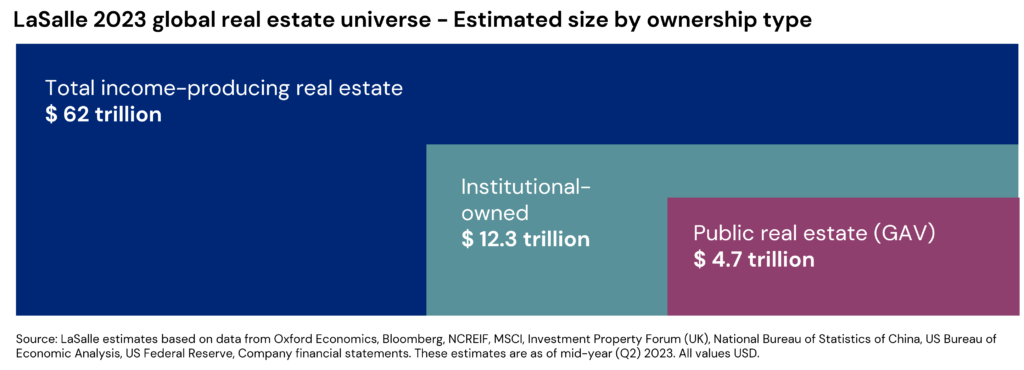
Our analysis shows that one fifth of global real estate is owned by institutional investors, and 40% of that institutional ownership is by listed companies. The estimates also break down market size by country, property type and city, using a methodology combining several bottom-up and top-down sources.
We take a closer look in this ISA Briefing at three key findings from the real estate universe analysis: (1) global income-producing real estate has recently ebbed to a below-average size relative to GDP, (2) real estate value has a fairly even distribution across the three major global regions and (3) those regions differ significantly in how real estate is distributed across metros, implying different optimal diversification strategies.
1: Real estate is large, but at a cyclical ebb
Figures in trillions can be so enormous that they lose some meaning — so it is helpful to put those numbers in context. An illuminating comparison is to put income producing real estate alongside other asset classes like stocks and bonds, as shown in the graph below.
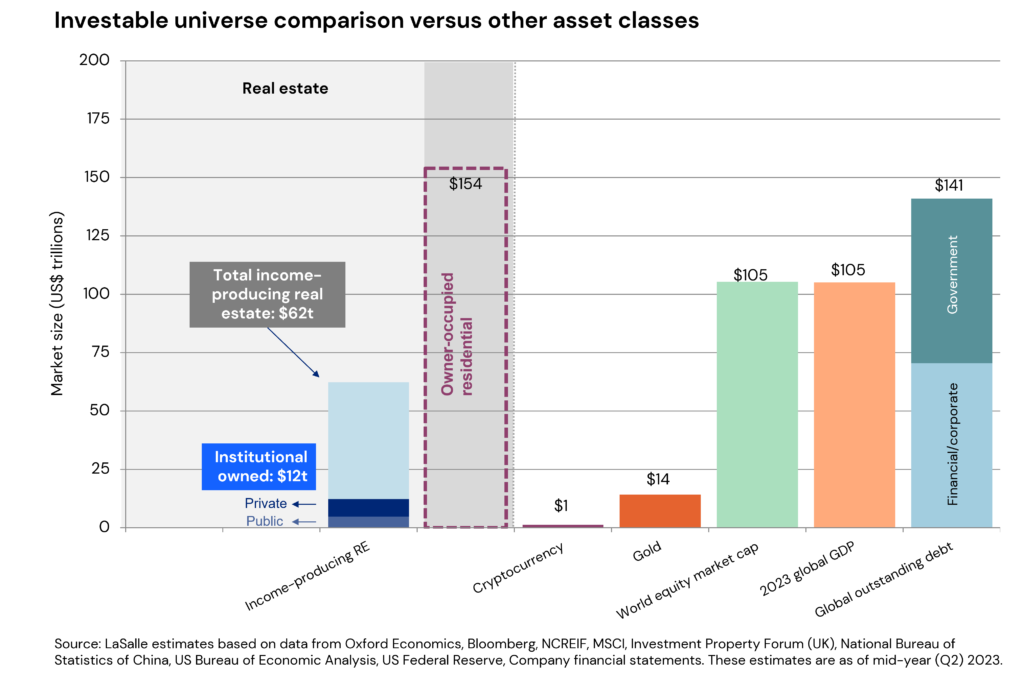
These estimates show global real estate is a smaller sibling to stocks and bonds but very much in the same family of major asset classes. Notably, owner-occupied residential real estate, which is not included in LaSalle’s real estate estimates, is significantly larger in size than all income-producing property, and even larger than the global fixed-income market.
Another useful comparator, shown below, is against global GDP. We estimate that real estate is equal to 60% of global GDP in 2023. This puts it at a low ebb relative to recent history. This is consistent with the historic pattern of real estate comprising a higher share of GDP late in expansions and then a lower share of GDP in repricing episodes. Currently our real estate market size estimate is near previous cyclical lows as a share of GDP seen in 2009-2012. Since 2000, our real estate market size estimates have averaged 68% of global GDP.
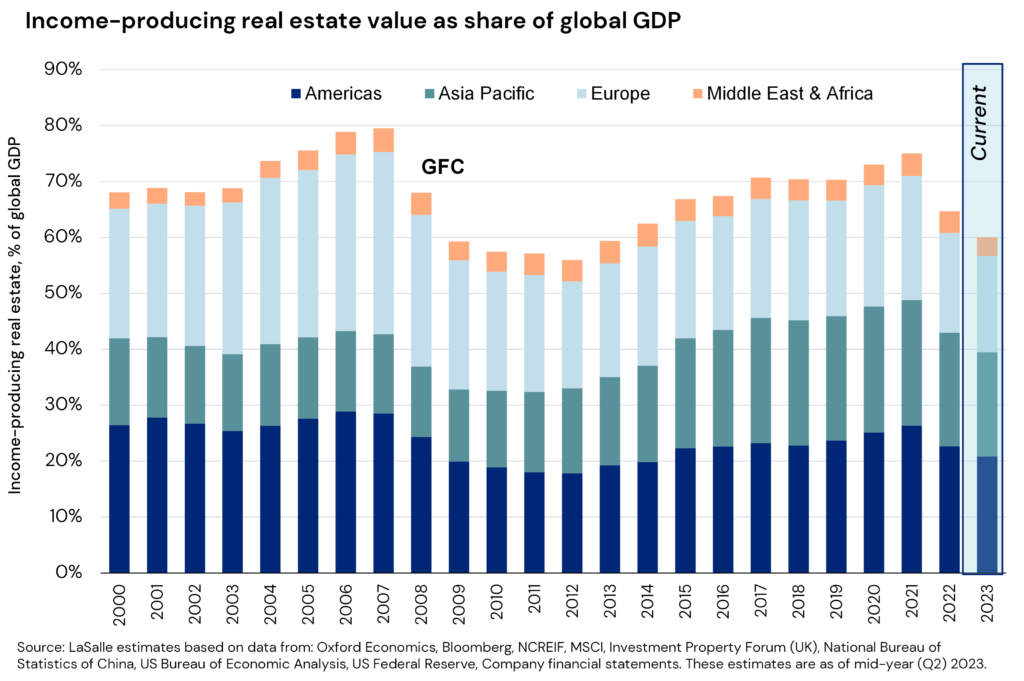
2: Still a global asset class
A second key finding from LaSalle’s universe estimates is the relatively even split in value observed between the three major regions of the Americas, Asia Pacific, and Europe. We estimate that 35% of income producing property is in the Americas, 31% in Asia Pacific, and 29% is in Europe. We believe these estimates from LaSalle’s real estate universe analysis better reflect the true opportunity set than other splits based on simple GDP or real estate indices, which can sometimes be lopsided based on where coverage is greatest or which types of investment fund products predominate. For example, 67% of the MSCI Global Property Fund Annual Index AUM is in North America.2
The split above suggests an even distribution of opportunities by region. At the same time, our national estimates also show global diversification can be achieved with a small number of countries. The eight countries with the most institutional-invested real estate together account for 70% of the invested universe. A focus on these larger countries — as well as multi-country funds — can enable investors to efficiently achieve diverse exposures, while also managing the challenges that come with differences in market practices, currency, regulation and building market knowledge.

3: Big regional differences in universe at city level
Our third notable finding emerges when zooming in one level further from the national level to individual cities. Cities and their surrounding metropolitan areas form the underlying building blocks of the real estate universe; they are often the basic level of analysis investors have in mind when comparing market allocations.
LaSalle estimates institutional real estate market size are for the entire metropolitan (metro) market — including the principal city and its suburbs that are economically connected to it, adopting official metropolitan area definitions from national statistical agencies where available.

Real estate held in institutional investor portfolios is highly concentrated in the largest metros, and these local market size estimates highlight the degree of that concentration. The 40 largest metropolitan real estate markets account for 58% of all institutional property. Some of the world’s largest metro areas dwarf many individual countries when it comes to institutional real estate ownership. Our latest estimates show that there is likely more institutional-owned real estate in Greater Tokyo than in all but three of the 201 countries covered in our estimates.
The metro market size distribution varies considerably across regions, with important implications for portfolio strategy. Institutional real estate ownership in Asia Pacific is more concentrated in its largest metros than in any other region. And its real estate is far more concentrated in a few cities than its population. In Asia Pacific, 18 metros account for 75% of institutional property, whereas the equivalent metro total is 52 in the Americas. In Europe, real estate is the most dispersed across cities, reflecting its more fragmented quilt of different jurisdictions. Over 100 European metros must be amalgamated to account for 75% of the regional total. Such dispersion makes the task of setting target markets even more complex, which is where tools like the recently released LaSalle European Cities Growth Index (ECGI) can help.
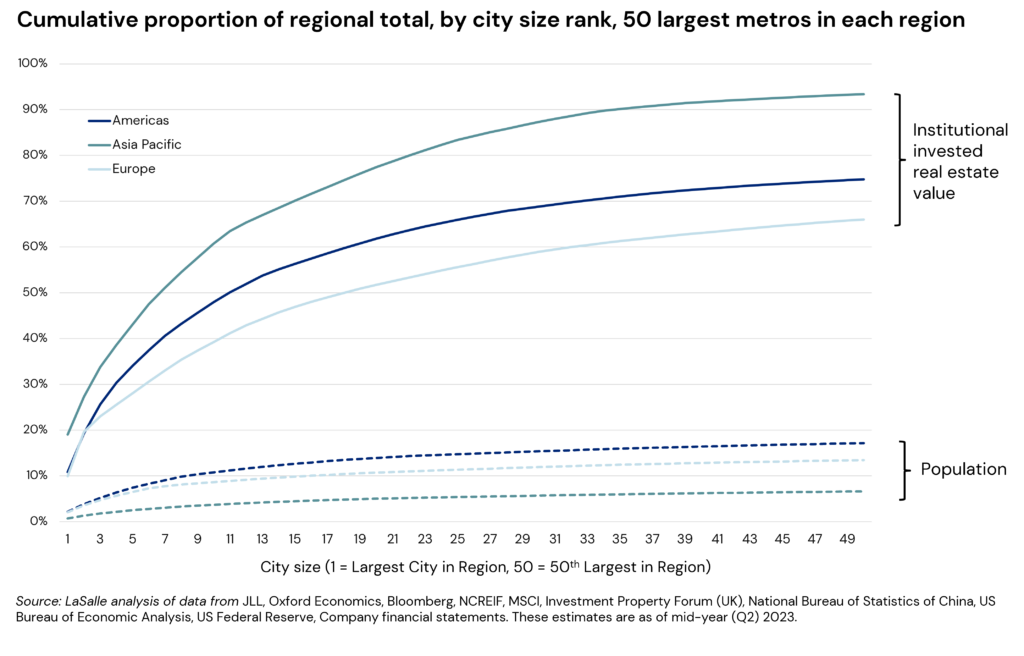
These differences impact investment strategy and approaches to diversification. Asia Pacific’s concentration of large institutional markets implies that investors may be able to achieve diversification by investing in fewer metros, but that it is also a region where each “bet” on geo-market allocation matters more. In Europe and North America, investors are more active across a larger number of medium-sized markets, offering diversification benefits as well as challenges in terms of access and efficiency.
Looking ahead
- The real estate universe is massive — it constitutes a meaningful portion of all global investable assets across asset classes — and therefore is a key piece of diversified mixed asset portfolios. Its ratio to global GDP is now below its long-term average, near past cyclical lows seen on this measure. Over a ten-year horizon, we expect real estate to grow as a share of GDP.
- The real estate universe is evenly dispersed by region (though concentrated by country and city). A globally balanced portfolio would give roughly a one-third weighting each to North America, Asia Pacific and Europe.
- The concentration of institutional real estate in highly transparent countries and in major metro areas implies that investors can achieve a good degree of diversification with a small number of countries and moderate number of metro markets, with differences across region.
- Investable universe estimates can help investors devise ‘neutral weights’ for markets and sectors, which they can then adjust based on structural considerations (e.g. tax status) and their views of relative value. We look forward to sharing our outlook and strategic recommendations for 2024 real estate investment in our upcoming ISA Outlook 2024, the first installment of which will be released on November 14.
Footnotes
1 Vintages around the time of market disruption tend to outperform, according to LaSalle analysis of data from the INREV Global IRR Index through Q4 2022. See page 30 of our ISA Portfolio View for a more complete discussion of this analysis.
2 Source: MSCI. Data as of 2022 (most recent available).
Important Notice and Disclaimer
This publication does not constitute an offer to sell, or the solicitation of an offer to buy, any securities or any interests in any investment products advised by, or the advisory services of, LaSalle Investment Management (together with its global investment advisory affiliates, “LaSalle”). This publication has been prepared without regard to the specific investment objectives, financial situation or particular needs of recipients and under no circumstances is this publication on its own intended to be, or serve as, investment advice. The discussions set forth in this publication are intended for informational purposes only, do not constitute investment advice and are subject to correction, completion and amendment without notice. Further, nothing herein constitutes legal or tax advice. Prior to making any investment, an investor should consult with its own investment, accounting, legal and tax advisers to independently evaluate the risks, consequences and suitability of that investment.
LaSalle has taken reasonable care to ensure that the information contained in this publication is accurate and has been obtained from reliable sources. Any opinions, forecasts, projections or other statements that are made in this publication are forward-looking statements. Although LaSalle believes that the expectations reflected in such forward-looking statements are reasonable, they do involve a number of assumptions, risks and uncertainties. Accordingly, LaSalle does not make any express or implied representation or warranty, and no responsibility is accepted with respect to the adequacy, accuracy, completeness or reasonableness of the facts, opinions, estimates, forecasts, or other information set out in this publication or any further information, written or oral notice, or other document at any time supplied in connection with this publication. LaSalle does not undertake and is under no obligation to update or keep current the information or content contained in this publication for future events. LaSalle does not accept any liability in negligence or otherwise for any loss or damage suffered by any party resulting from reliance on this publication and nothing contained herein shall be relied upon as a promise or guarantee regarding any future events or performance.
By accepting receipt of this publication, the recipient agrees not to distribute, offer or sell this publication or copies of it and agrees not to make use of the publication other than for its own general information purposes.
Copyright © LaSalle Investment Management 2023. All rights reserved. No part of this document may be reproduced by any means, whether graphically, electronically, mechanically or otherwise howsoever, including without limitation photocopying and recording on magnetic tape, or included in any information store and/or retrieval system without prior written permission of LaSalle Investment Management.
At a recent CREFC Europe event co-hosted by LaSalle and property developer Regal London, representatives from the real estate industry’s leading debt funds, banks, and developers came together to discuss the outlook for European real estate credit markets.
Hosted at LaSalle’s new London offices, the open-forum discussion between all participants covered topics such as the (re)financing environment for borrowers and lenders, where lenders and borrowers see best value and greatest opportunity, and who should assume the responsibility for bearing the costs of delivering sustainable real estate.
A higher interest-rate environment, quick on the heels of the pandemic, makes this an important juncture for participants in this diverse and opaque market to share perspectives. Introducing the session, Dominic Silman, LaSalle’s European Head of Debt and Value-Add Capital Research and Strategy, compared analysing real estate debt markets to the parable of the blind men and the elephant. Each interprets what they can feel, depending on the part of the elephant that they are holding – from snake to tree to fan. Likewise, real estate debt markets are covered by a variety of different data sets which, taken in isolation, can fail to capture the bigger picture.

Some of the megatrends remain readily apparent. The migration of commercial real estate lending activity away from banks and towards debt funds has been a dominant theme over the past 15 years. The long-running Bayes Business School study of UK CRE lending found that, in the first half of last year, debt funds exceeded domestic banks’ new originations for the first time. Funds will continue to play an increasing role in addressing the financing gap created by banks’ ongoing retrenchment and the considerable quantities of debt falling due for refinancing in the next 15 months.
However, it can be a challenging market for funds to negotiate those refinancings. David White, Managing Director in LaSalle’s Debt Investments team, pointed out that over the past 18 months, certain asset valuations have rebased – but it’s not always clear to what level.

Close collaboration between borrowers and lenders is becoming more critical than ever before in order to unlock the right structured financing solutions in the face of forthcoming debt maturities. Lenders need to work closely with sponsors to understand how business plans are evolving in light of the macroeconomic environment.
A lot of what is seen in the market today is focused on sectors with especially strong occupier fundamentals, and their ability both to capture rental growth in line with inflation and to access relatively liquid capital markets. Logistics, residential, student and select operational sectors, such as hospitality, are widely considered to offer resilient fundamentals. Marc Eden, Investment Director at Regal London, spoke of their decision to diversify across the beds sectors, from residential to student with hotels and later living in the mix too. Continuing the earlier theme, Richard Craddock, Managing Director in LaSalle’s Debt Investments team, explained that “elephants are going to the same few watering holes – beds, sheds and, selectively, ‘meds’”.
This is resulting in a reasonable degree of liquidity for originating new financings in those preferred sectors. In that context, a lender’s geographic scope and ability to deploy across borders offers flexibility to be more selective. Debt funds may also benefit from access to differentiated pockets of debt capital, from senior lending to mezzanine debt to development / refurbishment financing. Borrower demand for bespoke financing solutions makes this an attractive environment in which to be active and to deploy a broad range of capital across diverse market opportunities.
Outside of those preferred sectors, the consensus view seemed to be that the traditional sectors of offices and retail were most challenged, particularly for offices outside of Prime CBD where valuations were deemed not to have yet caught up with the cloud of uncertainty surrounding future occupier demand. A few participants with significant exposure to the office sector acknowledged that much of their time was consumed with managing their book. A key takeaway from this part of the conversation was that, regardless of sector, modern real estate is more operational, and lenders look beyond the assets themselves through to the sponsors. As with the period post-GFC, the market will see a flight to quality of assets and sponsors.
The discussion closed with a debate on the willingness of lenders – and their underlying investors – to encourage borrowers to invest in environmental upgrades by offering economic incentives.

The valuation premium for assets with top-performing sustainability credentials, particularly in the office sector, is widely understood. Lenders can therefore frame this question from a risk-adjusted return perspective: a greener building makes for better-quality collateral and therefore reduced risk. A similar logic applies at the owner/occupier level. Jonathan Seal, CEO of Regal London explained that in his discussions with potential office occupiers, wellness, energy efficiency and the associated sustainability accreditations were incredibly important to draw people back to the workplace.

However, because of the opaque relationship between a building’s sustainability performance, the costs of refurbishment and the impact on cashflows and valuation, this requires a deep understanding by all parties of real estate fundamentals, asset carbon / sustainability performance and how to underwrite specific assets and their associated business plans.
The conversation on sustainability highlighted two key inter-linked challenges: metrics and data. There was consensus among participants – borrowers and lenders alike – that assets with better sustainability credentials intuitively offer better risk profiles. However, due to the embryonic nature of some metrics and an inconsistency in others as well as lack of transparency in data, especially for social and governance considerations, there was no common language to help differentiate risk and respective margins. This made it difficult to agree on who should provide the financial incentives for the transition of assets.
Overall, the conversation underlined one of the key characteristics of lending markets today. Real estate credit is currently a highly attractive asset class – but it’s only those lenders able to underwrite individual asset-level fundamentals in terms of quality, location and sustainability specifications who are best placed to capitalise.
We have been fielding questions on two big macroeconomic topics impacting the Asia-Pacific region: (1) the outlook for China’s economic recovery and (2) the path of the Bank of Japan’s monetary policy. These involve legitimate worries about China’s growth engine and the risk of interest rate hikes in Japan. Nonetheless, we find that media coverage of these topics can sometimes sensationalize their implications without going below the surface.
In this ISA Briefing, and the accompanying LaSalle Macro Quarterly (LMQ), we dissect these concerns and share our views on several frequently asked questions. Our analysis points to a nuanced picture that is more supportive of investments in these two countries than the media coverage might suggest.
China’s economic recovery
China’s economic recovery has been slower than in past cycles, as we anticipated in our ISA Briefing from early March (China’s Great Reopening). While exports and for-sale residential investment have been sluggish, domestic consumption, industrial output, manufacturing and infrastructure investment continue to support the economy (see the chart below). The for-sale residential market could bottom in the next 6-12 months as demand-supply dynamics gradually improve. Unlike previous downturns, the government has not announced a blast of mega monetary or fiscal stimulus. This conservative approach could help ensure a sustainable long-term growth environment for the Chinese economy without unintentionally creating new imbalances.
We expect economic activity in China to continue to recover through 2024. Various supportive economic measures designed to boost business and consumer confidence were rolled out after the Politburo meeting on July 24; however, it takes time for stimulus measures to take effect. We continue to expect a modest recovery in China this year, likely close to the 5% GDP growth target. But oft-cited concerns over the Chinese economy such as the weak for-sale residential sector, the defaults of highly leveraged real estate developers, high youth unemployment and deflationary pressures deserve to be addressed, as we do in this FAQ.
GDP growth and key economic indicators in China in Q2 2023
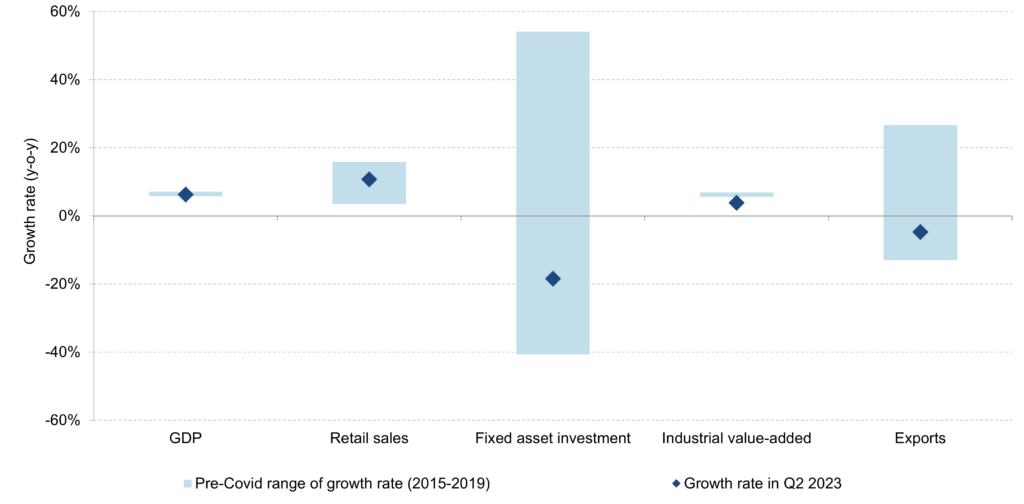
Note: The growth rate of industrial value-added is the y-o-y growth rate of the YTD data. The growth rates of other indicators are the y-o-y growth rates of quarterly data. The historical ranges of the indicators are based on historical y-o-y growth rates in the 20 quarters in 2015-2019.
Sources: The National Bureau of Statistics of China (GDP growth, retail sales volume, fixed asset investment growth, and industrial value-add growth), as of Q2 2023; General Administration of Customs (export growth), as of Q2 2023; LaSalle Investment Management (retail sales growth), as of Q2 2023.
Q: How concerning is the outlook for China’s housing market?
A: The for-sale residential sector is stabilizing in the largest cities.
Despite short-term volatility in sales volume and prices, China’s for-sale residential sector is experiencing a slowing decline in sales volumes and prices compared to the second half of 2022. In Tier 1 cities, however, both sales volume and prices are already improving [LMQ page 24]. In the next 6-12 months, the overall for-sale residential market could reach bottom, supported by government policies, a decline in supply and a reduction in mortgage rates and down payments. We expect the subsequent recovery to be gradual. For-sale residential prices may improve, though sales volumes are unlikely to recover to their prior peak. We expect housing markets in Tier 1 and top Tier 2 cities to lead the recovery of low-tier cities.
Q: What about the troubled developers?
A: Highly leveraged developers are likely to have only a marginal impact on the Chinese financial system.
Despite our expectation of an eventual recovery in China’s for-sale residential sector, the outlook for over-leveraged developers with large exposures to low-tier cities, including Evergrande and Country Garden, remains gloomy. The resolution of these developers’ onshore and offshore corporate debt is expected to take time, which will continue to draw media attention. However, the impact of the default or bankruptcy of these troubled residential developers on the Chinese financial system has been limited so far, and we expect it to remain so, given the exposure of Chinese commercial banks to real estate construction loans only accounted for ~4% of their total assets as of the second quarter of 2023.1 Even for the more vulnerable trust companies, the exposure to real estate declined from ~13% of their total assets in the second quarter of 2019 to ~5% in the second quarter of 2023.2
Q: What is the story with rising youth unemployment?
A: The high youth unemployment rate is misleading.
The unemployment rate of the labor force aged 16-24 in China is rising. However, the direct impacts of this on retail sales and the broader economy are likely to be limited. Those aged 16-24 accounted for only around ten percent of the Chinese population as of 2021.3 In addition, many of those aged 16-24 are still in school, given that young people in China finish education at around age 20, on average.4 There could be some indirect impacts of high youth unemployment on household confidence, although we do not expect them to be significant given that the unemployment rate for the key labor force in China (aged 25-59) is at its lowest level since 2018 [LMQ page 25].
Q: Is China at risk of deflation?
A: It is premature to make the call that China is entering a deflationary period.
It is true that China’s headline inflation rates have been fluctuating around 0% in recent months, primarily driven by food and energy prices coming off peak levels post lockdowns. However, the core inflation rate (excluding food and energy) remains in positive territory [LMQ page 16]. As the Chinese economy gradually recovers and the post-lockdown effects fade, we expect inflation to gradually escalate.
Looking ahead
- Western commentators have generally been disappointed at China’s lack of bazooka stimulus to reinvigorate the economy. The Chinese government’s approach has been to instead focus on smaller stimulus measures or targeted policy shifts. We believe that even if all these supportive actions fail, China still has many options it can implement to boost the economy. In our view, there is a high probability that the Chinese economy could reach its 5% GDP growth target by the end of the year.
- China’s mild economic recovery and slowly improving business and household confidence suggest the demand recovery for income-producing real estate in China could be modest in the near term. Net absorption of major sectors including office, logistics, retail and rented multifamily in the next 12-18 months is likely to be below the levels seen in 2021.
- Troubled for-sale residential developers may continue to offload assets to repair their balance sheets. Over the past decade, Chinese developers have built large portfolios of commercial real estate, mainly composed of offices, retail malls, and hotels. A small number of these developers also own assets in our favored sectors, such as multifamily rental and logistics. Distressed sales at attractive prices could continue to surface in the next 6-12 months.
The path of Japanese monetary policy
The Bank of Japan (BoJ) remains an outlier among global central banks, as it continues to maintain ultra-accommodative policy in the form of yield curve control (YCC). The BoJ introduced YCC in 2016, with the intent to keep 10-year government bond yields low to stimulate consumer spending and business investment. Over the past year, speculation has mounted as to whether this policy would be sustained, with volatility being triggered around moments of policy adjustments or speculation that YCC would be abandoned.
Most recently, on September 22, the BoJ kept the YCC policy unchanged with a unanimous vote. The 3-month rates used a reference for borrowing costs have been bouncing around -0.2 to -0.1%, while the 10-year Japanese government bond (JGB) yields have increased to 0.73% since the BoJ’s surprise tweak to the YCC in December last year [LMQ page 7].5 Inflation in Japan has been running above the BoJ’s two percent target over the past 17 months,6 which in theory could be a catalyst for the BoJ to make more tweaks to its YCC policy or even exit it in the near term. But the answers to complex questions about the trajectory of rates in Japan aren’t so simple; policy actions and capital market reactions are inherently difficult to predict, but are likely to be less dramatic than feared.
Q: Isn’t the BoJ under pressure to change policy to tackle above-target inflation?
A: The two percent inflation target is likely to be achieved in the short term, but the BoJ is focusing on whether the target can be achieved sustainably.
The latest BoJ inflation projections and Tankan survey results7 suggest that inflation could remain above the BoJ’s 2% target at least over the next 12 months [LMQ page 19]. Wages in Japan, a key component of inflation, grew by 2.3% y-o-y in July 2023 due to a tight labor market.8 Employment conditions are expected to tighten further in the near term,9 potentially reaching levels last seen in 1990s. The 2024 Shunto (spring) wage negotiation is the next key event to monitor. Hence, it is as yet uncertain whether wage growth in Japan could remain consistently above its 2% target.
Inflation and core inflation in Japan
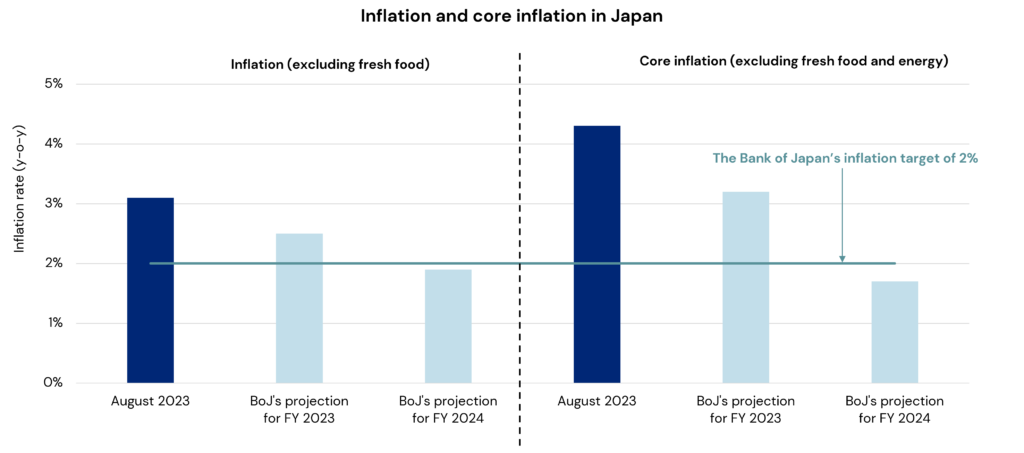
Source: The Japan Statistics Bureau (historical inflation data), as of August 2023. The Bank of Japan (inflation projection for fiscal year 2023 and 2024), as of July 2023.
Inflationary pressures do not exist in a national vacuum. Thankfully, inflation is now declining in other developed markets [LMQ page 12], potentially giving the BoJ more time to evaluate the prospects for inflation in Japan. Many central banks, following the lead of the US Federal Reserve, are seen to be at or near the end of their tightening cycles as inflationary pressure tapers. That said, global central banks are highly unlikely to cut interest rates sharply any time soon, unless economies fall into deep recession. Therefore, we expect the interest rate differential between Japan and the US to remain wide but may narrow somewhat in the near term. Moderation in the interest rate differential could help the weak yen to regain some ground, which might also alleviate some pressure on the BoJ.
Q: How do you read the political tea leaves around BoJ’s policy?
A: Policymakers will tread carefully as they do not want to upset the labor market and the financial system.
Inflation in Japan has been outpacing wage growth, putting pressure on Prime Minister Fumio Kishida’s approval ratings, according to a poll conducted by the Asahi Shimbun newspaper on September 18. There is a strong political impetus for Kishida and the new cabinet to ensure wage growth consistently exceeds the inflation rate. Moreover, as more than 70% of the mortgage loans in Japan have floating rates,10 there is a strong incentive for the BoJ to keep short-term interest rates relatively low. BoJ measures that could derail Japan’s economic recovery or disrupt the capital markets could be considered politically risky and thus less likely.
Looking ahead
- Forward markets indicate that 3-month interest rates are expected to enter positive territory but remain below 0.2% over the next two years, which implies that borrowing costs in Japan would remain much lower than those of other developed economies. Leveraged real estate yields in Japan remain higher than unlevered yields, in contrast to many other markets where real estate debt is now priced at levels that lead to “negative leverage” at today’s pricing. Japanese real estate debt costs could remain relatively low if the forward markets’ prediction is accurate.
- Yields on 10-year JGBs have increased sharply by Japan’s historical standards since the BoJ loosened the YCC in December 2022. The forward markets imply that 10-year JGB yields could increase to close to 1.1% by September 2025, near the level last seen in the second half of 2011. Such an increase would be modest by global comparison but could be viewed as a step closer to interest rate normalization. Given “the math” of rate rises when the starting point is low in absolute terms, even a modest increase in 10-year JGB yields could have some impact on Japanese real estate valuations, a risk that investors should anticipate and plan for accordingly.
- Nonetheless, there are still wide gaps between JGB yields, current yields on other asset classes and real estate yields. This makes income-producing Japanese real estate investments attractive, especially for domestic investors, who dominate the market. With a uniquely wide positive spread between borrowing costs and cap rates, we expect Japan to continue to remain the most liquid institutional real estate market in Asia-Pacific for the foreseeable future, albeit with some volatility at times.
Footnotes
1 Source: The People’s Bank of China (total amount of outstanding real estate construction loans), as of Q2 2023; State Administration of Financial Supervision and Administration of China (total assets of commercial banks), as of Q2 2023
2 Source: The China Trustee Association, as of Q2 2023
3 Source: The National Bureau of Statistics of China, as of 2021
4 Source: LaSalle Investment Management, as of 2021. The estimation is based on the average years of education among the young labor force in China published by the Ministry of Education of China in 2021.
5 Source: Bloomberg, as of September 25, 2023
6 Source: The Japan Statistics Bureau, as of August 2023
7 Source: The Bank of Japan’s Tankan survey on the inflation expectation and the output price expectation among corporates of all industries, as of June 2023
8 Source: The Japan Statistics Bureau, as of August 2023
9 The Bank of Japan’s Tankan survey: all-industry employment conditions, as of June 2023
10 Source: The Japan Housing Finance Agency, covering home loans between October 2022 and March 2023.
Important Notice and Disclaimer
This publication does not constitute an offer to sell, or the solicitation of an offer to buy, any securities or any interests in any investment products advised by, or the advisory services of, LaSalle Investment Management (together with its global investment advisory affiliates, “LaSalle”). This publication has been prepared without regard to the specific investment objectives, financial situation or particular needs of recipients and under no circumstances is this publication on its own intended to be, or serve as, investment advice. The discussions set forth in this publication are intended for informational purposes only, do not constitute investment advice and are subject to correction, completion and amendment without notice. Further, nothing herein constitutes legal or tax advice. Prior to making any investment, an investor should consult with its own investment, accounting, legal and tax advisers to independently evaluate the risks, consequences and suitability of that investment.
LaSalle has taken reasonable care to ensure that the information contained in this publication is accurate and has been obtained from reliable sources. Any opinions, forecasts, projections or other statements that are made in this publication are forward-looking statements. Although LaSalle believes that the expectations reflected in such forward-looking statements are reasonable, they do involve a number of assumptions, risks and uncertainties. Accordingly, LaSalle does not make any express or implied representation or warranty, and no responsibility is accepted with respect to the adequacy, accuracy, completeness or reasonableness of the facts, opinions, estimates, forecasts, or other information set out in this publication or any further information, written or oral notice, or other document at any time supplied in connection with this publication. LaSalle does not undertake and is under no obligation to update or keep current the information or content contained in this publication for future events. LaSalle does not accept any liability in negligence or otherwise for any loss or damage suffered by any party resulting from reliance on this publication and nothing contained herein shall be relied upon as a promise or guarantee regarding any future events or performance.
By accepting receipt of this publication, the recipient agrees not to distribute, offer or sell this publication or copies of it and agrees not to make use of the publication other than for its own general information purposes.
Copyright © LaSalle Investment Management 2023. All rights reserved. No part of this document may be reproduced by any means, whether graphically, electronically, mechanically or otherwise howsoever, including without limitation photocopying and recording on magnetic tape, or included in any information store and/or retrieval system without prior written permission of LaSalle Investment Management.
Our latest LaSalle European Cities Growth Index (ECGI) ranks European cities with the strongest economic prospects based on data inputs of economic growth, human capital, business risk and – for the first time – extreme heat.
The 2023 edition highlights the steady strong positions of both London and Paris, which are set to account for more growth than Europe’s next nine top-ranked cities combined. Interestingly, Paris has overtaken London as the top destination for venture capital funding for the first time since LaSalle began tracking this data in 2006, receiving particularly elevated levels of investment into its technology sector.
Nordic cities appear to have an increasing advantage due to demographic trends, a skilled workforce and world-leading pharma, industrial tech and creative industries; they account for a quarter of the top 20 cities. German cities have continued to perform strongly in the index despite slow population growth. On the other hand, Rome and other Italian cities’ rankings are most negatively impacted after a new factor accounting for extreme heat days was added to the ECGI this year.
Elsewhere, Prague and Warsaw have been identified as having promising growth prospects as more expats return and high-skilled workers remain, with this “brain gain” leading them to their highest scores since the global financial crisis. The index also reflects that Warsaw is becoming an attractive place for employment in the technology sector and Prague is forecast to benefit from a jobs boom.
Want to read the full report?
The art and science of portfolio construction matters most when market conditions change suddenly. This has never been truer than in the past few years, which saw major pivots in capital markets as policymakers shifted from trying to stimulate the economy at the start of the pandemic, to applying the breaks to prevent inflation running out of control. The speed and unpredictability of these changes highlights the importance of planning ahead by thinking carefully about how to create portfolios that can be expected to be resilient. Foundational concepts of portfolio management such as diversification and risk management should be considered alongside an investor’s objectives and values to devise a strategy for their portfolio.
It is with these factors in mind that we release first edition of LaSalle’s ISA Portfolio View, which seeks to answer five foundational questions about real estate:
 Why real estate lays out the case for property exposure in a multi-asset context?
Why real estate lays out the case for property exposure in a multi-asset context?
 Why global considers the benefits of expanding horizons beyond an investor’s domestic market?
Why global considers the benefits of expanding horizons beyond an investor’s domestic market?
 Why be sector smart tries to make sense of the recent changes in relative sector performance with an eye to building resilient portfolios?
Why be sector smart tries to make sense of the recent changes in relative sector performance with an eye to building resilient portfolios?
 Why be quadrant smart addresses the interplay among the “four quadrants” of real estate?
Why be quadrant smart addresses the interplay among the “four quadrants” of real estate?
 Why manage risk explores the importance of—and our approach to—managing investment risk?
Why manage risk explores the importance of—and our approach to—managing investment risk?
In many ways the ISA Portfolio View is the continuation of a longstanding strand of LaSalle’s analysis that would typically form the latter chapters of the Investment Strategy Annual. In this new standalone edition, we draw from a deep pool of experts from around the firm, acknowledging the interconnectedness of real estate opportunities: across borders, across sectors, and across quadrants. We welcome your questions and feedback.
Important Notice and Disclaimer
This publication does not constitute an offer to sell, or the solicitation of an offer to buy, any securities or any interests in any investment products advised by, or the advisory services of, LaSalle Investment Management (together with its global investment advisory affiliates, “LaSalle”). This publication has been prepared without regard to the specific investment objectives, financial situation or particular needs of recipients and under no circumstances is this publication on its own intended to be, or serve as, investment advice. The discussions set forth in this publication are intended for informational purposes only, do not constitute investment advice and are subject to correction, completion and amendment without notice. Further, nothing herein constitutes legal or tax advice. Prior to making any investment, an investor should consult with its own investment, accounting, legal and tax advisers to independently evaluate the risks, consequences and suitability of that investment.
LaSalle has taken reasonable care to ensure that the information contained in this publication is accurate and has been obtained from reliable sources. Any opinions, forecasts, projections or other statements that are made in this publication are forward-looking statements. Although LaSalle believes that the expectations reflected in such forward-looking statements are reasonable, they do involve a number of assumptions, risks and uncertainties. Accordingly, LaSalle does not make any express or implied representation or warranty, and no responsibility is accepted with respect to the adequacy, accuracy, completeness or reasonableness of the facts, opinions, estimates, forecasts, or other information set out in this publication or any further information, written or oral notice, or other document at any time supplied in connection with this publication. LaSalle does not undertake and is under no obligation to update or keep current the information or content contained in this publication for future events. LaSalle does not accept any liability in negligence or otherwise for any loss or damage suffered by any party resulting from reliance on this publication and nothing contained herein shall be relied upon as a promise or guarantee regarding any future events or performance.
By accepting receipt of this publication, the recipient agrees not to distribute, offer or sell this publication or copies of it and agrees not to make use of the publication other than for its own general information purposes.
Copyright © LaSalle Investment Management 2023. All rights reserved. No part of this document may be reproduced by any means, whether graphically, electronically, mechanically or otherwise howsoever, including without limitation photocopying and recording on magnetic tape, or included in any information store and/or retrieval system without prior written permission of LaSalle Investment Management.
In recent editions of LaSalle Macro Quarterly (LMQ), many charts have highlighted interest rate rises. LaSalle has especially focused on the repricing of income-producing real estate that rate rises have triggered in much of the globe. But the spike in rates is also having an impact on owner-occupied residential real estate, which accounts for a much larger share of the global property pie than do institutional assets. As we release the LMQ for Q3 2023, we look at the broad implications of higher residential mortgage rates, and how they vary by country. Even if institutional investors do not directly touch owner-occupied housing, they should consider the risks (and a few opportunities) caused by these dynamics.
Higher residential mortgage rates have implications for both new buyers and existing owners. For new buyers, higher rates reduce the purchase price they can pay (assuming a fixed amount of debt service). In practice, buyers cope with this by dedicating a larger share of their income to housing, or by scaling back or postponing their home purchase ambitions. For economies in which housing constitutes a meaningful share of the economy, this can create a noticeable drag on GDP growth. It may also put downward pressure on home prices, which can have indirect wealth effects on consumer spending. (So far, house prices for key countries have held up reasonably well during this period of rising rates—as shown in the chart on page 7 of the LMQ—but risks remain.)
For existing owners, much depends on the specific terms of the mortgage. The US mortgage market is unique globally in having a very large share of loans with rates that are fixed over a fully amortizing term (typically 30 years), according to data from Fitch. Assuming they do not move, borrowers can continue to enjoy low fixed payments. Elsewhere in the world, residential mortgage rates are usually floating or fixed only for a limited time. When rates rise, they filter through to borrowers gradually as fixed rate periods end—in other words, when rates reset. Depending on the mechanism for rate resets, they can cause a direct hit to disposable incomes. Households may react to this by scaling back spending elsewhere, or in the extreme, leaving the ranks of homeownership. These impacts will be more significant in places where consumers already have a high debt service burden.
For investors in income-producing institutional real estate, there are two aspects of these dynamics that are especially relevant. One is the broad recession risk that comes from weaker housing markets and stretched consumers. Oxford Economics has cited differential exposures to mortgage resets as a driver of divergence in near-term economic growth between the US and Canada. Second, the substitution effect from owned to rented housing may provide a boost to both multifamily and single-family rental demand, potentially driving stronger performance for residential strategies.
Canada: An illustrative case
Canada is an interesting case study because the structural characteristics of its residential mortgage market and the availability of transparent data permit a relatively clear identification of mortgage rate resets. Most residential mortgages in Canada have 25- or 30-year amortization periods, with typical fixed rate periods (known as “terms”) running from as short as one year to as long as ten years, according to the Bank of Canada. Some mortgages have a fixed interest rate that is reset for the next term according to the prevailing market rate. This occurs through a renewal at the end of each term, until the mortgage is fully paid off. According to Bank of Canada (see table), fixed-rate mortgages account for two-thirds of balances outstanding in the country among lenders. Most fixed-rate mortgages have remaining terms of five years or more (40% of overall balances), followed by three-to-five years at 18.4%. Only 8.5% of all fixed-rate mortgages expire in the next three years
Composition of outstanding residential mortgage balances, Canada (April 2023)
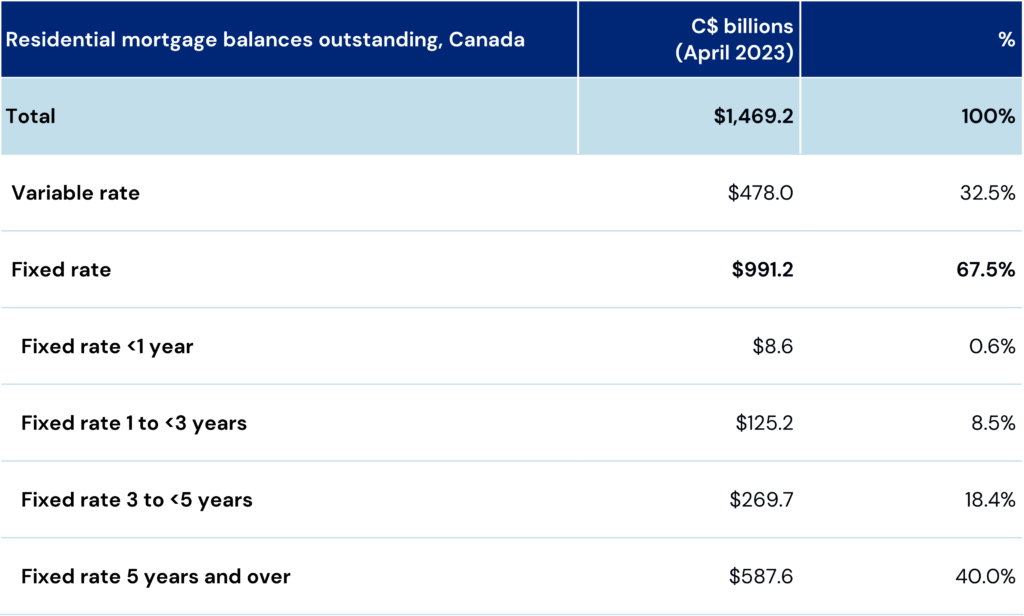
However, the remaining one-third of Canadian mortgages are variable rate, which float based on short-term interest rate movements. The Bank of Canada has hiked interest rates nine times since March 2022, pushing up rates on some variable-rate mortgages to around 6.0%, from roughly 2.8% a year ago. The most common type of variable-rate mortgages in Canada have fixed monthly payments. As interest rates rise, a higher proportion of the payment goes toward interest and less toward principal. Rising rates over the past 18 months have put some borrowers in the position of having monthly payments that do not cover the interest portion of the mortgage. The excess (unpaid) interest for that month gets added to the principal, increasing the original mortgage amount. Compared to countries where the absolute monthly payment amount adjusts directly with rates, this mechanism prevents an immediate near-term hit to disposable income from rising rates. But it does effectively embed the impact of higher rates into a longer-term increase in debt on household balance sheets.
The rest of the world
Beyond Canada, which countries are impacted by rising residential mortgage rates? Cross-border comparisons are not straightforward; the devil is in the detail. Nuances to consider include variation in fixed-rate terms, amortization periods, interest rate levels, and when and how rates reset. Many factors, including macro indicators like household debt levels and the structure of countries’ residential mortgage markets, need to be considered in assessing a market’s exposure.
One persistent issue is that data on the relative shares of fixed- versus variable-rate mortgages by country tend to classify any mortgage as fixed rate if it is fixed for a period of time, even if it that rate will reset in the near term. Analysis by Fitch Ratings attempts to correct for this with a metric that includes any mortgages with rates that are expected to expire or reset within 24 months. On this analysis, Australia leads in exposure to resets, followed by Spain, the UK, and Canada. Australian mortgages with fixed rates generally have shorter fixed-rate periods of around two years; this compares with five years in the United Kingdom and Canada, and 30 years in the U.S. (Although not in the Fitch dataset, we understand that Sweden is also relatively highly exposed to resets.)
Share of residential mortgages originated with rates that expire or reset within 24 months
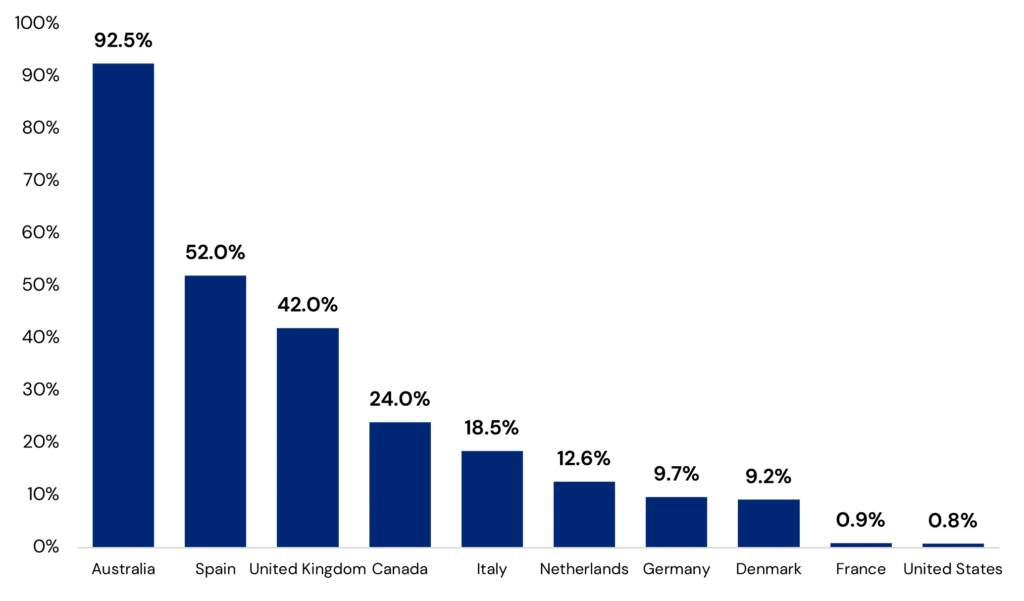
Sources: Fitch Ratings
Fitch extended their analysis to combine and layer in pre-reset mortgage debt-service-to-income (“DTI”) ratios by country. This allowed them to estimate how much an increase in DTIs would be caused by a five-percentage point increase in interest rates. They found that the impact roughly followed the rank ordering above, with Australia and the UK most exposed, and the US least exposed. It should be noted that many of the same mitigating factors that apply to Canada (e.g., strong immigration, shortages of housing, low mortgage arrears) also apply to Australia, Spain and the UK.
The outlier case of the US is not quite as positive as it may appear. As a country with high internal mobility and (unlike many other markets) mortgages that are not “portable” between different collateral, the effective exposure of US households to mortgage rate changes is probably higher than implied by these data alone. Moreover, there are some downsides to having a large share of long, fixed rate mortgages. For one, the lesser impact of higher rates on consumer spending potentially requires more interest rates increases to have the same desired impact on inflation. Another factor, which is already evident, is that having a low interest rate locked in creates a barrier to moving, limiting the supply of housing for sale and making home prices sticky.
Looking ahead
- As mortgages reset at higher rates, a greater share of household budgets will be diverted to mortgage payments. This could be particularly acute for households that live “paycheck to paycheck.” While some households may have excess savings to cushion the blow of higher mortgage payments, overall discretionary retail spending is at risk of moving lower. This, in turn, could impact retail real estate market fundamentals. The composition of retail spending could also shift, as households with lower discretionary incomes move more of their spending to discount retailers, and away from discretionary or luxury items. In the case of Canada, Oxford Economics forecasts that consumer spending will drop 1.8% from its pandemic-era peak, potentially tipping the economy into recession.
- While interest rate hikes since early 2022 have increased financing costs for owners of multifamily apartments and reduced transaction volumes, ongoing housing shortages in various countries are contributing to higher apartment demand. With higher mortgage payments putting the cost of home ownership out of reach for many, demand for relatively lower-cost rental housing has increased. This has clearly been the case in Canada, where according to the Canada Mortgage and Housing Corporation, apartment vacancy declined by 120 basis points in 2022 as apartment absorption reached an all-time high of 100,300 units, an increase of 59% over 2021.
Sources:
1. ECONOSIGHTS: Three reasons why Australia is more vulnerable to higher rates – Mousina, Diana, AMP Capital, September 2022.
2. Fear of Renewal: Most new homebuyers ‘very worried’ next term will bring much higher monthly payments – Angus Reid Institute, May 2023
3. How Do Mortgage Rate Resets Affect Consumer Spending and Debt Repayment? Evidence from Canadian Consumers – Bank of Canada, May 2020
4. Statistics on Mortgage Arrears in Canada – Canadian Bankers Association, Table DB50 Public, June 2023
5. Global Housing and Mortgage Outlook – 2023 – Fitch Ratings, December 2022
6. Mortgage Interest Payments in Advanced Economies – One Channel of Monetary Policy – Reserve Bank of Australia, Statement on Monetary Policy, February 2023
Important Notice and Disclaimer
This publication does not constitute an offer to sell, or the solicitation of an offer to buy, any securities or any interests in any investment products advised by, or the advisory services of, LaSalle Investment Management (together with its global investment advisory affiliates, “LaSalle”). This publication has been prepared without regard to the specific investment objectives, financial situation or particular needs of recipients and under no circumstances is this publication on its own intended to be, or serve as, investment advice. The discussions set forth in this publication are intended for informational purposes only, do not constitute investment advice and are subject to correction, completion and amendment without notice. Further, nothing herein constitutes legal or tax advice. Prior to making any investment, an investor should consult with its own investment, accounting, legal and tax advisers to independently evaluate the risks, consequences and suitability of that investment.
LaSalle has taken reasonable care to ensure that the information contained in this publication is accurate and has been obtained from reliable sources. Any opinions, forecasts, projections or other statements that are made in this publication are forward-looking statements. Although LaSalle believes that the expectations reflected in such forward-looking statements are reasonable, they do involve a number of assumptions, risks and uncertainties. Accordingly, LaSalle does not make any express or implied representation or warranty, and no responsibility is accepted with respect to the adequacy, accuracy, completeness or reasonableness of the facts, opinions, estimates, forecasts, or other information set out in this publication or any further information, written or oral notice, or other document at any time supplied in connection with this publication. LaSalle does not undertake and is under no obligation to update or keep current the information or content contained in this publication for future events. LaSalle does not accept any liability in negligence or otherwise for any loss or damage suffered by any party resulting from reliance on this publication and nothing contained herein shall be relied upon as a promise or guarantee regarding any future events or performance.
By accepting receipt of this publication, the recipient agrees not to distribute, offer or sell this publication or copies of it and agrees not to make use of the publication other than for its own general information purposes.
Copyright © LaSalle Investment Management 2023. All rights reserved. No part of this document may be reproduced by any means, whether graphically, electronically, mechanically or otherwise howsoever, including without limitation photocopying and recording on magnetic tape, or included in any information store and/or retrieval system without prior written permission of LaSalle Investment Management.
The state of the market year-to-date: Capital markets digest repricing, as tenant demand stays resilient and energy markets deliver a positive surprise.
Our latest LaSalle European Market View shows how Europe’s economies and real estate markets are being impacted by, and adapting to, the current period of unusual uncertainty.
This update highlights recently released data on how Europe’s energy market has coped with shutoffs and surging prices in the winter following Russia’s invasion of Ukraine. It did so through a combination of reduced consumption (p. 6), more electricity generation from renewables (p. 7), and shifting to imports from new sources (p. 8). In Q1, the EU’s natural gas consumption was tracking 18% below average. This owes some thanks to mild winter temperatures, but also to conscious conservation efforts.
Natural gas consumption in Europe (EU27)
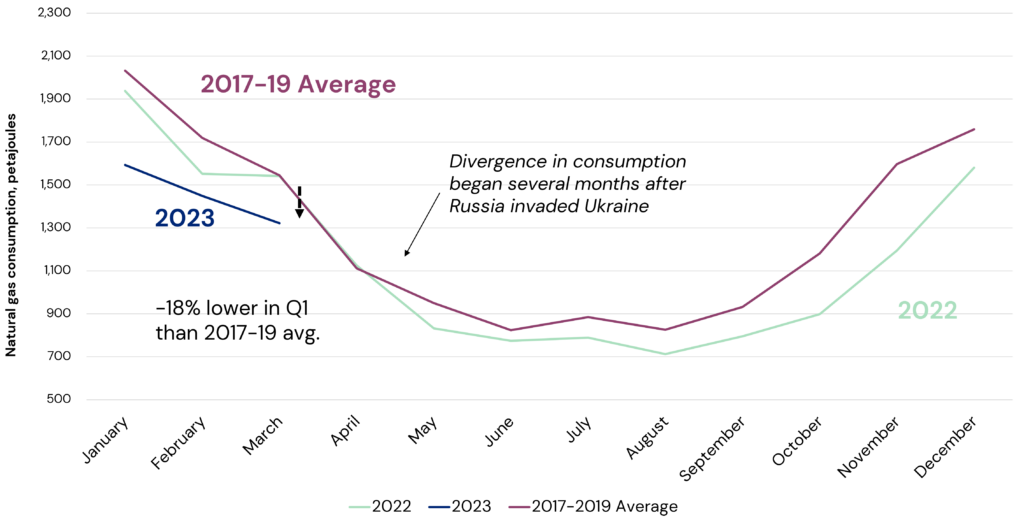
Source: LaSalle analysis of Eurostat data to March 2023. Note that the UK is excluded from all time series data above.
Falling energy prices have led to recent steep headline inflation declines (p. 11) and kept Europe’s largest economies from entering recession to date (p. 9). Yet core inflation – excluding volatile food and energy – is higher today than in 2022 – and GDP growth is at stall speed. European banks have weathered the aftershocks of SVB’s failure and the Swiss National Bank’s forced resolution of Credit Suisse. However, some pullback in bank risk appetite is evident in debt markets (see p. 29 and our April ISA Briefing).
Even as the ECB and Bank of England’s rate hikes have continued, long-term swap rates today are similar to where they started the year (p. 28). This has given private real estate and yields some time to digest the new repricing math. The UK’s repricing stands out for its speed, with monthly UK index data swinging to a positive return in March after eight months of deep negative returns (p. 34).
European real estate transaction volume declined to an 11-year low in Q1. This is a lagging rather than concurrent indicator, however, and reflects the high uncertainty and bid-ask spreads that existed near the end of 2022. At the same time, the most recent Q1 data on occupier trends shows hardy demand fundamentals, albeit with some cooling. In Q1, prime logistics rents continued to grow at a double-digit annualized pace and UK residential sector kept pace with high inflation across many markets, even as office rents cooled and retail rents were flat. As we look ahead, we believe the relationship between current vacancy and its historic levels (p. 18, 20, 21) points to the European property types and markets where rent momentum is most likely to continue.
Quarter-over-quarter rental growth in Europe
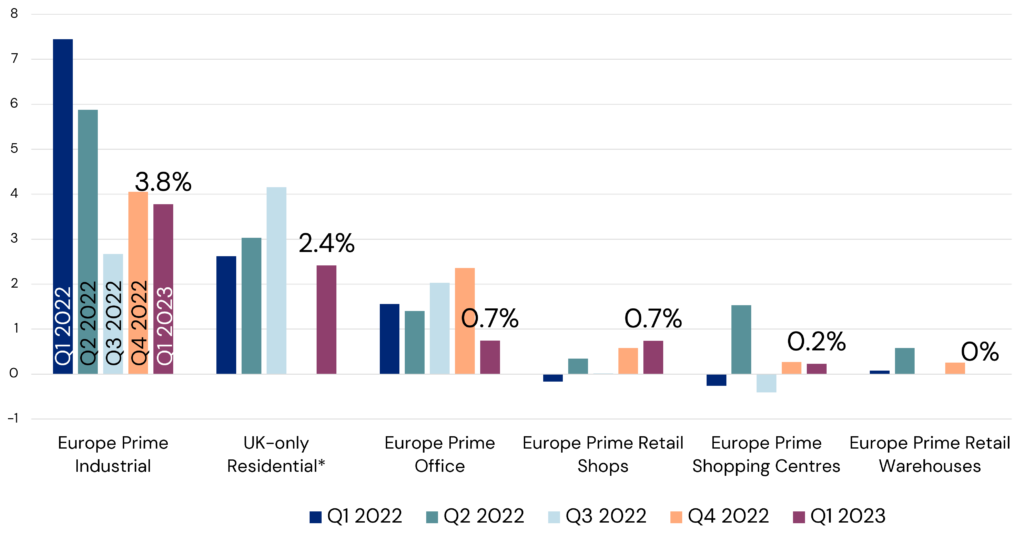
*Average rent and Q1 2023 residential data currently unavailable. UK residential rent data is based on new listings (rather than in-place rents).
Source: JLL, HomeLet data to Q1 2023. Latest as of May 2023.
Want to read more?
US private real estate returns went negative in Q4 2022 as the impact of higher interest rates continued to ripple through to market pricing and appraised values. This trend is expected to continue through the first half of 2023 with stability projected to return later in the year.
Returns in the fourth quarter showed negative appreciation and income returns in line with previous quarters, resulting in negative total returns for both the NPI and ODCE. The slowdown in returns was most significant for industrial, with retail delivering the highest returns of the major sectors (this is a notable shift from trends of the last 5+ years). Looking ahead, the dominant theme in sector performance is expected to be the under-performance of offices.
This note provides details on the fourth quarter performance of the NPI and ODCE indices, summarizes the outlook for future returns, and provides some information regarding insights from the first release of data related to the new NCREIF subtypes.
Highlights from the Q4 data releases include:
- The quarterly total NPI return declined 410 bps from Q3 to -3.5%. The Q4 return comprised a 0.95% income return and -4.45% appreciation return.
- The trailing-year return declined more than 1,000 bps quarter-over-quarter to 5.53%.
- Returns for all property types were down from the previous quarter and in negative territory, with industrial seeing the greatest decline for the second consecutive quarter. Retail was the highest-returning property type for the first time since Q1 2016.
- The ODCE value-weighted quarterly gross total return of -4.97% was down 440 bps from the third quarter. Appreciation remained negative at an index level and the income return was flat at 0.80%, an all-time low. Mark to market on leverage was a positive as interest rates rose, but negative appreciation caused leverage to be an overall negative to returns.
Want to read more?
Silicon Valley Bank (SVB) and Signature Bank failed. Regulators hastily arranged the sale of Credit Suisse to UBS. Concerns spread about numerous other small and major global banks including Deutsche Bank. Recent events have raised fears that the global economy is in for a credit crunch of unknown magnitude and duration. As we release our first LaSalle Macro Quarterly (LMQ), a revamp of our long-standing “macro indicators deck,” banking sector strains represent the number one macro risk we are assessing.
The proximate cause of each recent bank failure was deposit flight, a drain from the liabilities side of the bank balance sheet. This is fundamentally not a toxic assets problem of the sort that banks faced in the Global Financial Crisis (GFC). Rather, it is a liquidity issue that can be addressed by temporary emergency funding from central banks. But solvency, the greater concern for banks in the longer run is closely tied to the duration of the asset book.
When investors in interest rate-sensitive assets refer to duration, they typically mean the change in value associated with a change in risk-free rates. SVB failed, in large part, due to a perception that it had sustained severe losses on riskless (but long-duration) US Treasuries and near-riskless agency mortgage-backed securities as these assets had mechanically repriced in the higher interest rate environment.
Just as there was a mechanical element to the initiation of this crisis, there is a mechanical feedback loop that can help the crisis partially self-resolve. As worries around bank solvency, credit conditions and the real economy spread, expectations for policy rates fell, causing long-duration assets to once more increase in price, shoring up balance sheets.
As a result, there has been a 360-degree round trip in interest rate forward curves between the beginning of February and the end of March. At first, curves shifted upward due to spiking inflation data, before falling substantially as banking systems came under pressure, followed by a return to the status quo as resolution measures stabilized markets and inflation seized the attention of policymakers and investors once again. As a result of this volatility in rate expectations, the MOVE index of bond option volatility1 has reached the highest levels since the GFC.
There are many media, economic and financial industry sources to turn to for a deeper discussion of the underpinnings of the recent financial sector instability, or to track the daily news flow and the resulting volatility. Our focus is on the practical considerations for investors in property. We have identified four key recommendations for how real estate investors can assess risks and manage through volatility.
1. Don’t miss the forest for the trees.
A lot of analyses have focused on idiosyncratic aspects of individual banks. For example, Silicon Valley Bank has been highlighted for its tech sector links and an unusually large share of its deposits not covered by deposit insurance. Credit Suisse had faced multiple controversies in recent years, including a recent disclosure of reporting irregularities which triggered an equity sell-off, as well as an outsized exposure to losses in cryptocurrencies.
Fundamentally, however, the current pressures impact all banks, with the weakest links facing the greatest strain. The question is: How far beyond those weakest links will the challenges spread? This will depend on how the vagaries of sentiment and fear interact with the willingness of policymakers to take action to protect the banking system. Thus far, action taken to resolve liquidity issues seems to have had the intended stabilizing effect, with banks such as Deutsche tested, but not forced to failure.
2. Monitor the path of monetary policy and bear in mind duration.
Central banks meeting at the end of March faced a dilemma between continuing their path of tightening to fight inflation, versus moderating or pausing to prioritize financial stability. In the end, the European Central Bank (ECB), Federal Reserve (‘Fed’) and the Bank of England (BoE) all opted to press ahead with rate rises2. Their decisions were helped in part by data showing an unexpected re-acceleration in inflation, and perhaps also wishing not to betray significant concern about the stability of financial systems.
Volatility in rates markets has a symmetric aspect, so both the initial fall in expectations and the return to a higher implied path for rates have contributed to the MOVE index reaching decade highs. Research suggests3 that bond volatility is less tied to meeting-by-meeting central bank decisions, which may be well-telegraphed, and more to expectations about the ‘terminal’ rate—the highest level that policy rates will reach over a cycle. As we near that peak rate, bond options are more sensitive to news at the margin than they were even to 75bp rate increases when it was well understood that the terminal rate was still far higher.
Long duration—and therefore high sensitivity to interest rates—is a characteristic not just of bonds, but any long-hold assets with uncertain cashflows, including income-producing real estate. It follows that real estate values, especially in sectors and geographies which have repriced furthest and most quickly such as UK industrial, are also more tightly linked to terminal policy rates at this point than month-to-month central bank decisions.
3. Take an active approach toward real estate debt.
Bank lending is likely to become more conservative as duration risk attracts both external regulatory attention and enhanced internal risk management scrutiny. Any pullback in bank lending activity should further increase the importance of private credit across the economy, including in real estate. This could be beneficial to non-bank lenders funded by sticky capital, who can be expected to originate a greater proportion of mortgage loans. On the equity side, investors should cautiously manage their debt maturity schedule in the near term and diversify their sources of debt capital over the medium term.
4. Manage risk and diversify.
The failures of SVB, Signature and Credit Suisse, and the pressures on other banks, have elicited a policy response that some banking experts consider to be sufficient to prevent severe additional damage to the economy. Certainly, rate-setters have felt sufficiently confident to press ahead with policy rate increases. But as in all cases of banking sector turbulence, there is considerable uncertainty and outcomes will depend on difficult-to-predict sentiment factors. Ultimately, the systemic nature of financial market risks makes them inherently difficult to control. As real estate managers and investors, our best approach is to understand and monitor these risks and practically diversify investments to mitigate the impact on the overall portfolio.
Looking ahead
- We recommend focusing on the overall health of the financial system, rather than sector-specific concerns, such as sizing incremental negatives on tech-related real estate from the failure of SVB. Surely, the loss of a sector-focused relationship lender will have some impact on tech companies. But well before the failure of SVB, the same duration-driven hit to the value of bonds and real estate was affecting early-stage technology companies. We do not think the incremental negative for tech is as important as the broader macro uncertainties.
- Investors should bolster their monitoring of banking health generally and their banking relationships specifically. This includes careful mapping of where deposits are held and sources of debt finance, especially credit lines. These exposures should then be continuously compared to assessments of bank health and market measures of risk, such as credit default swap (CDS) spreads4 and Liquidity Coverage Ratios (LCRs). LaSalle has undertaken a comprehensive global exercise to match such exposures and compare them against a dashboard that tracks the health of close to 100 major banks globally.
Footnotes: 1 [LMQ slide 3], 2 [LMQ slide 4], 3 Based on work by Natixis, a French corporate and investment bank, 4 [LMQ slide 6]
Value investing in European real estate today is characterised by an abundance of unmeasurable uncertainty over quantifiable risk. Successfully navigating that uncertainty requires the intersection of expertise and experience.
Beyond the current turmoil however, we believe four themes will define the Europe of the near future – Europeans will be smarter, greener, older and more mobile.
Periods of dislocation, while testing for investors’ convictions, can also offer opportunity. Uncertainty can result in attractive entry pricing as markets become over-correlated. As a result, fund vintages raised during challenging markets, which are able to take advantage of this repricing, have outperformed in recent cycles.
Where short-term dislocation overlaps with our long-term convictions, we believe lasting value can be created.
Want to continue reading?
What it means for Chinese and global property markets
After nearly three years of enforcing a comprehensive approach to COVID-19, involving frequent testing, rigorous contact tracing and strict border quarantines, China unexpectedly ended its zero-COVID policy in early December 2022.
After an initial period of surging new infections, by mid-January 2023 the situation had improved substantially. Most recently, cases have fallen sharply as the virus has already infected a large share of the population. Life in China is quickly returning to normal, as evidenced by rebounding subway passenger volume and rising road congestion.1 This return to pre-pandemic normality has meaningful implications for the economic and real estate outlook in China, the broader Asia-Pacific region and the world.
Road congestion and subway passenger volume in Tier I cities in China
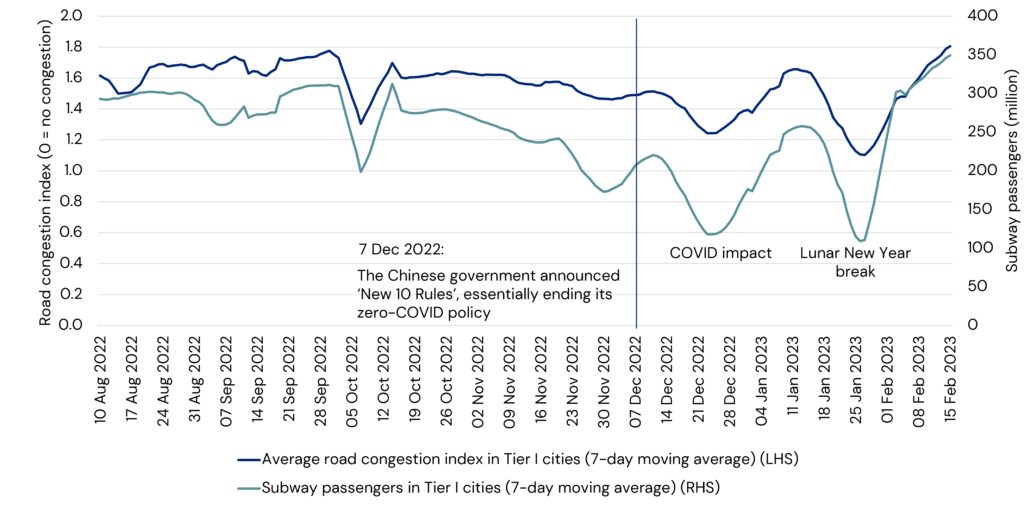
1 Source: Amap.com via WIND Economic Database (road congestion index), WIND Economic Database (subway passenger volume), as of 15 Feb 2023)
China: Unambiguously positive for growth
China’s reopening provides a clear boost to the Chinese economy, and high-frequency indicators suggest it may have already started to recover. The official manufacturing PMI and non-manufacturing PMI both returned in January 2023 to above 50, the dividing line between expansion and contraction, after hitting the lowest levels since March 2020 in December 2022.2
Meanwhile, among the 70 cities tracked, 36 experienced increases in for-sale residential prices on a quarterly basis in January 2023, compared with only 15 cities in December 2022.3
Unlike China’s V-shaped recovery from the initial COVID-19 outbreak in 2021, the rebound this time is likely to be gradual and mild. There are two factors supporting that expectation. First, despite the reopening and a shift in government policy towards promoting growth, it could take some time to repair the balance sheets of Chinese businesses and households, which are fragile after nearly three years under the zero-COVID regime. Second, the country’s for-sale residential sector, historically a main driver for the economy, remains weak despite signs of bottoming.
2 National Bureau of Statistics of China (NBS)
3 National Bureau of Statistics of China (NBS)
Asia-Pacific: Outbound travel likely to be key
Looking to the broader Asia-Pacific region, China’s reopening is an encouraging development for the hospitality industry. Since March 2022, hotel revenue per available room (RevPAR) had been gradually improving in countries which were advanced in their post-COVID reopening, particularly Australia and Singapore.4
However, Chinese visitors historically have been a significant source of hotel demand and visitor spending in major Asia-Pacific markets, and they were almost completely absent in 2022. As such, hotel performance in most tourism destinations of the region is still trailing the pre-pandemic level. As China unleashes pent-up demand for travel, a recovery in Asia-Pacific hotel and tourism-oriented retail sectors is likely.
4 The Singapore Tourism Board, The Hong Kong Tourism Board, as of Dec 2022
International visitor arrivals and the proportion from China5
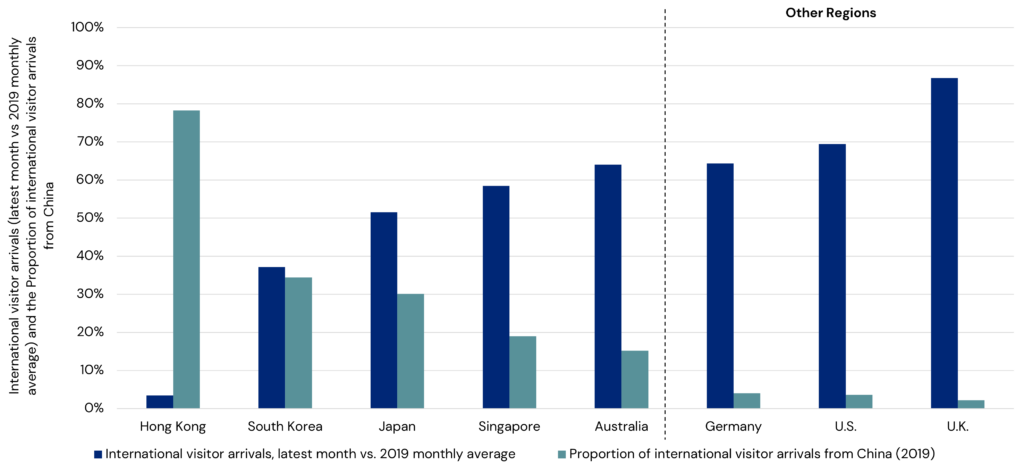
5 The latest data on international visitor arrivals to (1) the U.K. are as of September 2022, (2) Australia, Germany, and the U.S. are as of November 2022, and (3) Hong Kong, Japan, Singapore, and South Korea are as of December 2022. The data on the proportion of international visitor arrivals from China for all countries are as of 2019 except Germany which is as of 2018. Source: Statista and CEIC (Germany), as of 2018; the U.K. Office for National Statistics (the U.K.), as of September 2022; the Australian Bureau of Statistics, the U.S. Department of Commerce, as of November 2022; the Hong Kong Tourism Board, the Japan National Tourism Organization; the Singapore Tourism Board; the Korea Tourism Organization, as of December 2022.
Global: Incrementally inflationary or boost to supply chains?
The impact of China’s reopening on the global economy will depend on the interplay of two opposing factors. On the one hand, higher demand from stronger growth in the world’s second-largest economy could potentially increase global inflation, or at least keep it high for some time.
On the other hand, the smoother operation of global supply chains from a fully reopened China is potentially a counterbalancing disinflationary trend. Indeed, an end to the start-stop impact of lockdowns on production and transportation should reduce the risk of further supply chain shortages.
Our expectation of only a gradual recovery in the domestic economy means that the hit to global inflation may not be significant. Weaknesses in the Chinese housing market is likely to prevent too much upward pressure on global construction costs from materializing, even though China is the world’s largest steel exporter. But any boost to inflation, just as it is starting to come down in much of the world, would be unwelcome and could mean that global central banks might not be able to stop raising interest rates as soon as otherwise.
Looking ahead
- The reopening is expected to boost occupier and investor demand for commercial real estate in China. Improving real estate fundamentals and domestic investor sentiment, along with low domestic interest rates and the rapid growth of the domestic public REIT market, points to increasing capital market liquidity among domestic investors for Chinese commercial real estate assets in the near term. The logistics and multifamily rental sectors are expected to benefit from this trend the most due to their relatively sound fundamentals, their qualification for domestic public REIT structures and other supportive government policy measures.6
- In the Chinese culture, the Year of the Rabbit signifies prosperity, peace and longevity. While the world is still facing many challenges including elevated inflation, higher interest rates, the risk of recession and the Russia-Ukraine war, the reopening in China in the Year of the Rabbit brings clear positives to the Chinese economy and its real estate markets, though the risk of a renewed rise in global inflation should be watched carefully.
6 Among the major commercial real estate sectors, currently only industrial and multifamily rental assets are qualified underlying assets for ownership by domestic public REITs.
Want to continue reading?
We property strategists are accustomed to working with traditional real estate variables such as net absorption, rental growth and vacancy rates. But in the early days of the COVID-19 pandemic, there was no choice but to go on a crash course in previously unfamiliar epidemiological concepts like positivity rates, R-naught¹ and vaccine effectiveness, as these suddenly became drivers of short-term real estate conditions. Over the past year, real estate researchers have likewise had to quickly scale a learning curve in understanding energy markets. For the first time ever, we produced charts denominated in once esoteric units of measurement like therms, MMBTUs and MWhs.²
Gas, electricity and oil prices have long been linked to real estate outcomes—energy crises sparked 1970s inflation and have shaped real estate demand from Alberta to Texas and Scotland. But when supply is predictable and prices moderate, as in the years before the pandemic, those links can become dormant. They have awoken again in the past year. The recent dramatic but uneven volatility in energy prices has deeply influenced the economic and property market outlook—especially in Europe—and we expect it to continue to do so going forward.
Europe’s cold, dark winter turns brighter
One year on from Russia’s invasion of Ukraine in February 2022, European energy markets have proven adaptable, facing down a unique degree of energy disruption owing to the region’s dependence on pipeline links from Russia. After initially skyrocketing—European natural gas price at their peak were twelve-times higher relative to the ten-year, pre-conflict average—by mid-February 2023 prices it had fallen to a level only around two and a half times that long-term average.³ Government schemes to partially socialize the cost of higher energy, at the expected expense of massive government deficits and higher borrowing costs, now look a lot less extreme.
¹ R0 is the basic reproduction number, which describes the expected number of cases of an infectious disease directly generated by a single case, in a population where all individuals are susceptible to infection.
² 1 therm = 100,000 British thermal units (BTUs), a measure used in UK natural gas pricing. 1 MMBTU = 1,000,000 BTUs, which is used in US gas pricing. 1 MWh = 1,000,000 watts of electricity over one hour, used in European pricing of natural gas.
³ Refinitiv, Natural Gas TTF (Title Transfer Facility) historical front month futures as of 13 February 2023
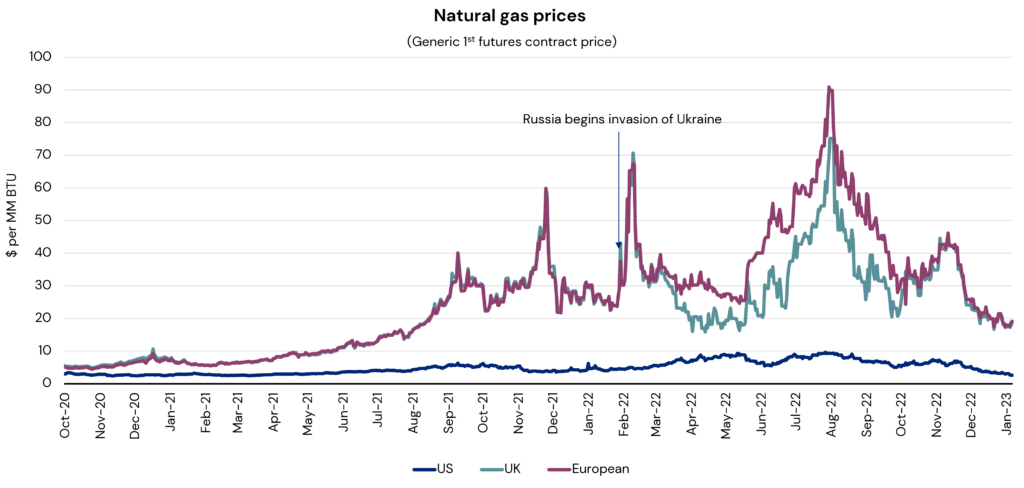
Source: New York Mercantile Exchange and Intercontinental Exchange data via Bloomberg. As of 1 February 2023⁴
Relatively warm weather, cutbacks in consumption and alternative sources of energy, such as renewables and the global liquified natural gas (LNG) market, have contributed to unusually full gas storage reserves. German wind, solar, biomass, hydro, and other renewables generated 47% of the country’s electricity in 2022, a five-percentage point rise in mix.⁵ This allowed European energy prices to fall and has caused headline inflation to ease substantially, even if European core inflation remains stubbornly high. This has brightened the region’s economic prospects as well; our call in the ISA Outlook 2023 (published in December 2022) that a European recession was “almost certainly underway” now appears premature.
Is Europe out of the woods? Far from it. The winter is not yet over, and a cold snap could quickly deplete gas storage reserves. Going into next winter, the Russian supply that was used to partly fill those tanks last autumn will likely be completely unavailable. Meanwhile, Chinese demand for LNG, which was down by 20% in 2022 owing to the country’s zero-COVID policy⁶, is likely to rebound as its economy reopens, leading to more competition for tanker deliveries. Europe’s energy reorientation will probably be at least a decade-long process, which will not be reduced in scope, scale or difficulty by one fortuitously warm winter—though new LNG import capacity and suppliers have accelerated the shift in the past year. We expect that energy prices will continue to have deep impacts on Europe’s economy and real estate markets.
⁴ TTF future prices have been used as a benchmark for European natural gas prices due to being the most liquid gas trading hub in Europe
⁵ German Environment Agency (UBA), press release from 12 December 2022
⁶ International Energy Agency (IEA), report from November 2022
Beyond Europe
While Europe’s historic reliance on Russian fossil fuels makes it uniquely exposed to energy risks, we see energy as a relevant, if variable, factor for global real estate. This is in part because energy markets operate at both global and regional scales. The Ukraine crisis caused an acute surge in European gas prices, but also a worldwide spike in the price of oil, which trades in a more globalized marketplace. It is worth noting that Canada and now the US are in aggregate net energy exporters, meaning increases in energy costs can be a net positive for economic growth in metro areas with concentrations of energy companies.
Energy and real estate
Going beyond the macro, the impact of energy costs on real estate varies greatly by building type. Data centers, cell towers, hotels, and cold storage are especially energy-hungry property types, and ones where operational business models mean landlords may be directly exposed to energy costs. Residential sectors vary widely, depending on the age and energy efficiency of the stock, the nature of building systems and leasing conventions. For example, the bulk of the older German residential inventory is heated by gas-fired boilers providing steam heat, and tenants pay “warm rents”—meaning the landlord is responsible paying for heat. Individually metered, modern multifamily product is more insulated—literally and figuratively—from energy prices.
Investments in commercial real estate sectors with net lease structures under which tenants pay energy bills directly, such as office and logistics, may appear shielded from energy volatility. But tenants in places where energy prices have surged have become painfully aware that these costs, historically a small portion of their total expense of occupancy, can suddenly become a significant burden. In our European portfolio, we have for the first time received requests from tenants to help lower their energy bills. Indeed, working with occupiers to improve efficiency and to generate on-site energy to reduce these bills has become an important way to retain them and maximize the affordability of the net rents they pay.
The limitations of electrical grids are also influencing property markets. The availability (or unavailability) of power is already shaping location decisions globally for energy-consumptive uses like data centers, and can be a constraining factor on building electrification, a key step in decarbonization. Weather events can intersect with the nuances of energy supply to cause blackouts, such as occurred in Texas in February 2021 and recently in parts of China, potentially putting a premium on buildings with backup sources of power.
These are just a few of the ways that energy risks have become closely intertwined with real estate investment outcomes. We expect to be following these issues more closely in the years ahead.
Looking ahead
- Real estate investors must begin to include energy factors in identifying target markets and sectors. For example, in Europe we have developed the LaSalle Energy Vulnerability Index (LEVI) which joins our European Cities Growth Index (ECGI) and other tools as an input to our market selection decisions. LEVI combines indicators such as the sources of energy by country, energy intensity, domestic energy consumption and import dependency, to assess countries’ relative susceptibility to energy shocks. LEVI is just an initial approach to assess energy risks. Because there is intuitively a strong correlation between climate transition risks and energy vulnerabilities, the approach we take in reflecting both sets of risks in our models may eventually converge into a unified approach.
- Expensive energy is a big additional incentive for installing on-site renewables such as solar and wind-generating capacity. Tenants are big beneficiaries of this because these initiatives tend to cut their gross occupancy costs. Landlords also capture some of this value by being able to charge a higher net rent, all else equal. This comes in addition to the premium we see the real estate capital markets placing on such building features, owing to their alignment with regulatory trends and the goal of decarbonization.
US private real estate returns weakened considerably in 3Q 2022 as higher interest rates continued to have a major impact on market pricing and appraised values. This trend is expected to continue in the remainder of 2022 and into the opening quarters of 2023. This is leading to a dramatic slowdown in returns from the record levels seen less than a year ago.
Returns in the third quarter showed negative appreciation, with total returns remaining positive for both the NPI and ODCE. The slowdown in returns was most significant for industrial, with apartments delivering the highest returns. Looking ahead, the dominant theme in sector performance is expected to be the under-performance of offices.
This note provides details on the third quarter performance of the NPI and ODCE indices, summarizes the outlook for future returns, and provides some information regarding insights from the first release of data related to the new NCREIF subtypes.
Highlights from the 3Q data releases include:
- The quarterly total NPI return declined 260 bps from 2Q to 0.6%. The 3Q return was a 0.93% income return (an all-time low), and the appreciation return went negative for the first time since 3Q 2020 at -0.37%.
- The trailing-year return declined more than 500 bps quarter-over-quarter to 16.08%, which is still high relative to history.
- Returns for all property types were down from the previous quarter, with industrial seeing the greatest decline. For the first time since 1Q 2016, industrial was not the highest-returning property type.
- The ODCE value-weighted quarterly gross total return of 0.52% was down 430 bps from the second quarter. Appreciation turned negative at an index level and the income return continued to fall to 0.81%, an all-time low. Mark to market on leverage was a positive as interest rates rose, but negative appreciation caused leverage to be an overall negative to returns.
Want to continue reading?
The global economy in general – and real estate markets in particular – are currently in the throes of an acute episode with pressure coming from every direction.
Eventually, we expect post-COVID-19 pressures such as inflation, supply chain issues and large fiscal stimulus to settle and a new normal to emerge. It’s just a question of “when?”
In this year’s edition, we seek to look through the current acute period of volatility and uncertainty, to discuss our view of likely outcomes and scenarios to consider, key themes for investing and real estate strategy recommendations that we expect to be resilient across the range of conceivable macro environments.
Want to continue reading?
In Conversation
Brian Klinksiek, Global Head of Research and Strategy talks with his predecessor, Jacques Gordon, about where we are – and where we have been – in real estate.
Inflation, energy and real estate
Inflation has moved rapidly from overlooked to top-of-mind this year. For the past eight months, many different types of price movements have received significant attention among economists, central bankers and real estate owners and occupiers. Global supply chain bottlenecks and pandemic-related fiscal and monetary stimulus have all contributed to price instability. More recently, Russia’s invasion of Ukraine has been a particularly troubling cause of energy price volatility, especially in Europe.

Many countries are transitioning their energy grids to more renewable sources, but a full transition could take several decades. Fossil fuels supply about 77% of the world’s energy, according to the Environmental and Energy Study Institute (see p. 7). The chaotic collision of inflation and energy shortages – particularly in Europe – has decision-makers scrambling as winter approaches.
The disruption of Russian natural gas flows to Europe prompted delegates of the European Union to discuss solutions and to wean itself from Russian gas. Some are promoting a common price cap on all gas imports, while others believe this will limit supply, further stressing consumers and businesses. As winter approaches, strategic reserves in Europe are at full storage capacity (see p. 45 Gas Storage), so an immediate crisis has likely been averted. However, it remains unclear how these reserves will be replenished once they are depleted. Our analysis of this rapidly-changing situation in Europe can be found on p. 9 of this month’s deck.
Energy inflation is also impacting lease agreements between real estate owners and occupiers. Green Street Advisors recently noted that on average, energy costs to either the owner or tenant equals roughly 6% of total rent or USD ~$2.00 psf in both the US and EU. But with energy costs having risen sharply, the question becomes: who bears the cost?
In North America, most commercial leases are triple net, with tenants responsible for utilities, taxes, maintenance, and insurance. Triple net leases are also prevalent among retail properties in the US and Canada, but Canada also has gross, semi-gross or base-year leases which are indexed to CPI inflation. While tenants pay directly for their energy usage, owners are not fully off the hook as they bear responsibility for vacant spaces. Owners can also mitigate cost risk through guaranteed maximum price contracts for certain utilities.
Leases in the UK are also generally on a net basis. However, to counter rising prices, tenants have been renegotiating rents based on total occupancy cost, thus the property owner becomes responsible for any costs that exceed a threshold. In this regard, UK tenants have been increasingly seeking different lease structures that are effectively gross in nature, with shorter lease terms (see p. 10).
On the European continent, most commercial leases are fully indexed to inflation annually. Larger retail tenancies such as grocers often have bargaining power and can negotiate an index cap or lower indexation levels. But even with indexation, tenants are becoming more sensitive to utility costs and are negotiating for increases to be capped. In Japan and China, fixed-term leases typically put the burden of paying higher utility costs on the tenant, but landlords must be careful to keep total occupancy costs under control or a downward reset to the base rent could be the only way to get a tenant to renew.
Despite progress in transitioning energy grids to renewables in many countries, the world remains largely dependent on fossil fuels to provide the power to heat and cool buildings. Rising energy prices are testing the tenant-landlord relationship and the balance of power is rapidly shifting in favor of tenants, especially in weaker sectors like mall retail and offices.
London ranks as Europe’s leading city for projected real-estate occupier demand for the sixth year running in the latest annual edition of the European Cities Growth Index (“ECGI”, formerly the European Regional Growth Index, or “E-REGI”). Following closely behind, Paris retains its position as one the “Big Two” European cities owing to its position as one of Europe’s key innovation and technology hubs.
While London retains its top position, its ECGI score worsened compared to last year, due to pressures on GDP growth. In 2022, the ECGI score worsened for 57 cities across Europe, the highest number since the Great Financial Crisis.
Polarization between London and UK regional cities also continued to widen in this year’s index.
Conversely, German cities proved to be less volatile in economic crisis and complementary of each other, with four German cities making it into the index’s top 20.
More broadly, since the ECGI’s inception in 2000, only London, Paris and Munich have consistently ranked in the top 10. Moreover, Amsterdam’s inclusion in the list this year comes due to the city’s human capital and employment growth prospects which remain exceptionally strong.
Want to continue reading?
London ranks as Europe’s leading city for projected real-estate occupier demand for the sixth year running in the latest annual edition of the European Cities Growth Index (“ECGI”), published by LaSalle Investment Management (“LaSalle”), the global real estate investment manager. Following closely behind, Paris retains its position as one the “Big Two” European cities owing to its position as one of Europe’s key innovation and technology hubs.
While London retains its top position, its ECGI score worsened compared to last year, due to pressures on GDP growth. In 2022, the ECGI score worsened for 57 cities across Europe, the highest number since the Great Financial Crisis.
Polarization between London and UK regional cities also continued to widen in this year’s index.
Conversely, German cities proved to be less volatile in economic crisis and complementary of each other, with four German cities making it into the index’s top 20.
More broadly, since the ECGI’s inception in 2000, only London, Paris and Munich have consistently ranked in the top 10. Moreover, Amsterdam’s inclusion in the list this year comes due to the city’s human capital and employment growth prospects which remain exceptionally strong.
Petra Blazkova, Head of Research & Strategy, Core & Core-Plus Capital, Europe at LaSalle said: “This year’s findings come amidst significant turbulent macroeconomic headwinds for European markets. Despite their rankings and strong fundamentals, several top European cities will continue to face challenges in the coming months.
“That is why this year’s findings and the metrics tracked in the ECGI provide a valuable tool in assessing occupier demand and prospects for real-estate markets as investors look to the property sector for stability amidst a worsening global financial landscape.”
Uwe Rempis, Managing Director and Fund Manager of LaSalle E-REGI, added: “Amidst a challenging market backdrop, real estate remains a critical asset class for investors. Our research shows that whilst many cities across Europe were recovering from the pandemic last year, markets now face twin economic and geopolitical challenges, making it imperative for investors to build a diversified portfolio of assets underpinned by long-term resilience.”
About LaSalle Investment Management
LaSalle Investment Management is one of the world’s leading real estate investment managers. On a global basis, we manage approximately $82 billion of assets in private equity, debt and public real estate investments as of Q2 2022. The firm sponsors a complete range of investment vehicles including open- and closed-end funds, separate accounts and indirect investments. Our diverse client base includes public and private pension funds, insurance companies, governments, corporations, endowments and private individuals from across the globe. For more information please visit www.lasalle.com and LinkedIn.
NOTE: This information discussed above is based on the market analysis and expectations of LaSalle and should not be relied upon by the reader as research or investment advice regarding LaSalle funds or any issuer or security in particular. The information presented herein is for illustrative and educational purposes and is not a recommendation, offer or solicitation to buy or sell any securities or to adopt any investment strategy in any jurisdiction where prohibited by law or where contrary to local law or regulation. Any such offer to invest, if made, will only be made to certain qualified investors by means of a private placement memorandum or applicable offering document and in accordance with applicable laws and regulations. Past performance is not indicative of future results, nor should any statements herein be construed as a prediction or guarantee of future results.
Company news



No results found
Climate risks: Too big to ignore
The last day of summer in the Northern Hemisphere was September 22nd, and cooler temperatures will surely be welcomed by many. Europe and China recorded their hottest-ever summers since recordkeeping began in 1880, according to NOAA’s National Centers for Environmental Information. Meanwhile, the US recorded its third-hottest summer by the same metric.
The summer has also been a reminder to consider both the physical and transition risks associated with climate change. Reducing carbon emissions, which is key to preventing further long-term escalation in events such as these, has come under renewed urgency given recent geopolitical tensions.

Economic impacts extended across the world. Transport throughout the UK ground to a halt for part of July as temperatures reached levels never imagined by the Victorian engineers who designed its railway network. A lack of rainfall left crops parched and caused key rivers such as the Rhine to reach levels so shallow that they were not navigable by the barges that have become a key part of Central Europe’s supply chains. In some areas of the US, the key problem was too much precipitation, with extreme rain causing severe disruption in Kentucky and Saint Louis; flooding contributed to a drinking water crisis in Jackson, Mississippi. In China, precipitation in Jiangxi and Anhui provinces in July and August was 60% less than a year ago. Record heat and drought across China, including parts of the Yangtze River, caused a shortage of hydro-power and halted shipping. Relief from this year’s extreme temperatures is coming at the same time as what looks to be another severe season for hurricanes and wildfires takes shape. Hurricane Fiona left all of Puerto Rico without power before making a rare assault on Canada’s maritime provinces, and Hurricane Ian is likely to be the worst hurricane to hit the west coast of Florida since 1921.
The summer has also been a reminder to consider both the physical and transition risks associated with climate change. Reducing carbon emissions, which is key to preventing further long-term escalation in events such as these, has come under renewed urgency given recent geopolitical tensions. Most European countries face a severe energy crisis triggered by Russia’s war in Ukraine and the cessation of natural gas flows through key pipelines. Renewables like solar power have the dual benefit of aiding decarbonization and reducing dependence on Russian fossil fuels.
As real estate investors, we are concerned about the impacts that climate change will have on our investments. On the physical risk side, it is critical that we become aware of the extent to which climate risk hazards may directly impact our portfolios and prepare our buildings to be resilient to climate change. The first step is to identify the physical climate hazards that will impact specific buildings, measure the exposure to those hazards in aggregate within the portfolio, and then get to work managing, mitigating, and strategizing around these risks.
To get the data, we have a plethora of climate data providers and forecasters to choose from, but it can be overwhelming to narrow the field down. When we reviewed multiple data providers, we found considerable inconsistency in how metrics are defined, and wide variation in risk scores for the same hazard at the same property.
Our recent report, “How to Choose, Use and Better Understand Climate Risk Analytics”, researched and written in partnership with the Urban Land Institute (ULI), is an excellent overview of the challenges faced by first-time consumers of climate data. The paper outlines physical climate risk basics, identifies differences between data providers to be aware of, and raises a call to action to standardize the outputs in ways that are most meaningful and useful for real estate, with transparency that enables apples‑to‑apples comparisons across models.
Once the data is in hand, the next step is to manage the risks at two levels: at the property level, through evaluating both existing and potential new hardening strategies to be more resilient against particular hazards; and at the portfolio level, through assessment of exposure concentrations and consideration of how climate risk informs overall portfolio construction strategies. And lastly, we must continue to monitor these risks on a regular basis, because one thing we know for sure is that our climate will continue to change, and more disruptive and damaging seasons like the hot summer of 2022 are likely to recur.
for wine and for real estate
The start of the grape harvest season calls to mind the similarities between winemaking and real estate. Real estate fund managers often borrow vineyard terminology to describe their actions. Seed capital is raised and invested, portfolios are pruned, proceeds are harvested, and funds are classified by their vintage year, meaning the year of fund formation.
Does the inception year for a fund matter in the same way a vintage year matters for wine? Our analysis of data from Preqin highlights that both the vintage year and risk style of a fund have been important determinants of performance over the last 30 year.

Does the inception year for a fund matter in the same way a vintage year matters for wine? Our analysis of data from Preqin highlights that both the vintage year and risk style of a fund have been important determinants of performance over the last 30 years (Page 5).
A wine vintage is shaped by external conditions like the weather. Stressful conditions like droughts can produce great wine. Likewise, macroeconomic conditions influence a fund’s risk and return characteristics. In the Mid-Year 2022 ISA, we noted how capital markets are experiencing a major regime shift. The macroeconomic environment has quickly moved from lower-for-longer to weaker growth (Page 33), high inflation (Page 14), and higher interest rates (Page 9), all of which affect real estate performance.
Vintage years characterized by major disruptions in macroeconomic conditions – like the dot-com crash or the global financial crisis – have been associated with modestly higher median returns compared to the prior period, but also a significantly higher dispersion of returns (Page 6). So, a stressful macro environment simultaneously creates higher volatility while it also slightly raises the odds of a stronger entry point for investing. Put differently, choosing a wine from a good vintage year is no guarantee that it will turn out to be a memorable bottle!
In wine-growing countries across the world, the summer has been dry and hot. Decades of historic data allow oenologists to draw inferences about the likely quality of the 2022 wine vintage. However, vintage year analysis for real estate funds is trickier. For one thing, the combination of macroeconomic conditions that the 2022 real estate fund vintage faces–weak growth, high inflation and rising interest rates–have not been seen in conjunction since the 1970s.
In addition, the repricing implied by public real estate markets (page 31) has not yet fully worked its way through private markets. On the one hand, capital that has been invested early in 2022 already might face valuation declines if the repricing continues. On the other hand, any private equity repricing in late 2022 offers an interesting entry point for funds with dry powder.
Even with plenty of data to review, it takes the passage of time to confirm the final quality of a wine vintage. We also expect that it will take several years for the true quality of the 2022 real estate fund vintage to be known. Nevertheless, the wine analogy (and our own research) shows that stress can still produce a strong vintage, for wine or for real estate.
Heightened geopolitical risk, persistent high inflation, and a possible recession will place European real estate under acute pressure in H2 2022. However, the asset class is expected to continue to provide longer-term stability for core investors via carefully curated portfolios, as well as offering new opportunity for investors seeking value-add returns – according to the mid-year 2022 edition of the Investment Strategy Annual (“ISA”), the report published by global real estate investment manager LaSalle Investment Management (“LaSalle”).
Europe is facing a macroeconomic environment rendered fragile by supply chain issues, a hot war on the region’s periphery and a squeeze on consumers’ disposable incomes. As a result, LaSalle expects real estate investors to adopt a much more cautious approach in the second half of 2022. However, while inflationary pressures have surged, and interest rates have increased earlier and more quickly than expected, real estate assets can act as a hedge against inflation in cases where landlords have pricing power. Fundamentally, this will manifest for investors with the best assets in the right locations, where supply-demand imbalances underpin rental growth.
Furthermore, in an uncertain environment, investors seeking higher returns can expect to benefit from dislocation and opportunities to repurpose assets. Off-market or value-add opportunities could potentially offset the effect of rising operating expenses, construction costs and interest rates, either through building-specific renovation or repositioning to achieve occupancy improvement or rental uplift.
Long-term resilience will be underpinned by careful stock selection. Although European real estate markets have been impacted by global headwinds, pockets of opportunity persist for investors across each sector.
Retail rebound postponed
In retail, the post-Covid recovery has been shaken by the impact of inflation on consumer discretionary spending power. Bricks-and-mortar retail warehouses have, however, remained resilient due to the non-discretionary nature of underlying demand for grocery anchors and their convenience offer. But fundamental challenges for European shopping centres and high-street retail is expected to persist, despite destination shopping continuing to remain an integral part of the retail experience in the long term. We remain optimistic on the outlook for outlet centres, which are set to benefit from increasing consumer frugality.
Office sector ‘trifurcation’
As with retail, the office sector is experiencing occupier and investor needs varying greatly by the quality of asset and micro location. Experientially rich buildings in prime locations that meet sustainability standards and benefit from high-quality amenities will continue to attract demand. In addition, with the pathway to Net Zero Carbon in mind, the age and quality of existing stock in European markets presents an opportunity to create the offices of the future, particularly through refurbishment. However, there is a growing range of older stock which is likely to be stranded and should be sold at – or at times even below – current valuation before liquidity dries up.
Logistics demand story remains intact
Logistics has not been immune to recent market shocks and the ongoing cost-of-living crisis. A slowdown in take-up by major occupiers marks a change from many years of continued expansion. However, LaSalle believes that the sector remains in a robust position to grow in the coming months. European logistics properties recorded the highest demand for new space ever in H1 2022, driven by continuous e-commerce expansion, as well as just-in-case inventories and the nearshoring of some manufacturing activity. As a result, vacancy rates are at historical lows, and we remain confident of future prospects for European logistics rental growth.
Living strategies’ prospects at risk of divergence
The living sectors remain underpinneD by strong demand drivers including robust household formation, growth in key cities, an ageing population, increasing mobility and a structural undersupply across Europe. However, potential home buyers may tilt toward renting, owing to the rising cost of debt. For the more niche living sub-sectors, such as student housing and senior housing, investors will need to be ahead of the curve to take advantage of attractive pricing.
Finding value across the yield spectrum
With the European landscape evolving quickly, assessing the prospect for various sectors requires consideration of assets’ pricing yield levels and income growth potential.
LaSalle’s framework finds that for low-yield sectors with excellent fundamentals, like logistics, prime low-carbon offices in key cities and unregulated residential, valuations will hinge on the potential for and relative magnitude of future rental growth and an upward shift in yields. In low-yielding sectors where inflation cannot be offset by rental growth, caution must be exercised until markets stabilise.
Although higher-yielding sectors with challenged fundamentals are intuitively those in which value may be identifiable, recent concerns around economic growth have made their impact felt. The nascent retail recovery, for instance, is at risk from inflationary pressure on real incomes, while capex-intensive strategies to renovate buildings are affected by rising construction costs. Meanwhile, sectors with relatively higher yields and stronger net operating income growth potential – namely alternative living sectors, such as student accommodation or senior living – continue to remain attractive.
Brian Klinksiek, Head of European Research and Global Portfolio Strategies at LaSalle, said: “The past six months have seen macroeconomic headwinds and geopolitical risk affect the global economic outlook. European investors should therefore exercise caution in the coming months until market valuations and asset pricing stabilise. But despite this, real estate will remain an anchor as other asset classes struggle, and investors look for predictability. Underpinned by the long-term resilience of the asset class, careful portfolio construction across the key sectors of European real estate can continue to deliver the benefits of diversification, stability and long-term income growth for investors.”
Jacques Gordon, Global Head of Research and Strategy at LaSalle, added: “Real estate generally provided shelter during the waves of volatility that swept through the securities markets in the first half of the year. In the second half, we foresee different dynamics unfolding. The big change has been the sharp rise in inflation in Western countries and a “regime shift” from highly accommodative to tightening monetary policies by several central banks. Many world events simultaneously contributed to this inflection point including: the re-opening of economies after COVID-19, Russia’s invasion of Ukraine, trade wars, and government stimulus spending. Although these pressures were building in 2021, there is no escaping the fact that the financial and commodity markets shifted sharply in the first half of 2022. Our guidance for investors to seek inflation protection in real estate is a focus-theme of our mid-year update.”
About LaSalle Investment Management
LaSalle Investment Management is one of the world’s leading real estate investment managers. On a global basis, we manage approximately $82 billion of assets in private equity, debt and public real estate investments as of Q2 2022. The firm sponsors a complete range of investment vehicles including open- and closed-end funds, separate accounts and indirect investments. Our diverse client base includes public and private pension funds, insurance companies, governments, corporations, endowments and private individuals from across the globe. For more information please visit www.lasalle.com and LinkedIn.
NOTE: This information discussed above is based on the market analysis and expectations of LaSalle and should not be relied upon by the reader as research or investment advice regarding LaSalle funds or any issuer or security in particular. The information presented herein is for illustrative and educational purposes and is not a recommendation, offer or solicitation to buy or sell any securities or to adopt any investment strategy in any jurisdiction where prohibited by law or where contrary to local law or regulation. Any such offer to invest, if made, will only be made to certain qualified investors by means of a private placement memorandum or applicable offering document and in accordance with applicable laws and regulations. Past performance is not indicative of future results, nor should any statements herein be construed as a prediction or guarantee of future results.
Company news



No results found
An unrelenting wave of macro news amidst record-breaking heat has carried through all of 2022 to the start of August. With persistent high inflation readings (p.13), energy price volatility and supply disruption (p. 20), interest rate hikes (p. 4), bear equity markets (p. 8), heightened recession risk (p. 3), and VC capital slowing (p. 7) – the post-COVID recovery cycle is at risk.
Recently published books that we’re reading – and recommending – this summer delve into energy geopolitics, climate change impacts, and the history of real estate and investments.

Yet August, with its summer festivals and family holidays for many, is a good month to put the frenetic pace of change into perspective. Many of the indices, prices, and events summarized in our macro indicators deck reveal just the tip of the iceberg, with a deeper, complex story hidden from view. Often only a longer form, like a book, can do justice to these stories.
Recently published books that we’re reading – and recommending – this summer delve into energy geopolitics, climate change impacts, and the history of real estate and investments. Helen Thompson’s Disorder: Hard Times in the 21st Century (Feb. 2022) traces how historic energy policy contributed to today’s geopolitical fractures, in Europe and beyond.In asimilar vein, Ian Bremmer’s Power of Crisis (May 2022) looks at how leaders are responding to three big crises facing the world: health emergencies, climate change, and the rise of artificial intelligence (AI). The UK, Central China, and Texas have sweltered through record temperatures over the last month and the continued backdrop of virulent COVID strains, like BA.5, continue to show how these crises are not mere abstractions but are a recurring part of modern life.
Concrete examples of climate impacts, like how reptiles are trying to cope with more frequent Caribbean storms, abound in Thor Hanson’s excellent book, Hurricane Lizards and Plastic Squid (Sept. 2021). Hansen delves into a new field of climate change biology. He describes the long sweep of natural time as one of “punctuated equilibrium.” This consists of “bursts of rapid activity (punctuations) followed by long periods of stability.” This pattern also aptly describes economic and real estate cycles, with current turmoil upsetting the post-GFC equilibrium.
Turning to real estate – and some quite recent history – The Cult of We (July 2021) by Eliot Brown and Maureen Farrell – lifts the curtain on the madcap history of WeWork’s founding by Adam Neumann. The writers focus on the hubris that led to the downfall of “We”, although the recent reset and rebound of many shared office concepts is beyond their scope. Alexandra Lange’s Meet Me by the Fountain focuses on the shopping mall – and how it “has changed and changed again” from futuristic, to ubiquitous, to pandemic-induced redevelopments (June 2022). In Land (Jan. 2021), Simon Winchester links a variety of tales on a theme of land as “the only thing on earth
that lasts.”
And, in a book tailored for investors, In Pursuit of the Perfect Portfolio (Aug. 2021), Lo and Foerster describe how the ideas of Markowitz, Bogle, Shiller, Siegel, and six other investment visionaries developed the frameworks that have taught us to build better portfolios.
We also invite you to read our Mid-Year ISA, released last month, laying out our global real estate investment recommendations at this inflection point, with a particular focus on inflation protection, strategies to weather shifting monetary policy, and the sustainability revolution in real estate. In addition, we have published a new white paper this month on the Demographics of Aging and its impact on real estate.
Market direction and economic outlooks have shifted since the start of 2022, with elevated inflation, slowing economic growth, and higher interest rates impacting the real estate market. According to LaSalle’s 2022 Mid-Year Investment Strategy Annual (“ISA”), the overall market shifts are causing real estate investors to re-visit earlier strategies as they understand and react to higher inflation, the Fed’s and the Bank of Canada’s rapid interest rate increases to combat it, and global geopolitical and economic upheaval.
LaSalle clients can view the full report at: www.lasalle.com/research-and-insights/isa-2020
In North America, the impacts of inflation and rising rates on real estate are nuanced, and require an understanding of each sector’s fundamentals, which the report explores. Coming into 2022, LaSalle Research & Strategy noted that the pandemic and its ensuing economic ripple effects had accelerated pre-pandemic trends, widening the gap between favored and non-favored property types. The mid-year report shows these trends are continuing as investors gravitate to favored property types with strong underlying fundamentals. Looking ahead, there is uncertainty in the market, but it appears as though the favored property types are well-positioned to withstand a potential economic slowdown.
Jacques Gordon, Global Head of Research and Strategy at LaSalle, said: “Real estate generally provided shelter during the waves of volatility that swept through the securities markets in the first half of the year. In the second half, we foresee different dynamics unfolding. The big change has been the sharp rise in inflation in Western countries and a “regime shift” from highly accommodative to tightening monetary policies by several central banks. Many world events simultaneously contributed to this inflection point including: the re-opening of economies after COVID-19, Russia’s invasion of Ukraine, trade wars, and government stimulus spending. Although these pressures were building in 2021, there is no escaping the fact that the financial and commodity markets shifted sharply in the first half of 2022. Our guidance for investors to seek inflation protection in real estate is a focus-theme of our mid-year update.”
Select 2022 Mid-Year ISA findings for North America include:
- In line with the full-year ISA’s prediction, favored property types including industrial, multifamily, medical office and single family rentals continue to have strong fundamentals and outperform on a relative basis. Industrial development and transactions continue as there remains a supply gap and businesses who lease these spaces continue to show they can continue to pay rents, even as they increase. The residential property types also have a strong outlook. As interest rates rise and inflation impacts housing starts, many would-be homebuyers may look to rent.
- The debt markets remain liquid, providing the capital needed to finance transactions. While the Mid-Year ISA expects a slowdown in transactions, debt funds, life insurance companies and banks continue to lend to strong, established sponsors. Meanwhile, CMBS issuance has slowed, and higher interest rates mean highly leveraged borrowers are less competitive bidders for property. For borrowers, leverage is less accretive than last year, but many are still using leverage with the belief that future income growth will make leverage accretive to returns over their hold period.
- The report also looks at capital flows as barometer of market health, and notes that NAV REITs continue to raise capital, as retail investors start to establish a portfolio allocation to real estate and diversify amid a volatile market environment. While many closed-end funds still have dry powder from previous capital raises, new institutional capital raises appear to have slowed slightly as established investors have reached their target allocations after playing catchup over the last several years.
- Transaction volume in the first quarter of the year was higher than the first quarter of the prior year. US transaction volume last quarter was $157.6 billion, 76 percent higher than a year ago. In Canada, USD $10.7 billion traded in last quarter, representing a 71 percent year-over-year increase. The report estimates that pricing has adjusted downward from a peak in the first quarter of 2022 by a range of 0-15 percent depending on market segment, giving back a portion of the gains from the last 12 months. Though second quarter data is not yet available, anecdotally it seems transactions have slowed amidst shifting pricing and broader uncertainty. However, a bid-ask gap has not developed as buyers and sellers have been willing to accept similar price declines.
Rich Kleinman, Americas Co-CIO and Head of US Research & Strategy at LaSalle, said, “While it remains to be seen how inflation and interest rates will evolve in the second half of the year, it is our view that many property types are well-positioned to support investor goals in the months ahead, and that real estate exposure should play a productive role in investors’ portfolios. Experience in recent downturns is also helping investors and lenders navigate the uncertainty, which should bode well for the industry as a whole.”
Chris Langstaff, Head of Research and Strategy for Canada at LaSalle, said, “Canada is historically a stable market, and it appears that while many of the same headwinds apply, fundamentals remain strong and transactions in many property types are moving forward.”
About LaSalle Investment Management
LaSalle Investment Management is one of the world’s leading real estate investment managers. On a global basis, we manage approximately $82 billion of assets in private equity, debt and public real estate investments as of Q2 2022. The firm sponsors a complete range of investment vehicles including open- and closed-end funds, separate accounts and indirect investments. Our diverse client base includes public and private pension funds, insurance companies, governments, corporations, endowments and private individuals from across the globe. For more information please visit www.lasalle.com and LinkedIn.
NOTE: This information discussed above is based on the market analysis and expectations of LaSalle and should not be relied upon by the reader as research or investment advice regarding LaSalle funds or any issuer or security in particular. The information presented herein is for illustrative and educational purposes and is not a recommendation, offer or solicitation to buy or sell any securities or to adopt any investment strategy in any jurisdiction where prohibited by law or where contrary to local law or regulation. Any such offer to invest, if made, will only be made to certain qualified investors by means of a private placement memorandum or applicable offering document and in accordance with applicable laws and regulations. Past performance is not indicative of future results, nor should any statements herein be construed as a prediction or guarantee of future results.
Company news



No results found
Shelter from the storm
More economic and geopolitical history unfolded in the first half of 2022 than typically occurs during the span of several “normal” years. The quaint concept of “normality” may itself prove to be an artifact of history. Yet, the mid-year ISA describes how real estate held up well despite all the tumult. Strategies we set out in 2021, performed as expected, or sometimes even better than expected. Strategy shifts recommended by LaSalle for the second half of the year are modest, despite a renewed focus on the changing macro environment.
Real estate generally provided shelter during the waves of volatility that swept through the securities markets in the first half of the year. In the second half, we foresee different dynamics unfolding as described in Chapter 1, and in the specific strategy shifts recommended in Chapter 2. The big change has been the end of ultra-low interest rates in Western countries. Finally, we revisit the role of real estate in a portfolio in Chapter 3, based on new research done with JLL for the bi-annual Transparency Index, as well as the most recent updates to the correlations with other asset classes.
The most important change in the macroeconomic outlook has been the regime shift from highly accommodative to tightening monetary policies by Western central banks. Many world events simultaneously contributed to this inflection point including: the re-opening of economies after COVID-19, Russia’s invasion of Ukraine, trade wars, and government stimulus spending. Although these pressures were building in 2021, there is no escaping the fact that the financial and commodity markets shifted sharply in the first half of 2022.
In this mid-year update, we focus on the ways that assets and portfolios can be positioned to weather a sustained period of high inflation. We acknowledge that each country is in a slightly different position in the transition from low to higher inflation and that each central bank will react differently to the mix of cost-push and demand-pull inflationary forces.
Other highlighted trends include the continuing competition and complementarity between virtual and physical space. Patterns that affect both asset and sector selection are now coming more clearly into view. Also, we point to the continued momentum of the sustainability revolution as investment managers commit to reducing the carbon footprint of their portfolios, while also grappling with climate risk forecast challenges, transition risks from new regulations, and social issues like housing affordability or health and well-being factors that affect tenants.
Want to continue reading?
Stellar private real estate returns continue; but poised to decelerate
US private real estate returns remained very strong in the first quarter of 2022, which brought trailing-year returns to levels not seen in 40 years. Industrial and apartment sectors continued to lead, while office and retail continued to lag. The 1Q returns do not reflect the rapid changes in the US macro-economic environment that started in the first half of 2022. It is almost certain returns will slow dramatically in the coming quarters, but the timing and magnitude of the shift to lower returns is highly uncertain.
This note provides some details on the performance of the NPI and ODCE indices, along with views on the outlook for US private real estate returns informed by LaSalle’s market activity, valuations, and the PREA Consensus forecast.
Highlights from the 1Q data releases include:
- Quarterly total returns appear to have peaked at the end of 2021. The NPI total return of 5.3% in the first quarter was down from 6.1% in the fourth quarter, but still the third consecutive quarter with a quarterly return over 5%. The trailing-year return is up to 21.9%, the highest since the first quarter of 1980 (another time when inflation was elevated).
- The quarterly income return of 0.99% was below 1% for the first time ever, bringing the trailing-year income return to 4.18%. Appreciation returns of 4.34% brought the trailing-year appreciation to 17.2%, the highest in the history of the NPI (dating to 1978).
- Property type trends remained consistent with past quarters, with industrial leading by a wide margin, apartments also delivering strong performance, while office and retail lagged significantly. This continues to highlight the importance of sector selection in driving relative performance.
- The ODCE quarterly gross total return of 7.37% was down 60 bps from the record level in the fourth quarter. This was comprised of a 0.93%income return and a 6.44% appreciation return. The trailing-year gross ODCE return is up to 28.5%; 27.3% on a net basis, both all-time highs.
- 1Q returns are based on income earned in the first quarter and appraisals completed over the course of the quarter. These returns do not reflect the negative macro news that started to emerge in the first half of 2022.
The transition from acute to chronic stress
Three months after the Russian invasion of the Ukraine, the fighting and destruction continues. Our March macro deck focused on the ensuing volatility of equity markets, consumer prices and energy costs. In June, there is no sign of the conflict abating, volatility in the capital markets remains high, and energy costs continue to edge upward. As the situation in Ukraine transforms from an acute conflict into a chronic state of affairs, it joins a string of other global stress points that remain ongoing and without closure. Among them are: COVID-19, rising inflation, supply-chain blockages, climate change, and geo-political tensions that exist far beyond Eastern Europe.
The progression from acute to chronic has another positive aspect. The transition allows investors to underwrite assets with the new risks accounted for.

The trade links between the world and the conflict zone in Ukraine are relatively small in aggregate terms. However, when combined with COVID-related snags and new sanctions on Russian exports, these blockages become severe all across Europe and beyond. Critical commodities such as energy, grains, and specific materials with direct implications for real estate (such as sheet metal and sprinklers used in warehouse buildings) are all affected. This contributes to higher levels of inflation in Europe and around the world. The macro deck shows that medium- and long-term inflation expectations remain subdued (pages 7,8,10). But, this comforting view does not alleviate the stress on major economies and construction pipelines in the short term.
Chronic inflation risk will likely be mitigated by real estate’s ability to work as a partial inflation hedge, although this ability is uneven across markets and sectors. This is because real estate has performed best as an inflation hedge when landlords have pricing power to push market rents. Today, this pricing power is in place for many property types favoured by investors. Moreover, this inflation hedging performs best when rising utility costs can be passed through to tenants via “triple net” leases, rental indexation and shorter lease terms. Inflation also contributes to higher construction costs, which means higher replacement costs, extended construction periods and slowdown of development pipelines. In the past, this has supported resilient values for standing assets during periods of elevated inflation. There are no guarantees that this resilience will occur, but the pieces are in place for a strong inflation hedge effect again.
From an investor’s perspective, geo-political tensions would appear to represent a chronic malady of the post-globalization era. Examples of authoritarianism, geopolitical disputes, populism, and nationalism can be found across the world. Important measures to watch are: geopolitical risk (page 3), the health of democracy (page 13) and real estate transparency. According to EIU’s Democracy Index 2022, the scores have been falling in many countries, due to pandemic restrictions that meant many countries struggled to balance public health with personal freedom. On the bright side, JLL and LaSalle’s soon-to-be released Global Real Estate Transparency Index shows marked improvements in three categories: sustainability reporting, proptech adoption, and data tracking of alternative property types. Rising transparency may not counter all the negative effects of falling democracy; but data availability and strong property rights have historically underpinned the free movement of capital to real estate.
The progression from acute to chronic has another positive aspect. The transition allows investors to underwrite assets with the new risks accounted for. During the acute stage, investment decision-making can become paralyzed. In the chronic stage, investors can begin to make longer-term risk adjustments that anticipate the long-term trajectory of the situation.
A panel discussion at MIPIM 2022 with the Urban Land Institute and PwC
LaSalle’s Head of European Research and Global Portfolio Strategies Brian Klinksiek discusses emerging trends in real estate at MIPIM 2020: rising inflation, risk-off investor sentiment and the changing energy mix in light of the climate crisis.
The transition from pandemic to endemic
On March 11, 2020, the World Health Organization (WHO) declared COVID-19 a pandemic.
As the pandemic enters its third year, there is a growing consensus that COVID-19 variants are likely here to stay. The world will need to adapt to this endemic phase as new, milder variants are likely to continue to emerge. The decline in the number of reported new cases worldwide and the accelerated vaccination efforts have boosted public confidence. In February, Denmark became the first European Union member state to lift its COVID-19 measures. Other European countries and the United States have also eased restrictions. Last week, Ursula von der Leyen (the European Commission President) and Dr. Anthony Fauci (the US infectious disease expert) both declared that the acute phase of the pandemic phase may be over — at least for now.
As the pandemic enters its third year, there is a growing consensus that COVID-19 variants are likely here to stay. The world will need to adapt to this endemic phase as new, milder variants are likely to continue to emerge.

Similarly, many countries in the Asia Pacific region are also transitioning to living with COVID-19. The Asia Pacific region has been relatively successful in keeping the coronavirus at bay over the last two years. As a result, some countries in the region, like China, were able to restart their economies relatively quickly and limit the economic impact of the pandemic. However, the emergence of the highly contagious Omicron variant has pushed governments in the region to re-impose strict measures to give their healthcare system time to recalibrate and set the stage for living with COVID-19. While many countries in the Asia Pacific region are moving towards living with COVID-19, China has maintained a zero-COVID policy. Since March 2022, the Chinese government re-introduced mass PCR testing and lockdowns in “high risk” neighborhoods of several Chinese cities to curb the Omicron variant outbreak. In April 2022, the IMF and other economists gave China a modest downgrade on its growth outlook, although these revised estimates remain higher than any major European or North American economy. On April 28th, President Xi made a solid commitment to increase infrastructure spending to counter slowing growth. In addition, the People’s Bank of China’s has re-committed to easing monetary policies. These efforts are expected to offset some negative impacts from the zero-COVID policy. We expect the recovery of occupier markets in China to be delayed, but not detoured.
Australia, Singapore, and South Korea are among the leading countries in the Asia Pacific region that are making the transition to living with COVID-19, helped by their stabilizing infection rates, and rapid vaccination/booster rollout. As of the end of April 2022, Australia, Singapore, and South Korea have eased nearly all COVID-19 safety measures and re-opened their borders to fully-vaccinated foreign visitors without the need for quarantine. Japan is also moving toward living with COVID-19, albeit at a slower pace than Australia, Singapore, and South Korea, after its quasi-state of emergency was lifted on March 21, 2022.
The relaxation of public health measures and the transition to living with COVID-19 have been highly beneficial for real estate demand. In the Asia Pacific region, the relaxation of social distancing measures and the strong willingness to return to offices has supported the recovery of office demand, especially in countries leading the transition from pandemic to endemic. In this month’s deck we track work from home expectations around the world (see p.3). Office markets like the Sydney CBD and Seoul saw vacancy rate improvements since the height of the pandemic, while other office markets, such as the Singapore CBD, had a positive net effective rent growth. Although rents in the Tokyo Central office market continued to decline in the first quarter of 2022 due to the quasi-state of emergency, the average vacancy rate in the Tokyo Central office market remained the lowest among major office markets in the Asia Pacific region. Major office markets across Europe show a similar recovery, although North American office markets still lag and the recovery in the largest US office markets is tepid at best.
Looking ahead, the transition from the pandemic to the endemic stage is expected to continue to support the recovery in real estate demand. However, other macro forces are now taking center stage as Covid retreats. Russia’s invasion of Ukraine, rising inflation, and interest rate hikes could cast a shadow on the recovery. Therefore, as shown in this month’s deck, the pace of improving real estate fundamentals varies greatly in cities around the world. Investors will need to pay close attention to these cross currents when underwriting new investments and adjusting portfolios.
The impact of market volatility on real estate
The news from Ukraine is disturbing and relentless. Lurking under the headlines are dramatic economic gyrations — higher interest rates, higher inflation, successive waves of “risk-off” and “risk-on” market sentiment, yield curve changes, and rising commodity prices. This volatility should not go unnoticed; it is the focus of our April Macro Deck.
The conclusion to date is that while lease terms and expense burdens are useful to guide the ability of a property to hedge inflation, the most important element is the market power to raise rents.

In March, interest rates generally moved higher after an initial “safe haven” effect as sovereign yields fell following the invasion of Ukraine (see pages 3, 6). Stock markets also fell, then rebounded and ended the month up as the month progressed (see pages 7-8). Elevated inflation indicators continued to be reported from around the world (see pages 11-16), and the concern that higher inflation will remain persistent became widespread. The US Federal Reserve became the 11th G20 Central Bank to raise interest rates since the COVID pandemic (see page 4-5). The US Fed has taken the approach of communicating direction well ahead of action, and the signal is the March rate hike will be the first of several in the coming months (see page 17, 24).
Higher interest rates are a concern to real estate investors because real estate is very dependent on borrowing. In 2020, economic distress was accompanied by falling interest rates, and the net result was higher real estate values. The question now is if higher interest rates will lead to lower real estate values. There is no global answer to this question. The outlook for each market, sector, and property is impacted by secular trends, economic growth, ability to raise rents, and buyers’ access to leverage. Consideration of all these factors, alongside interest rates, determines the value outlook. In some cases, accelerating NOI growth will outweigh any negative impact from higher rates; while in other cases, the balance will go the other way.
Inflation’s impact on real estate is similarly nuanced. It has been decades since developed economies have seen a higher inflation regime. Yet, the case for including real estate in a diversified portfolio has included its inflation hedging ability. The increase in real estate allocations over the last two decades may have been more about risk-adjusted returns than inflation hedging. Now that we actually have elevated levels of inflation, will real estate’s hedging power hold up?
One challenge of demonstrating if real estate is an inflation hedge is that real estate data from the last period of elevated inflation in the late 1970s and early 1980s is limited (see page 18). The year 2021 had elevated inflation — how much of an inflation hedge was real estate last year? The answer–based on 2021–seems to be “it depends”. The first critical element for real estate to be an inflation hedge is an ability to raise rents. This depends on landlord-favorable market conditions, which was the case in some investment segments, but not others.
In 2021, there were great-to-amazing returns for residential and industrial properties in many markets, while office and retail returns were often mediocre at best (see page 45). This corresponds with the sectors where landlords had pricing power and where they didn’t. The conclusion to date is that while lease terms and expense burdens are useful to guide the ability of a property to hedge inflation (see page 46), the most important element is the market power to raise rents.
The impact of the Ukraine crisis for real estate investors
Russia’s incursion into Ukraine began in the early hours of February 24th and has progressed rapidly and violently every day since. After over seven decades of cold war machinations, a hot war has broken out in Eastern Europe. The gravity of the situation for Ukraine’s people and seriousness of the risks to the post-Cold War geopolitical order cannot be overlooked. The geopolitical tremors of Russia’s action and the West’s sanctions are likely to be felt across the world for years to come. But direct implications for institutional real estate portfolios are relatively limited. Rather, the key channels of influence on property markets are likely to be indirect and macroeconomic in nature. These include higher inflation, “risk-off” market sentiment, and accelerated changes in the European energy mix.
One of Europe’s frozen conflicts has suddenly started to run hot. Real estate investors are wise to anticipate incrementally higher inflation, particularly in construction materials and energy costs, while evaluating the relative magnitudes of the upward and downward pressures on the cost of debt.

Ukrainian and Russian properties will clearly feel the most direct effects from the conflict — the former due to the likelihood of physical damage, and the latter driven by economic sanctions. The 2014 annexation of Crimea triggered a steep decline in Ukrainian real estate investment volumes and a more muted softening in Russian volumes (see deck page 6). But these two countries have never really featured as targets for cross-border property investors. According to LaSalle’s Investable Universe estimates (see deck page 5), Ukraine and Russia account for just 0.3% and 2.7% of Europe’s total invested institutional real estate stock by value, respectively.
The more transparent former-communist EU member states, such as Poland and the Czech Republic, are more relevant for real estate investors in 2022. Many pan-European portfolios have exposure to these key Central and Eastern European (CEE) markets, which have boomed as consumer economies and as sites for near-shored services and manufacturing. All of the EU-member CEE countries, including the Baltic states, are also members of NATO, which should shield them from Russia’s territorial ambitions. When shelling is within earshot of the NATO border and refugees pour into CEE, nerves are understandably on edge. However, unlike the days of the Soviet Republic, the likes of the Baltics, Poland, Slovakia, Hungary and Romania are all strong economically and they are protected by a rapidly deployed NATO shield. So, “domino effect” risks are remote.
Although direct impacts on investable property are limited, indirect macro risks from the conflict are substantial. Aggregate trade flows between major developed economies and Russia or Ukraine suggest a very limited drag on growth, but the concentration of exports in certain key commodities will probably drive inflation higher at an unwelcome time. Russia is one of the world’s largest oil producers and a supplier of metals such as nickel, aluminum and palladium. Major natural gas pipelines run to Europe from Russia via Ukraine. The geography of gas infrastructure and the energy mix of various EU states mean that several large EU countries, notably Germany and Italy, are heavily reliant on imports of Russian gas (see chart on page 4). While ample gas storage levels mean that a slowdown or shutoff of gas flows would not create a shortage during this heating season, it would have knock-on effects on supply levels later in the year.
How much could this boost inflation? If the gas and oil price jumps seen in the early days of the invasion are sustained, Capital Economics estimates that this would increase eurozone headline inflation by a percentage point by mid-2022. That said, a possible new Iran nuclear deal could have an offsetting effect on energy prices. Meanwhile, both Russia and Ukraine are both major wheat producers, and Russia makes potash (a fertiliser ingredient), suggesting possible additional implications for food prices (see deck page 9).
It is tempting to assume that higher inflation means higher interest rates, but the Ukraine crisis may or may not lead to increases in borrowing rates for real estate. As is common in geopolitical crises, long bond rates in major developed economies have come under downward pressure as investors seek safe-haven assets. Central banks will be torn between addressing heightened inflation and the risks to growth. On balance, the pace of monetary tightening may be a little slower and later than previously forecast. The direction of borrowing costs therefore depends on changes in risk premia. The longer and broader the scope of the conflict, the more deeply “risk off” market sentiment will get priced in the capital markets. Taking the long view, the conflict is causing Europe to reflect on how it can improve its resilience to geopolitical risks, and especially how it came to be so dependent on Russian gas in the first place. The Nord Stream 2 pipeline, which would increase Western Europe’s reliance on Russian gas, is now very unlikely to ever be built, and new liquified natural gas (LNG) regasification infrastructure may be constructed to facilitate imports from elsewhere in the world.
At the level of real estate, the existing movement away from buildings’ use of gas, driven by sustainability objectives, is likely to be accelerated by energy security worries. Additionally, given that Russian attacks on NATO members are more probable in cyberspace than physical space, the cybersecurity defences of building systems may also need to be fortified. Both these factors could drive up capital expenditure for real estate.
One of Europe’s frozen conflicts has suddenly started to run hot. Real estate investors are wise to anticipate incrementally higher inflation, particularly in construction materials and energy costs, while evaluating the relative magnitudes of the upward and downward pressures on the cost of debt. The March Macro Deck contains a summary of the rapidly evolving situation in Ukraine as well as other trends around the world.
Over one-fifth of the world’s population celebrates Lunar New Year on February 1st
It’s the most important holiday on the calendar for many Asian cultures, particularly the Chinese. We are heading into a year of the Water Tiger, which occurs every 60 years. In China, the tiger is considered the king of all beasts, symbolizing strength and bravery.
As we look forward to the Year of the Tiger in an environment of rising inflation and the potential end of the easy money era in several countries, the good news is that the growth momentum is generally trending up globally.

China’s Central Bank (PBOC) is certainly making a strong and brave move at a time when many central banks around the world are taking an increasingly aggressive stance to counter rising inflation. With the U.S. inflation rate reaching a 40-year high, the Federal Reserve (Fed) communicated a hawkish move toward policy normalization in January. By contrast, the PBOC is on a different path and has been easing monetary policies to counter slowing economic growth in the fourth quarter. China achieved 8.1% GDP growth in 2021, despite the headwinds from its COVID-zero policy and the slowing for-sale residential sector. Yet, inflation has remained subdued in China, and so the PBOC can be accommodative at a time when other central banks have signaled tightening. Historically, most central banks in Asia Pacific followed the path of the Fed. However, this time around, each monetary authority is responding to different circumstances. We are heading into rare territory of diverging global monetary policies.
At one end of the spectrum, ahead of the Fed, central banks in South Korea and the U.K. have been raising benchmark rates to rein in rising inflation pressures. Most notably, South Korea’s benchmark rate is now back to the pre-pandemic level. The Monetary Authority of Singapore has also turned to gradual tightening of its local currency since October 2021. At the other end of the spectrum, inflation rates in China, Japan and Australia have also increased, but to a lesser extent than countries such as the U.S., the U.K., South Korea, and Singapore. The relatively lower inflation rates in these Asian countries are supported by country-specific measures that influence their domestic price trends; for instance, raising export tariffs on some steel products to shore up demand domestically in China and subsidizing fuel prices in Japan. The Bank of Japan continues to commit to an ultra-accommodative monetary policy, despite raising its inflation forecasts at the January meeting. The European Central Bank is also unlikely to hike rates soon, as it follows the sequence of tapering QE first, ending zero and negative interest rates, and finally raising rates. Positioning between the two ends of the spectrum, the Reserve Bank of Australia with a triple mandate – a stable currency, full employment, and economic growth – has an intention to lag other central banks in normalizing monetary policy, while watching the inflation risk and other central banks’ moves closely.
As some of these diverging capital market trends play out, currency movements are likely to be reshuffled in multi-asset portfolios. As we look forward to the Year of the Tiger in an environment of rising inflation and the potential end of the easy money era in several countries, the good news is that the growth momentum is generally trending up globally. Investors will likely pivot towards assets that can do well in this environment. Real estate rental income tends to rise when inflation rises and demand drivers improve, which makes real estate an attractive asset class for inflation hedge. The favorable investor appetite has been evidenced by the record-high global real estate transaction volume last year1, despite the headwinds from the pandemic.
1 Source: MSCI/Real Capital Analytics, Inc. The global real estate transaction volume of $1.7 trillion in 2021 was the highest on record since MSCI/RCA started tracking the data in 2001.
As capital market volatility rises and the pandemic enters its third year, the role of strategy is especially important to set a course and to stay on track.
The macro themes in the 2022 edition of LaSalle’s Investment Strategy Annual are summarized in our first macro deck of the new year. These five trends provide a road map for navigating real estate markets around the world in the years ahead.
- Prepare for the endemic economy
- Anticipate higher standards
- Plan for climate change
- Expect rising liquidity and inflation
- Take the long view

- Prepare for the Endemic Economy. Despite Omicron, we still foresee a global growth cycle that acts as a tailwind for real estate recovery. The ride won’t always be smooth and the exact timing of the transition from “pandemic” to “endemic” is not known. Nevertheless, we are getting closer as vaccination rollouts continue to get traction around the world: 4.6 billion people (58% of the global population) received at least one COVID vaccine dose in 2021. Last year also became a very unwelcome crash course on the challenges of adopting rapid changes in public health practices and understanding the microbiology of a rapidly mutating coronavirus. In the wake of COVID-19, countries must rebuild economic productivity, relink supply chains, realign social patterns, and recharge spending power. Buildings must adapt to serve an economy that relies on physical and virtual space to grow in ways unlike the past.
- Anticipate Higher Standards. Investors will ask more of real estate in several different directions all at once. Sustainability (ESG) goals and rising tenant expectations are among the “asks” that investors must respond to. This raises the bar for putting societal and environmental goals alongside traditional financial objectives. Strong financial returns in 2021 (summarized in the January Macro Deck) also lead investors to expect “more of the same.” Yet, rising values will make this challenging, unless leverage or carefully considered risk taking rise too.
- Plan for Climate Change. The attention given to climate risk is accelerating around the world as more evidence of climate change becomes recognized. The impacts of more volatile weather patterns, rising temperatures and new regulations will be integrated into investment analyses. There was no letup from climate change’s impact in 2021, including punishing heat in North America, record-breaking floods in Europe and Asia, right through to wildfires in suburban Denver on December 31st.
- Expect Rising Liquidity and Inflation. Real estate has shifted from capital-starved to capital-rich several times already in this century. Recently, the supply of capital has more than kept pace with the rebound in deal flow. This creates challenges for the deployment of money, even as it boosts the performance of assets already in a portfolio. Rising inflation also raises issues—favoring some property types and lease structures more than others. Not all countries are experiencing inflation or rising interest rates, so country-specific strategies are required.
- Take the Long View. Four secular demand drivers–demographics, technology, urbanization, and environmental factors–will continue to shape real estate markets in the years ahead. The progression and shape of these forces evolve as societies get older and markets react to the global themes. These changes are explored in a series of “Insight Reports” that are summarized in this month’s deck.
High expectations for real estate are tempered by realism and resilience born from a rare combination of uncertainty and extremes in 2021: wildly exceeding expectations in some areas (rebounding spending and asset returns) and deeply disappointing in others (pandemic disruption, bottlenecks, and inflation).
Many real estate investors experienced a year of outcomes better than last year’s consensus expectations. Rent and NOI growth for residential, logistics, and several niche property types set new records in many countries as a rapid demand rebound blew past the supply of space available. Asset returns surged. Global stock markets gained 20% in 2021. Core, unleveraged property indices in the U.S. and U.K. show gross total returns on pace to exceed 15% for the year.
The macro themes in the 2022 edition of LaSalle’s Investment Strategy Annual provide a road map for navigating real estate markets around the world in the years ahead. We focus on several major trends, which when taken together, lead to our recommendations.
Eventually, we expect post-COVID-19 pressures such as inflation, supply chain issues and large fiscal stimulus to settle and a new normal to emerge. It’s just a question of “when?”
In this year’s edition, we seek to look through the current acute period of volatility and uncertainty, to discuss our view of likely outcomes and scenarios to consider, key themes for investing and real estate strategy recommendations that we expect to be resilient across the range of conceivable macro environments.
Download the report
Thoughts on COP26
The 2021 United Nations Climate Change Conference, COP26, commenced this weekend with 25,000 delegates from over 100 nations converging on Glasgow. The conference is a major landmark in international climate policy. Progress reports and revisions to previously-pledged goals for reducing greenhouse gas emissions are now due. In recognition of the ever-increasing ambition expected of these commitments, this process is referred to as the “ratchet mechanism.” The conference takes place against the backdrop of European natural gas prices, which have risen almost sixfold in a year, and amidst logistical challenges of moving delegates around during a transport workers’ strike in Scotland.
Ultimately, the replacement of coal, natural gas, petrol and diesel with sustainable electricity generation will become the primary channel for reducing emissions.

Credit: Peter Byrne/PA
Much of the recent spike in European natural gas prices (p.10) is the result of supply-side factors. As economies reopen and consumers return to pre-pandemic levels of activity, energy producers have not found it so easy to rapidly scale up output, especially for infrastructure mothballed as industrial demand collapsed during 2020. Competition for the supply that is available, combined with the imperfect substitutability of renewables, has resulted in spot prices increasing as much as 25 times during periods of peak demand. It is not only heating homes and generating electricity that will become more difficult and costly if natural gas prices remain high – knock on effects will be felt in in many kinds of consumer staples.
The short-term supply factors driving energy prices will likely fade as extraction capacity returns to pre-pandemic levels. In the longer term, the broader agenda to move away from fossil fuels suggests structural declines in the demand for natural gas. The U.K. government has moved to restrict future domestic use of gas for heating, banning the sale of new domestic gas boiler systems from 2035. The EU, where natural gas accounts for some 32% of final household energy consumption–-against just 12% for petroleum–-has proposed a second Emissions Trading System (“ETS”) covering the buildings and transport sector to start operating in 2025, alongside the existing ETS covering the electricity and industrial sectors1.
Apart from the EU, the three largest economies in the world are all making plans to ramp up their own transition from fossil fuels to renewables. Under President Biden, the U.S. has re-joined the Paris Agreement, and committed to net-zero emissions by 2050. China has pledged to be carbon neutral by 2060, even though it relies on coal for more than half of its power today. Japan has pledged to reach net zero by 2050, and 40% of the 225 companies in the Nikkei stock index have made similar pledges.
In the medium term, growing populations as well as increasing dependence on data centres, electronic devices, networking infrastructure and electric vehicles will likely drive electricity demand higher rather than lower. The major mechanism by which countries will aim to meet the ambitious goals set out at COP26 is known as ‘greening the grid’. As the renewable infrastructure to accomplish this goal is constructed, it is possible that reliance on natural gas will increase, rather than fall, as coal is phased out. Ultimately, the replacement of coal, natural gas, petrol and diesel with sustainable electricity generation will become the primary channel for reducing emissions.
As national governments increasingly accept the necessity of expensive interventions to meet ambitious climate goals (p.6), a key challenge for asset allocators will be to adapt to all these fast-moving changes. State spending will likely aim to ‘prime the pump’ of private investment, and with some 80% of global energy demand interacting with the built environment2, real estate investors have both a vital role to play and a considerable opportunity.
The World Resource Institute considers buildings “by far the largest source of low-cost [carbon] reductions.” By acting ahead of the curve, landlords may be able to achieve higher occupancy, stronger tenant demand, lower ongoing expenses, and resulting higher net operating income from refurbished Net Zero Carbon buildings.
Investors are increasingly looking to broader real asset types to transition to Net Zero Carbon. This new generation of investors and their managers will be advancing their sustainability programs to minimize climate-related risks while identifying new opportunities. Investment managers with Net Zero Carbon commitments, such as LaSalle’s alignment with ULI’s “Net Zero by 2050” commitment, as well as our participation in the Net Zero Asset Managers Initiative, signal the commitments that our firm has made to transition to Green Energy.
2. iea.org/data-and-statistics/data-product/world-energy-balances-highlights
From pandemic to endemic
As the Delta variant becomes dominant worldwide and forces some countries to reimpose restrictions, we ask a crucial question: What impact on consumer and investor behaviour will COVID-19, and its existing and future variants, have in the long run?
When considering recent rises in cases and mortality, we can differentiate between countries that are highly vaccinated and those with limited vaccine supply (e.g., much of the developing world) or hesitancy issues impeding vaccine take-up among some population segments (as in the US).

The good news is most experts agree that current vaccines are highly effective against severe disease caused by all known variants of the virus that causes COVID-19. The links between cases, hospitalisations and mortality have weakened in places with the highest level of vaccinations—Singapore, Canada, the U.K., Germany, and France are among the leaders in their rates of fully vaccinated individuals.
However, the links between Delta spread, severe illness, and mortality are still in place at the global level. When considering recent rises in cases and mortality, we can differentiate between countries that are highly vaccinated and those with limited vaccine supply (e.g., much of the developing world) or hesitancy issues impeding vaccine take-up among some population segments (as in the US).
In the U.K., which had the first experience of Delta outside India, cases surged sharply after football’s European Cup in July. The situation has stabilized quickly in a country where close to two-thirds of the population has been fully vaccinated. The ratio of deaths to cases was about one in 50 during the winter wave; it has fallen to one in 750 in mid-summer. Elsewhere in Europe, the Netherlands has broadly followed the U.K.’s trajectory, even though some light restrictions needed to be re-implemented in August. Similarly, Canada has opened its borders to vaccinated people this summer for the first time since March 2020.
Whilst Europe and Canada have successfully started to reopen, in some parts of the world, the worst phase of the pandemic is occurring now. The exponential growth in cases affects countries the most where vaccination levels are insufficient to prevent new waves of deaths, especially the southeast US, Latin America, and Southeast Asia. For instance, Peru, with less than 4% of the country fully vaccinated, is recording over 600 deaths per 1 million people—the highest in the world currently, and far above peak levels recorded in the U.K..
In the rich world, “zero COVID” countries such as China, New Zealand, and Australia, which have coped so well in earlier COVID waves, are seeing renewed restrictions due to relatively small outbreaks. In our view, these countries face a transition. They will have to remain closed to inbound visitors until vaccinations are high enough, and then must inevitably accept some low level of cases accompanying the reopening of borders. Singapore and Australia have recently laid out plans to reopen borders once vaccination rates are high enough, and shift the focus of concern from cases to hospitalisations. That said, political reputations had been staked on “zero cases”, so the accompanying shift in mindset may not be easy or immediate.
Because the Delta variant is more infectious than the original virus, it managed to breach these countries’ once air-tight pandemic defences, making it clear that we likely will not be able to eliminate the virus worldwide. This does not mean that the pandemic will go on forever; rather, the virus will become endemic, meaning widespread within the population, but manageable with a four-fold combination of vaccinations, contract-tracing, treatments, and occasional rounds of social distancing.
But as we approach the endemic state globally, waves of the virus will ebb and recede, likely with declining amplitude. “In the endemic scenario, where many people have some immunity, the coronavirus will not be able to infect as many people or replicate as many times in each person it infects,” says Sarah Cobey, an evolutionary biologist at the University of Chicago.
What does this mean for economies and for real estate? A more gradual end to the pandemic, characterised by attenuating waves, may result in more of our new habits—the “new normal”—being retained for longer. Modest control measures, like mask mandates and travel testing, should persist for the foreseeable future. The return to the office will also be slowed in countries where it has not already occurred. According to JLL’s Pulse Survey compiled in April, most firms targeted September for return to offices; however, several high-profile companies have announced they are delaying their plans by at least a few months.
The transition to endemicity will also impact the data we track as followers of economies and markets. Vaccination rates and hospitalisation rates should take over from case rates to become the key metrics in predicting a return to normality.
From the point of view of long-term investors, waves of the virus will diminish as the outlines of the post-pandemic world become clearer. Nevertheless, the Delta variant represents a major setback for a speedy return to pre-pandemic “normalcy”. This reinforces our view that some aspects of economic and social behaviour are likely to take longer to recover than many imagined six months ago.
In recent weeks, many records have been broken.
We aren’t referring to the Tokyo Olympics but to record-setting heat, floods and fires in many parts of the world. Record heat in western North America, record rainfall in Germany and the Benelux countries, and near-record rainfall in Henan Province, China remind us that, as many scientists had predicted, extreme weather events are becoming more intense due to climate change.
Record heat in western North America, record rainfall in Germany and the Benelux countries, and near-record rainfall in Henan Province, China remind us that, as many scientists had predicted, extreme weather events are becoming more intense due to climate change. The extreme weather events align with the contention by many scientists that the “Greenhouse Effect” of trapped CO2 in the atmosphere is the root cause of rising weather volatility.

The extreme weather events align with the contention by many scientists that the “Greenhouse Effect” of trapped CO2 in the atmosphere is the root cause of rising weather volatility. A recent UN report, Human Cost of Disasters, notes that improved reporting and recording in recent years partly explains an increase in disasters over the last 20 years (2000-2019) compared to the previous 20-year (1980-1999) period. However, most of the increase is due to a sharp “rise in the number of climate-related disasters” categorized as meteorological, climatological, or hydrological.
The extreme heat has led to dry conditions, making vast areas of western North America, Australia, South America, and Southern Europe more prone to wildfires that occur more frequently and earlier in the season. While the fires cause significant haze and poor air quality in nearby urban areas, in recent weeks smoke from over 80 large, active forest fires in the western North America have reached the Atlantic coast, some 2,800 miles away.
As noted in our May 2021 Sustainability Themes Take Center Stage report, extreme temperatures “are forcing buildings and infrastructure to face conditions well outside their design parameters.” During the recent heat wave in western North America, roads cracked and buckled in some areas, unable to withstand several days of record-breaking heat. While roads can be built to withstand extreme temperatures or other variants of a local climate, building for extreme heat was never considered in areas that rarely experience it. Similarly, the death toll from the heat wave in western North America was due in large part to the fact that many households in British Columbia and the Pacific Northwest do not have air conditioning, as temperatures rarely hit a point where air conditioning is needed.
Residents of coastal cities have long been aware that flooding is the most pressing manifestation of changing climate patterns and are thinking about ways to minimize flood risk. The Dutch and Danish governments have devised elaborate systems of barriers and water management to protect coastal cities from rising sea levels and storm surges.
The pandemic continues to be front-of-mind around the world as COVID-19 variants remain ever-present, in most countries. Rising vaccination levels could allow a phased re-opening of economies and a palpable sense that a return to normal is imminent. At the same time, extreme weather events in recent weeks remind us that the post-COVID world will not be the same as the pre-pandemic one.
This will not be the last time that our research team will be reporting on extreme weather and its impact on real estate. We believe that the events of the last two months represent the beginning of a long journey. At LaSalle, we are integrating climate risk analysis into our underwriting and portfolio reviews of managed assets. The research, risk management, and sustainability teams at LaSalle have joined forces to bring the latest scientific analysis and projections for future climate change directly to our investment teams. This journey requires an understanding of which risks are covered by insurance or mitigated through physical improvements, and which cannot. This is a journey that all real estate investors must eventually take.
The great re-opening gains momentum
The pandemic gave us time to reconsider our lives, our work, our relationships with families, friends, neighbors, and co-workers. It also fundamentally changed how we interact with technology and with our surroundings – in both the natural and built environments. For real estate investors, the pandemic rocked the foundation of the asset class. Yet, as our Mid-Year Update reveals, real estate has generally survived intact, and many markets are thriving in novel ways. Finally, the pandemic raised awareness for the possibilities for creating societal benefits through investment in low-carbon assets and in healthy, diverse communities.
In the second chapter of the Mid-Year Update, we review the huge sectoral shifts we first reported in “The Future of…” series six months ago. Then, we revise and update this analysis with insights from the last several months of “The Great Re-opening” and add our forward-looking views for the rest of the year and beyond.
In the third chapter, we trace how “The Great Re-opening” continues to play out in each region. Overall, the re-emergence of leasing activity, and a sharp upturn in capital market transactions have brought a strong sense of optimism to real estate investors at the midway point in 2021. Values are reaching new highs in the favored sectors. Transaction activity in out-of-favor sectors is beginning to show solid support for values reasonably close to pre-pandemic levels, wherever asset-level and market occupancy have both held up. In fact, the biggest challenge for deploying capital is that so much other money is trying to find a home in real estate – in effect picking up the plot from the pre-pandemic years. The fourth chapter summarizes the asset-class perspective and looks at the question of how real estate performs in a rising inflation or rising interest rate environment, even though inflationary conditions are far from universal in the markets where we are most active. Finally, we highlight the importance of real-time data analytics to track the re-opening process around the world.
Last December, we foresaw surging demand for warehouse and residential space, a record amount of capital unleashed, and an acceleration of investor interest in alternative sectors once COVID was contained. All three of these predicted trends have kicked into high gear, especially in countries where vaccine deployment or “return to office” levels have been high.
Nevertheless, just as some people survived the pandemic, but continue to experience lingering symptoms, parts of the real estate universe will continue to suffer from long-COVID. For every property sector or specific location with robust demand, there is another sector facing serious headwinds and existential questions. The pandemic accelerated technology trends in virtually every aspect of our lives—remote working, virtual meetings, tele-health, distance learning, and the deepening of e-commerce. Finally, the pandemic accelerated the adoption of sustainability policies by investors and by occupiers of real estate, a move that has many implications for how LaSalle invests in and operates its real estate holdings going forward.
Download the report
Inflationary pressure is building
Real estate’s reputation for inflation protection will be tested in the months to come. Several different types of inflation have already climbed into view: Asset price inflation came first, followed by a spike in building material and energy costs. Next in line are labour and housing costs, and a broad range of consumer and producer prices that are all experiencing inflationary pressures in 2021 (pp. 6-13). At this stage in the re-opening of economies, inflation is still a good news story as a wide range of markets are responding to surging demand. The risks and opportunities associated with inflation are more subtle, as we describe below.
Unlike other fixed-income assets, real estate income streams typically keep up with inflation when rising prices are associated with a healthy, growing economy and real estate’s supply-side does not get too far ahead of demand.
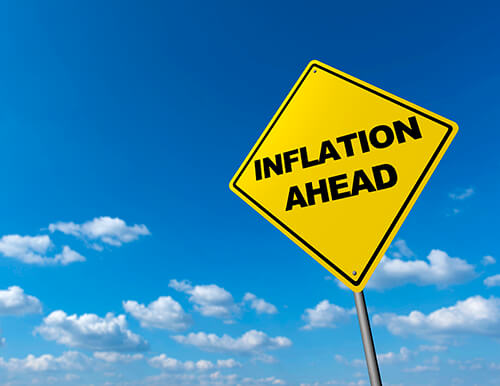
Even before it became clear that vaccines could play a prominent role in re-opening economies, asset price appreciation accelerated last year. Stocks, bonds, and the for-sale housing markets all responded quickly. The early lift-off also included specific kinds of real estate (warehouses, data centres, life science labs, self-storage, most residential). Sectors that experienced more difficulty during the pandemic (hotels, offices, and shopping centres) are much earlier in this value recovery process. Yet, the listed sector previews strong signs of recovery in these out-of-favour sectors also [as evidenced by recent stock market performance].
The inflation protection question is timely because headline measures of price changes have been trending higher across most large economies (p. 7). One reason this trend is critical is that many Central Banks set short-term rates to meet an inflation target. Through QE bond purchase programs, they also influence long-term rates. (p. 22). Yield curves currently point to modestly higher interest rates in the not-too-distant future (p. 21).
Policymakers focus on permanent, rather than transitory, increases in inflation. The recent upturn in price pressures reflects a recovery from the massive drop in economic activity during the depths of the pandemic. Prices for a wide range of goods and services are back to par, or slightly above their pre-pandemic levels in most major economies (p. 7). As shoppers return to stores (p. 17) and restaurants (p. 16), and travellers board more flights (p. 15), prices have moved up sharply from depressed levels of a year ago. Mild inflation could persist in the short term, since it takes some time for the supply side of the economy to gear up and meet the resurgent demand. Once supply chains are operating again and bottlenecks are resolved, relative movements in producer prices and consumer prices are expected to moderate over the next few years (p. 8).
Although a few inflation measures (most notably commodities) have been trending up across the globe, price trends are highly localised. For example, labour availability in major economies varies almost as widely as vaccine rollouts, degree of economic re-opening, and measures of consumer mobility (pp. 3, 18). Similarly, metro level data shows wide variations in the intensity of house price appreciation within the same country (p. 45). The diversity of inflation pressures on labour costs and housing highlights the interplay of international, national, and local forces.
For real estate investors, another consequential pocket of rising price pressures lies in the construction industry. In the US, input material costs have risen by a quarter over the last twelve months (pp. 11-12). The data points available from Europe suggest that construction costs are also beginning to increase, albeit at a more modest pace (p. 11). For real estate investors, the rising cost of borrowing also looms as a significant factor.
Real estate’s current supply-demand and financial characteristics can mitigate rising inflation. The balance of power between landlords and tenants determines whether real estate cash flows can keep up with, or exceed, inflation. The indexation of leases (particularly common in Europe) can offset some of the impact of rising prices. Triple net leases, where tenants bear the risk for higher operating costs, also offset the risk of eroding NOI. Meanwhile, shorter leases in some property types, like residential properties, allow cashflows to adjust more rapidly to rising price levels than leases that are marked to market less frequently. Rising borrowing costs are harder to avoid. Shifting to shorter duration debt creates significant savings that must be weighed against future refinancing risks and the costs of hedging.
In sum, inflation has not been a major issue for many decades. Almost no forecasters see broad-based, double-digit inflation on the horizon. True, sharply rising construction costs pose challenges for 2021 vintage development deals. But, unlike other fixed-income assets, real estate income streams typically keep up with inflation when rising prices are associated with a healthy, growing economy and real estate’s supply-side does not get too far ahead of demand.
Local issues with global impacts
Taxation is typically a national or local issue, not a global one. However, the runaway success of technology companies and, in recent years, online retailers has elevated the topic to the international arena. The pandemic has increased tech companies’ market-leading positions, as locked-down households and businesses availed themselves of on-line products and services. Many of these companies have a vast store of highly scalable intellectual capital, which can be “relocated” to whichever jurisdiction taxes it the least. Or to put it another way, when most of a business lives in “the cloud” how do you tax it?
Or to put it another way, when most of a business lives in “the cloud” how do you tax it?

In response, there has been growing support, particularly from European countries, for a so-called “digital tax”. The recent counterproposal from the US for a global minimum corporate tax rate further acknowledges that national taxation policies need to be harmonized and overhauled. Tax avoidance through “jurisdiction-shopping” can be as damaging to national economies as another tariff war.
Corporate and asset tax changes are maddeningly complex and difficult to predict. Each country employs a vast arsenal of tax instruments targeting income, capital gains, transfer taxes, user fees. Real estate, because it is readily identifiable and immovable, has long been a favorite taxation target. But, so have corporations, households, financial transactions, travel, and trade. And all countries make extensive use of “tax expenditures” (aka exemptions and loopholes). Many countries such as Ireland and Singapore use low corporate tax rates to attract investment, while others such as Hong Kong offer incentives to dissuade companies from leaving. Still others, actively market their tax haven status and offer tax advantages for individual and corporate investors.
The long term trend across all countries has been to reduce corporate tax rates. In 1980 corporate tax rates averaged 40% around the world. In 2020, the average is now 23.8%[1]. If a global minimum corporate tax is introduced, a likely repercussion is that low-tax countries might lose some of their competitive advantage. Occupier demand for office space in cities that rely heavily on tax policies to attract corporations could be negatively impacted. This comes at a time when many technology and financial services firms are likely to emerge from the pandemic with a more flexible working policy that results in a re-evaluation of office space requirements.
Yet, no nation is likely to relinquish their taxing power without a lot of vigorous debate; the law of unintended consequences is likely to apply. Some European countries could benefit from higher tax revenues paid by Amazon, Facebook and Google. Meanwhile, the Asia-Pacific triumvirate of Alibaba, JD.Com and Tencent have also caught the attention of government regulators from time to time. Both situations demonstrate a power struggle between nation states and giant technology companies. Any negative impact on office markets from tech companies downsizing their physical footprints would likely not be hugely detrimental to office districts in Europe, Canada, and Japan, where space availability is already low. In the US, vacant office space is plentiful, yet tech companies like Apple (North Carolina) and Amazon (Northern Virginia) continue to plan expansions of physical space in anticipation of a “hybrid” Work-From-Home/Creative-collaboration office model.
In sum, the COVID era has given impetus to a series of “big government” policies: Infrastructure spending, reduced Greenhouse Gas emissions, and a more equitable, healthier environment are among them. Yet, nearly all these programs come at a high cost, which taxation policies are designed to address. Many real estate investors, including LaSalle, are rapidly adopting voluntary sustainability policies, including “Net Zero Carbon” pledges, to do our part to improve the world. We believe these sustainability initiatives can often be accomplished by the private sector, without the need for huge increases in taxation—although 88 countries already have “carbon taxes” according to the World Bank and more are coming. Yet, as owners and managers of hard assets, we share the concern that the playing field is not level. Owners of IP and virtual networks often escape the scrutiny of tax authorities, in a way that is impossible for the owners of “brick and mortar”. Those days may be coming to an end.
[1] Taxfoundation.org
Opening days
The April edition of the Macro report includes more optimistic signs than many of our previous statistical summaries of the past year. Perhaps this sense of optimism is in part driven by the fact many of the contributors to this Macro report live in Chicago, where flowers are emerging after a rough winter and vaccinations will reportedly soon be available to everyone later this month. Whatever the exact factors may be, the building optimism about the expected re-opening later this summer is palpable and exhilarating.
The big question for many real estate investors remains: Will people start going to their offices and to shopping centers again when they feel safe, and will tenants renew their leases when they come due?

Before turning to the data that is changing for the better, we first acknowledge that the pandemic is not yet over and the global number of new COVID cases is on the rise again. There is a race between the spread of COVID variants and the deployment of vaccinations (believed to be closely linked to the pace of vaccine production). The coronavirus variants seem to be winning that race in many countries across Europe, the Americas, and South Asia. The variants may delay economic recovery, especially in developing countries, and hopefully suffering can be contained during that delay. Yet, the macro deck also shows that eventually most of the developed world will soon be able to move to a more normal way of life.
In many places signs of re-opening are becoming tangible. Some of the new data sources we used to measure the severity of the decline in economic activity a year ago are now tracking along a strong recovery trajectory. US air travel declined significantly a year ago. It started to recover in the summer, only to fall back as the winter surge hit, even with modest increases for holiday travel. Now air travel has climbed back to the highest levels since March of 2020. The same trends are seen in mobility (p. 13-14) and restaurant reservations (p. 12). This points to the pent-up demand ready to be unleashed as people feel safe traveling and eating out again. The recovery signals are also evident in a steepening yield curve in the US, UK, Canada and other countries where interest rates are trending higher (p. 19-20) and inflation expectations are rising (p. 21).
The big question for many real estate investors remains: Will people start going to their offices and to shopping centers again when they feel safe, and will tenants renew their leases when they come due? (see p. 26, 44-45). While Zoom dinners and concerts have been a distant second best to the real thing, the general functionality of Zoom meetings and avoiding commutes makes the outlook for office demand more uncertain.
Professional and amateur sports are also experiencing re-openings around the world. Sports revenues generate an estimated $500-$800 BN each year-equivalent to between the GDP of Sweden and the Netherlands. When the Pandemic slammed into Europe and North America in March of 2020, virtually all team sports shut down. By summer, many leagues were back to limited operation, often without fans, and even in contained “bubbles.” Places with greater COVID control, like New Zealand, had full stadiums, but most team sports were limited to domestic competition with highly restricted attendance. Major League Baseball in North America and Formula One are useful trackers of this cycle, because the start of their 2020 seasons coincided with the Pandemic—(see p. 7). The Summer Olympics will proceed in Japan, one year after originally scheduled, but in front of a much-reduced audience, as foreigner spectators will not be permitted to come. Many other international sporting events (e.g. Davis Cup, T20 Cricket World Cup, Ryder, Cup, Tour de France, Giro d’Italia, UEFA Euro 2020/1, Wimbledon) and many cultural events are planning to proceed cautiously. International travel will have to wait until projects like “CommonPass” or “Excelsior Pass”, the first digital vaccine passports, are widely embraced by airlines and, most importantly, immigration and border control ministries in each country.
Highly constrained sports venues and international travel restrictions are examples of how economic and social trends will still be far from normal in the coming summer months. They also illustrate the “long impact tail” that the pandemic is likely to have on our lives and on real estate markets.
The role of behavioral influences
As the world slowly emerges from the worst pandemic since 1918, two of the most frequent questions we hear from investors are: “Will people return to cities? What can we learn from the Asia-Pacific experience?”
Although there are significant differences in the circumstances facing employers, workers, and consumers in each country, we believe it is quite helpful to understand what is occurring in the major cities of the Asia Pacific region as a preview of what might occur in the West. Behavioral influences play a large role. The sooner people are willing to return to their offices, the lower the potential impact on investment performance. Culturally, face-to-face meetings in a formal office setting are often viewed as essential business rituals in countries like China, Japan, and South Korea. In Shanghai, where the re-opening has been the most advanced globally, office demand turned positive in the second quarter of 2020. In Singapore, office demand (net absorption) turned positive in the fourth quarter of 2020, despite the worst economic decline since 1965 and the government’s policy capping office capacity at 50%. Even in the retail sector, which was hit harder by the pandemic than other sectors, occupier demand in Shanghai was positive in 2020. Chinese consumers gradually returned to malls when the health risk largely declined in April (see page 43).
The sooner people are willing to return to their offices, the lower the potential impact on investment performance.

The behavioral approach suggests that human psychology plays an important role in the decisions we make. A rational, fact-based approach to risk assessments and decision-making does not fully explain how people react to dangerous situations and their lingering fears after the danger has passed. The Asian experience seems to demonstrate that “recency bias” can be overcome through confidence-building actions and communications taken by governments and businesses. Despite cautious optimism, uncertainty lingers in major cities like Melbourne and Tokyo (see page 7). Nevertheless, it helps that mask-wearing is fully accepted and ubiquitous across most of the region. During times of uncertainty, behavioral influences on decision making are especially important. For instance, core beliefs, cognitive biases, past experiences, or cultural differences can influence decision making, which could ultimately affect economic and investment outcomes.
We believe the pandemic is a perfect example of why the behavioral approach matters. Asia Pacific’s ability to contain the pandemic is evident in traffic congestion and mobility indices (see pages 7 and 27). Rising mobility is a sign of rising confidence that builds into a virtuous cycle, when it becomes clear that leaving home while wearing a mask and social distancing–does not cause a resurgence of COVID. The pandemic control policies followed in major Asia Pacific countries, even before vaccine rollout, have a positive correlation with the region’s economic resilience, particularly in China, South Korea, Australia, and Singapore. The return of social and economic activities and real estate demand in Asia Pacific show what the West may be able to look forward to, as rising immunity levels in Europe and North America are likely to enable the same virtuous cycle of mobility and activity.
The rollout of COVID-19 vaccines will first help restore domestic activities, particularly in countries that were not able to control the spread of the virus in 2020– a critical step to repair their economies. Ultimately, for the global economy to reach the “new normal”, most likely a significant portion of the world population will need to be vaccinated. However, for now, the reality is that international border controls are getting stricter even in countries where vaccine rollouts have been the most advanced (e.g., the United Kingdom, in part, due to new strains of COVID-19); and in parts of the world that have been the most successful in controlling COVID-19, quarantine and social distancing rules remain stringent (e.g., Australia and Singapore) to ensure the momentum of the domestic recovery continues.
Looking forward, each country has a different vaccination rollout schedule and it could take some time for immunity to rise to levels that vastly reduce the risk of getting infected (see pages 6, 50). In the meantime, the upcoming economic and real estate recovery in most countries will rely more heavily on domestic demand. The experience of Asia Pacific shows us that a return to cities is not only possible, but probable, when both the behavioral and the biological effects of the coronavirus are tamed.
And the Year of the Vax
February 12th marks the beginning of the Year of the Ox in the Lunar Calendar. In Chinese culture, Oxen are known for diligence, dependability, and determination. These are traits we will all need to rely on in the coming months while vaccine deployment proceeds at an ox-like pace. As we enter February, the depths of winter in the northern hemisphere, the pandemic shadow is once again darkening much of Europe and North America, and a weary populace may be forgiven a dream of spring.
Our analysis indicates that each region and country will follow a slightly different path to controlling COVID-19, but it is clear that the Year of the Ox will also be the Year of the Vax.

In economics, dreams like this are referred to as “rational expectations” since current views of future conditions underpin human behaviour in markets and society at large. Rational expectations theory plays an important role in understanding many macro-economic situations. How might this approach apply to the pandemic and epidemiological data? Although we are not experts in virology, we would like to share our analysis of pandemic data that points toward connections to economies and property markets.
In those nations which have borne the heaviest disease burden, uncertainties regarding the extent and durability of immunity conferred by prior exposure to COVID-19 have clouded forecasts and hence also expectations. Some insight may be drawn from a recent UK study, the first that rigorously looked at this question, which found that that having been previously infected does indeed confer strong protection. This recovered population may help to slow the spread of the disease alongside the deployment of effective vaccines. However, estimating the size of these recovered-immune populations means looking beyond official case counts, which have been biased by testing capacity that has varied considerably over time and place. On page four of this month’s Macro Deck, we examine estimates of total infections—symptomatic or not, tested or not—developed by the Institute for Health Metrics & Evaluation (IHME) at the University of Washington. Their model suggests that nearly a quarter of the population of some countries has already been infected.
Two nations which have endured a horrible pandemic experience—the U.S. and U.K.—have also played important roles in vaccine development and have secured large numbers of vaccine doses (see page five). Benefiting from an early start, they have been able to ramp up their vaccine programmes swiftly and are now immunising hundreds of thousands of people per day. Combined with a relatively large number of COVID survivors with presumed immunity, the U.S. and U.K. may well be on the way to gaining widespread population resistance to the coronavirus.
Diligence and determination also describe the successful response of the major Asia-Pacific economies to the pandemic. Meticulous traveller quarantines, testing protocols, and contact tracing systems will remain in place while the vaccine rollout begins. Some Asian governments have announced ambitious vaccination programmes that, when realised, would put them on track to be commensurate with some European and North American countries later in the year. Specifically, a new U.S. administration is putting comprehensive federal COVID-control measures in place for (effectively) the first time; plans to fund these measures are also moving rapidly. Meanwhile, the European Union has taken a stand to ensure that it gets its promised share of vaccine doses. The World Health Organization and Biden administration have also made moves to make sure economically disadvantaged countries get the vaccines they need. Remaining challenges include dealing with new variants of Covid-19, gaining a deeper understanding of immunity-through-infection, and conducting analysis of vaccination efficacy.
This will be the second consecutive Lunar New Year for which this normally bustling cross-border travel period remains constrained by the pandemic. Domestic travel in Asia is showing signs of a gradual return to near-normal, and progress has been made in the region with bilateral arrangements, sometimes known as “travel bubbles”, which are helping to facilitate some business travel. However, a return to frictionless inter-regional travel across Asia-Pacific, Africa, Europe, and the Americas will have to wait until the vaccination push is completed and its impacts are assessed.
The worst-hit countries in the West, having proven incapable or unwilling to control the virus through public health measures, may at least enjoy a hopeful future as population immunity levels rise. But ox-like strength will be needed to pull economies out of this pandemic recession. Our analysis indicates that each region and country will follow a slightly different path to controlling COVID-19, but it is clear that the Year of the Ox will also be the Year of the Vax.
And a look forward to 2021
Historians have plenty of material now to try to put the events of 2020 into perspective. Even without a global pandemic to contend with, the past year of shared calamity included political upheaval, wildfires, climate risk, social unrest, disputed elections, as well as trade relationships broken and re-formed.
The 2020 time warp created vast differences in the pace of national economic rebounds.

Yet, the year will only make sense when it is placed alongside whatever happens next in 2021 and 2022. Telling the 2020 story without the next two years would be like stopping at episode 5 of a ten-part mini-series. In our Macro Indicator monthly reports in 2020, we found ourselves returning to the theme of the time-bending effects of the pandemic, touching on everything from our daily routines, to financial markets, and to the accelerating pace of change in tenant preferences and demand for different types of real estate. The shocking events at the U.S. Capitol on January 6th add to this unsettling sense that time simultaneously stands still and races ahead when so much history occurs in a compressed period.
Financial and capital market valuations are the ultimate time distortion field, distilling all expectations about the present, near-term and long-term future cash flows into a “spot price.” Early in the pandemic, global financial markets focused overwhelmingly on the negative short-term economic fallout of COVID lockdowns – with global equities registering a -30.1% YTD decline as of March 23rd. Then, in a record-breaking turnaround, the world’s largest “continuous auction” stock markets looked beyond the short-term abyss to a brighter, long-term outlook underpinned by central bank support, fiscal stimulus, a healthy digital economy, and high expectations for vaccine rollout.
The 2020 time warp created vast differences in the pace of national economic rebounds. Most of Asia Pacific cautiously and carefully re-opened stores, offices, and public places in the weeks and months that followed the end of the Wuhan lockdown on April 8th. In the West, the process of closures and re-openings were more sporadic, inconsistently enforced, and adherence was haphazard. And now, large parts of Europe and North America are going back in time, with countries accounting for 15% of global GDP back under strict lockdown at year-end (see page 10 of this month’s deck).
Our January Macro Indicators deck provides a summary of relative real estate performance in 2020 and an update on the pandemic, vaccine, and financial market indicators likely to drive real estate demand and pricing in 2021. The tug of war between long- and short-term drivers is itself driven by expectations for permanent vs. temporary pandemic impacts. These expectations will drive movements in the yields, prices, and indices we track each month. These macro themes are also the focus of the 2021 edition of the Investment Strategy Annual (ISA).
We highlight five key ISA themes for real estate investment in this Macro Indicators deck:
- Expect the dispersion of sector returns to continue
- Invest in the rise of alternatives
- Anticipate changing mobility and density preferences
- Differentiate and separate permanent changes from temporary shifts
- Balance three styles: growth, income, and dislocation
Political shades around the world
Followers of both US and UK politics are accustomed to studying maps coloured in with either red or blue. While Europeans may find it odd that Americans use red to indicate states won by the party on the right—the rest of the world generally associates that colour with socialism—the use of only two hues suggests a kind of satisfying, binary conclusiveness. And in the context of a major global resurgence of COVID-19, many people undoubtedly look forward to closure on something, not least the seemingly never-ending US presidential campaign or the endless UK/EU trade negotiations. However, in this topsy-turvy year, a well-defined outcome for either is far from guaranteed. In the case of both the US election and Brexit, there is a likelihood that we must cope with an unclear result and extended uncertainty; in other words, with shades of grey.
We cannot predict the outturn of either the US election or the EU trade negotiations with any great certainty. Our strongest conviction: All this uncertainty is likely going to take time to sort out.

In prior decks, we have shown how election results have only a modest impact on real estate markets. However, there is evidence that extended economic or policy uncertainty does seem to play a role. And with Trump and Johnson at the reins, uncertainty is not in short supply. Let’s take each of these events in turn.
Neither the opinion polls nor the betting spreads have covered themselves in glory these past years. Nonetheless, both place Biden comfortably ahead with just a few days to go before the US election. The electoral college and the disinformation campaign surrounding postal votes suggest that the result of the election could be closer than implied by polls, almost certainly leading to a legal challenge from the loser. A contested election in the US could become a concern to private equity real estate assets if the uncertainty becomes entrenched. This concern cannot be ruled out if resolution through the courts takes several months. In normal times, this could be a survivable period for real estate; but as it will coincide with the twin threats of a COVID-19 resurgence and a stalled recovery, this uncertainty has the potential to dislodge tenants and deter investors during Q1 2021.
Meanwhile in the UK, the preferred deadline for UK/EU trade negotiations was in October; the practical deadline is sometime in November. Sensing the public’s desire for clarity, “Get Brexit Done” became the slogan of Boris Johnson’s December 2019 winning election campaign. The Brexit saga returned to the fore during 2020’s summer months as negotiations with the EU stalled. We have long argued that the short-term negative impact of a No Deal Brexit will be relatively muted, particularly when compared to the havoc wreaked by COVID-19. However, not all possible no-deal Brexits are created equal; Capital Economics[1] has argued that an “uncooperative no deal,” where talks break down in an environment of animosity, would be more damaging in the long run because it would lead to fewer agreements in the future and the expiry of temporary measures.
Moreover, uncertainty surrounding Brexit has clearly influenced the occupier and investment markets since the 2016 EU referendum. As it stands, UK real estate would most likely feel the effects of continued uncertainty to the end of 2020 or indeed beyond into 2021 should we see a short-term extension or bare-bones deal. As with the US, this Brexit-related uncertainty in the UK comes at a time when the country is struggling to get another wave of COVID-19 under control. There are many possible paths which the UK/EU relationship could take, and we may not see the full repercussions for several years to come.
The US and Europe are not alone in facing political transitions during the pandemic. Japanese Prime Minister Shinzo Abe was forced to step down in August due to health problems. At least his successor, former right-hand man Yoshihide Suga, was selected quickly and represents policy continuity. But the fizzling of Hong Kong’s pro-independence protests amid social-distancing regulations seems to come with a less definitive conclusion to the tensions there. The passage of the National Security Law comes with promises that it does not represent an end to “one country, two systems”—an outcome we believe requires appreciation for shades of grey.
Uncertainty in and of itself need not be negative for real estate. If it manifests in lower bond yields, then recent years have shown us that an income-producing asset class such as real estate could be a net beneficiary. Moreover, opportunistic investors may look to take advantage of weak currencies and cheap leverage, whilst long-term investors may move to secure prized assets at a discount. But there is nevertheless cause for caution. The UK and US are led by populist leaders who are failing to come to grips with the pandemic. They are both among the largest, most liquid, and transparent real estate markets in the world, top destinations for cross-border investment, and arguably the worst hit by the structural changes ongoing in the retail sector. We cannot predict the outturn of either the US election or the EU trade negotiations with any great certainty. Our strongest conviction: All this uncertainty is likely going to take time to sort out.
[1] “Brexit: Deal or no deal is not the big issue” Capital Economics 1 October, 2020
If the levels of stock prices are any indication, global COVID-19 worries may be behind us.
Many of the world’s largest stock indices, including the NASDAQ, the S&P 500, the Nikkei, the Dax 30 and the Shanghai Stock Exchange Composite, have all recovered most of their COVID-19 losses or even topped their pre-pandemic levels. Traditional wisdom has it that share prices are one of the best predictors of the future. Hence, a rising stock market might reflect that everything is under control, and the economic crisis is drawing to a close. (p.5 of the macro deck)
In sum, real estate may be the caboose on a recovery train that has not yet left the station.

Yet, the gulf between the real world and the global capital markets is wide. Moreover, there is another bit of wisdom we have quoted in the past: “The stock market has predicted 9 out of the last 5 recessions” (Attributed to Nobel Laureate, Paul Samuelson). Maybe the odds are the same on the way up as on the way down. While the unprecedented liquidity injections by Central Banks have helped stabilize the global capital markets, the economic wounds from the COVID-19 pandemic have not fully healed. (pp. 8-9) According to the World Bank, the global economy is expected to shrink by 5.2% in 2020 – the worst recession since World War II. The disruption of economic activities due to shutdown measures has severely impacted corporate and municipal financial health (pp. 11-12). As a result, solvency risks have increased, and liquidity alone cannot solve a solvency issue. Companies cannot survive on subsidies and low-cost debt forever; eventually they need more revenue.
In the face of revenue uncertainty, many companies are expected to cut labor costs to shore up their earnings outlook. This trend is evidenced by the growing number of redundancy announcements, especially in industries that focus on retail trade and services. The pressure on companies’ financial health is expected to increase as the emergency measures (e.g., wage subsidies, deferred loan payments, stimulus spending) taper off next year in many countries. This weakened business outlook is expected to drag on households’ forward view for employment and income, which could further reduce consumption. Any potential COVID-19 resurgence and growing geopolitical tensions around the world also could further cloud the recovery.
So, with all this seemingly bleak news, what is the stock market trying to tell property investors? There are at least six options to consider:
- The worst may be over. Vaccine and treatment trials today could result in record-breaking production and inoculation that may tame COVID as quickly as it burst on the scene.
- Headcount reductions today could slingshot into higher earnings growth next year during the coming economic recovery.
- When you peel back many stock indices, most of the uplift seems to be concentrated in a few sectors or stocks; the pandemic may have created a few big winners and many losers. This pattern is found in the US REIT universe also. (pp. 26-27)
- There is an excess of capital available in the capital markets. It needs to find a home, and stocks are generally an easy place to park cash. Private equity may need a longer runway to take off and a longer glide path to land. (p.3)
- Interest rates could stay low for much, much longer. More than any specific recovery scenario, these low rates could be raising asset prices. (pp. 17-18)
- The stock market signal could be a “false dawn” and might evaporate if a second wave of COVID 19 hits in the months ahead. (p.4)
For real estate investors, as weaker economic conditions filter through to occupier demand, the net operating income (e.g., rents and occupancy) for real estate could deteriorate further before we get an actual sunrise. It usually takes about six months for macroeconomic trends to filter through to real estate fundamentals. The wait for a property market recovery could be elongated by the expiration of various fiscal stimulus packages sometime next year.
In sum, real estate may be the caboose on a recovery train that has not yet left the station. While waiting to catch the early train, investors may seek to trade out of asset types that are a drag on future performance while reserving seats in the head cars where the ride could be smoother. To mix a metaphor, investors should beware of the “false dawn”, as it is premature to declare that COVID is under full control just yet. Yet, the sun will rise again someday, and so investors should be well-positioned to catch the early train, even if it means standing in the dark at the station.
Not back to normal
The start of September marks the “Back to School” season in much of the Northern Hemisphere, and as with nearly everything in 2020, education has been impacted by the Coronavirus Pandemic. Getting Back to School reflects the same safety and social distancing challenges as getting back to offices, back to shopping, back to travel, back to socializing, and basically back to “life as we knew it”. As school, work, shopping, and travel all adapt to social distancing requirements, the buildings that enable these activities are also affected. Real estate investors need to identify the winners and avoid the losers as they price assets, determine strategies, and manage through this uncertain period.
As long as COVID remains a major health risk factor, a return to pre-COVID patterns of real estate leasing and operations will be in our estimation, partial at best.

As long as COVID remains a major health risk factor, a return to pre-COVID patterns of real estate leasing and operations will be in our estimation, partial at best. Just as parents and teachers worry if school is safe, firms and workers wonder if their office is safe, shoppers worry if a store is safe, and travelers worry if planes, mass transit, dining, or lodging are safe. As this situation persists, more data becomes available on safety and risk factors, and we gradually gain clarity on the economic winners and losers in this pre-vaccine stage of the pandemic. This data often raises additional questions about what happens when COVID-19 is under control and when can we get back to the next normal? The performance of private and listed real estate investments will be driven by this still-unknown future. Just as 2020 is more different than anyone could have predicted in 2019, the next 12 months could also provide a range of surprises.
This macro deck contains a wealth of content about the state of the world today. Admittedly, readers won’t see nearly so much about the future. We know that the level of virus containment (pp. 6,36,43) correlates with mobility and spending (p. 9-12,42). Longer-term, the question is: “Will the economy rebound when the virus is contained, or will the scars of the Pandemic persist?” Low interest rates appear to be the norm around the world today (p. 18-20), but will that persist as life returns to normal, especially in markets like the US, UK, Continental Europe and Japan that have experienced sharp interest rate declines during the Pandemic? Fiscal and monetary stimulus continue (p. 17), but what will be the impact of unwinding this liquidity, and how will governments pay back what was borrowed? The REIT market points to the variety of impacts across sectors (p. 26,27), with investors making calls on long-term challenges for sectors like retail and lodging, and long-term gains for data centers and cell tower REITs. Will these short-term price movements be proven right or wrong? Low interest rates and a desire for more space is boosting demand for suburban housing in many countries, but will this boost in demand be sustained? The pandemic raises more questions than answers, yet we believe investment managers will need to take a view on all of these issues.
In keeping with the “Back to School” theme, we share some data on the re-opening status of schools and universities (p. 4,8). The impact of a University operating remotely for a semester or school year can be significant on the local businesses and the real estate that depend on student spending. One assumption underlying pre-COVID investment strategies was the stability of “Eds and Meds”. We believe this Pandemic is threatening the stability of the education or “Eds” sectors, while providing a boost for some of the “Meds.” The return of economies to normalcy and productivity also depends on primary schools being able to safely educate children in classrooms. The long-term questions for education are similar to the big questions for offices: When is it safe again? What will be the lasting changes from this period of working and learning virtually?
While negative shocks rightfully grab the headlines, we have spotted sectors like laptop computers, home improvement stores (p. 7), data storage, and suburban single-family home rentals, all of which are experiencing booming demand. Based on rising stock markets around the world (p. 3), equity investors appear to be taking the long view that aggregate demand will recover in the not-too-distant future. Recent news, perhaps, provides some reasons to be optimistic regarding the development of vaccines and treatments. While today we as parents, workers, consumers, and travelers struggle with the safety of getting back to “life as we knew it”, as real estate investors, we are optimistic that long-term investment performance will be driven more by pre-COVID patterns of business and household consumption than by this historic, but hopefully brief, period of time. Our research projects, previewed in the Mid-Year ISA, continue to focus on what that future world will look like.
Lessons from diseases of the past
Over the centuries, epidemics have impacted the way people interact with each other as well as the built environment. The 1854 map of London by John Snow helped identify sources of cholera and led to changes in how the water and waste systems of London were designed. The Haussmann plan for Paris, Olmsted’s Central Park in New York City, and the Shanghai Customs Harbour Quarantine Station were all 19th Century responses to infectious diseases. Even further back, British historian Mark Bailey explains that the sharp reduction in the labour force after the Black Death in the 1350s boosted survivors’ wage bargaining power and disposable incomes. These income gains were then spent on better quality ale and food in public houses[1], giving rise to the pub culture. Given pubs’ ubiquitous role in British life, this change has been consequential both culturally and from a real estate perspective. Even as hundreds of public houses across the UK begin to reopen in the summer of 2020, all are operating under severe capacity restrictions. With modern airline travel and intercontinental mobility, the world has graduated from epidemics to pandemics. The sobering result: the bars and pubs along Clarke Quay in Singapore, Lan Kwai Fong in Hong Kong, and Rush Street in Chicago are in a similar state of partial or complete closure.
Over the centuries, epidemics have impacted the way people interact with each other as well as the built environment.

From where we stand today, thinking about a post-COVID world may seem premature. Both the resurgence of infection rates in the US (pg. 6), as well as localised second-order shutdowns in places as far from each other as Barcelona, Dallas, or Melbourne exemplify the fluidity of the phases of the pandemic. Nonetheless, we do believe a “COVID under Control” phase will eventually arrive, as cautiously optimistic news on treatments and a potential vaccine revealed during July (pg. 22).
Once an effective vaccine is available, sorting out permanent versus temporary changes in culture or behaviour will take time. Interested readers should refer to Chapter 3 of the 2020 ISA Mid-Year Update as it delves into what the future of real estate sectors might look like post-pandemic, as well as the connections to other global threats such as climate change.
The second quarter data for the real economy paints a disturbing picture in most countries. Despite massive government support in parts of the world, the destruction of jobs brought on by this pandemic has undone a decade’s worth of unemployment decline in the OECD countries (pg. 3). Traditional sources of data take time to assemble, and by the time they are published they tend to reflect information that is already several months old. So, turning to high-frequency activity data helps paint a timely picture of economic activity. For instance, travel to workplaces and retail locations continue to rise; restaurant reservations (pg. 9) and airplane travel also seem to be trending modestly upwards in July (pg. 8), even as Q2 GDP are reported showing historic declines.
Real estate valuation data is also impacted from lags and timing issues. For instance, the latest available valuation-based indices reflect data only up to the end of Q1 in many countries. Few properties have been changing hands (pg. 25), providing less comparable transactions. Thus, it will take some time for new information to be incorporated into the wider index. Real estate trusts and companies traded on listed exchanges uncover important insights for private equity and real estate debt. Through real-time trading and pricing, these securities swiftly reflect changes in the underlying health of occupier markets and risk premia required to hold real estate assets. Global REIT valuations swung from trading at a healthy premium to private market valuations pre-pandemic to now trading at a discount (pg. 26). While this discount has narrowed over recent months, the pricing gap is wider than in recent decades. Given the importance of transactional evidence to private market valuations in times of high uncertainty, we believe this dislocation between public/private markets is likely to persist for some time. The disconnect opens a window for investors to exploit this discrepancy between public and private market pricing.
Public markets can give us a steer as to how investors are assessing the relative risks and opportunities across sectors. The sector hierarchy in REIT pricing broadly coincides with the uncertainty around each sector’s prospects alluded to in Chapter 3 of the Mid-year ISA. Retail and office REITs are trading at wider discount than they have typically done, and industrials and residential REITs are trading at a healthy premium (pg. 27).
We would love to exchange views with you on the future post-COVID world. You can send us an email to this address:Research@lasalle.com
[1] “How the Black Death Gave Rise to British Pub Culture” https://go.lasalle.com/e/579181/rticles-what-is-the-oldest-pub/
An unexpected way for a cycle to end
For the last three years, at LaSalle’s client seminars, we would try to envision the way that the current cycle might end. In the case of Australia, China and South Korea, this was a real stretch of the imagination, since the economic expansions in these countries were all longer than 25 years. In the US and Canada, as well as in much of Western Europe, an uninterrupted growth cycle lasted ten years, dating back to the Global Financial Crisis (GFC). A few European countries (Poland and Slovakia) survived the GFC without going into a recession at all, while other G-20 countries (including Japan, France, Italy and Spain) flirted with mild recessions several times over the last ten years. Nevertheless, our collective experiences through previous cycles in the prior 30 years conditioned us to be looking for the signs of the next downturn.
We came up with a series of fairy tale metaphors: The three bears who ended the Goldilocks slumber party and The Boy Who Cried Wolf. Grizzly Bears stood for geo-political crises. Polar Bears represented too-tight central bank policies. Honey Bears represented over-reliance on fiscal stimulus and unsustainable deficits. The shepherd boy in the “wolf” story reminded us that eventually a wolf shows up–you and your flock need to be prepared. Although these stories were amusing, the topic was serious. All expansions throughout human history eventually come to an end and investors need to be prepared. The economist Josef Schumpeter coined the phrase “creative destruction” to remind us that downturns also play a cleansing role that leaves an economy well-positioned for the next expansion. We firmly believe that this could happen with the COVID-19 crisis.
Now, in the year 2020, we have a live example of an unexpected and severe threat to human life, prosperity, and investment portfolios. When our offices shut and business travel halted, we all had a mass education in how pandemics work. Many of us have become daily consumers of COVID-19 case and mortality data. As real estate investment managers, our jobs have quickly pivoted. We must figure out the appropriate actions to take to defend the income-generating power of the properties we invest in. At the same time, we also have the fiduciary responsibility to look around the corner and to develop plans to go back on offense in the second half of 2020 or in 2021 on behalf of the clients whose assets we are entrusted with.
We have already begun this forward-looking task for the Mid-Year update to LaSalle’s ISA. This is not easy. It took noted economic historian Adam Tooze eight years to research and write Crashed, which documented “The First Crisis of a Global Age” – the 2008-2009 financial crisis. Now, just two years after Tooze’s book was published, we have the second crisis of the global age to contend with. Using the Tooze timeline, it could take until 2028 for academics to figure out exactly what COVID-19 means for the global economy. In the meantime, it is our intention to get started now, which is exactly what you will find in our mid-Year update.
We hope that readers will find our look into the future of retail, office and logistics properties to be helpful as we recalibrate what to expect from real estate portfolios in the years ahead. We welcome and encourage your responses and comments on our analysis.
Download the report
How will real estate respond?
June marks the transition from spring to summer in the Northern Hemisphere and fall to winter in the Southern Hemisphere. The changing seasons help mark the passage of time when many familiar routines have been disrupted by the pandemic. These inconveniences pale in comparison to those who have paid a much higher price – in lost lives, lost livelihoods and separations from friends and family. Never in the post-war history of the modern world have so many endured so many months filled with such uncertainty and trepidation as the first two quarters of 2020. So, the gradual re-opening of economies and the coming of the Northern Hemisphere summer should represent a huge relief.
The degree of containment success during Phase Two of the pandemic will have impacts on real estate performance.

Yet, the second phase of the pandemic has the defining characteristic that we still must live with COVID-19. While some countries, led by China, South Korea and Germany, are already several weeks into re-opening, others are just starting. The concern among some epidemiologists is that certain jurisdictions may be re-opening segments of their economy before tracing and testing is fully in place. The total number of COVID-19 cases is still rising in many countries, even though the rate of growth has tapered. Recurring infection spikes could force countries to lock down segments of their economy again. Successful re-opening will depend, in part, on how well each country follows prescribed social distancing and safety measures, as well as whether their healthcare system has the capacity to handle a second wave.
The degree of containment success during Phase Two of the pandemic will have impacts on real estate performance. The speed of retail sales recovery at brick-and-mortar stores is uncertain, but this month’s deck shows how we can track rising mobility and footfall at properties as re-opening gets underway. Closure of physical stores led to double-digit and in some cases triple-digit ecommerce sales increases. Some of this shift could be permanent, especially for stores that cannot easily adapt to social distancing or run profitably at highly controlled density levels. On the other hand, retailers that can more easily adapt to click-and-collect models, are already seeing sales recover. Office workers are expected to face a different world when re-opening occurs, including physical distancing for everything from elevators and washrooms to floor plan layouts. In May, some prominent tech office users, including Twitter and Facebook, announced that their employees will be able to work from home for the remainder of 2020, or in some cases, permanently. This has the potential to significantly reduce aggregate office demand if other firms follow suit. On the other hand, other office users may require more space to enable social distancing. The tug of war between these two forces will play out differently for each tenant; but we will be watching aggregate patterns that will determine what happens to overall office demand.
These are issues investors must take a view on, long before the answers are known. To help guide our colleagues and clients, in this month’s deck we examine:
- A comparison of the TomTom Traffic Index congestion levels for two cities at different phases of re opening: Shanghai and Toronto (slide 4)
- A status update of different countries in terms of re-opening and transitioning to Phase Two (slide 6)
- Revised GDP forecasts from Oxford Economics, which now surpass IMF forecasts from April in terms of degree of decline in 2020 and a sharper recovery in 2021. Global growth of -4.8% in 2020 is forecast, while several countries’ 2020 forecasts have declined by three to seven percentage points compared to Oxford’s forecasts in March and April. (slide 8)
- A forecast decline in global trade which is expected to surpass the sharp decline seen in the 2008-09 downturn (slide 9)
- The latest monthly readings of CPI Inflation moved negative in Canada, Sweden, Spain, Switzerland and Ireland, and has plunged in other countries as consumer prices fall amid the pandemic (slide 15)
- In May, the U.K. joined Japan, Germany and other European countries in selling negative yielding debt, reflecting the investor view that paying a modest amount to own bonds is safer than other investments in the midst of a global recession. It also indicates how central banks are using their QE powers to keep bond rates low or slightly negative. (slide 27)
Senior European Strategist Petra Blazkova discusses how the Covid-induced economic contraction – the steepest in living memory – will affect global economies.
But a long journey lies ahead before this disease is contained.
Four months after the first diagnosis of the deadly COVID-19 virus, the headlines and images of its devastating effects are wearing on us all. A long journey lies ahead before this disease is contained. Yet, plans to develop effective treatments and vaccines are moving into high gear. As April turns to May, it is fitting that we look ahead to the second phase of the crisis, when partial and cautious re-opening of economies gets underway. Images of Chinese Peach Blossoms and a German Maibaum (maypole) symbolize a welcome change as LaSalle gradually re-opens offices in China, in Korea, and in Germany. Other countries will follow, but we can learn a great deal from the experiences of the cities that come back online first.
The pandemic demonstrated the ability of some countries to take drastic action when risks to public health become urgent and pressing. And it also showed the inability of others to respond as quickly and effectively.

This month’s macro deck lays out the three phases of this journey: 1) The Lockdown; 2) Partial Re-opening, or “Living with COVID”; and 3) The New Normal, when the virus is under control. It also charts the first leg of the journey and how real estate is reacting with a shorter lag time than is usually the case for the transmission of macro-economic forces into property’s financial performance. Highlights of the deck are as follows:
The steepest economic contraction in living memory: The International Monetary Fund (IMF) cut its 2020 global GDP growth forecast to negative 3% in 2020, before projecting a return to growth in 2021. These forecasts are the most severe re-rating of country-level, regional, and global GDP in the history of the IMF. The International Labour Organization estimates in April that nearly 1.25 billion people globally are at risk of being unemployed or furloughed. The collapse of oil prices is another indicator of the severity of the downturn.
Government policy responses: The amount of fiscal stimulus planned across the US and Europe exceeds that of the GFC. More fiscal stimulus is expected, given that countries accounting for half of the world’s GDP are in some form of lockdown. We believe the pandemic will leave developed nations deep in debt and force hard choices. For instance, Italy’s national debt is approaching unsustainable levels, putting pressure on the European Union to arrange a bailout. Some countries may try to carry enormous quantities of debt with a combination of higher taxes and inflation.
China’s response offers lessons for investors and occupiers: The COVID-19 outbreak has had a severe short-term impact on the Chinese economy and property market. However, headline indicators of business activity largely returned to pre-outbreak levels by the end of April. The Chinese government’s “coordinated approach” appears to have shielded the economy from a deep and prolonged downturn, while a range of measures introduced by owners and tenants have provided a foundation for a gradual property market revival.
Logistics as a net beneficiary in the long-run: Migration to online retail and fast-forwarded consolidation in the retail world accelerates demand in the logistics sector. Supply chain diversification has become a priority, and re-shoring of some manufacturing may start to happen in Europe and North America.
Pricing disconnect: Going into the crisis, investment activity in Europe and the US was holding up well in Q1 2020 compared to the same period one year ago. By contrast, investment activity in Asia Pacific dropped by 58% in Q1, as the lockdown affected the completion of transactions. This same interruption in transaction volume has now hit the West, even as it begins to ease in East Asia.
Public health response: In our view the pandemic demonstrated the ability of some countries to take drastic action when risks to public health become urgent and pressing. And it also showed the inability of others to respond as quickly and effectively. We believe these responses likely presage the willingness and ability of countries to engage in the collective action needed to address future challenges including a second wave of infections, global warming, a move to a carbon neutral society, and climate risk.
In the 27th edition of the Investment Strategy Annual, we address the themes that will shape the real estate investment environment for at least the next three years and likely longer.
The pandemic has simultaneously accelerated and interrupted these trends. Some assets and strategies amplify the effects of COVID-19, while others are much more insulated. In the coming year, investors should prepare for the COVID endgame.
Mastering the simultaneous need for fast/intuitive and slow/careful thinking becomes an important skill to develop in the speeding-up world of real estate. We review techniques to help investors determine portfolio objectives. We present our outlook for the property types and countries that are the most attractive. We share our best investment ideas.
Speeding up and slowing down all at once
Time has simultaneously sped up and slowed down in a surreal way as we all work from home. Economic forecasts issued last week are now woefully out of date. A recurring comment we hear: “Just three or four weeks ago, this would have been unimaginable.” Where “this” applies to COVID case counts, unemployment claims, counting the number of tenants NOT paying rent, or fiscal packages and central bank backstops worth 10% or more of a country’s GDP.
As far as the timing and duration of this downturn, there is still so much we do not know.

A new challenge is getting access to reliable data and forecasts. The digital transformation of our industry, currently well underway, should help us figure out what is going on. But it may not be as helpful in telling us where we will be a year or two from now. Sorting fact from fiction and spin is also getting harder. The public markets illustrate the spasms of fear and relief that wash through portfolios on a daily basis. In the words of author Max Brooks, “Panic can spread even faster than a virus.” Brooks teaches at West Point (The Modern War Institute) and is a consultant to government agencies and NGOs on disaster preparedness around the world. He says, “During any pandemic, we must practice excellent fact hygiene.” In that spirit, this month’s macro deck highlights both facts and fact-based opinions, but we are careful to distinguish between the two.
A sharp global recession is underway. Half of the world’s GDP is now under some kind of “stay at home” directive. As a result, the major economies of the world are undergoing a near-simultaneous demand-side shock, with supply-side and financial shocks also underway. Consumers and businesses have stopped spending on non-essential items. Transportation, leisure and construction have come to a standstill unprecedented in peacetime. Manufacturing was among the first industrial sectors hit as factories closed, but with robotics now prevalent and China getting back to work, interrupted supply chains may be able to get repaired. Goods and containers can move across borders, even if people cannot. By contrast, the services sector – especially hospitality and retail services – has been hit especially hard and is still in the early stages of coping with a demand shock that is existential for many small and large businesses.
The financial system is also now under enormous stress—both credit and equity flows. Unprecedented policy responses by governments will try to reduce the ripple effects. Monetary and fiscal actions of historic proportions are being rolled out. Ultimately, credit creation relies on trust, not governments alone. And trust is in short supply right now. Despite historic efforts, credit markets are tightening and investors have become excessively risk averse. Lenders now have record-low base rates provided by Central Banks; but borrowers may not get access to incredibly cheap debt, as spreads widen out. In short, we expect huge differences among property types and markets in terms of risk, resilience and liquidity to manifest themselves.
We first circulated a list of property types at risk six weeks ago, when it became clear that this coronavirus was jumping across borders. The ranking is based on REIT data and feedback from our portfolio and asset managers. (p.9) These lists are intended to give colleagues and clients a sense of where to expect trouble. A contrarian investor may be able to take advantage of overly pessimistic reactions to such lists in the years ahead. But, for now, these are also the sectors that are most likely to experience interrupted income streams and borrower defaults. The “best-insulated sectors” will not be immune and all property types will feel the impact of global recession.
As far as the timing and duration of this downturn, there is still so much we do not know. We do not know exactly what it will take to contain an outbreak, especially where containment measures were delayed or when testing has not been widely available. So, none of us knows exactly when “return to work” policies will be promulgated in each country or metropolitan area — although China is leading the way and could provide the world with an example to follow. We still need to find out what, if any, re-infection risk is associated with “return to work” and how quickly risk-taking, investment, trade and travel will resume to the point where the financial system can recover and function without government support. Underpinning our scenarios are multiple assumptions about when effective vaccines, treatment and testing will be widely available (p. 3 & 7). These “unknowables” lie at the heart of our assumptions and plans. Finally, we may all need to learn the skill of “time bending” to cope with the fast and slow pace of social and economic life in the months ahead.
The COVID-19 epidemic has grown more severe by several orders of magnitude over the past month.
With more than 84,000 cases globally[1] ,it is now ten times larger than the SARS epidemic and has spread beyond China to more than 50 other countries. New cases have declined in recent days within China, but they have accelerated across the rest of the world. As the Chinese government and international health organizations on the front line have made clear, this global healthcare crisis is still growing, and the risks of underreacting are greater than the risks of overreacting.
The swift actions of courageous health care providers and the everyday sacrifices of people across Asia have helped to buy time for the rest of the world to be better prepared for the arrival of COVID-19 in their own countries.
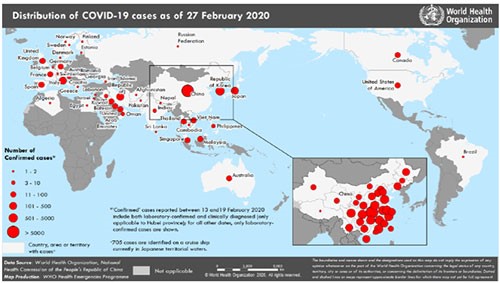
In the highly interconnected society and economy of 2020, postponed travel, working from home rather than the office, and canceled in-person meetings and conferences are a small price for reducing the risk of a life-threatening, and still not fully understood, illness. For many across the Asia-Pacific region, the burden of containment has gone far beyond these inconveniences. Millions of households are experiencing economic hardship, coping with family separation, and enduring restricted freedom of movement in their own communities – all this before the toll of human suffering from the disease itself is taken into account. The swift actions of courageous health care providers and the everyday sacrifices of people across Asia have helped to buy time for the rest of the world to be better prepared for the arrival of COVID-19 in their own countries.
Economic impacts seem like a secondary concern at a time like this, but they are highly relevant for government leaders, policy makers, and investors who must first get through “crisis management” and then begin to make plans for the future. In China, which is now gradually loosening the largest quarantine in human history, the crisis is a simultaneous demand and supply-side shock. Several forecasters put a high likelihood on Chinese GDP contracting in year-over-year terms in the first quarter. At the same time, the Chinese government has already unleashed stimulus packages intended to help get business going again and to keep the financial system operating smoothly – and more stimulus announcements are expected. The governments of Singapore, Hong Kong and South Korea have recently announced their own stimulus packages, and other counties in Asia are likely to do the same.
This month’s macro deck summarizes the impact of the COVID-19 epidemic on global economic forecasts and on financial market prices. Beyond temporarily lost output, interrupted supply chains, a sharp decline in travel and tourism, and declining consumer confidence, the ripple effects have just begun spreading from Asia to Europe and North America. Property investments in China have seen direct impacts in the form of halted work at construction sites and retail rent moratoriums. Similar effects are likely in other intensely affected markets from South Korea to Northern Italy. Yet this is also a time when the durability of real estate income streams is likely to distinguish property as a stabilizer relative to other asset classes, as most leases are likely to generate income despite these temporary shocks.
The COVID-19 crisis is evolving daily. Although the first case was diagnosed on the last day of 2019, the impact will be felt far beyond the first quarter of 2020. The tumultuous end of February 2020 will go down in economic history as the week when the financial markets finally woke up to the warnings of the World Health Organization. Risk assets like stocks and high-yield bonds have entered “correction” territory in many countries. As we have pointed out before, fear tends to be self-reinforcing in economic decision making as people adjust consumption and investment decisions and perceptions quickly become realty. It is unknown how quickly the virus will be contained worldwide. Likewise, the longer-term impact on economic growth and real estate markets is highly uncertain. LaSalle’s investment teams expect to address the concerns of our tenants and clients through rapid-response communications and business-continuity plans; these actions have already commenced across our China portfolios. Real estate investors can draw some comfort from the insulating effect of real estate’s long-term contractual income and from the heavier weight of capital seeking stabilized income-generating assets as risk-free interest rates fall to all-time lows in several markets.
[1] See the World Health Organization website for continual updates: https://go.lasalle.com/e/579181/2020-02-29/vdxnmf/898126978?h=iIsAuG6NtoLc1mNbzDxqAasaTIIcyr1uQQt-Jkmi-n8
Thoughts on the Lunar New Year
The Lunar New Year ushers in the year of the “Metal Rat”, which combines the first animal (Rat) and the fourth element (Metal) of the Chinese astrological calendar. Together, they symbolize careful planning, wealth and vitality. Since the Rat is the first sign in the 12-animal cycle, 2020 represents a year of new beginnings. Just as investors were waving goodbye to a year of tremendous geo-political volatility and celebrating the 2019 rallies in the stock and bond markets, another exogenous shock has occurred—Novel Coronavirus. Since the first few cases were detected in Wuhan, China in December, more than 200 people have died and more than 10,000 are fighting the symptoms1. Thus far, the estimated fatality rate of Novel Coronavirus has been lower than that of SARS in 2002-03, but new cases have been spreading at a faster rate and have been detected in over 20 countries.
The outbreak of Novel Coronavirus reminds us how extraordinarily connected the world has become. It also highlights the importance of the Chinese economy on the world stage.

The outbreak of Novel Coronavirus reminds us how extraordinarily connected the world has become. It also highlights the importance of the Chinese economy on the world stage. China now accounts for approximately 20% of the world GDP, up from 7% twenty years ago (in PPP terms). Looking back, the SARS outbreak lasted six to eight months. The impact of SARS on global financial markets was negative in April 2003, yet within six months of the outbreak stock markets had more than made up their losses. The impact on retail sales and hotel occupancies varied across Asia Pacific, but generally recovered 3-6 months after the WHO announced that the virus was contained. Also, the impact on travel was much less severe in Europe and the Americas.
Nevertheless, the economic impact of the coronavirus outbreak poses another downside risk to China’s growth this year, when forecasters expected world growth to slow to its lowest level since 2009. It is far too early to say with any certainty whether the coronavirus will be a trigger for a downside scenario beyond the natural slowing growth rate of the global economy. The probability of a global recession has been reduced as populism de-escalates, or is contained, in various parts of the world – the signing of the U.S.-China Phase One deal, the reduction of tensions in the Middle East, and finally, the European Parliament’s blessing of the Brexit deal. On the other hand, these geo-political risks are not off the table permanently; to some extent, they are just beginning.
As long-term interest rates stay at historically low levels, real estate continues to attract investor capital. In particular, demand for core real estate is strong amid “risk-off” behavior and a flight to safety. Logistics and multifamily continue to be the darlings among core investors. Additionally, demand for value-add offices remain strong. Office rent growth is forecast to moderate over the next 3 years, yet still be positive in the world’s major office markets. Retail remains the least favorable sector due to structural challenges and the recent exogenous shock will not help.
The effectiveness of further monetary easing is much reduced compared to 2003. Central banks have less room to maneuver and so many are calling for fiscal policies to ramp up private consumption and economic growth in 2020. Wherever fiscal stimulus occurs, it will certainly spur real estate demand. In summary, real estate is likely to maintain strong support from asset allocators. This means that high valuations for core assets can be maintained indefinitely as long as risk-off sentiment and low interest rates persist. The coronavirus and heightened risks of a China slowdown exacerbate this “safe haven” mentality. The exercise wheel approach to 2020 may result in portfolio managers working hard to stay in one place…but they will be fitter for having done so.
[1] WHO, as of January 31 2020.
Examining the “special relationship” between the United Kingdom and the United States
The Special Relationship is an unofficial term often used to describe the political, diplomatic, cultural, economic, military, and historical relations between the United Kingdom and the United States. The term first came into popular usage after it was used in a 1946 speech by Winston Churchill. The two nations have been close allies during many conflicts in the 20th and 21st centuries, including World War I, World War II, the Korean War, the Cold War, the Gulf War, and the War on Terror. Both countries were special for the wrong reasons in 2019, as U.S. trade policy and Brexit drove financial and economic uncertainty to high levels. The U.S. engaged in trade skirmishes with many parts of the world, particularly China, raised its military profile in the Middle East, and generally obstructed globalization trends through actions on climate change, immigration and an exit from multi-lateral agreements replaced by unilateral negotiations. To close out the year, the U.S. House of Representatives voted to impeach the President, only the third time in history. The United Kingdom failed to follow through with Brexit for most of the year, leading to the resignation of Prime Minister May and a national election.
Looking ahead to 2020 and 2021, LaSalle’s Investment Strategy Annual forecasts another year in which the U.S. and U.K. play an outsized role in rocking the global boat.

While events in the Anglo-American sphere reflect falling trust in political leadership, the decisions of consumers, business, and investors, by contrast, showed confidence that both markets would eventually muddle through – and, in part, the closing events of the year proved them right. The U.K. is on a clearer Brexit path after a decisive December vote that should push the country to leave the European Economic Union in 2020. The U.S. Congress reached agreement on the USMCA trade agreement and stock indices hit record highs.
The misadventures of the U.S. and U.K. did not derail their long-lived economic expansions or spill over to affect the rest of the world. Global growth in 2019 was between 3 and 4%, and global equities had their best year since 2009 (28% total return). In the U.S., the S&P 500 was up by 31.5% in 2019, the second highest return of the past 23 years, while U.K. equities were up by a solid 18%.
While core private real estate returns were unspectacular in 2019 (6.2% in the U.S. and 2.0% in the U.K.), the story of the past decade is much more positive. Unleveraged core property returns averaged 10% over the past ten years in both countries, remarkably similar to returns from Global Stocks and Global REITs (11% – see p. 6), though with less volatility when looked at over rolling 10-year measurement periods. Canada and Australia – the other countries with long return histories – performed similarly, with trailing 10-year returns of 9% and 10%, respectively. Looking ahead to 2020 and 2021, LaSalle’s Investment Strategy Annual forecasts another year in which the U.S. and U.K. play an outsized role in rocking the global boat. LaSalle foresees a slowing global economy (p. 23), ongoing trade disagreements (p. 12), high asset valuations, and disruptive technology as headwinds to favorable real estate performance. However, many of these same forecasts are also linked to salutary tailwinds. Slow growth is linked to low interest rates (p. 18), which elevates values. High valuations are linked to momentum in capital markets, when investors increase allocations to real estate as a result of strong prior performance (p. 4-6), and disruptive technology is linked to higher productivity and innovation.
And what they can tell us
Sovereign bond yields and credit spreads are simultaneously the most watched and the most enigmatic of all macro indicators. For portfolio strategists, they signal risk-on and risk-off sentiment in the broader capital markets. For property investors, they anchor valuations—initial/exit yields and discount rates—as well as borrowing costs.
Bond yields have been on a persistently downward trend for several decades (p. 5), but short-term movements have often been surprising. No doubt trade tensions, divisive politics, civil unrest, wavering economic growth and central bankers’ actions will continue to make the bond needle flutter in November and December. The outcomes of geopolitical events can be especially hard to predict; with so much noise in the system, risk aversion is likely to remain high. Indeed, professional economists and financial markets alike have been notoriously poor at predicting the path for long-term interest rates (p 4). In our view, an underestimation of the linkages between demographic forces and savings behaviour could also be a contributing factor for the persistence of ultra-low interest rates. Ageing trends in many countries are a “meta” macro force that is easily overlooked behind the daily headlines of geopolitics, central bank announcements, and economic statistics.
UN projections show that the slowing and greying trends in the world’s population are likely to be maintained or increased over the next century.

The gradual decline in long-term interest rates is certainly linked to lower growth expectations. Weaker growth is generally consistent with less inflation, implying that bond investors require less inflation compensation. When productivity growth is low (as it is now), economic growth should be roughly proportional to working-age population growth across an entire business cycle. After a string of strong decades (1950-2000), demographic trends have moved from positive to neutral (2000-2020), and are now poised to turn negative in many countries. A recent study by the UK’s Office for National Statistics highlighted that their population projections had been too optimistic, as life expectancy gains have fallen back and fertility rates disappointed. Similar recent demographic trends are found in North America and Western Europe; demographics are already a net drag on national economic growth in Italy and Japan. Meanwhile, UN projections show that the slowing and greying trends in the world’s population are likely to be maintained or increased over the next century (p. 6). As such, economic growth, risk asset returns (stocks, corporate bonds and real estate) and inflation will all likely remain constrained. Post-Keynesian macroeconomic theory1 did not contemplate the uncoupling of the money supply, inflation and consumption/investment behaviour, so central bank remedies have been hard to identify. Recent announcements by Mario Draghi as he steps down from chairing the ECB, by Jerome Powell at the US Fed, and by Kuroda-san at the Bank of Japan all point to the limitations of monetary policy when short-term interest rates approach the zero bound.
As populations reach retirement age, they turn toward low-risk, liquid saving rather than higher-risk, illiquid investing, pushing sovereign bond yields lower. Data from the IMF show that the globe’s total savings has exceeded investment since the turn of the century; their forecasts suggest that this imbalance is likely to remain. Moreover, developing nations save a much larger share of their national income than developed ones (pg. 7), due in part to less mature pensions and weaker social safety nets for the elderly. So, when the rising middle class in China, India, Central Europe, and Latin America generate income in excess of their immediate needs, surplus savings are generated faster than growth in stock markets or domestic consumption. The GFC’s scars may also be evident as investing with a long horizon is dampened by fears that economic conditions tomorrow could be worse than today. Thus, ageing populations imply an increased need to focus on liability-matching, capital preservation, rising liquidity preferences, and ultimately, de-cumulation strategies.
Demographic forces are like giant container ships that move slowly but steadily across great oceans. They cannot pivot or come to a full stop quickly. The demographics of ageing are likely to remain in play for many years to come, so real estate investors should keep in mind the following:
- Demographic themes have a major influence on the resilience of assets, sectors and locations. One approach is to focus on properties and locations that cater to the growth of specific cohorts (e.g., ageing, active adult populations or younger millennials). A subtler approach is to examine how younger and older cohorts interact over time, and how the locational preferences of different cohorts affect each other.
- Demographics also have a “meta” effect on macro factors like capital markets. Persistent downward pressure on risk-free rates could mean that real estate yields will decline further and remain below their previous norms. Lower for longer can become lower forever in ageing societies. Real estate’s ability to generate income will continue to attract institutional capital, particularly as populations (and pension schemes) mature. When sovereign bond yields fall or go negative, pension administrators and individual households will both turn to alternatives like real estate to generate steady income.
- Demographic trends are linked to both the capital markets and the space markets. Unlike economic and political events, population shifts get fewer headlines and move more slowly. Their influence on real estate investment strategies is often underestimated and well worth our close attention.
Political events dominate the headlines and are likely to contribute another round of risk aversion throughout the investment world.
Those who hoped that recent bouts of capital market volatility would be fleeting have been confounded by seismic political events. On one side of the Atlantic, the UK’s Supreme Court unanimously ruled that Prime Minister Johnson had over-reached on the matter of Brexit by suspending parliament. On the other side, the US Democratic Party announced the commencement of impeachment proceedings against President Trump. Across the Pacific, the Hong Kong democracy movement is also in the headlines. In all four of these political theatres – UK Parliament, the EU Council, the US Congress, and Hong Kong – resolutions are far from clear, adding to investor nervousness.
The slowly grinding gears of democratic institutions in Brussels, London, and Washington DC will be put under great pressure over the next few months.

The slowly grinding gears of democratic institutions in Brussels, London, and Washington DC will be put under great pressure over the next few months. An investor’s natural reaction to this uncertainty is anxiety and a flight to quality, which increasingly means low or negative interest rates in return for the security of sovereign debt. Investors will also have one eye trained on any response by other institutions, such as the Federal Reserve, the HKMA, and the Bank of England. These institutions, along with the European Central Bank, have recently employed strong stimulus measures designed to keep liquidity levels high. Whether Central Banks can use their influence to shake major economies out of secular stagnation remains to be seen. The next major tests will be the EU Council Summit on October 17th, the Brexit deadline of October 31st, and the formal inquiry in the US House of Representatives of President Trump.
October 1 represents the 70th Anniversary of the founding of the People’s Republic of China. Hong Kong democracy protesters are also competing for the world’s attention during this historic event. Another institution that struggles to remain relevant is the United Nations. It was rebuked last month by 16-year-old environmental activist Greta Thunberg. The International Youth Climate Movement is raising the social consciousness of governments and corporations, including companies wishing to employ young talent and retailers that wish to sell to them.
The global real estate industry has a major part to play in this unfolding story. Real estate owners are responding to requests from tenants, investors and regulators to improve sustainable practices for construction and building operations—but the speed of this response varies greatly. While the direction of travel toward sustainable practices is unmistakable, the Global Climate Strike could certainly accelerate the attention that building owners pay to a wide range of sustainability issues.
Here are some of the other trends we are watching closely:
- Retail values continue to plummet in the UK, an e-commerce-friendly market that is also a victim of tenant-friendly insolvency practices and legislation. Contrarian investors are circling the forced sellers which will emerge over the next six months as lenders enforce covenants. However, only the best stock will likely recover its value in an oversupplied market. Investors in other countries are watching the UK closely, as sentiment for retail properties turns sharply negative. The recent bankruptcy of Forever 21 shows that the US is hardly immune from retail disruption.
- Office landlords in New York, London, Chicago, and other gateway cities hold their breath as Adam Neumann’s exit adds to WeWork’s troubles. Ripple effects will likely affect the pace of leasing by WeWork and other operators (Knotel, Industrious, IWG) in the near term. Our view is that a positive long-term future for flexible offices and co-working remains intact, but the financial health of operators will remain a concern.
Summer stereotypes don’t always ring true
Everyone is on vacation and nothing major happens until we all return to work in September. However, this slow season was incredibly busy in both political and economic realms in 2019.
The US and China trade war bubbled on, millions of people went to the streets in Hong Kong to protest, the G-7 leaders met in France, and the EU and UK digested the new leadership of Boris Johnson. The tumultuous political backdrop led investors to take a risk-off stance, manifested in plunging interest rates and an inversion of the yield curve.
The direction of real estate values will be based on the conflicting forces of lower base rates, higher risk premiums, and lower future cash flows.

The shifts charted in this month’s macro deck require real estate investors to take a view on conflicting signals: Lower interest rates (driving values up) and slowing economic growth (driving values down). Optimism about future economic growth has declined due to elevated uncertainty, which delays investments and erodes trade activity and manufacturing (p. 8 and 25). This leads investors to take a risk-off stance, causing interest rates to decline around the world. Meanwhile, Central Bankers don’t have much room to maneuver, with rates already low and balance sheets loaded up through QE (p.23). The result has been a deepening of negative interest rates in Germany, France, the Netherlands, and Japan. Also this summer the UK, Canada and the US joined the yield inversion club. Historically, inverted yield curves are a signal of slowing economic growth in the next 12-18 months [see p. 4 and 11 for analysis of how inverted yield curves have predicted future economic activity].
For real estate investors, lower long-term interest rates imply lower borrowing rates, lower discount rates, and higher values. Slower economic growth, however, leads to uncertainty around future cash flows, raising the risk premium assigned to real estate and lowering forecast cash flows in a valuation model. The direction of real estate values will be based on the conflicting forces of lower base rates, higher risk premiums, and lower future cash flows.
So where are investors coming out today on these factors that push and pull on valuations? Borrowing costs are falling, but real estate prices do not price every shift in interest rates. Economic outlooks are lower; each investor takes a different view on how that will impact property cash flows. And there has not been a significant widening of CMBS, REIT Bond, or corporate bond spreads that would indicate risk premiums moving higher (p. 21).
The REIT market is showing value creation from lower interest rates rather than value loss from lower cash flow or higher risk spreads (p. 20). Anecdotal evidence supports private equity indices that show real estate values are flat to slightly higher this year in many countries. There are exceptions such as retail properties in many markets; and investors are becoming more selective in what qualifies as “core”, thus raising the risk premium on some properties. Given the time it takes to complete large real estate transactions, recent evidence is hard to come by; but as we move through a season of more active real estate trading, we should have a clearer answer in the next several months.
Interest Rates and Inversions are not the only topics discussed in the corridors of LaSalle and prompting emails to bounce around our firm:
- WeWork is moving closer to its IPO. Several commentators speculated how much magic this unicorn can bring to a market where some recent IPOs have not been well received (see p. 16-17). Information from the Prospectus has raised more questions than answers regarding the future of the company.
- The Larry Summers and Anna Stansbury piece about the eroding power of Central Bankers to guide the economy returns us to questions of Secular Stagnation and what it would take to really invigorate the global economy. These debates raise questions about the long-term outlook for real estate relative to other asset classes.
- Shopping center distress remains in the news, and we are trying to figure out which retail assets have value and where the islands of safety might be.
How will it change the retail landscape?
Rapid growth in online shopping is reshaping the retail landscape. Most observers believe that online shopping is eating brick-and-mortar retail’s lunch, with no end in sight.
This view is reinforced by headlines describing retailer bankruptcies, department store struggles, and half-empty malls. The combination of the changing retail landscape and consumer behaviour have also negatively affected commercial real estate investment performance. Before 2011, the retail sector posted an annualized total return of 8.7% based on the MSCI Global Annual Property Index. This is almost 200 basis points above the industrial sector. However, the retail sector has underperformed the industrial sector in recent years. This underperformance trend has been more pronounced in some countries than in others. As a result, many investors are avoiding or under-weighting retail until the future winners and losers become clearer.
In our view, the retail sector remains an essential part of the commercial real estate universe, and investors need to understand the disruption and respond to it.

In our view, the retail sector remains an essential part of the commercial real estate universe, and investors need to understand the disruption and respond to it. LaSalle has studied various retail markets, particularly in China, which has one of the highest online shopping penetration rates globally, to see how retailers react and how shopping centers evolve as they move through the disruption cycle. While there are many differences between retail markets around the world, we found that the broad trends are similar as the retail sector responds to e-commerce disruption.
Based on our framework, digital disruption occurs in four stages for a shopping center with a top tier catchment:
- Stage 1: Early Disruption
When the online shopping penetration rate reaches the 7 to 10% range (depending on the country), the first signs of disruption are evident. At this stage, shopping centers have a high concentration of product-selling tenants (in many countries it is about 50%), even after the first round of store closures, which focus on books/audio/music content. Real estate fundamentals are still healthy, but warning signs are evident through flat/falling apparel/fashion sales and declining foot traffic at department store anchors. Store closures are not a problem at first, because of the depth of demand from retailers for top-tier mall space. - Stage 2: Maximum Disruption
At this stage, the online shopping penetration rate increases rapidly to 10% or more of total retail sales. Shopping centers attempt to adjust their tenant mix towards still-thriving retail segments, and increase their entertainment, food, and beverage offerings. Some department stores become liabilities that require creative management. Real estate fundamentals deteriorate due to a combination of a weak retail environment and initiatives to optimize the tenant mix by infusions of capital expenses and discounted rent levels. The UK and China went through this stage in 2014-2016. Many other countries like the US, Canada and Germany are just entering this stage of maximum disruption. - Stage 3: Convergence: E-Commerce and Shopping Centers
The online shopping penetration rate continues to increase in Stage 3, but online shopping sales growth begins to moderate. Shopping centers continue to adjust their tenant mix toward experiential retail segments such as entertainment, food, wellness, and creative spaces for artists, musicians, or theatrical performances (~47%). The emergence of a holistic online and offline retail experience, as online retailers push for a brick-and-mortar presence and vice-versa from brick-and-mortar retailers. Real estate fundamentals begin to stabilize at late-Stage 3 as retailers/landlords adapt to the new retail landscape. Retailers use brick and mortar spaces as showrooms and fulfilment centers that offer guided tours of their product lines to complement, rather than compete with, their on-line presence. - Stage 4: Future Equilibrium
Eventually, a new retail landscape will emerge where online and offline shopping co-exist and reinforce each other. Brick and mortar centers establish their comparative advantages: for entertainment, socializing, community-building, experiential services, and tactile encounters with new products or services. On-line shopping continues to excel at convenience, value and comparison shopping. Real estate fundamentals stabilize as the disrupting influences gradually are absorbed into the new, omni-channel landscape. Landlords will undoubtedly be asked to help finance some of the new fit-outs for retailers and to help replace department stores with new entertainment anchors. Values of shopping centers stabilize and investors return to treating retail properties as a mainstream property type and an important part of a real estate portfolio.
Investors must recognize that the growth of online shopping is a secular trend that is here to stay. This digital disruption framework can help investors understand where a country’s on-line and off-line retail markets are in terms of their evolution. This can help countries like Australia, New Zealand or southern Europe to understand its potential future trajectory. With the understanding of what is to come, investors can draw up asset plans for their retail properties in their existing portfolio and refine their investment strategies for evaluating the future role of shopping centers in their portfolios.
The mid-year assessment of real estate investment markets contains insights and analysis from around the world.
Thus far in 2019, political headlines have dominated our investment committee discussions and research reports. Yet national economies, capital markets and property markets all continue to be relatively impervious to the geo-political noise. It’s as though businesses, consumers and investors are all wearing sound-canceling headphones.
As the second quarter closes, momentum has shifted downward. The triggers for “Slowbalisation” include aging societies, the rise of nationalism, and trade disruption. Yet, as our monthly macro decks have shown, the capital markets generally remain strong. Stock market indices have bounced back after taking losses when the U.S.-China trade wars escalated on May 10th. Debt is cheap and plentiful. Credit spreads are not gapping out anywhere. While we identify several problematic industries and potential ripple effects from trade interruptions, the general momentum in property markets is positive.
Political and structural uncertainty has kept interest rates low on sovereign debt. One fifth of all government bonds produce zero or negative interest rates. German bonds have hit a record low, negative yield in June. Investors remain starved for yield and real estate is one place they can still expect to earn positive dividends. At this stage of the property pricing cycle, we know that there are real estate sectors, like weaker shopping centers or disconnected office buildings, that already are, or soon will be, in serious financial trouble. Yet, price discovery can take several years as owners avoid selling and memorializing any losses. In the meantime, banks will still lend money to owners who contemplate property makeovers, not all of which will be entirely successful.
As the year has unfolded, the space between real estate’s winners and losers is getting wider, as we predicted it would. Investors are putting record-high valuations on logistics properties all over the world, while investors shy away from retail properties and older offices that lack strong urban or suburban networks. The office sector has been propped up by co-working absorption and momentum in life sciences, healthcare and technology; but the costs of leasing to many tech tenants is high. The amenities they demand are expensive. Rental residential markets are generally faring well in many cities, but they are beset by new policy initiatives that may hurt their values in the future.
We maintain our recommendation for investors to pursue both “low beta” and “positive alpha” strategies. The core strategies will withstand volatility in other asset classes best. A “positive alpha” strategy, takes carefully calibrated risks and gets rewarded for doing so. As volatility rises and global growth begins to slow, income stability plays an important part in an investment portfolio. The second goal (positive Alpha) seeks specific assets and sectors within real estate capable of contributing to out-performance relative to the steady erosion of core property indices in many countries.
Two documents are included in this update: The Mid-Year ISA Update Report, and the July 2019 Mid-Year Macro Deck, which includes a summary of our much-requested report “The Investable Universe”.
Download Full Report
LaSalle has looked at the likely macroeconomic costs of increased barriers to trade and their potential consequences for European real estate markets.
Until recently, free trade seemed to be a crucial ingredient to the dominant political and economic narrative. After several rounds of trade liberalisation, and except for the immediate aftermath of Lehman Brothers’ collapse in 2008, the world economy enjoyed virtually seven decades of uninterrupted growth in export volumes. Global tariffs dropped tenfold from 40% fifty years ago to just 4% currently. Rapid evolution of supply chains was facilitated by the removal of trade barriers that followed the completion of the Uruguay Round in 1994 and the creation of the WTO, plus the integration of China and the Soviet Union. Over that period global trade growth outstripped economic growth by nearly a factor of two resulting in world trade (imports + exports of goods and services) accounting for nearly 45% of world GDP growth since 1990.
Download Full Report
Tariffs and the rise of protectionism
International trade has been steadily rising at a faster rate than global economic growth since the end of World War II. Yet, 2019 marks the end of this 75-year trend–the equivalent of a massive container ship slowing to a crawl.
Cross-border trade represented 6% of world GDP in 1946; it rose to 23% last year, and in 2019 this ratio is falling. New trade policies initiated by the world’s largest importer of hard goods (the US), together with tariff retaliation and the rise of nationalism and protectionism in several other countries—these are the driving factors behind the end of a seven-decade trend.
If trade continues to stay stalled, the impacts on global economic growth rates could be significant, albeit with meaningful variation by country.

After signaling progress toward resolving the China/US trade dispute, President Trump surprised markets by raising the tariff rate on $200B of Chinese imports to the US from 10% to 25%, effective May 10, and reiterated the potential to extend 25% tariffs to the remaining $325B of imports not currently subject to taxation. This latest increase is in addition to the $50B of imports previously subject to a 25% duty. Moreover, on May 15, the US further raised stakes by issuing an executive order effectively banning US companies from doing business with Huawei, the world’s second largest smartphone maker. And on May 30, the US issued another tariff threat for Mexican imports.
Markets reacted negatively, with the US S&P 500 declining 6.6% and the Shanghai Composite declining 5.8% in May (see page 7). The US yield curve has also inverted (page 12). Unsurprisingly, China retaliated with tariffs on an additional $60 billion of US imports effective June 1 and has threatened to curtail exports of rare earth elements, a key industrial input.
If trade continues to stay stalled, the impacts on global economic growth rates could be significant, albeit with meaningful variation by country. The theory of comparative advantage is among the oldest and best established in classical economics – developed by David Ricardo in 1817. It states that producing goods based on local strengths and resources and trading for other products produces higher global production and wealth. Many economists also acknowledge that the benefits of free trade can be uneven and subject to manipulation by some countries. In other words, unfettered free trade increases the size of the global economic pie—but it does not necessarily lead to larger pie slices for all.
Oxford Economics expects global trade growth to slow to 1.8% in 2019, down from 5% in 2018 and down from an average of 7% annual growth in the last two decades. Although the direct dispute has mainly involved the US and China, many other countries and technology firms will be affected as they export intermediate goods to China, which China will curtail due to declining exports. Countries most exposed to the global trade slowdown include Korea, Taiwan and Germany, while less open economies, such as the US, Brazil and India, are better insulated.
How should real estate investors react to the recent trade news?
- Core real estate, consistent with its low beta profile, will likely be less impacted than most sectors of the economy, as operating buildings have little or no imported inputs. Harsher treatment of off-shore real estate investors vs domestic capital could be a retaliatory risk, but has not yet risen to the top of the saber rattling list.
- Real estate demand will suffer to the extent that GDP and jobs are impacted. Current forecasts are for modest impact on GDP in most countries — erosion of 50bps (or less) growth. A further escalation of the trade war would worsen the impact.
- Tariffs on materials (especially) will modestly increase the cost to deliver new buildings and upgrade existing ones. At the margin, this will reduce new construction and increase the value of existing buildings, although the impact can be muted by currency moves, lower developer profits and lower land costs.
- The warehouse/logistics sector will experience the greatest impact among property types to the extent that tariffs reduce imports of retail products and business equipment. Supply chains will be interrupted if/when the UK leaves the EU or as import substitution occurs in the US as goods from Korea, Japan, Vietnam and Mexico take the place of Chinese-made imports subject to tariffs.
- The cost savings from e-commerce and other technological improvements may offset the rise of tariffs, so that consumers and businesses are not slammed by higher costs, causing final demand to plummet. Within China and India, the fast-growing domestic economies and lack of modern logistics buildings should support the growth of the warehouse sector for the foreseeable future.
In summary, the current US/China trade dispute is a reversal of many decades of free and growing trade between countries. A few observers expect that the dispute will be resolved by the end of the year, although recent actions and remarks by both the US and China create doubts about that outcome. The impact on real estate demand and values should be modest compared to other sectors, although unforeseen consequences are certainly possible.
In addition to this month’s Macro Deck, LaSalle’s Research & Strategy team published four new briefing notes over the last month:
- Completion Strategies for Real Estate: Bringing together authors from LaSalle’s public and private real estate investment team’s, this paper illustrates how institutional investors can use publicly traded real estate securities to efficiently “complete” their real estate allocations by adding niche property types.
- Urbanization Reimagined: In this note, we look beyond the simple story of more tenant demand in urban places and consider how land prices and rents will change in different parts of the metro area going forward.
- Proptech and Predictive Data Analytics are Changing Real Estate Investment: This note expands on our 2019 ISA, examining how predictive data analytics tools and proptech companies could change how we invest, as well as how we seek to see through the hype that surrounds the growing proptech sector.
- The 2018-19 Investable Universe Update (forthcoming): This is LaSalle’s annual review of the size of the professionally-managed stock of investment real estate, whether held by a listed company, a REIT, or a private equity investment pool. Using new estimation techniques, we also rank the top 40 metros in the world in terms of the total value of their income-earning real estate.
April showers and May … flowers?
The weather is now ideal for a May stroll, or even a random walk, as April showers fade from our macro view. Positive news on the Chinese and US economies, a buoyant equities market, and a Brexit extension have all brought more sunshine into the outlook. Our macro deck is filled with financial data series – and many real estate metrics – that appear to be random walks. Global stock market indices, bond markets, and even property prices do not always revert to a stable long-run average. Nobel prize-winning financial economist, Eugene Fama, described such time series as “having no memory.” This makes them inherently unpredictable using even the most advanced econometrics.
Our macro deck is filled with financial data series – and many real estate metrics – that appear to be random walks.

Fortunately, this does not mean it is impossible to predict real estate prices or rents, thanks in part to the special case when random walks are cointegrated with each other. Think of this like going for a ramble with your dog. The path you take might be random, but it would be a safe bet that you and your dog would stay close to each other along that unpredictable path, albeit with variations depending on whether you are using a leash. Cointegrated time series behave much this way. For example, while recently listed Lyft and Pinterest’s stock prices (see page 13) are a random walk, analysts can price information on New York exchanges to predict the price movement of Rakuten shares in Tokyo, which has stakes in both companies. If market prices do not reflect this, then it can create an opportunity for arbitrage.
For real estate investors, the key cointegrated pair of time series are real estate values in the public and private markets: page 3 in this month’s deck. The difference between these series – the NAV premium or discount – has varied significantly over time, but has been near parity over the long-run. However, since October 2016, the implied value of real estate based on public REIT and real estate security pricing has been below the values implied by transactions in the private real estate market. This significant global NAV discount had some observers wondering if this particular “leash” had snapped entirely in two, especially for office and mall REITs.
LaSalle’s conviction that public and private real estate values must be similar over the long run – based on their cointegrated relationship – has been borne out so far in 2019. In early April 2019, the NAV gap – based on the EPRA/NAREIT global index – reached its narrowest level in 31 months. The way the gap has been resolved is meaningful. Private values did not decline to meet the public market, albeit with some exceptions, such as for US mall retail. Nor did public and private meet in the middle. Instead, public values have recovered and the gap has been resolved largely in favor of private real estate values. Underneath these headline figures, there continues to be significant variation in NAV discounts and premiums across individual countries and sectors – leaving many opportunities for LaSalle’s Securities team to make accurate, high conviction predictions of relative value changes.
We recommend that investors focus their forecasting efforts on three key areas where high conviction predictions are possible: cointegrated data series like those described above, data series that are not random walks but are mean-reverting (like the vacancy rates shown on page 23 of this month’s deck), and real-time information predictive of the near future – such as when competitive projects are scheduled to break ground. Technology and improved data frequency is changing how we do these kinds of forecasts. Not unlike taking a Fitbit or smart watch on our next ramble, real estate investors benefit from the collection of more granular and geolocated data.
A New England terms feels appropriate around the world
In the New England countryside, April is known as Mud Time1 or Mud Season. In 2019, this coarse nickname applies to a much broader geographic area.
Many macro indicators show impeded economic progress as countries spin their wheels in the mire. Yet, a few indicators like REIT prices and tech stocks are surprisingly robust. Thus, the April outlook for property markets is as clear as, well, mud. Structural and political shifts – the fallout from the Mueller investigation, the countdown for the Brexit negotiations, and the next stages of the China-US trade disputes – are all incontrovertibly caught up in the ooze of April as well.
Structural and political shifts – the fallout from the Mueller investigation, the countdown for the Brexit negotiations, and the next stages of the China-US trade disputes – are all incontrovertibly caught up in the ooze of April as well.

The Brexit deadline of 29 March was averted with just days to go. Instead, this date became the occasion of a failed third attempt to pass a Withdrawal Agreement in the UK. At first glance, the short April 12th postponement becomes the default base case. This story is not yet over. Here’s what we know: The vast majority of Parliament wants to avoid a “crash-out” scenario. The EU leadership does not want to be seen as a villain and have called for an emergency summit on April 10th. Parliament is running out of options with just 12 days to go. The Tory party is effectively without a leader capable of exercising party discipline. The capital markets (FX, FTSE 100, EuroFirst 300) are taking the latest Parliamentary setback in stride. All these facts lead us to conclude that a protracted Brexit process is still the most likely case, even though the odds for a hard Brexit have gone up and a crash-out is still possible.
Recent “risk-off” capital market trends reinforce the importance and benefits of long-term income-focussed investments. In Europe, major economies such as France, Germany and Italy are slowing. Negative-yielding bonds have surpassed $10 trillion, or about 20% of worldwide investment-grade debt. Growing economies like the Netherlands, Poland, Spain and Sweden are all past their peak expansion. And in all these countries, investors are hungry for income-generating property investments with relatively low risk.
Manufacturing PMIs (Purchasing Manager Indices) have also fallen below 50 (showing contraction) in China, Germany and Japan. This is a serious threat to the world’s three largest exporters of tangible goods. Strong momentum in the US economy contrasts with slowing throughout the rest of the G-20. But the US Federal Reserve’s recent guidance for holding interest rates steady indicates that they see trouble ahead. In short, the perception of risk today is higher, as implied by the flattened or inverted term structure of sovereign bonds around the world.
Nevertheless, investment into real estate has been high and sustained, with reports of considerable dry powder waiting to be deployed. We caution readers not to put too much faith in these “wall of capital” estimates, since the GFC showed how quickly the wall can crumble. Our macro deck does not show that another financial crisis is imminent. It does indicate that risks to fundamentals are rising, even though real estate pricing has not adjusted – probably because risk-free rates have fallen. Finally, a close look at the April deck reveals it is also a good time to relieve stress through humour.
[1] Robert Frost’s “Two Tramps in Mud Time” contains stark economic themes; it was published in 1934—in the midst of the Great Depression.
Both are engaged in a dizzying pas de deux guaranteed to keep the markets transfixed in March.
In recent weeks, hard and fast deadlines have started to bend and break. The March 1st deadline for US-China trade tariffs was swept away by President Trump. The March 29th Brexit deadline is also turning soft, even as Prime Minister May runs out the clock. The much-ballyhooed Amazon HQ2 for New York City was a headline that was erased as fast as it appeared. The late December gloom in the stock markets, driven by fears of an economic slowdown, has lifted in all G-20 countries, ironically with the exception of the world’s fastest-growing major economy (India). So far in 2019, Donald Rumsfeld’s “known unknowns” and “unknown unknowns” should be amended to include “unknown knowns” — things perceived as certain that turn out not to be.
Private real estate investors may be more apt than others at understanding that decisions must always be made under conditions of uncertainty.

Private real estate investors may be more apt than others at understanding that decisions must always be made under conditions of uncertainty. By owning assets that take months to buy or sell, all private equity investors must live with their decisions for a long time — and are rarely able to re-position portfolios quickly in response to sudden shifts in policy or market expectations. To help LaSalle stay aware of the day-to-day, but still maintain a longer-term perspective, we rely on Capital Market Dashboards (CMDs). These are designed to provide a view of multiple data streams, including lead indicators that potentially signal pending changes in real estate pricing 6 to 12 months beforehand. Private real estate markets are not buffeted by every shift in market sentiment, but they are also not immune to influences from the broader markets. Recent periods of rapid swings in stock market sentiment demonstrate the value of CMDs to give an objective view of capital market conditions across several dimensions.
Looking at the CMDs in major markets today (page 4) we see caution signs, but clear danger signals are rare. By contrast, the US and UK historical data (pages 6 and 7) showed multiple danger signs leading up to the GFC. In using these dashboards, interpretation of signals is critical to understanding their meaning. For example, the decline in US CMBS issuance does not indicate the financing environment is stressed, but is driven by debt funds increasing market share and crowding out CMBS refinancing activity. This points to the challenge of separating the signal from the noise inherent in all data. Reaching high-conviction conclusions can sometimes be straightforward, but it is usually very difficult when interpreting broader capital markets or the direction of the global economy.
February 5th marks the first day of the Year of the Earth Pig
Let’s hope this ancient Zodiac symbol, which dates to the Han Dynasty in 200 BCE, portends a positive year ahead in the real estate markets. In December and early January, the global capital markets woke up to all the risks and challenges that have been around for some time. Slower global economic growth going forward, rising interest rates, unwinding of QE (quantitative easing), and rising debt levels in several countries are all known risks. Unknown risks are also looming. The US and China launched a critical round of trade talks on January 30th. The two sides are far apart on a wide range of issues including Chinese requirements for technology transfer, US demands for IP (intellectual property) protections, and follow-through on reforms pledged by both countries, but not yet carried out. A meaningful breakthrough before March 1st, when the US has said it will raise tariffs to 25%, is unlikely. Yet incentives to make serious progress are strong on both sides as both China and the US work toward establishing new trade agreements.
Eventually, the much-feared “R-factor” will show up in several major countries, but we believe this to be a much lower risk than during the Global Financial Crisis (GFC).

A similar looming deadline faces the UK and the EU in the next chapter of the Brexit saga. Economists estimate that the global economy has more at stake in the US-China trade dispute; nevertheless, the outcome of the Brexit negotiations is of vital importance to both the UK and the European Union. A third risk is the stability of the US economy. A record-long government shutdown has just ended, but there is no guarantee that the government will remain open after February 15th. The result of all this uncertainty is falling consumer and investor confidence. As the headlines on these economic and geopolitical events evolve, we won’t be surprised to see volatility increase this year.
Meanwhile, as we noted in the 2019 ISA, global economic growth is cooling. Major central banks globally are now walking on a tightrope between loose and tight monetary policies. Key messages from major central banks suggest that rate hikes are now on the back burner, as concerns over economic slowdown or recession risks rise. The “R” word seems to be on everyone’s mind. Most economists are not projecting a recession in the next 12 months (they also didn’t in early 2008). If investors can Keep Calm and Carry On, one of the longest economic expansions can be extended. Eventually, the much-feared “R-factor” will show up in several major countries, but we believe this to be a much lower risk than during the Global Financial Crisis (GFC). Labor markets in major global economies are healthy. Bank, corporate and household balance sheets are generally healthier than the pre-GFC period, with notable exceptions such as China’s corporate debt, Italy’s financial sector, Australia’s household debt, pressures to align with Basel III directives in Europe, and US student debt.
If a recession comes, leased real estate will not be immune, but it will be a “low beta”, or less sensitive financial asset. Also, portfolio managers can prepare for a downturn. In 2019, investors will be making investment decisions in an environment of rising volatility and uncertainty. We recommend that investors set realistic return targets, shift their focus to narrowing the dispersion of return outcomes, and re-set their blend of offense and defense strategies. In real estate terms, that means focusing on location/asset strength and using stringent underwriting criteria. As volatility increases, quality assets and flexibility become more important. Holding period and floor plan flexibility, early loan extensions, or early lease renewals all represent the types of optionality needed to survive a downturn.
MIT Professor Paul Samuelson’s famous quip, “the stock market has predicted nine out of the last five recessions” can now be updated, since he first said this in 1982.
With a peak-to-trough 20% decline in the stock market as a possible “R” trigger, the tally is now 13 out of the last 7 (in the US). The weak predictive power of a stock market swoon for recession forecasting is similar in other countries as well. The Shanghai Composite Stock index fell 25% in 2018, while China’s growth slowed only marginally from 6.9% in 2017 to 6.5% in 2018.
The stock market is but one of many macro indicators that tend to affect confidence, whether we are conscious of it or not.

The stock market is but one of many macro indicators that tend to affect confidence, whether we are conscious of it or not. A 46% “false positive” rate for these kinds of indicators is typical when it comes to separating capital market and political noise from the “real economy” signals in macroeconomics. Since real estate valuations are linked to both fundamentals and to the fickle capital markets, we must pay attention to static along with true signals that come through. Our “Year in Review Macro Deck” captures both. Aesop was a Greek slave who collected stories and proverbs in the fifth century BCE. One fable tells the tale of a mischievous shepherd who sends out false “wolf” alerts to his local village. When a real wolf shows up and the boy needs help, no one listens. The wolf gets his dinner and the boy is either shamed or eaten, depending on which version is told.
We sincerely hope that our repeated warnings of rising volatility in the capital markets are not just “crying wolf”. In the fourth quarter of 2018, the diversification power of real estate came to the rescue of many portfolios. Readers of the 2019 ISA know that we emphasized the importance of these “low beta” characteristics, even before we knew about the December stock market sell-off. Perhaps we have been like the northern-dwelling House of Stark, murmuring repeated warnings: “Winter is Coming”1. Nevertheless, our New Year message to all our Macro Deck and ISA readers is this: “After winter cometh the spring, so be of good cheer and hold fast to real estate”.



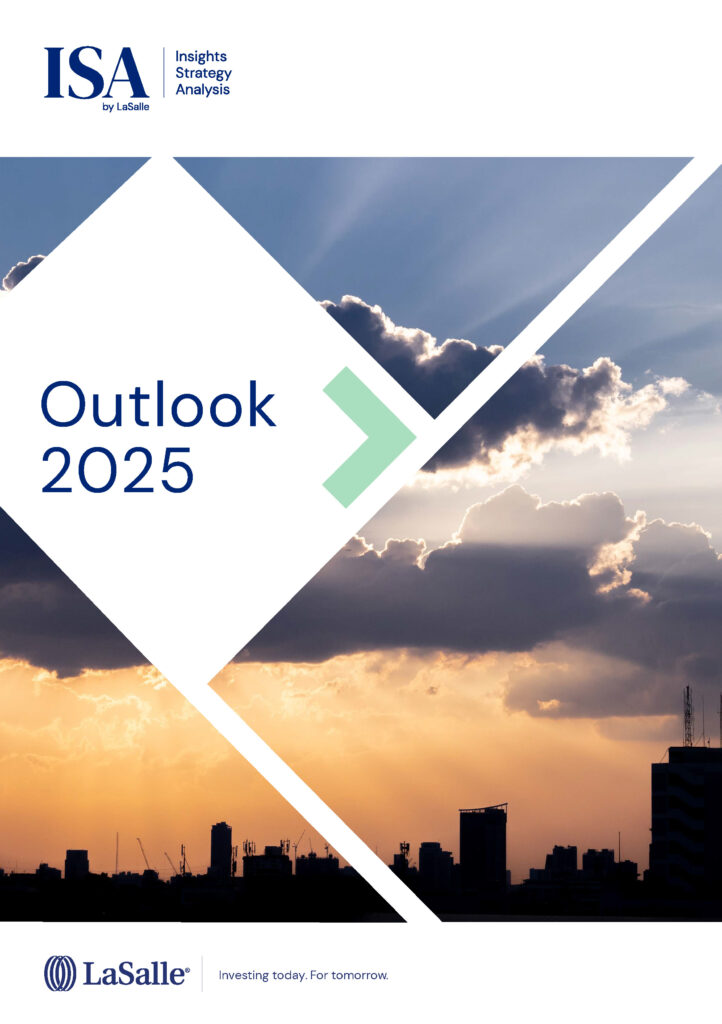





 Why real estate lays out the case for property exposure in a multi-asset context?
Why real estate lays out the case for property exposure in a multi-asset context?  Why global considers the benefits of expanding horizons beyond an investor’s domestic market?
Why global considers the benefits of expanding horizons beyond an investor’s domestic market?  Why be sector smart tries to make sense of the recent changes in relative sector performance with an eye to building resilient portfolios?
Why be sector smart tries to make sense of the recent changes in relative sector performance with an eye to building resilient portfolios?  Why be quadrant smart addresses the interplay among the “four quadrants” of real estate?
Why be quadrant smart addresses the interplay among the “four quadrants” of real estate?  Why manage risk explores the importance of—and our approach to—managing investment risk?
Why manage risk explores the importance of—and our approach to—managing investment risk? 